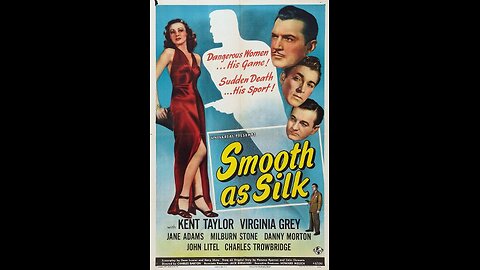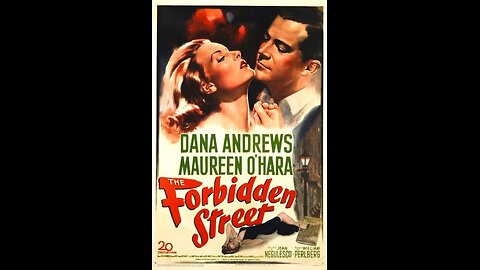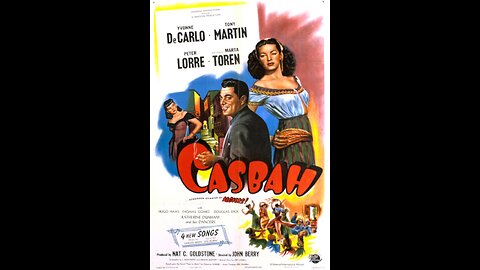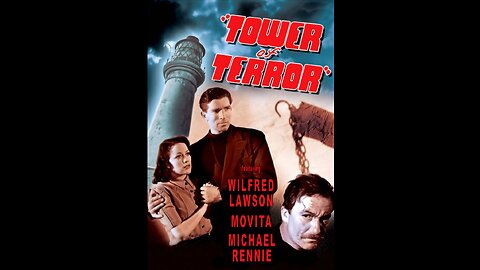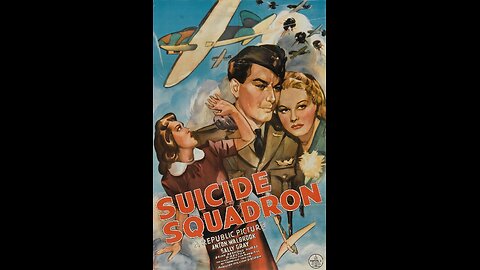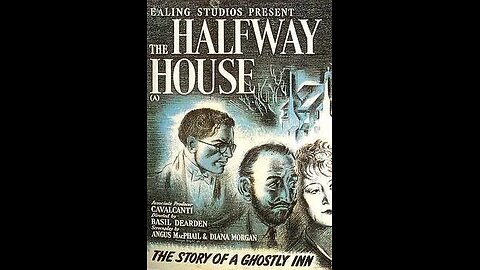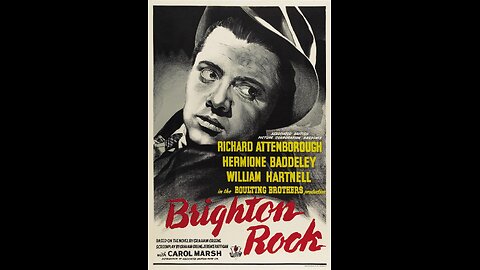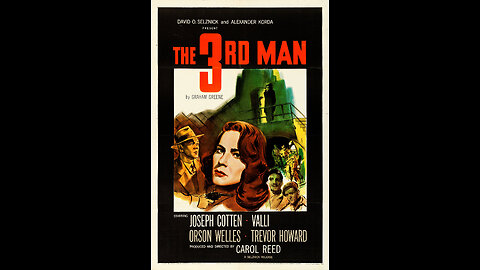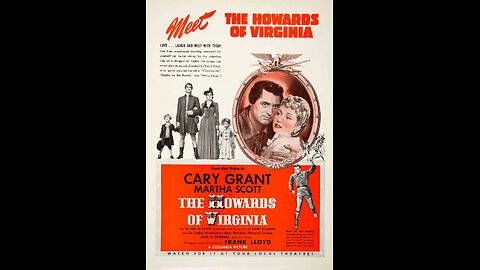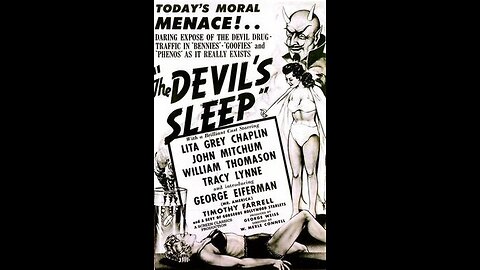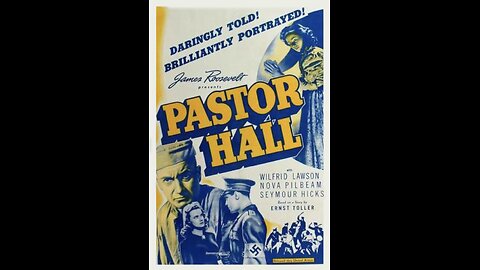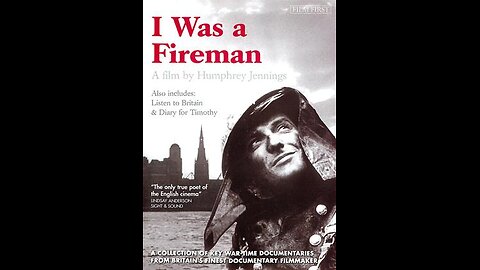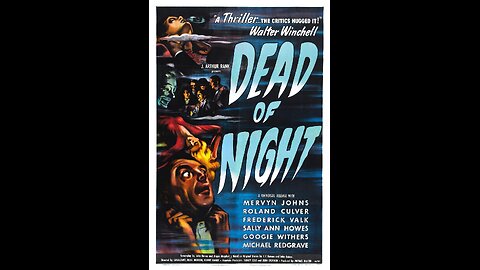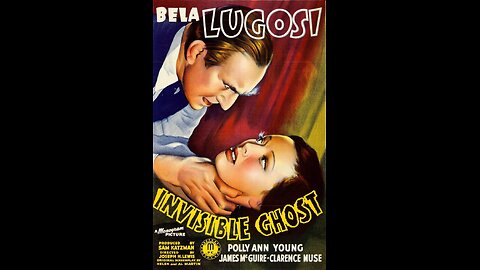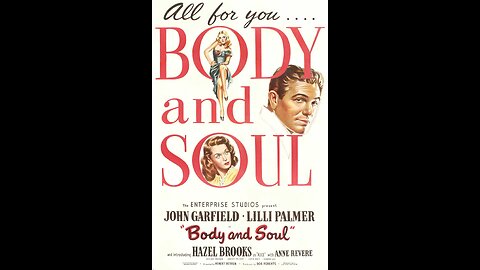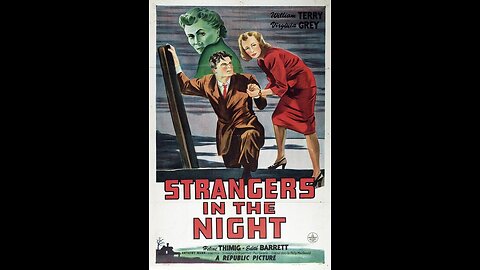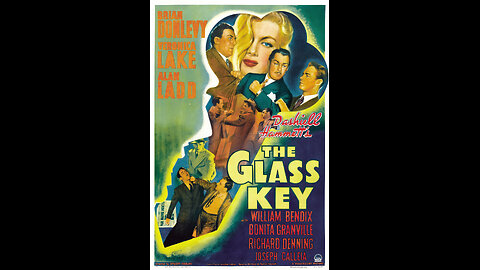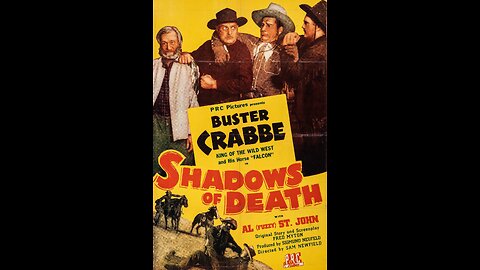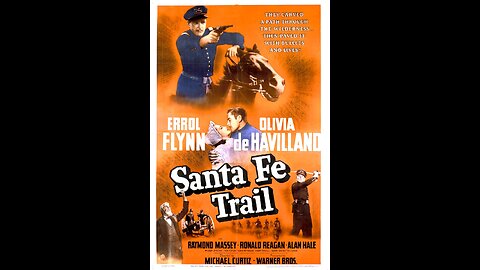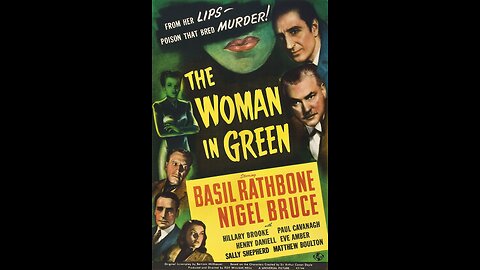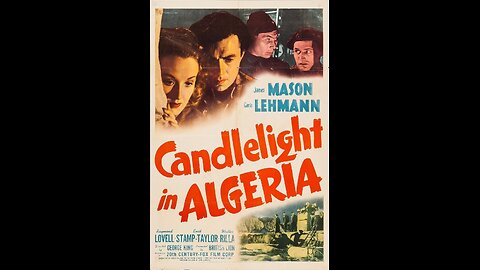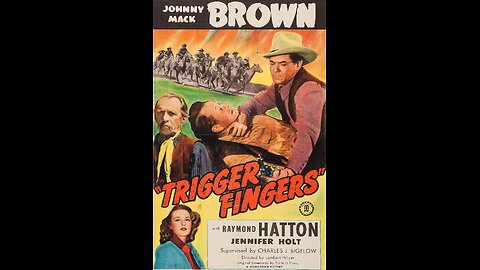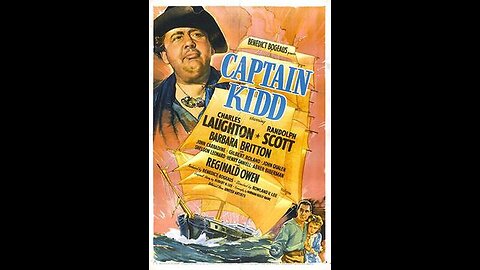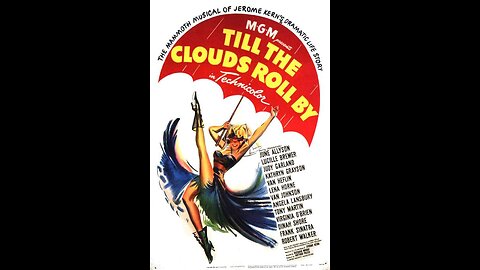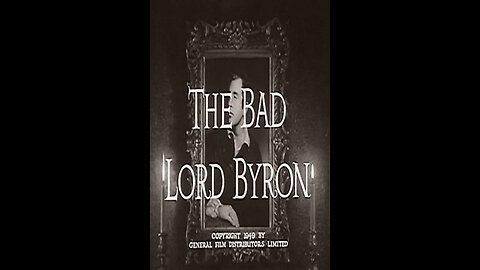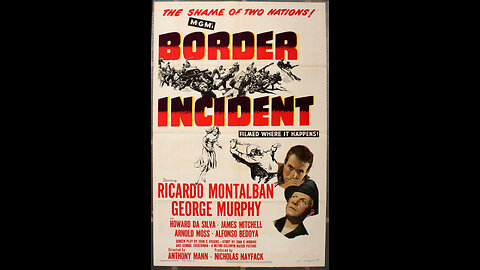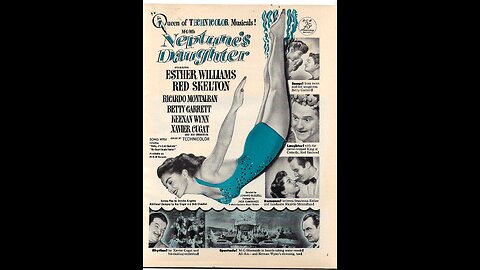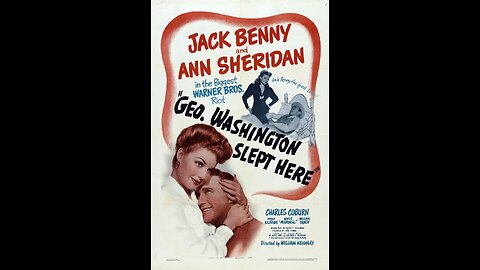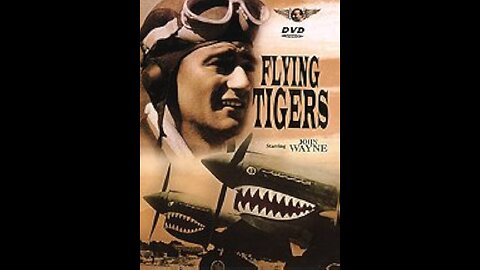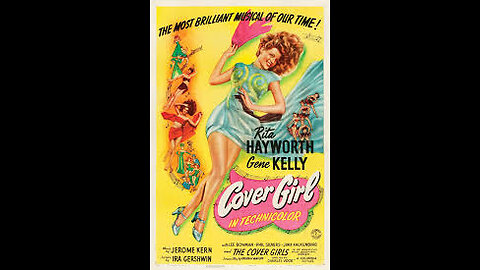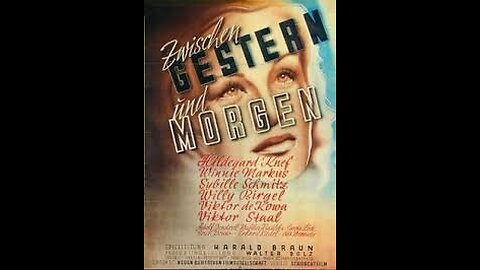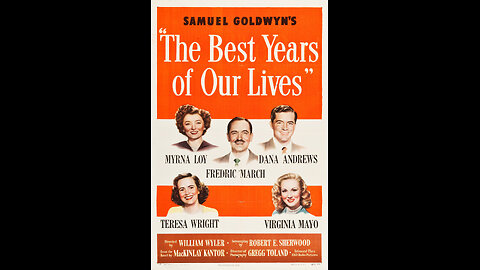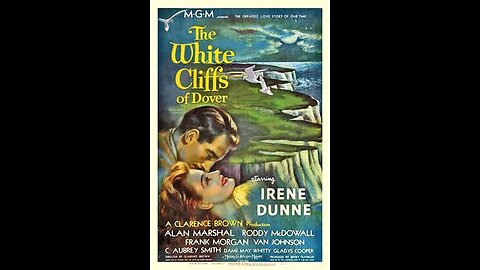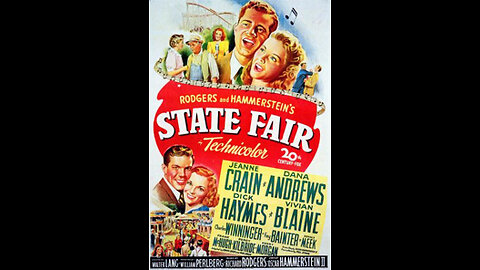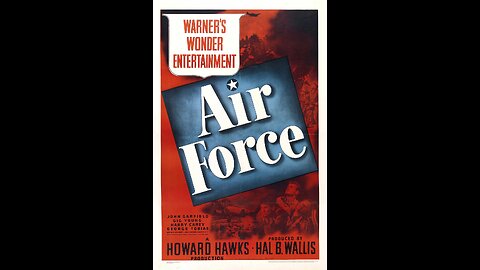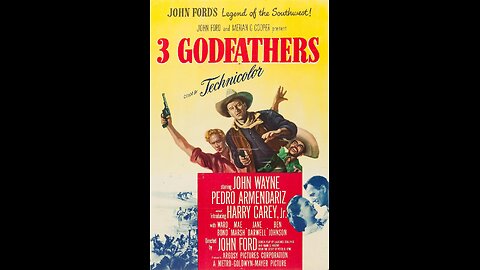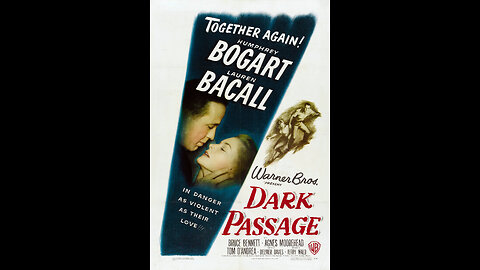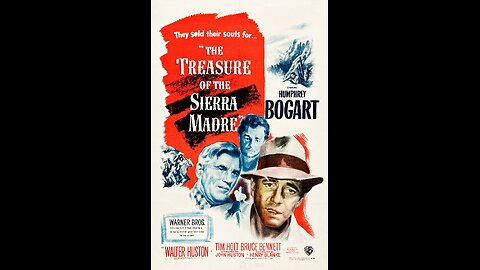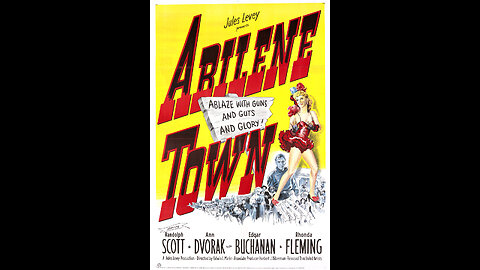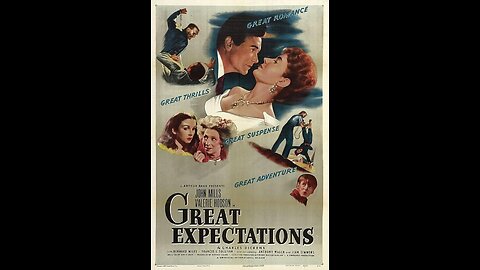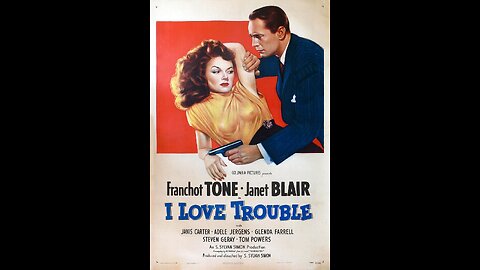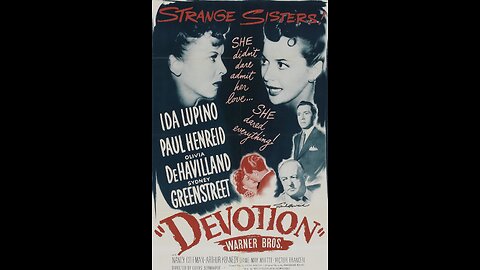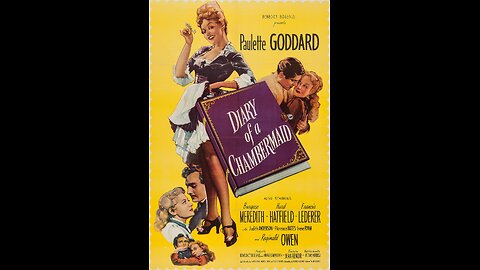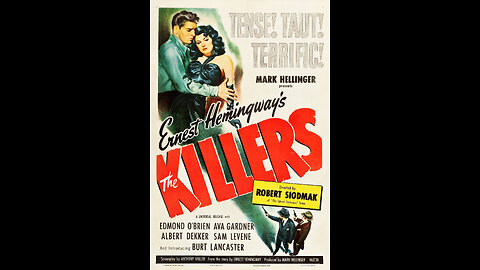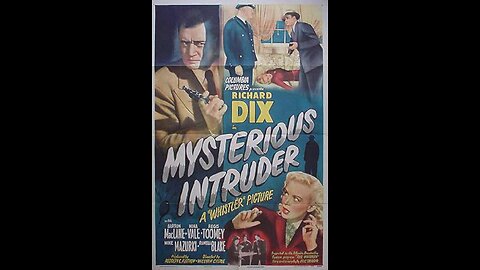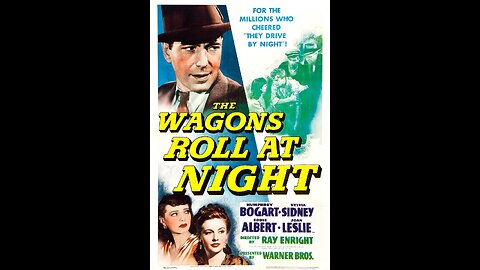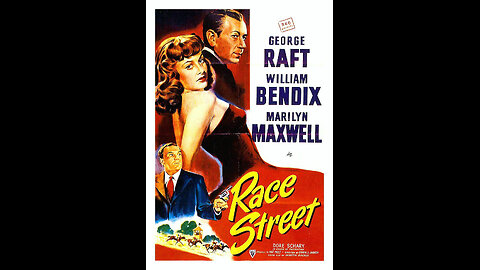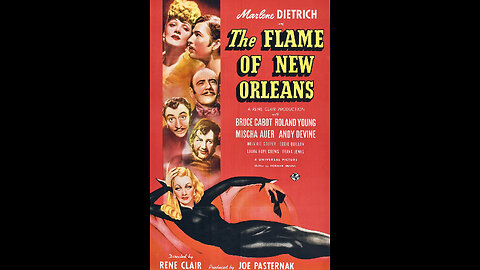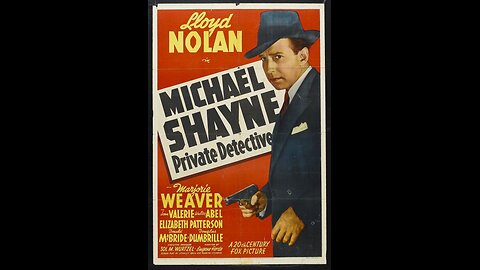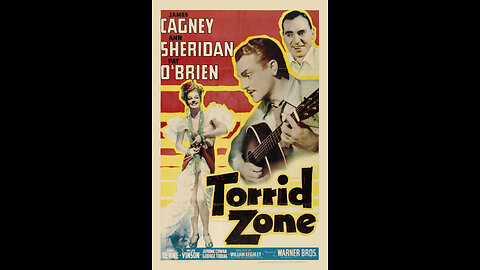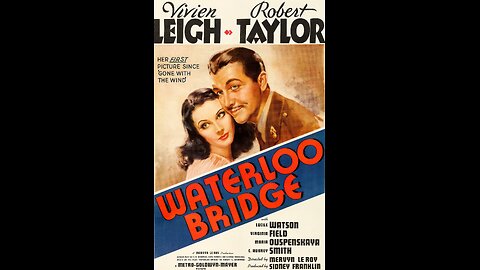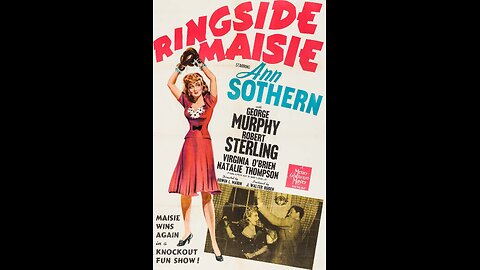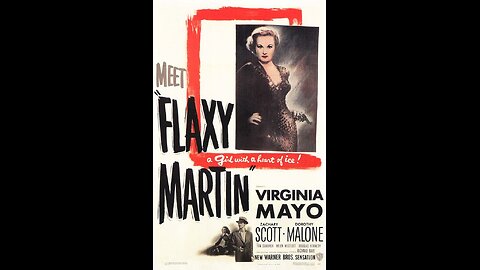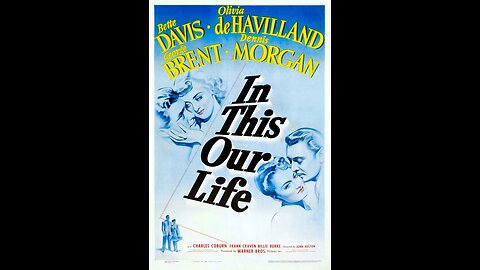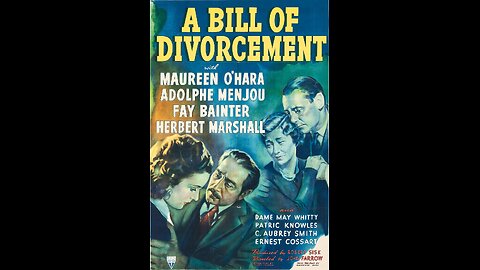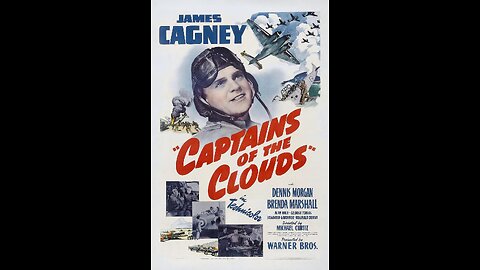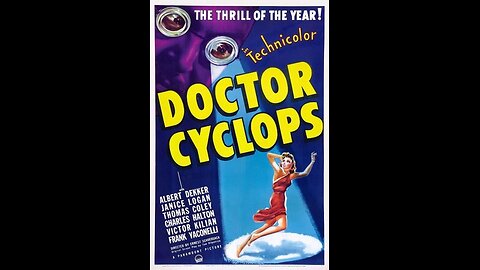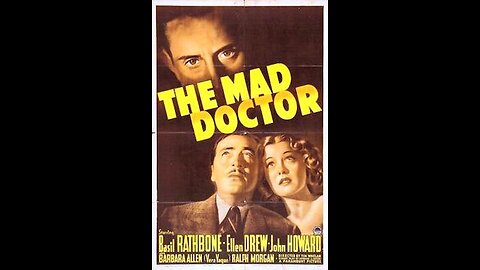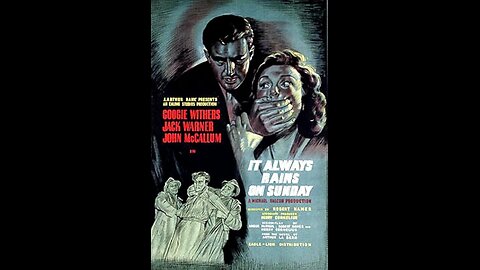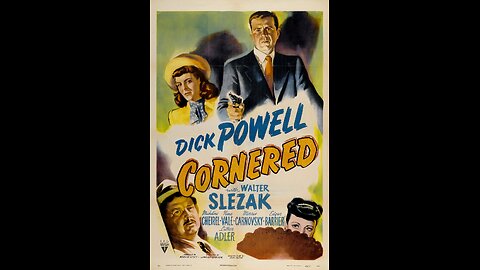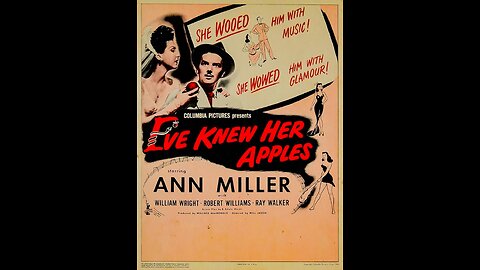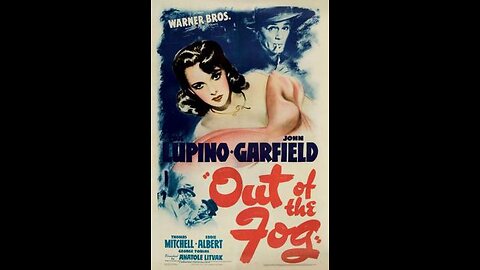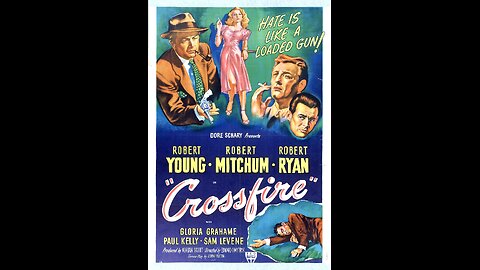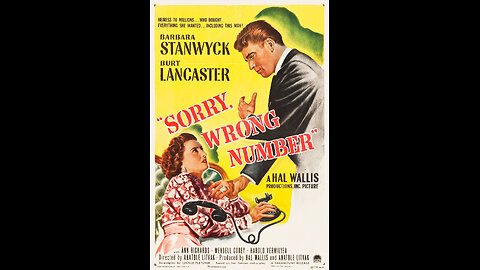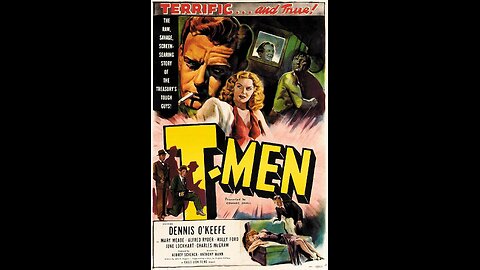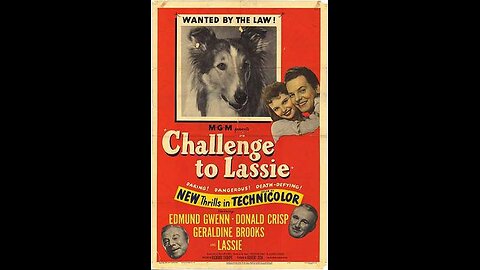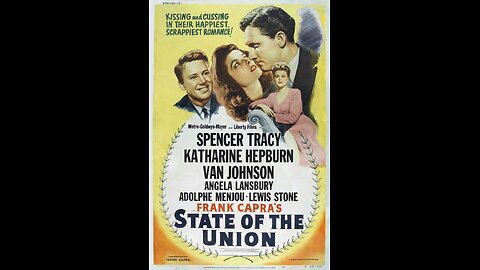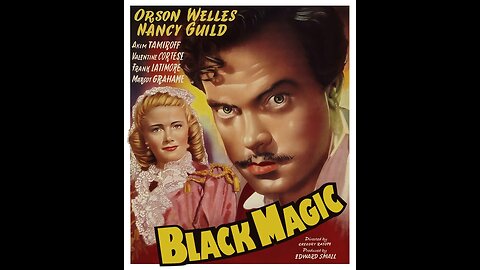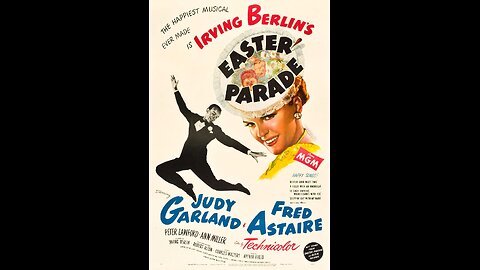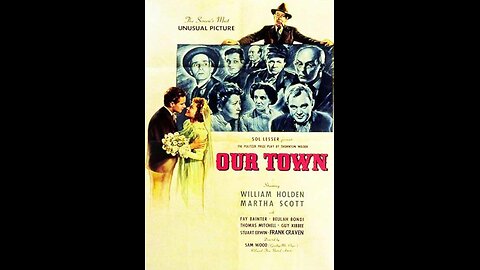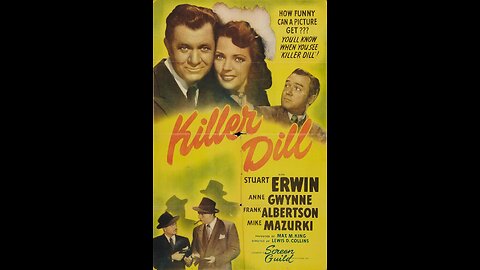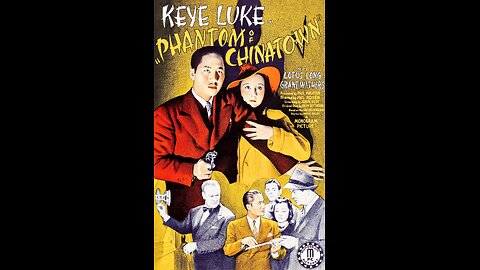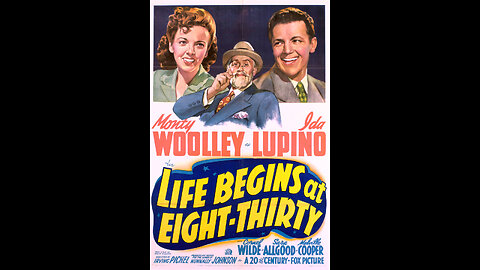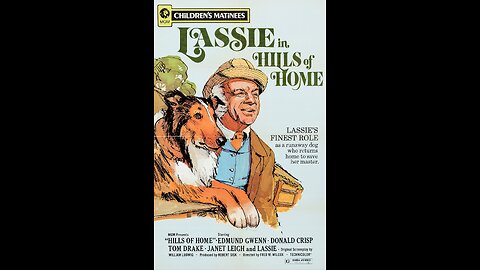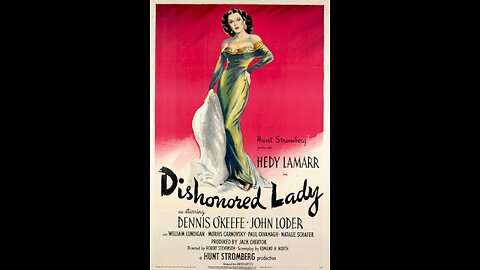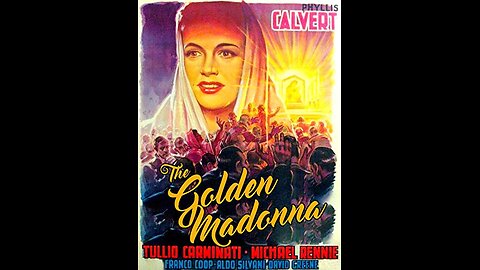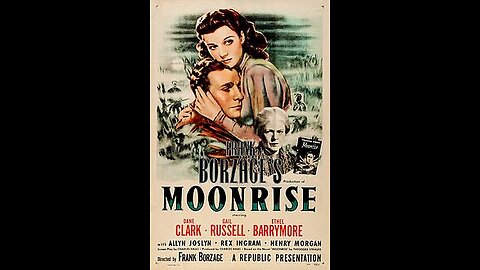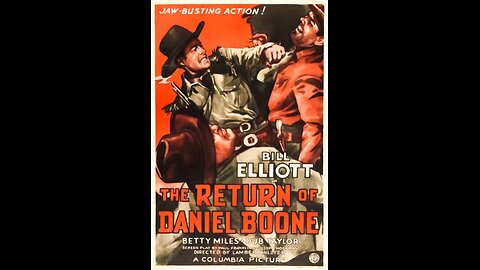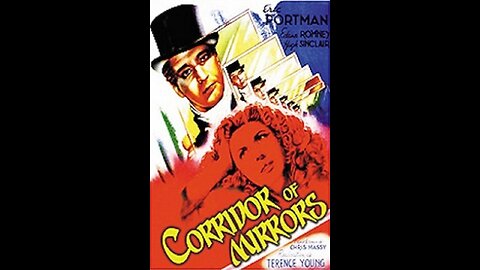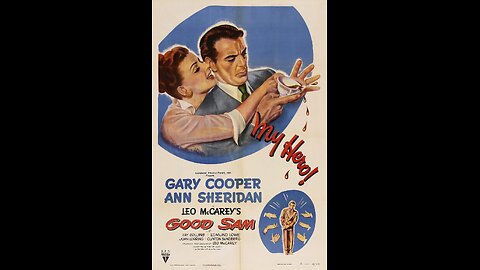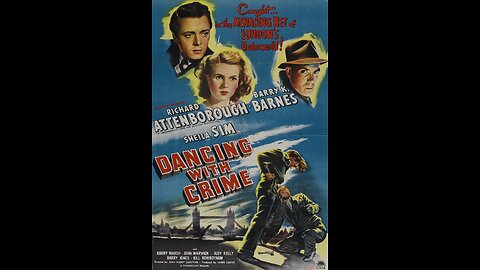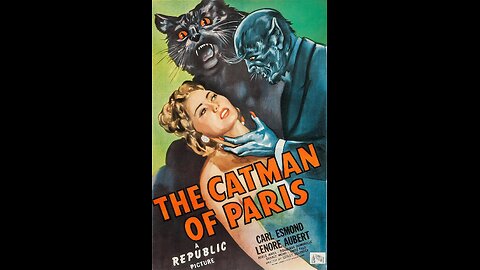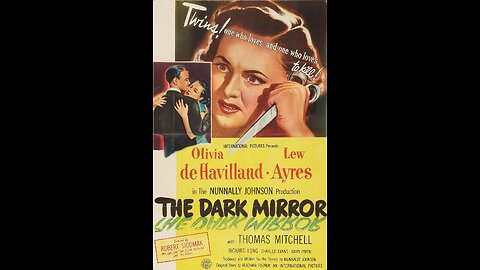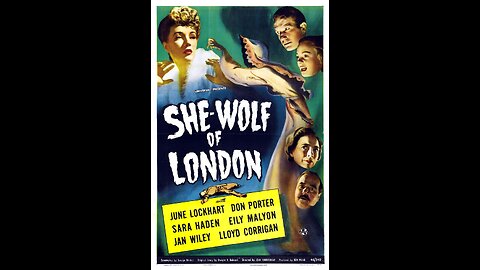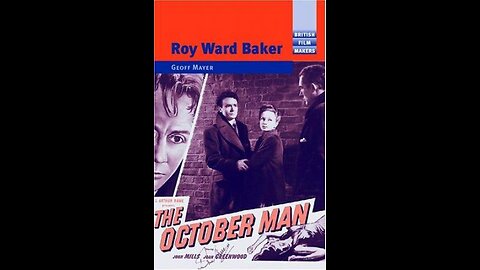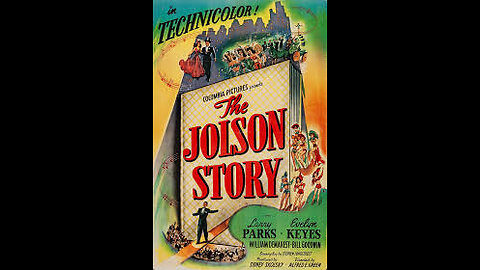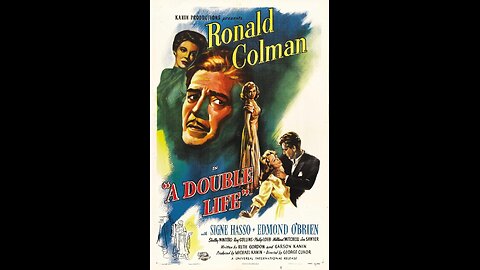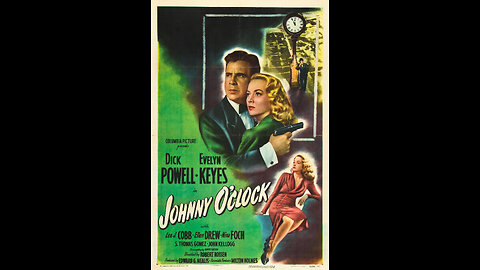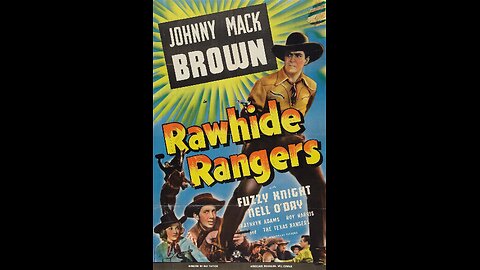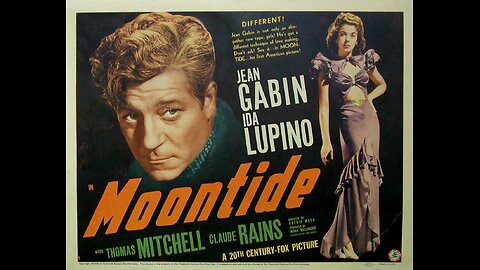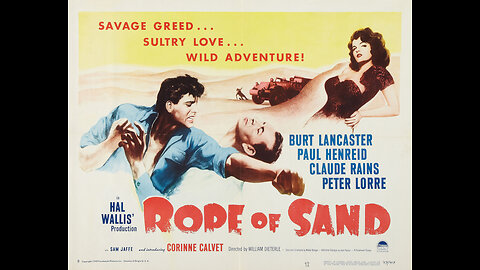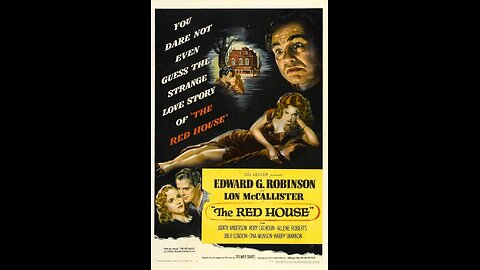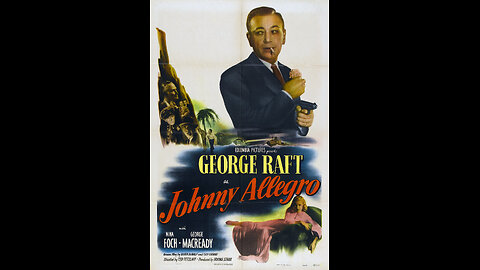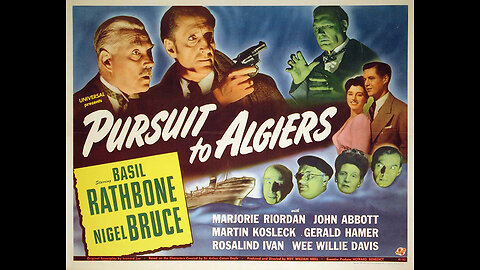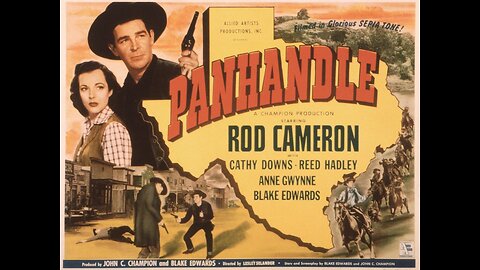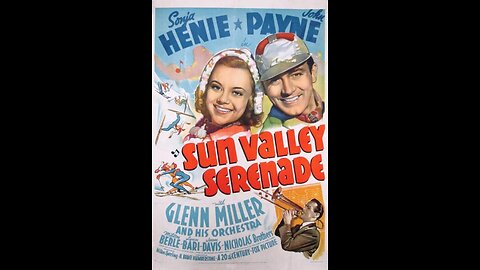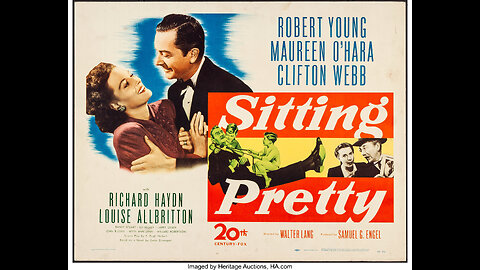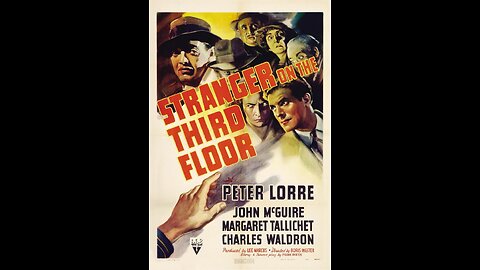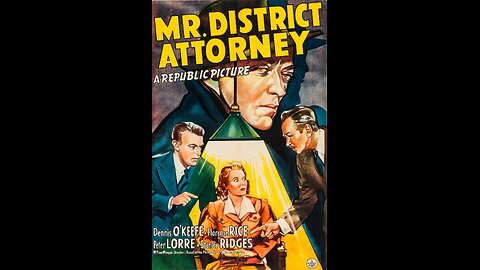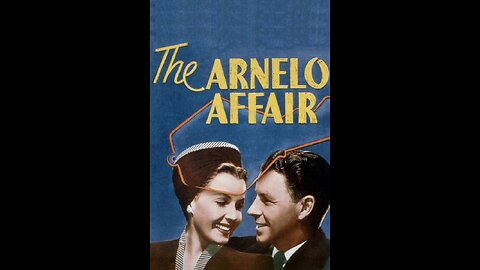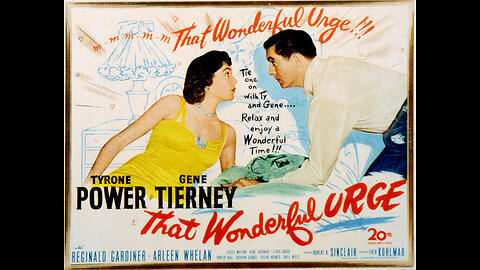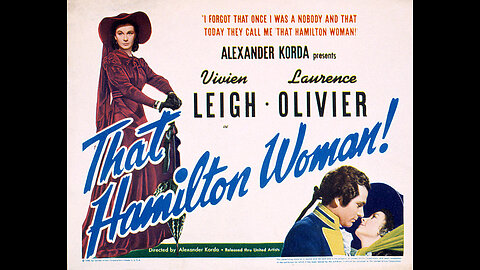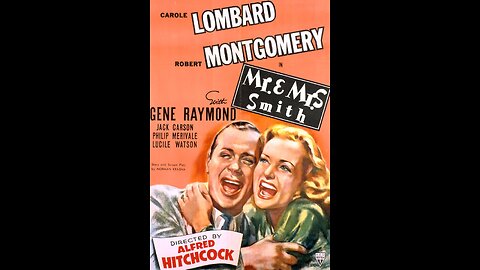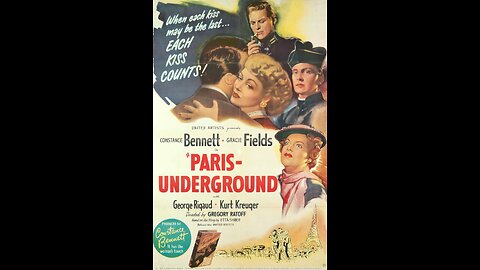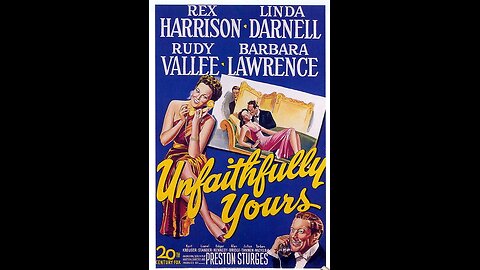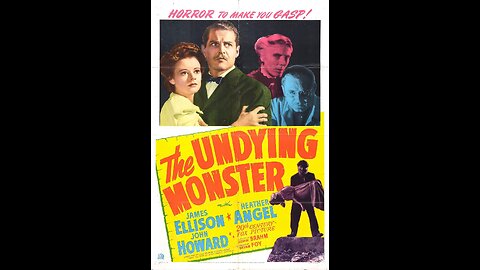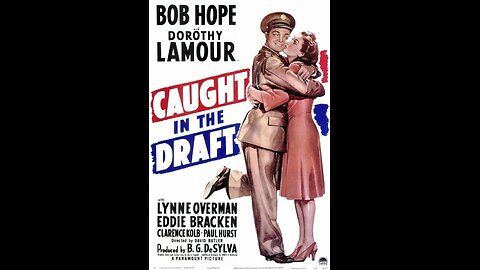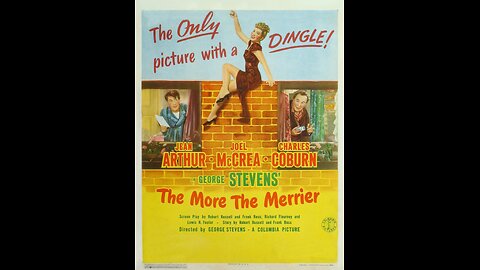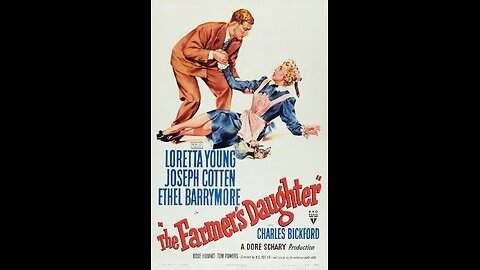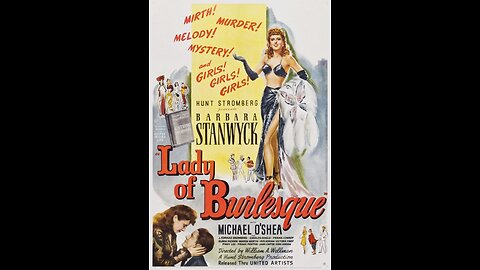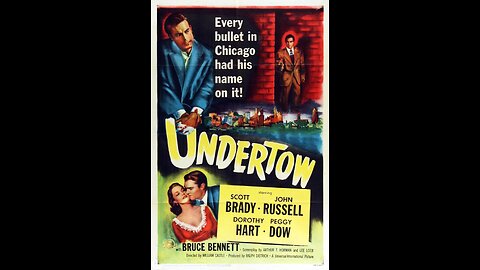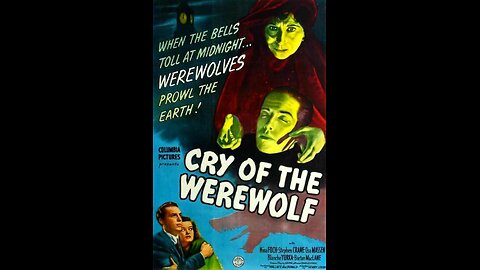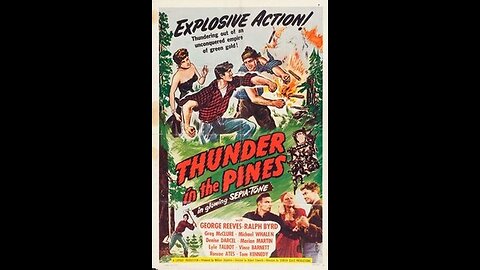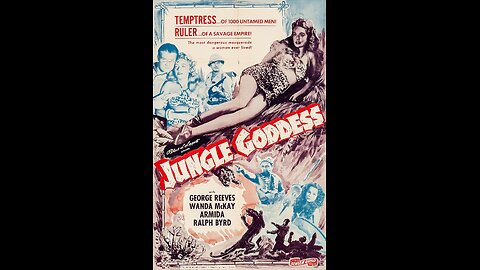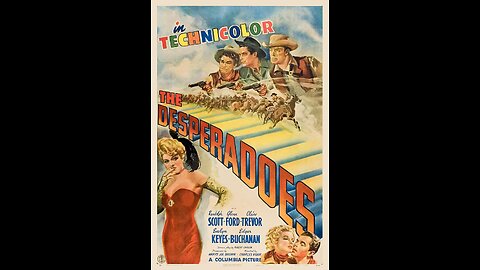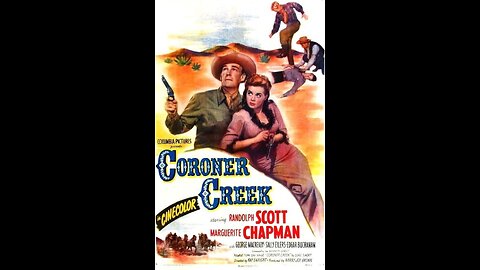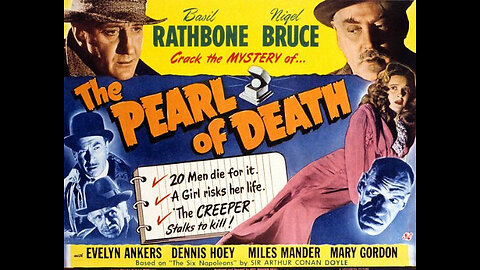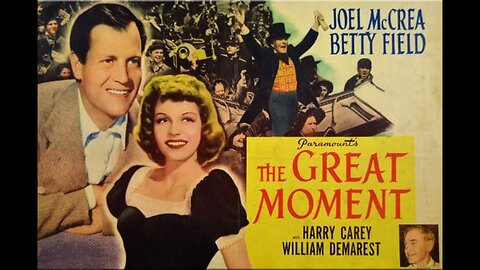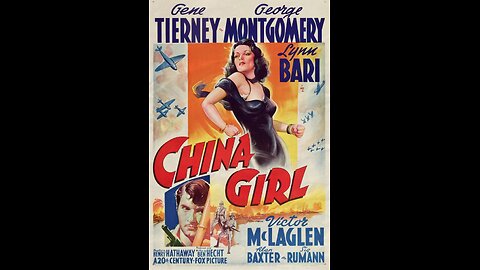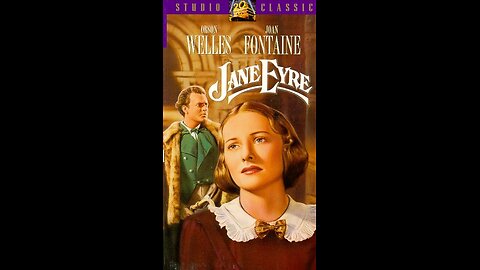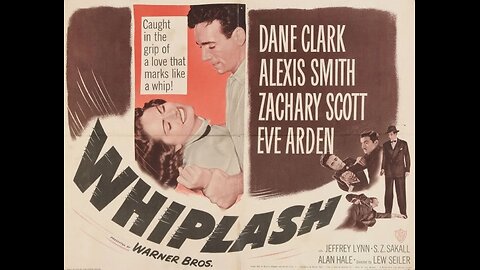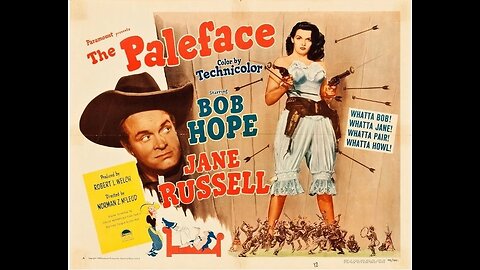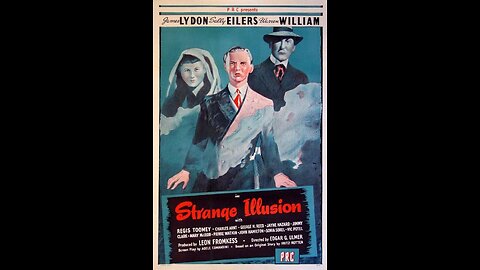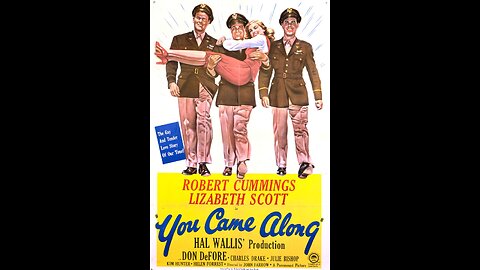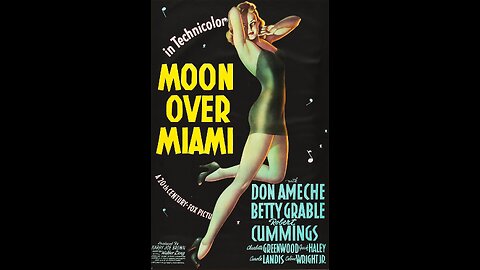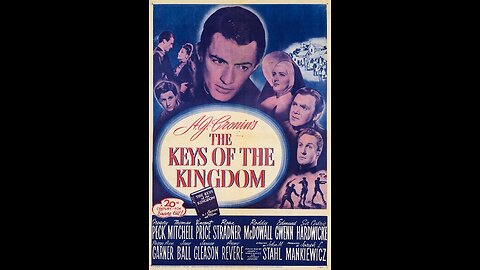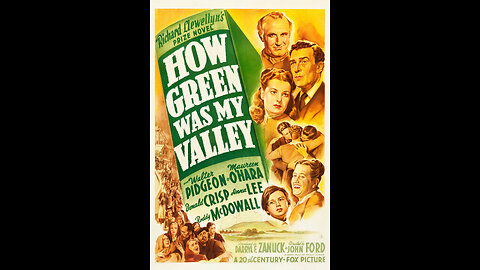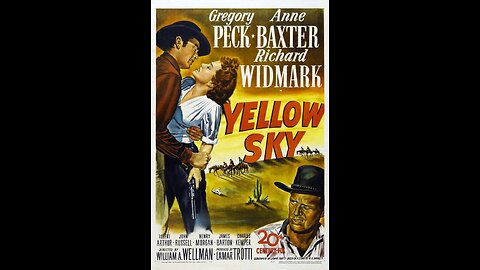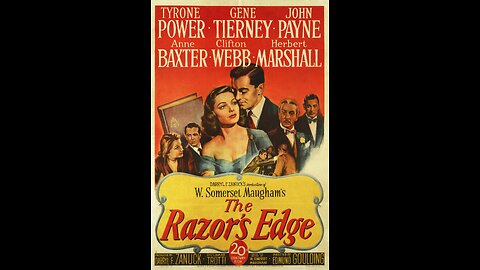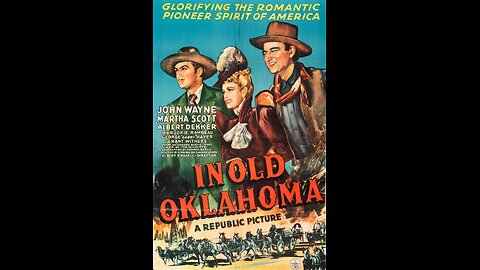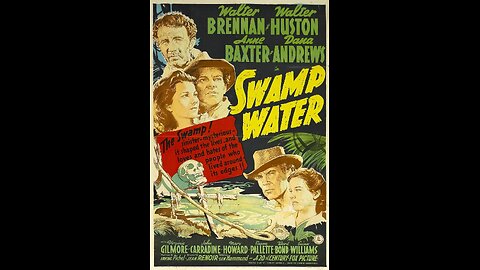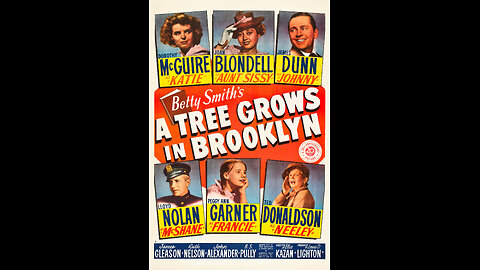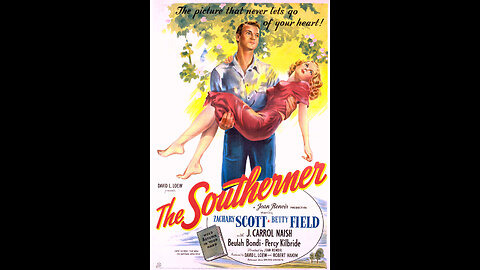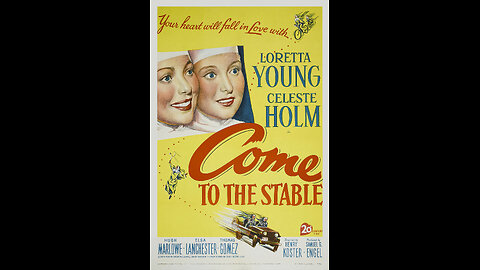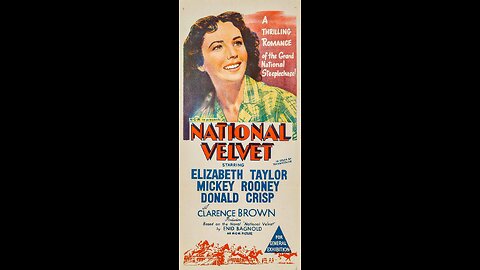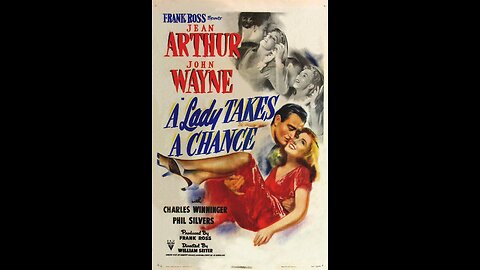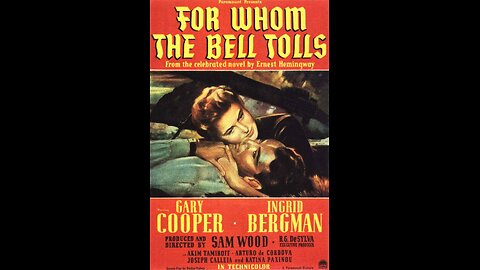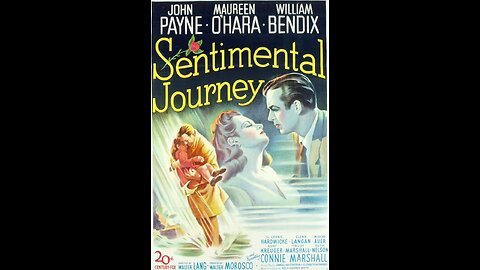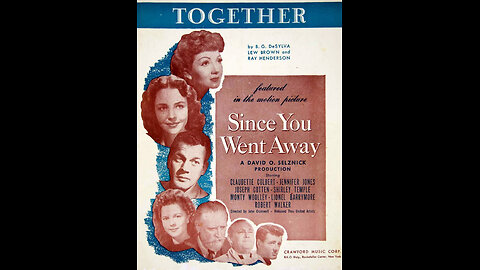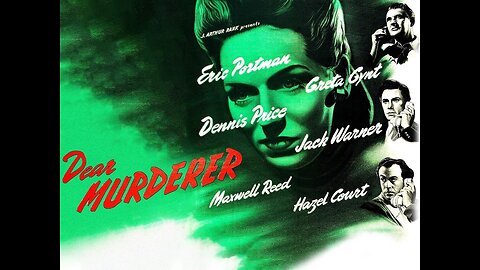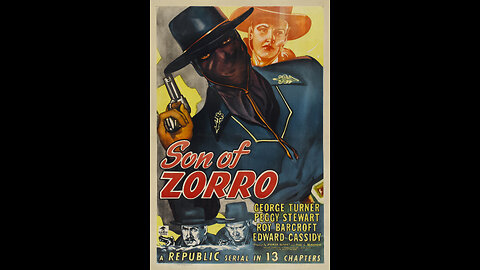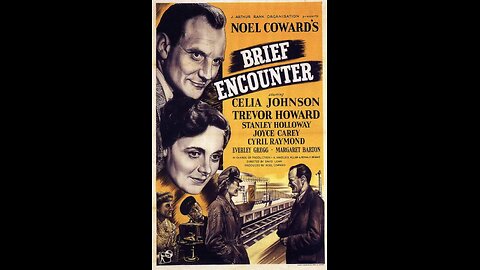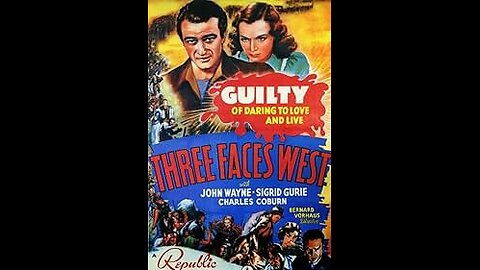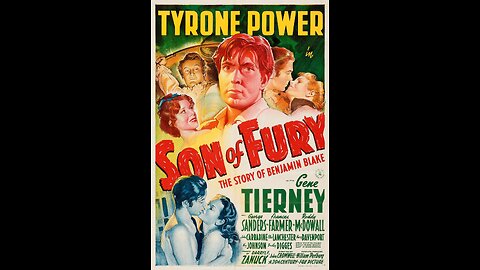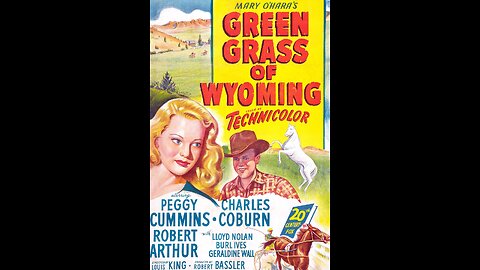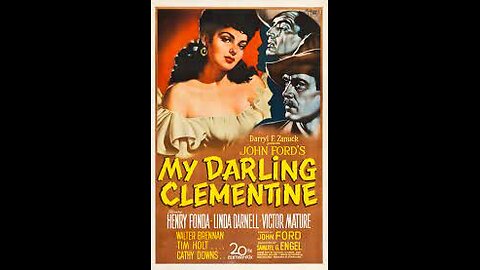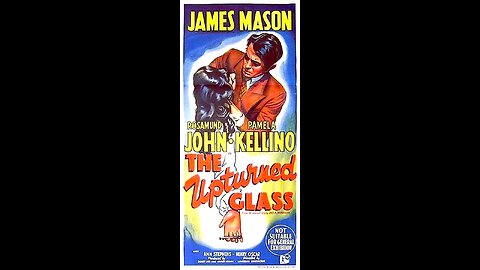Premium Only Content
This video is only available to Rumble Premium subscribers. Subscribe to
enjoy exclusive content and ad-free viewing.
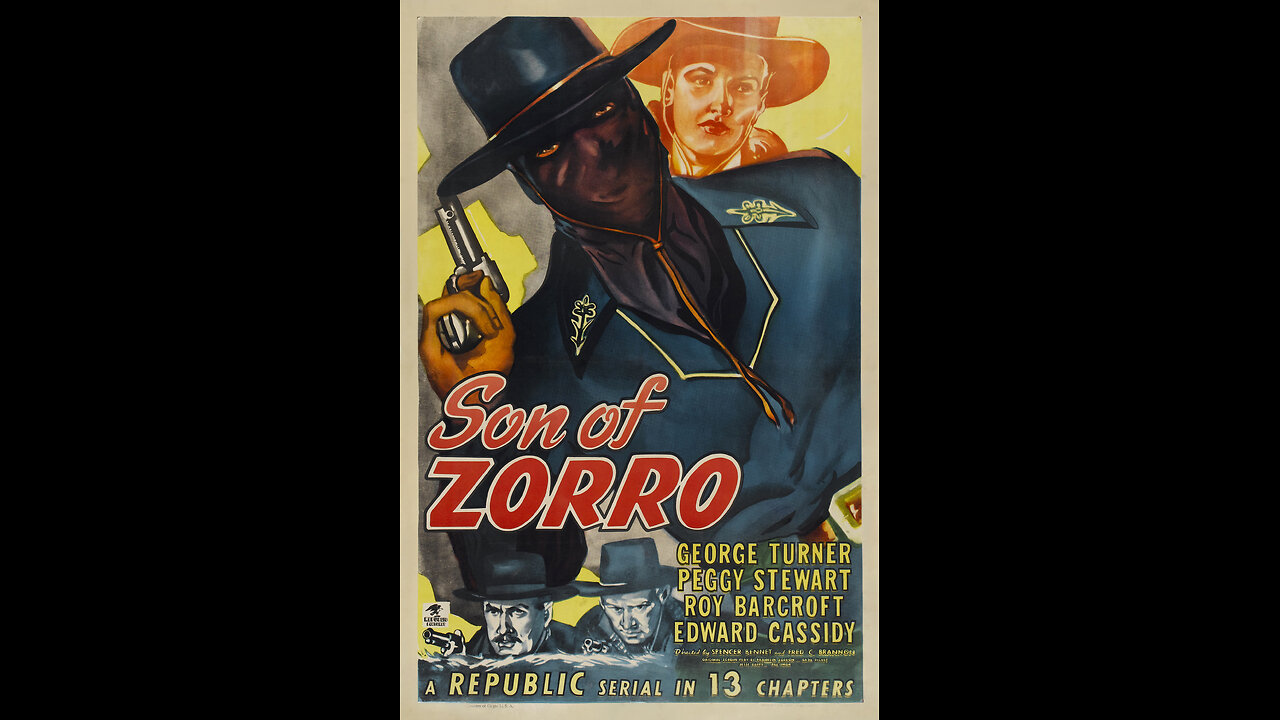
1940-1949 Movies
Cinema2000
- 185 / 199
1
Smooth as Silk (1946) | Directed by Charles Barton
Classic Films & Movies Archive
Smooth as Silk is a crime drama film revolving around a slick and ambitious lawyer who becomes entangled in a web of deception, greed, and murder. When he helps a young woman secure a role in a play by manipulating her uncle, the situation spirals out of control, leading to betrayal and deadly consequences. The story unfolds as a dark examination of ambition and moral corruption.
Genre: Crime, Drama, Film Noir
Director: Charles Barton
Charles Barton (1902–1981) was an American film director and actor whose career spanned over four decades. Starting as a silent film actor in the 1920s, he transitioned to directing in the 1930s and became known for his work on comedies, thrillers, and adventure films. He directed several Abbott and Costello comedies and also worked extensively in television later in his career, including on popular series such as "Amos 'n' Andy" and "Dennis the Menace." Barton’s directorial style was characterized by brisk pacing and clear storytelling, often within tight budgets.
Star Cast:
Kent Taylor as Mark Fenton
Virginia Grey as Paula Marlowe
Milburn Stone as Steve Marlowe
John Litel as Stephen Elliott
Jane Adams as Peggy
Charles Trowbridge as Judge Ballantine
The film was received as a competent and fast-paced entry in the crime drama genre, typical of Universal’s mid-1940s output. Critics praised the performances of Kent Taylor and Virginia Grey, noting their convincing portrayal of morally ambiguous characters. While not a major box office success, it was appreciated by fans of noir-style mysteries for its concise storytelling and moody atmosphere.
Fun Facts:
The film was produced by Universal Pictures during the height of the studio’s B-movie crime cycle.
Virginia Grey was a frequent face in 1940s Hollywood thrillers and had previously starred in several Universal productions.
The story was adapted from a play titled "A Slight Case of Murder," although significant changes were made for the screen.
The film’s compact runtime of about an hour reflects Universal’s efficient approach to mid-budget features at the time.
Director Charles Barton shot the film in under three weeks, a common practice for noir B-movies of the period.
* This Rumble Movie Channel is comprehensively indexed on https://kinoquick.com - find you favourite movies fast & free!
* Follow this channel to be notified of daily movie updates.
2
The Forbidden Street (1949) | Directed by Jean Negulesco
Classic Films & Movies Archive
The Forbidden Street, also known as Britannia Mews, is a romantic drama set in Victorian London. It follows Adelaide Culver, a young woman from a wealthy family who defies social expectations by marrying an artist. Her life takes a tragic turn after a fatal accident, forcing her into a life of hardship in the seedy district of Britannia Mews. Over time, she struggles for redemption and finds unexpected love while trying to rebuild her life.
Genre: Romantic Drama / Melodrama
Director: Jean Negulesco
Jean Negulesco was a Romanian-born American film director and screenwriter, known for his strong visual style and ability to blend romance with deep emotional themes. Born in 1900 in Craiova, Romania, Negulesco began his career as a painter before moving into filmmaking. He directed a number of acclaimed films, including Johnny Belinda (1948), How to Marry a Millionaire (1953), and Three Coins in the Fountain (1954). His background in art influenced his visual compositions and use of atmosphere in storytelling.
Star Cast:
Dana Andrews as Gilbert Lauderdale
Maureen O’Hara as Adelaide Culver
Sybil Thorndike as Mrs. Mounsey
Fay Compton as Mrs. Mounsey (elder)
Ethel Griffies as Granny Rudd
Diana Cortland as Henrietta Lauderdale
Patricia Medina as Avice Crichton
The film received moderate praise upon release, particularly for its atmospheric cinematography and Maureen O’Hara’s strong performance. Some critics found the story overly melodramatic, but audiences appreciated its rich period setting and themes of redemption and perseverance. Over time, it gained recognition for its moody depiction of Victorian London and Negulesco’s direction.
Fun Facts:
The movie is based on Margery Sharp’s 1946 novel “Britannia Mews.”
It was produced by 20th Century Fox and released under its alternate title for U.S. audiences.
Maureen O’Hara considered the film one of her more emotionally demanding roles due to the character’s transformation from privilege to poverty.
Jean Negulesco’s painterly background is evident in the film’s attention to visual detail, with sets designed to resemble 19th-century paintings.
The film was shot largely on elaborate studio sets replicating the narrow streets and gloomy atmosphere of old London rather than on location.
* This Rumble Movie Channel is comprehensively indexed on https://kinoquick.com - find you favourite movies fast & free!
* Follow this channel to be notified of daily movie updates.
1
comment
3
Casbah (1948) | Directed by John Berry
Classic Films & Movies Archive
Casbah is a musical crime drama set in the mysterious backstreets of Algiers. It follows the notorious thief Pépé le Moko, who hides in the Casbah — a labyrinthine quarter where he is both protected and trapped. When he falls in love with a beautiful Parisian woman, his yearning for freedom and romance leads to betrayal and tragedy. The film is a remake of the 1938 French classic Pépé le Moko and its 1937 American adaptation Algiers.
Genre: Musical / Crime / Romance
Director: John Berry
John Berry (1917–1999) was an American film director, actor, and screenwriter known for his work during Hollywood’s Golden Age. He began his career as an actor in New York before moving into directing at Warner Bros. and later Universal. His promising career was interrupted when he was blacklisted during the McCarthy era for alleged communist sympathies. Despite this, Berry continued to work internationally and later returned to Hollywood, earning respect for his craftsmanship and social conscience.
Star Cast:
Yvonne De Carlo as Inez
Tony Martin as Pépé le Moko
Peter Lorre as Slimane
Märta Torén as Gaby
Thomas Gomez as Grandpere
Hugo Haas as Omar
Douglas Dick as Carlo
Casbah was received with moderate enthusiasm by audiences who appreciated its music and visual flair but found it less gripping than the earlier versions. Critics praised Yvonne De Carlo’s sultry performance and Tony Martin’s singing voice, while noting that the film leaned more toward musical entertainment than noir tension. The lush Technicolor photography and lively score gave the story a new atmosphere, but purists of the original films considered it too glamorous and Americanized.
Fun Facts:
The film was produced by Tony Martin’s own company, Marston Productions, making it a personal project for the singer.
It featured several original songs, including “For Every Man There’s a Woman” by Harold Arlen and Leo Robin, which was nominated for an Academy Award for Best Original Song.
Yvonne De Carlo’s role as Inez cemented her reputation as an exotic screen beauty and helped her transition into leading roles.
Peter Lorre’s portrayal of Slimane added a touch of dark humor and menace, echoing his earlier roles in European cinema.
* This Rumble Movie Channel is comprehensively indexed on https://kinoquick.com - find you favourite movies fast & free!
* Follow this channel to be notified of daily movie updates.
4
Tower of Terror (1941) | Directed by Lawrence Huntington
Classic Films & Movies Archive
Tower of Terror is a British thriller set during World War II, centered around espionage, sabotage, and tension in a coastal lighthouse. When a German spy infiltrates the lighthouse to send coded messages to enemy submarines, suspicion, fear, and betrayal build among the small group trapped by a storm. The film’s confined setting amplifies the suspense as the characters uncover hidden motives in their midst.
Genre: Thriller / War / Spy Drama
Director: Lawrence Huntington
Lawrence Huntington (1900–1968) was a British film director and screenwriter known for his work on suspense and mystery thrillers during the 1930s and 1940s. He directed numerous low-to-mid budget British features, often emphasizing atmosphere and moral tension. His other notable works include Wanted for Murder (1946), The Upturned Glass (1947), and Deadly Nightshade (1953). Huntington was known for his skill in creating claustrophobic tension and complex character-driven plots within modest production constraints.
Star Cast:
Wilfrid Lawson as Wolfe
Michael Rennie as Anthony Hale
Movita as Marie
Morland Graham as Max
Frederick Burtwell as Fred
Herbert Lom as Leo
Charles Rolfe as Karl
Peter Gawthorne as Inspector
The film received moderate reviews at its release, praised for its atmosphere and performances, particularly Wilfrid Lawson’s brooding portrayal of the tormented lighthouse keeper. Critics appreciated its tense and moody direction, although some found the plot somewhat melodramatic. Over time, Tower of Terror gained a reputation as a solid example of early British wartime thrillers, notable for its isolated setting and psychological intensity rather than action.
Fun Facts:
The film was one of the earliest roles for Herbert Lom, who would later become internationally known for his portrayal of Chief Inspector Dreyfus in the Pink Panther series.
Michael Rennie, also appearing early in his career, went on to stardom in The Day the Earth Stood Still (1951).
Despite its title, Tower of Terror is not a horror film but rather a psychological thriller with wartime espionage themes.
The confined lighthouse set was reused and redressed from another British production to save wartime film resources.
Movita, who played Marie, was an American actress of Irish and Mexican descent and was briefly married to Marlon Brando in the 1960s.
* This Rumble Movie Channel is comprehensively indexed on https://kinoquick.com - find you favourite movies fast & free!
* Follow this channel to be notified of daily movie updates.
5
Dangerous Moonlight / Suicide Squadron (1941) | Directed by Brian Desmond Hurst
Classic Films & Movies Archive
Dangerous Moonlight is a British romantic war drama about a Polish concert pianist and composer who becomes a fighter pilot during World War II. The story follows his love affair with an American war correspondent and his struggle to reconcile his artistic sensitivity with his duty as a soldier. The film is best remembered for its haunting musical theme, which became world famous as “The Warsaw Concerto.”
Genre: Romantic War Drama
Director: Brian Desmond Hurst
Brian Desmond Hurst (1895–1986) was an Irish film director whose career spanned several decades in British cinema. Known for his skill in blending human emotion with historical and wartime themes, Hurst directed notable works such as Scrooge (1951) and Theirs is the Glory (1946). His direction often emphasized visual grandeur and emotional storytelling, characteristics that helped define the wartime British film style.
Star Cast:
Anton Walbrook as Stefan Radetzky
Sally Gray as Carole Peters
Derrick De Marney as Major David Bruce
Cecil Parker as Alan Thornton
Percy Parsons as Colonel Wragge
Milton Rosmer as Dr. Benson
Peter Gawthorne as Air Vice Marshal
The film was well received by wartime audiences for its combination of romance, heroism, and evocative music. Critics praised Anton Walbrook’s performance and the film’s emotional depth, while the “Warsaw Concerto” composed by Richard Addinsell quickly became one of the most beloved pieces of wartime music. The film’s balance between art and war resonated strongly with viewers experiencing the conflict firsthand.
Fun Facts:
The “Warsaw Concerto” was specially composed by Richard Addinsell for the film, and it became one of the most popular classical compositions of the 1940s.
The story was inspired by real-life Polish pilots who fought with the Royal Air Force during the Battle of Britain.
The film’s working title was “Suicide Squadron.”
Anton Walbrook, who played the pianist-hero, was himself an accomplished pianist, adding realism to his performance.
Dangerous Moonlight helped popularize the image of the romantic, artist-soldier in British cinema of the 1940s.
* This Rumble Movie Channel is comprehensively indexed on https://kinoquick.com - find you favourite movies fast & free!
* Follow this channel to be notified of daily movie updates.
6
The Halfway House (1944) | Directed by Basil Dearden
Classic Films & Movies Archive
The Halfway House is a British supernatural drama set in wartime Wales, where a diverse group of strangers seeks refuge at a secluded country inn. As they spend time together, they begin to sense that something is not quite right—the inn’s owners seem untouched by time, and the guests are each haunted by guilt, grief, or moral conflict. Gradually, they discover that the inn exists in a mysterious limbo between life and death, offering them a chance at redemption before they return to the world transformed.
Genre: Supernatural, Drama, Fantasy
Director: Basil Dearden
Basil Dearden (1911–1971) was an English film director and producer celebrated for his intelligent and socially conscious storytelling. Starting his career at Ealing Studios, he worked across genres but was best known for his sensitive handling of moral and social themes. His notable films include The Blue Lamp, Victim, and Sapphire, all of which explored contemporary British issues with humanity and insight. The Halfway House represents his early mastery of blending realism with the supernatural, a hallmark of his versatile style.
Star Cast:
Mervyn Johns as Rhys
Glynis Johns as Gwyneth
Tom Walls as Captain Meadows
Françoise Rosay as Alice Meadows
Esmond Knight as David Davies
Guy Middleton as Fortescue
Sally Ann Howes as Joanna Davies
Valerie White as Jill French
Richard Bird as Harry Meadows
The Halfway House was warmly received by critics and audiences alike, praised for its atmospheric setting, moving performances, and blend of fantasy with moral reflection. Its themes of loss, reconciliation, and spiritual renewal resonated deeply with wartime viewers coping with uncertainty and grief. Critics admired Basil Dearden’s delicate direction and the film’s poetic tone, which balanced eerie mystery with emotional warmth. It has since been regarded as one of Ealing Studios’ most touching and quietly profound works.
Fun Facts:
The film was produced by Ealing Studios, better known for comedies, marking one of its early ventures into supernatural storytelling.
Mervyn Johns and Glynis Johns, who play father and daughter in the film, were real-life father and daughter.
The story was based on a play by Denis Ogden titled “The Peaceful Inn.”
The Welsh setting and use of mist-shrouded landscapes add to the film’s haunting and dreamlike quality.
Esmond Knight, who appears in the film, had been partially blinded during World War II but continued to act successfully.
The Halfway House is often cited as a precursor to Ealing’s later anthology film Dead of Night (1945), sharing similar themes of the supernatural and moral awakening.
The film was intended both as entertainment and as subtle wartime encouragement for unity, compassion, and moral reflection.
* This Rumble Movie Channel is comprehensively indexed on https://kinoquick.com - find you favourite movies fast & free!
* Follow this channel to be notified of daily movie updates.
7
Brighton Rock (1948) | Directed by John Boulting
Classic Films & Movies Archive
Set in the seaside town of Brighton, this gripping British crime drama follows the ruthless young gangster Pinkie Brown as he seeks to cover up a murder and consolidate his control over the local mob scene. When a naive waitress named Rose becomes a dangerous witness, Pinkie manipulates her affection to keep her silent, leading to a tragic spiral of deceit and violence.
Genre: Crime, Drama, Thriller
Director: John Boulting
John Boulting (1913–1985) was a British filmmaker known for his collaborations with his twin brother Roy Boulting. Together they became leading figures in postwar British cinema, producing and directing a wide range of films from hard-edged dramas to satirical comedies. John typically handled directing duties while Roy produced. Their notable works include Brighton Rock, I'm All Right Jack, and Private's Progress.
Star Cast:
Richard Attenborough as Pinkie Brown
Hermione Baddeley as Ida Arnold
William Hartnell as Dallow
Harcourt Williams as Prewitt
Carol Marsh as Rose Brown
Wylie Watson as Spicer
Nigel Stock as Cubitt
Charles Goldner as Colleoni
Upon release, Brighton Rock was both acclaimed and controversial for its bleak depiction of postwar youth and violence. Richard Attenborough’s chilling portrayal of Pinkie Brown was praised as one of the most disturbing and memorable performances in British cinema. The film’s dark themes and Catholic undertones reflected the influence of Graham Greene’s original novel, which some critics found morally troubling but artistically compelling. Over time, it has been recognized as a cornerstone of British noir and a key influence on later gangster films.
Fun Facts:
The film is based on Graham Greene’s 1938 novel of the same name.
Richard Attenborough had already played Pinkie Brown in the 1943 stage version before reprising the role in the film.
The title refers to the seaside candy sticks sold in Brighton, symbolizing how evil runs through Pinkie as writing runs through a stick of rock.
Brighton authorities reportedly objected to filming scenes that portrayed the town as a hub of crime and corruption.
The 1948 version remains far darker in tone than the 2010 remake starring Sam Riley and Andrea Riseborough.
Carol Marsh, only 21 at the time, was chosen for the role of Rose after being discovered at the Rank Charm School.
8
The Third Man (1949) | Directed by Carol Reed
Classic Films & Movies Archive
The Third Man is a British film noir set in postwar Vienna, a city divided among Allied powers and rife with corruption. American pulp novelist Holly Martins arrives to meet his old friend Harry Lime, only to learn that Lime has been killed in a mysterious accident. As Martins investigates, he becomes entangled in a web of deceit, espionage, and moral ambiguity—culminating in the revelation that Lime is not only alive but deeply involved in the black-market trade of diluted penicillin. The film’s haunting atmosphere, striking visuals, and unforgettable zither score make it one of cinema’s great masterpieces.
Genre: Film Noir, Mystery, Thriller
Director: Carol Reed
Carol Reed (1906–1976) was one of Britain’s most distinguished filmmakers, known for his mastery of atmosphere, tension, and character-driven storytelling. Starting in the 1930s, Reed developed a reputation for intelligent, visually inventive films that explored moral complexity. His best-known works include The Fallen Idol, The Third Man, and Oliver!, the latter earning him an Academy Award for Best Director. Reed’s collaboration with novelist Graham Greene on The Third Man produced one of the most acclaimed British films ever made, renowned for its noir aesthetic and moral depth.
Star Cast:
Joseph Cotten as Holly Martins
Alida Valli as Anna Schmidt
Orson Welles as Harry Lime
Trevor Howard as Major Calloway
Bernard Lee as Sergeant Paine
Paul Hörbiger as Porter
Ernst Deutsch as Baron Kurtz
Siegfried Breuer as Popescu
Wilfrid Hyde-White as Crabbin
The Third Man was an international critical and commercial success upon release. Audiences were captivated by its intrigue, shadow-drenched cinematography, and the morally ambiguous world it portrayed. Critics hailed Orson Welles’s performance as Harry Lime, though he appeared only briefly, and the film quickly became a cultural landmark of postwar cinema. It won the Grand Prix at the 1949 Cannes Film Festival and the Academy Award for Best Cinematography (Black-and-White). Over time, it has been consistently ranked among the greatest films ever made, celebrated for its artistry, haunting score, and unforgettable final scene.
Fun Facts:
The screenplay was written by Graham Greene, who first drafted the story as a novella to develop the plot before adapting it for the screen.
Orson Welles’s famous line, “In Italy for thirty years under the Borgias…” was improvised and is now one of cinema’s most quoted speeches.
The film’s distinctive zither score, composed and performed by Anton Karas, became a worldwide hit and sold millions of records.
Much of the film was shot on location in the bombed-out ruins of Vienna, lending it authentic postwar realism.
The unforgettable “cuckoo clock” speech was not in Greene’s script but added by Welles during filming.
Welles reportedly disliked working in Vienna’s sewers and used body doubles for some of the underground chase scenes.
The film’s ending, featuring Anna silently walking past Holly, was insisted upon by director Carol Reed against producer David O. Selznick’s wishes—and is now regarded as one of the greatest closing scenes in cinema history.
In 1999, the British Film Institute voted The Third Man the greatest British film of the 20th century.
* This Rumble Movie Channel is comprehensively indexed on https://kinoquick.com - find you favourite movies fast & free!
* Follow this channel to be notified of daily movie updates.
1
comment
9
The Howards of Virginia (1940) | Directed by Frank Lloyd
Classic Films & Movies Archive
The Howards of Virginia is an American historical drama that traces the life of a rugged Virginian frontiersman, Matt Howard, who becomes swept up in the events leading to the American Revolution. The film follows his rise from humble beginnings to his involvement in the struggle for independence, juxtaposed with his marriage to Jane Peyton, a woman from an aristocratic family. Through personal and political conflict, the film explores the birth of a nation and the clash between class, ideals, and freedom.
Genre: Historical Drama, War, Romance
Director: Frank Lloyd
Frank Lloyd (1886–1960) was a Scottish-born American film director, screenwriter, and producer, and one of the most respected figures of early Hollywood. A founding member of the Academy of Motion Picture Arts and Sciences, Lloyd directed numerous silent and sound films across various genres. He won two Academy Awards for Best Director—for The Divine Lady (1929) and Cavalcade (1933)—and was nominated several times more. Known for his sweeping historical dramas and humanistic storytelling, Lloyd’s craftsmanship helped shape Hollywood’s Golden Age.
Star Cast:
Cary Grant as Matt Howard
Martha Scott as Jane Peyton Howard
Cedric Hardwicke as Fleetwood Peyton
Alan Marshal as Roger Peyton
Richard Carlson as Thomas Jefferson
Irving Bacon as Tom Norton
Paul Kelly as Benjamin Franklin
Elizabeth Risdon as Mrs. Norton
Montagu Love as Patrick Henry
Upon its release, The Howards of Virginia received moderate critical acclaim for its ambition and historical sweep. Critics praised its patriotic spirit and the performances of Cary Grant and Martha Scott, though some found the film uneven and overly sentimental. Audiences appreciated its blend of adventure, romance, and early American history, particularly as it was released at a time when the United States was on the brink of entering World War II. The film served as a timely reminder of democratic values and national unity.
Fun Facts:
The film was adapted from Elizabeth Page’s novel “The Tree of Liberty.”
This was one of Cary Grant’s rare forays into historical drama; he was more widely known for his contemporary comedies and thrillers.
Martha Scott’s performance earned strong reviews and helped solidify her transition from stage to screen after her debut in Our Town (1940).
The film’s production design sought to authentically recreate 18th-century Virginia, including colonial interiors and costuming.
Frank Lloyd, himself an immigrant, was drawn to the story’s themes of liberty and equality during a time of global conflict.
Richard Carlson’s portrayal of Thomas Jefferson marked one of his earliest film roles before becoming a familiar figure in 1950s cinema.
The Howards of Virginia was one of the first Columbia Pictures productions to be shot with a large-scale historical scope, paving the way for later patriotic dramas.
* This Rumble Movie Channel is comprehensively indexed on https://kinoquick.com - find you favourite movies fast & free!
* Follow this channel to be notified of daily movie updates.
10
The Devil’s Sleep (1949) | Directed by W. Merle Connell
Classic Films & Movies Archive
The Devil’s Sleep is an American exploitation crime drama that exposes the dangers of drug addiction, juvenile delinquency, and moral decay in postwar America. The story follows a sleazy health-club owner who secretly runs a drug ring, distributing diet pills laced with amphetamines to unsuspecting women while luring teenagers into a world of crime and corruption. A determined government agent uncovers the sordid operation, leading to a dramatic showdown that reveals the destructive consequences of vice and greed.
Genre: Crime, Exploitation, Drama
Director: W. Merle Connell
W. Merle Connell (1892–1963) was an American filmmaker best known for directing low-budget exploitation and educational films during the 1940s and 1950s. Working largely outside the Hollywood studio system, Connell specialized in sensational topics such as drug abuse, sex education, and moral corruption. His films, including The Devil’s Sleep and Test Tube Babies, were often marketed as social warnings but were primarily designed to attract audiences with their provocative subject matter. Despite their crude production values, Connell’s works form part of the early history of American exploitation cinema.
Star Cast:
Lita Grey Chaplin as Judge Rosalind Ballentine
William Thomason as Mark Bellman
Jack Covington as Umberto Scalli
Lucille Racker as Mabel
Timothy Farrell as Umberto Scalli (credited in some prints)
Rose La Rose as Mona
John Mitchum as Lieutenant Reilly
Upon release, The Devil’s Sleep attracted attention mainly for its lurid subject matter rather than artistic merit. It was marketed as a public service exposé about the dangers of drugs and delinquency but was largely viewed as sensationalist entertainment. Contemporary critics dismissed it as typical of exploitation fare, though audiences curious about its scandalous themes ensured commercial success in drive-ins and independent theatres. In later years, the film gained cult status among collectors of vintage exploitation cinema for its overblown moralism and melodramatic acting.
Fun Facts:
Lita Grey Chaplin, who plays the reform-minded judge, was the first wife of Charlie Chaplin and made few screen appearances after their highly publicized divorce.
The film is part of the so-called “Kroger Babb school” of exploitation movies, which combined moral messages with shocking content to attract viewers.
The Devil’s Sleep was often screened alongside other “social guidance” films like She Shoulda Said No! and Reefer Madness.
The story includes early depictions of bodybuilding culture, with several scenes set in a fitness club used as a front for crime.
The title refers to the supposed deadly consequences of sleeping under the influence of narcotics.
Despite being promoted as an educational film, it was banned or censored in several American cities for indecency.
* This Rumble Movie Channel is comprehensively indexed on https://kinoquick.com - find you favourite movies fast & free!
* Follow this channel to be notified of daily movie updates.
11
Pastor Hall (1940) | Directed by Roy Boulting
Classic Films & Movies Archive
Pastor Hall is a British drama inspired by the true story of Martin Niemöller, a German Protestant minister who defied Adolf Hitler’s regime. The film portrays Pastor Hall, a clergyman in a small German town, who courageously speaks out against Nazi oppression and the persecution of innocents. His moral conviction and refusal to conform lead to his arrest and imprisonment in a concentration camp. The story is a stirring depiction of individual conscience and resistance in the face of tyranny.
Genre: Drama, War, Biography
Director: Roy Boulting
Roy Boulting (1913–2001) was one half of the celebrated British filmmaking duo known as the Boulting Brothers, alongside his twin John. The pair became major figures in mid-20th-century British cinema, producing a wide range of films from social dramas to sharp satires. Roy often took on producing and directing duties, noted for his craftsmanship and commitment to politically aware storytelling. His other notable works include Brighton Rock, Seven Days to Noon, and I'm All Right Jack.
Star Cast:
Wilfrid Lawson as Pastor Hall
Nova Pilbeam as Christine Hall
Seymour Hicks as Bishop
Marius Goring as Captain Ehrlich
Geoffrey Toone as Frederick Hall
Bernard Miles as Inspector
Valerie Hobson as Mrs. Hall
George Merritt as Muller
Gibson Gowland as Elder
When Pastor Hall was released in 1940, it was seen as a bold and timely anti-Nazi statement during the early years of World War II. British audiences admired its moral courage and realism, though its grim tone and depiction of brutality made it a somber experience. Critics praised Wilfrid Lawson’s powerful performance as the defiant pastor and the film’s unflinching portrayal of conscience versus authoritarianism. It later gained historical importance as one of the first British films to openly criticize the Nazi regime and highlight the persecution of religious dissenters.
Fun Facts:
The film was adapted from a play by Ernst Toller, a German dramatist and anti-Nazi activist who fled Germany after Hitler’s rise to power.
The story was directly inspired by the real-life pastor Martin Niemöller, who was imprisoned in concentration camps from 1937 to 1945 for opposing the Nazis.
Roy Boulting’s direction was noted for its realism and restraint, avoiding melodrama despite the film’s intense subject matter.
Wilfrid Lawson’s performance was widely acclaimed and became one of his defining screen roles.
Pastor Hall was produced independently by the Boulting Brothers and later distributed by Warner Bros., which admired its political courage.
Parts of the film were censored in some countries at the time due to its strong anti-fascist message.
The film’s release coincided with the Blitz, giving its themes of moral resistance particular resonance for wartime British audiences.
* This Rumble Movie Channel is comprehensively indexed on https://kinoquick.com - find you favourite movies fast & free!
* Follow this channel to be notified of daily movie updates.
12
I Was a Fireman (aka Fires Were Started) (1943) | Directed by Humphrey Jennings
Classic Films & Movies Archive
I Was a Fireman, later released commercially as Fires Were Started, is a British wartime docudrama depicting the heroic work of the Auxiliary Fire Service (AFS) during the Blitz in World War II. The film follows a group of London firefighters as they battle relentless blazes caused by German bombing raids, focusing on their camaraderie, courage, and quiet endurance in the face of nightly destruction. It combines documentary realism with dramatic reconstruction to pay tribute to the civilian men and women who fought fires on the home front.
Genre: War, Documentary, Drama
Director: Humphrey Jennings
Humphrey Jennings (1907–1950) was a British filmmaker, poet, and painter celebrated for his documentary work during World War II. A leading member of the British Documentary Movement, Jennings was renowned for his lyrical and humanistic approach to realism. His films, including Listen to Britain and A Diary for Timothy, combined art, patriotism, and poetry to portray ordinary people with dignity and grace. Fires Were Started is often regarded as his masterpiece, praised for its authenticity and emotional depth. Jennings died tragically young in a climbing accident in Greece in 1950.
Star Cast:
Actual members of the Auxiliary Fire Service (AFS) rather than professional actors
Philip Friend as Sub-Officer
Fred Griffiths as Fireman
George Gravett as Fireman
Tom Mitchell as Fireman
Cyril Demain as Fireman
Upon release, I Was a Fireman was praised for its realism and sincerity, though some wartime audiences found its subdued tone unusual compared to typical propaganda films. Critics admired its poetic documentary style and its ability to capture the spirit of collective resilience without sentimentality. In later decades, film historians hailed it as one of the greatest British wartime films, emblematic of Jennings’s unique gift for merging art and documentary truth. It remains a benchmark for realist cinema and an invaluable historical record of life during the Blitz.
Fun Facts:
The film was originally titled I Was a Fireman but shortened and re-edited to Fires Were Started for its theatrical release.
All performers were real firefighters who had served during the Blitz, lending remarkable authenticity to the scenes.
Jennings reconstructed the fire sequences using actual bombed-out London locations rather than sets.
The film’s dialogue was largely improvised, based on how the firefighters would naturally speak.
Fires Were Started was produced by the Crown Film Unit, part of the Ministry of Information, to boost morale and honour civilian service.
The film’s lyrical use of sound and montage has been compared to the works of Soviet filmmaker Dziga Vertov and American documentarian Pare Lorentz.
It continues to be studied in film schools for its innovative blend of realism and poetry.
* This Rumble Movie Channel is comprehensively indexed on https://kinoquick.com - find you favourite movies fast & free!
* Follow this channel to be notified of daily movie updates.
2
comments
13
Dead of Night (1945) | Directed by Alberto Cavalcanti
Classic Films & Movies Archive
Dead of Night is a British anthology horror film composed of several interwoven supernatural stories. It begins with an architect arriving at a country house, where he experiences a chilling sense of déjà vu. The guests each recount eerie tales involving ghosts, premonitions, and madness. As the stories unfold, the film loops back upon itself in a haunting circular finale that blurs the line between dream and reality.
Genre: Horror, Thriller, Anthology
Director: Alberto Cavalcanti, Charles Crichton, Basil Dearden, and Robert Hamer
Alberto Cavalcanti (1897–1982) was a Brazilian-born filmmaker who became a major figure in British cinema, particularly known for his work with Ealing Studios. He was admired for his innovative use of sound and documentary realism. Charles Crichton (1910–1999) was an English film director and editor, later known for his comedies including The Lavender Hill Mob and A Fish Called Wanda. Basil Dearden (1911–1971) directed many socially conscious British films such as Victim and Sapphire. Robert Hamer (1911–1963) was known for his darkly witty style, most notably in Kind Hearts and Coronets.
Star Cast:
Mervyn Johns as Walter Craig
Roland Culver as Eliot Foley
Mary Merrall as Mrs. Foley
Googie Withers as Joan Cortland
Sally Ann Howes as Sally O’Hara
Ralph Michael as Hugh Grainger
Michael Redgrave as Maxwell Frere
Anthony Baird as Peter Courtland
Dead of Night was highly praised upon release for its originality, sophisticated storytelling, and psychological tension. Audiences found its blend of supernatural and psychological horror uniquely disturbing at a time when British cinema was dominated by wartime dramas. The film became a major influence on later horror anthologies and psychological thrillers, inspiring works from The Twilight Zone to modern British horror filmmakers. Critics often highlight the “Ventriloquist’s Dummy” segment featuring Michael Redgrave as one of the most frightening sequences in early horror cinema.
Fun Facts:
It is considered one of the earliest and finest examples of an anthology horror film.
The film’s circular narrative structure was highly unusual for the 1940s and became a major talking point among audiences.
Michael Redgrave’s performance as the haunted ventriloquist Maxwell Frere is often cited as one of his greatest screen roles.
The film was produced by Ealing Studios, better known for comedies, making its dark tone a bold departure.
Director Alberto Cavalcanti’s sound design in the “Ventriloquist’s Dummy” episode was later studied by film students for its psychological impact.
The film influenced directors such as Alfred Hitchcock and Martin Scorsese, both of whom praised its eerie atmosphere and structure.
* This Rumble Movie Channel is comprehensively indexed on https://kinoquick.com - find you favourite movies fast & free!
* Follow this channel to be notified of daily movie updates.
14
Invisible Ghost (1941) | Directed by Joseph H. Lewis
Classic Films & Movies Archive
Invisible Ghost is an American mystery-horror film centered on a series of strange murders that occur in a gloomy mansion. The story follows Charles Kessler, a kind and respectable man whose behavior turns murderous whenever he falls under a mysterious hypnotic trance triggered by the appearance of his long-missing wife. As the killings continue, his daughter and the local police struggle to uncover the truth behind the seemingly invisible menace haunting their home.
Genre: Horror / Mystery
Director: Joseph H. Lewis
Joseph H. Lewis (1907–2000) was an American filmmaker renowned for his creative visual style and mastery of atmosphere in low-budget productions. Starting his career in the 1930s directing B-movies and westerns, he earned the nickname “Wagon Wheel Joe” for his inventive camera compositions. Lewis later gained critical recognition for noir classics such as Gun Crazy (1950) and The Big Combo (1955), which showcased his innovative use of lighting, framing, and rhythm to create intense psychological tension.
Star Cast:
Bela Lugosi as Charles Kessler
Polly Ann Young as Virginia Kessler
John McGuire as Ralph Dickson
Clarence Muse as Evans the butler
Terry Walker as Cecile Mannix
George Pembroke as Inspector Taylor
Betty Compson as Mrs. Kessler
Invisible Ghost was one of several low-budget horror films produced by Monogram Pictures during the 1940s starring Bela Lugosi. While critics at the time viewed it as a routine entry in the genre, audiences appreciated Lugosi’s magnetic screen presence and eerie charm. Over the years, the film has been reassessed by horror enthusiasts as one of Lugosi’s more interesting post-Dracula performances, and an early example of Joseph H. Lewis’s talent for creating atmosphere despite limited resources.
Fun Facts:
The film was produced by Monogram Pictures, known for its fast, low-budget productions aimed at the B-movie circuit.
Bela Lugosi was paid only a modest fee, though he later cited the role as one of his personal favorites for its emotional depth.
Clarence Muse’s role as the loyal butler Evans is notable as one of the few substantial and dignified parts for an African American actor in early 1940s horror cinema.
The film was shot in less than two weeks, a typical schedule for Monogram features.
Director Joseph H. Lewis’s use of shadows and reflections hinted at the noir style he would later perfect.
The title “Invisible Ghost” refers metaphorically to the unseen influence of guilt and obsession rather than an actual invisible entity.
* This Rumble Movie Channel is comprehensively indexed on https://kinoquick.com - find you favourite movies fast & free!
* Follow this channel to be notified of daily movie updates.
15
Body and Soul (1947) | Directed by Robert Rossen
Classic Films & Movies Archive
Body and Soul is a landmark boxing drama that tells the story of Charlie Davis, a young man from the slums who rises to fame as a prizefighter. Along the way, he grapples with corruption in the sport, personal ambition, betrayal, and the toll his choices take on his relationships. The film combines thrilling boxing sequences with a hard-hitting critique of greed and exploitation in professional sports.
Genre: Drama, Sports, Film Noir
Director: Robert Rossen
Robert Rossen was an American screenwriter, director, and producer known for socially conscious films that explored ambition, corruption, and moral conflict. After working as a screenwriter in the 1930s, he transitioned into directing in the 1940s. His films include All the King’s Men (1949), which won the Academy Award for Best Picture, and The Hustler (1961), considered one of his masterpieces. Rossen’s work is marked by its intensity, realism, and moral complexity.
Star Cast:
John Garfield as Charlie Davis
Lilli Palmer as Peg Born
Hazel Brooks as Alice
Anne Revere as Anna Davis
William Conrad as Quinn
Lloyd Gough as Roberts
Joseph Pevney as Shorty Polaski
Canada Lee as Ben Chaplin
Body and Soul was both a critical and commercial success, widely praised for its realistic fight sequences and its uncompromising view of corruption in boxing. John Garfield’s powerful performance was highly acclaimed, and the film became one of the defining sports dramas of its era. It won an Academy Award for Best Film Editing and received nominations for Best Actor (Garfield) and Best Original Screenplay (Abraham Polonsky).
Fun Facts:
The screenplay was written by Abraham Polonsky, who infused the story with strong social commentary; Polonsky was later blacklisted during the McCarthy era.
The fight scenes were revolutionary for their time, using dynamic camerawork to put audiences inside the ring.
Canada Lee, who played Charlie’s loyal trainer Ben Chaplin, was a former real-life professional boxer before turning to acting.
John Garfield trained extensively with professional boxers to prepare for the role, adding authenticity to his performance.
The film is often cited as one of the most influential boxing movies, inspiring later classics such as Raging Bull (1980).
* This Rumble Movie Channel is comprehensively indexed on https://kinoquick.com - find you favourite movies fast & free!
* Follow this channel to be notified of daily movie updates.
16
Strangers in the Night (1944) | Directed by Anthony Mann
Classic Films & Movies Archive
Strangers in the Night is a suspense drama about a soldier returning home from war who has fallen in love with a woman through her letters, though they have never met in person. When he arrives at her home, he is greeted by her mother and introduced to an unsettling household with secrets lurking beneath the surface. As he waits for his mysterious correspondent, a dark story of deception and obsession slowly unravels.
Genre: Mystery, Thriller, Drama
Director: Anthony Mann
Anthony Mann was an American director best known for his work in film noir and later for his psychologically intense westerns. In the 1940s, he built his reputation with a series of low-budget thrillers and noirs before moving on to bigger productions in the 1950s, including Winchester ’73 (1950) and The Man from Laramie (1955). Mann was admired for his taut storytelling, visual style, and ability to mix human drama with action and suspense.
Star Cast:
William Terry as Sergeant Johnny Meadows
Virginia Grey as Dr. Leslie Ross
Helene Thimig as Mrs. Hilda Blake
Edith Barrett as Ivy Miller
Anne O’Neal as Nurse (uncredited role)
The film was a modest production that did not attract widespread attention at the time of its release. However, critics noted its atmospheric direction and psychological undertones, elements that Anthony Mann would later refine in his more celebrated noirs and westerns. While not a commercial hit, the movie has since been reappraised by film historians as an early example of Mann’s developing talent.
Fun Facts:
The film was produced as a B-picture by Republic Pictures, known primarily for westerns and serials.
Anthony Mann used this and other smaller projects as a stepping stone to larger, more prestigious work in the 1950s.
Helene Thimig, who played Mrs. Blake, was the widow of famed Austrian theater director Max Reinhardt.
The title Strangers in the Night predates the famous 1966 Frank Sinatra song by over twenty years, though the two are unrelated.
The film is often included in retrospectives of Anthony Mann’s early career, showing the noir style he would soon perfect.
* This Rumble Movie Channel is comprehensively indexed on https://kinoquick.com - find you favourite movies fast & free!
* Follow this channel to be notified of daily movie updates.
17
The Glass Key (1942) | Directed by Stuart Heisler
Classic Films & Movies Archive
The Glass Key is a crime drama based on the novel by Dashiell Hammett. The story follows political fixer Ed Beaumont, who works for a corrupt political boss. When his employer is accused of murder, Beaumont is caught between loyalty, criminal underworld power struggles, and his growing attraction to his boss’s fiancée. The film mixes sharp dialogue, political intrigue, and noir tension.
Genre: Crime, Film Noir, Drama
Director: Stuart Heisler
Stuart Heisler (1896–1979) was an American film director who started in Hollywood as an editor before moving to directing. He specialized in dramas, thrillers, and westerns, directing films such as Among the Living (1941), Smash-Up, the Story of a Woman (1947), and I Died a Thousand Times (1955). Known for his efficient storytelling and steady direction, Heisler built a reputation as a reliable studio director during the 1940s and 1950s.
Star Cast:
Alan Ladd as Ed Beaumont
Veronica Lake as Janet Henry
Brian Donlevy as Paul Madvig
Joseph Calleia as Nick Varna
Bonita Granville as Opal Madvig
Richard Denning as Taylor Henry
Moroni Olsen as Ralph Henry
William Bendix as Jeff
The Glass Key was praised for its taut adaptation of Hammett’s novel and for the chemistry between Alan Ladd and Veronica Lake, who became one of the iconic screen pairings of the 1940s. The film’s dark atmosphere and political-crime storyline resonated with audiences, cementing it as a solid entry in the film noir canon.
Fun Facts:
This was the second adaptation of Hammett’s novel; the first was released in 1935 starring George Raft.
The film capitalized on the success of Alan Ladd and Veronica Lake’s earlier hit This Gun for Hire (1942).
William Bendix’s portrayal of the sadistic thug Jeff became one of his most memorable roles.
The success of the Ladd-Lake pairing led Paramount to feature them together in seven films.
Dashiell Hammett’s influence on the hardboiled detective and noir genre made The Glass Key a key example of literary adaptation in Hollywood.
* This Rumble Movie Channel is comprehensively indexed on https://kinoquick.com - find you favourite movies fast & free!
* Follow this channel to be notified of daily movie updates.
1
comment
18
Shadows of Death (1945) | Directed by Sam Newfield
Classic Films & Movies Archive
Shadows of Death is a western from Monogram Pictures featuring the Texas Rangers in another law-and-order adventure. The story follows Tex Haines, played by Tex Ritter, and his fellow Rangers as they investigate a series of violent crimes tied to a corrupt businessman scheming to control land and resources. The film mixes action, gunfights, and songs with the straightforward good-versus-evil themes typical of B-westerns of the period.
Genre: Western
Director: Sam Newfield
Sam Newfield (1899–1964) was one of the most prolific directors in Hollywood history, with more than 250 films to his credit. Known for his fast and economical style, he specialized in low-budget westerns, adventure serials, and exploitation films, often working for Producers Releasing Corporation and Monogram Pictures. Despite limited resources, Newfield’s efficiency kept him in constant demand throughout the 1930s and 1940s.
Star Cast:
Tex Ritter as Tex Haines
Dave O’Brien as Jim Steele
Guy Wilkerson as Panhandle Perkins
Robert McKenzie as Sheriff Hodges
I. Stanford Jolley as Henry Blackstone
Carleton Young as Steve Gentry
Kay Hughes as Ruth Hodges
Like most of the Texas Rangers series, Shadows of Death was aimed squarely at western fans looking for dependable entertainment. Audiences enjoyed the blend of action, comedy, and music, while critics acknowledged it as standard B-western fare. It did not break new ground but was welcomed by moviegoers who followed Tex Ritter’s popular singing cowboy roles.
Fun Facts:
The film was part of the long-running Texas Rangers series, which included more than 20 entries released by Monogram Pictures between 1942 and 1945.
Tex Ritter, a major singing cowboy star of the era, was also a recording artist whose music career helped draw audiences to his films.
Dave O’Brien, who played Jim Steele, later became well known for his work in short subjects and as a writer/director for the Pete Smith Specialties comedy series at MGM.
The film’s director, Sam Newfield, often worked under pseudonyms like Peter Stewart and Sherman Scott to make it seem as if the studio employed more directors than it actually did.
Shadows of Death was released during the final year of World War II, a time when B-westerns offered inexpensive escapist entertainment for American audiences.
* This Rumble Movie Channel is comprehensively indexed on https://kinoquick.com - find you favourite movies fast & free!
* Follow this channel to be notified of daily movie updates.
19
Santa Fe Trail (1940) | Directed by Michael Curtiz
Classic Films & Movies Archive
Santa Fe Trail is a historical Western drama that dramatizes events leading up to the American Civil War. The story follows U.S. Army officers Jeb Stuart and George Custer as they are stationed at Fort Leavenworth, tasked with dealing with the abolitionist John Brown. While exploring duty, loyalty, and romance, the film weaves together fictionalized adventures with real historical figures.
Genre: Western / Historical Drama
Director: Michael Curtiz
Michael Curtiz (1886–1962) was a Hungarian-born American film director who became one of Warner Bros.’ most prolific and successful filmmakers. Known for his versatility and craftsmanship, Curtiz directed classics across many genres, including Casablanca (1942), Captain Blood (1935), and The Adventures of Robin Hood (1938). He was recognized for his dynamic visual style and ability to handle large ensemble casts.
Star Cast:
Errol Flynn as J.E.B. Stuart
Olivia de Havilland as Kit Carson Holliday
Raymond Massey as John Brown
Ronald Reagan as George Armstrong Custer
Alan Hale as Tex Bell
Van Heflin as Rader
Gene Reynolds as Jason Brown
Henry O’Neill as Cyrus K. Holliday
Santa Fe Trail was well received by audiences in 1940, especially for its star power, with Errol Flynn and Olivia de Havilland reuniting in another Warner Bros. production. Ronald Reagan’s role as George Custer was notable, though smaller compared to Flynn’s leading part. Critics of later decades have noted the film’s historical inaccuracies and oversimplified depiction of John Brown, but at the time, it was considered entertaining and engaging.
Fun Facts:
Ronald Reagan’s portrayal of George Armstrong Custer was one of his more prominent supporting roles before his later career shift into politics.
The film reunited Errol Flynn and Olivia de Havilland, who starred together in multiple Warner Bros. hits.
Director Michael Curtiz was simultaneously working on other major productions for Warner Bros., showcasing his prolific output.
The movie has been criticized for its historical liberties, particularly in the portrayal of John Brown and the events leading to the Civil War.
Despite being set in Kansas, much of the film was shot in California.
* This Rumble Movie Channel is comprehensively indexed on https://kinoquick.com - find you favourite movies fast & free!
* Follow this channel to be notified of daily movie updates.
20
The Woman in Green (1945)| Directed by Roy William Neill
Classic Films & Movies Archive
This is a Sherlock Holmes mystery film released in 1945. The story follows Holmes and Dr. Watson as they investigate a series of brutal murders in London where the victims are young women. The murders appear linked to a sinister blackmail scheme orchestrated by Professor Moriarty, Holmes’ arch-enemy.
Genre: Mystery, Crime, Thriller
Director: Roy William Neill
Roy William Neill (1887–1946) was an Irish-American film director best known for his work on the Sherlock Holmes series starring Basil Rathbone and Nigel Bruce. He directed the last eleven films in Universal’s Holmes series, helping to solidify Rathbone’s portrayal as one of the most iconic versions of the detective. Neill was known for his atmospheric style, use of shadow and light, and efficient storytelling.
Star Cast:
Basil Rathbone as Sherlock Holmes
Nigel Bruce as Dr. John Watson
Henry Daniell as Professor Moriarty
Hillary Brooke as Lydia Marlowe
Paul Cavanagh as Sir George Fenwick
Matthew Boulton as Inspector Gregson
The film was generally well received by audiences who appreciated Rathbone’s portrayal of Holmes and the dark, moody setting. Critics noted that while the storyline strayed from Conan Doyle’s original works, it successfully captured the suspense and sinister undertones that kept audiences engaged. Fans of the Holmes series valued it as one of the stronger entries in the Universal cycle.
Fun Facts:
This was the eleventh film in Universal Pictures’ Sherlock Holmes series starring Rathbone and Bruce.
Henry Daniell, who played Professor Moriarty, was one of several actors to portray the character during the series; Daniell’s version is often considered one of the coldest and most calculating.
The film loosely drew inspiration from Arthur Conan Doyle’s story “The Adventure of the Empty House” and elements from other tales, but the screenplay was largely original.
Hillary Brooke, who played the mysterious Lydia Marlowe, was a frequent actress in 1940s mystery and crime films, adding a femme fatale element to the story.
The film’s emphasis on hypnosis and psychological manipulation reflected contemporary interest in psychiatry and the subconscious during the 1940s.
* This Rumble Movie Channel is comprehensively indexed on https://kinoquick.com - find you favourite movies fast & free!
* Follow this channel to be notified of daily movie updates.
21
Candlelight in Algeria (1944) | Directed by George King
Classic Films & Movies Archive
This wartime spy thriller follows a courageous British woman who becomes entangled in espionage while in Algiers during World War II. She is recruited to help retrieve vital information from a Nazi agent, becoming deeply involved in the dangerous world of secret missions, coded messages, and double-crosses. The film blends suspense, romance, and patriotic duty, set against the exotic backdrop of North Africa during the Allied campaign.
Genre: War / Spy Thriller
Director: George King
George King (1899–1966) was a British film director and producer best remembered for his crime and melodrama pictures of the 1930s and 1940s. He gained early recognition for his Edgar Wallace crime adaptations and later turned to war-related films during WWII, contributing to British cinema’s patriotic output. Known for his efficient storytelling and ability to make the most of limited budgets, King’s works were staples of British wartime entertainment.
Star Cast:
James Mason as Alan Thurston
Carla Lehmann as Susan Foster
Walter Rilla as Dr. Müller
Brefni O’Rorke as Yates
Julien Mitchell as Captain Elliott
Sybille Binder as Madame Kleber
Upon release, the film was well received in Britain as both an exciting thriller and morale booster during wartime. James Mason’s performance was praised, continuing his rise to stardom in the 1940s. Audiences appreciated the blend of intrigue and patriotic themes, while critics acknowledged it as a solid example of British wartime cinema.
Fun Facts:
The film helped solidify James Mason’s reputation as one of Britain’s leading actors of the 1940s before his transition to Hollywood fame.
Candlelight in Algeria was released in the United States in 1944 to positive reception, capitalizing on the Allied victory in North Africa.
The movie was notable for its use of espionage themes combined with romance, making it accessible to both male and female wartime audiences.
Carla Lehmann, a Canadian actress working in Britain, became particularly associated with wartime thrillers of this kind.
The film is sometimes compared to contemporary Hollywood spy dramas, though its British production values and understated style set it apart.
* This Rumble Movie Channel is comprehensively indexed on https://kinoquick.com - find you favourite movies fast & free!
* Follow this channel to be notified of daily movie updates.
22
Trigger Fingers (1946) | Directed by Lambert Hillyer
Classic Films & Movies Archive
Trigger Fingers is a low-budget western from the mid-1940s that delivers a familiar tale of lawmen, outlaws, and the fight for justice in the rugged frontier. The film follows U.S. Marshals who go undercover to dismantle a gang of outlaws terrorizing a small town, blending traditional western themes of loyalty, bravery, and quick-draw gunfights.
Genre: Western
Director: Lambert Hillyer
Lambert Hillyer was an American director and screenwriter whose career spanned from the silent era into the 1950s. He directed over 160 films and numerous television episodes, often specializing in westerns and action pictures. Hillyer also directed the cult horror classic Dracula's Daughter (1936) and was known for his efficient, no-nonsense approach to filmmaking, particularly on B-movie westerns.
Star Cast:
Johnny Mack Brown as U.S. Marshal Johnny Mack Brown
Raymond Hatton as U.S. Marshal Banty
Jennifer Holt as Janet Hammond
Riley Hill as Steve Hammond
John Merton as Sheriff Ed Newman
Steve Clark as Tom Lambert
Ed Cassidy as Judge Hammond
Roy Butler as Jed Hammond
Trigger Fingers was one of many Johnny Mack Brown westerns of the 1940s, appealing mainly to fans of Saturday matinee oaters. It offered dependable entertainment with straightforward storytelling and action, though it was not a standout in critical circles. The film fit neatly into the formulaic but popular western B-pictures that kept audiences engaged week after week.
Fun Facts:
Johnny Mack Brown, a former college football star, became a popular western hero in dozens of low-budget productions during the 1930s and 1940s.
Raymond Hatton, Brown’s frequent sidekick, had a long Hollywood career dating back to the silent era and appeared in over 400 films.
Like many westerns of the time, the movie was shot quickly on modest budgets, often reusing sets and costumes from other productions.
The film was distributed by Monogram Pictures, a studio well known for churning out reliable B-movies across various genres.
23
Captain Kidd (1945) | Directed by Rowland V. Lee
Classic Films & Movies Archive
Captain Kidd is a swashbuckling adventure film about the infamous 17th-century pirate who seeks royal favor while secretly plotting treachery. Tasked with escorting a treasure ship for King William III, Kidd schemes to keep the loot for himself, but his deceit leads to double-crossings, mutiny, and eventual downfall.
Genre: Adventure / Historical Drama
Director: Rowland V. Lee
Rowland V. Lee (1891–1975) was an American director, writer, and producer best known for his adventure and historical films. He began as a silent film actor before moving into directing in the 1920s. Lee directed a wide range of films, including The Count of Monte Cristo (1934) and Son of Frankenstein (1939). He was admired for his ability to handle large-scale productions with strong performances and visual flair.
Star Cast:
Charles Laughton as Captain Kidd
Randolph Scott as Adam Mercy
Barbara Britton as Lady Anne Dunstan
Reginald Owen as Cary Shadwell
Gilbert Roland as José Lorenzo
John Qualen as Orange Povey
Sheldon Leonard as Cyprian Boyle
Henry Daniell as King William III
The film was popular with audiences looking for escapist adventure during the post-war years. Charles Laughton’s flamboyant performance as the ruthless pirate captain was widely praised and became one of his most memorable roles. Critics noted that while the historical accuracy was questionable, the film succeeded as lively entertainment. It became a staple of pirate films of the era.
Fun Facts:
Charles Laughton enjoyed the role of Captain Kidd so much that he reprised the character in the 1952 comedy Abbott and Costello Meet Captain Kidd.
The screenplay was loosely based on the real life of William Kidd, though heavily dramatized for adventure.
Randolph Scott, known mainly for his westerns, added to his range with his heroic turn as Adam Mercy.
The film was produced by Benedict Bogeaus Productions and distributed by United Artists, marking an independent production with major studio reach.
Some exterior scenes were filmed on elaborate ship sets that gave the production a grand, high-seas atmosphere despite budgetary limitations.
* This Rumble Movie Channel is comprehensively indexed on https://kinoquick.com - find you favourite movies fast & free!
* Follow this channel to be notified of daily movie updates.
24
Till the Clouds Roll By (1946) | Directed by Richard Whorf
Classic Films & Movies Archive
Till the Clouds Roll By is a Technicolor musical film that serves as a lavish biographical tribute to composer Jerome Kern. Rather than being a strict biography, the film uses Kern’s life as a framework for presenting a series of musical performances from his most famous works. Packed with dazzling numbers, elaborate set pieces, and appearances by some of MGM’s biggest stars, the movie is more spectacle than history.
Genre: Musical / Biographical
Director: Richard Whorf (credited as director), with additional contributions by Vincente Minnelli, George Sidney, and Busby Berkeley for various musical sequences.
Richard Whorf (1906–1966) was an American actor, director, and producer who began his career in theatre and moved to Hollywood in the 1930s. While he directed several films, he is best remembered for his work as a director on television series in the 1950s and 1960s, such as The Beverly Hillbillies and Gunsmoke. The musical sequences in Till the Clouds Roll By were staged by some of MGM’s most celebrated directors, highlighting the studio’s collaborative approach.
Star Cast:
Robert Walker as Jerome Kern
June Allyson as herself
Lucille Bremer as Sally Hessler
Judy Garland as Marilyn Miller
Kathryn Grayson as Magnolia Hawks
Van Heflin as James Hessler
Lena Horne as Julie LaVerne
Frank Sinatra as himself
Tony Martin as himself
Angela Lansbury as Jerry’s childhood friend (singing “How’d You Like to Spoon with Me?”)
Dinah Shore as herself
Virginia O’Brien as herself
Cyd Charisse in a featured dance sequence
The film was a box-office success and a showcase for MGM’s star roster. Audiences were dazzled by the colorful production numbers and the parade of popular performers. Critics noted that the storyline was weak and only loosely tied to Kern’s real life, but audiences forgave its historical liberties in favor of its entertainment value. It has since become a classic example of the Hollywood “all-star musical.”
Fun Facts:
The film opens with a spectacular recreation of the “Show Boat” musical sequence, staged by Vincente Minnelli, with a massive rotating stage and cast of hundreds.
Although billed as a biography, the film was heavily fictionalized; for instance, Kern’s actual wife, Eva, is omitted, and several events are invented.
Judy Garland was pregnant during filming, though she still delivered a powerful performance in her musical numbers.
Lena Horne’s appearance was one of her last at MGM before leaving the studio due to typecasting and limited roles offered to Black performers.
Frank Sinatra sings “Ol’ Man River” in a dramatic close-up finale, even though in Show Boat the song was originally sung by a Black character.
* This Rumble Movie Channel is comprehensively indexed on https://kinoquick.com - find you favourite movies fast & free!
* Follow this channel to be notified of daily movie updates.
25
The Bad Lord Byron (1949) | Directed by David MacDonald
Classic Films & Movies Archive
This British historical drama presents a romanticized and tragic account of the life of poet Lord George Gordon Byron. The film recounts Byron’s passionate affairs, political scandals, and eventual self-imposed exile, told through a mix of courtroom sequences and flashbacks. It seeks to capture both the brilliance of his poetry and the turbulence of his private life.
Genre: Historical Drama / Biopic
Director: David MacDonald
David MacDonald was a Scottish-born director who worked in British cinema from the 1930s through the 1950s. He directed a range of films, from war propaganda such as Desert Victory (1943), which won an Academy Award for Best Documentary, to dramas and thrillers. Though never considered among Britain’s top-tier directors, he was known for solid craftsmanship and bringing a degree of visual flair to his projects.
Star Cast:
Dennis Price as Lord Byron
Mai Zetterling as Teresa Guiccioli
Joan Greenwood as Lady Caroline Lamb
Linden Travers as Augusta Leigh
Andrew Osborn as Lord Castlereagh
Hugh Dempster as Hobhouse
Sonia Holm as Lady Oxford
The film was not well received upon release. Critics considered it melodramatic and historically inaccurate, and audiences were largely indifferent. Its mixture of courtroom framing and flashbacks was seen as awkward, and the film failed to capture the spirit of Byron’s poetry or the complexity of his character. Over time, it has been remembered mostly as an ambitious but unsuccessful attempt at a biopic.
Fun Facts:
Dennis Price, best known for his later role in Kind Hearts and Coronets (1949), was cast as Byron, but many critics felt he lacked the charisma to embody the controversial poet.
The film’s title was inspired by Byron’s scandalous reputation in life, though some reviewers found it too sensational.
Mai Zetterling, who played Teresa Guiccioli, went on to have a successful career as both an actress and later as a director.
The Bad Lord Byron is rarely screened today and is sometimes cited as an example of postwar British cinema’s struggles to create compelling costume dramas outside the Shakespearean or Dickensian tradition.
Despite its failure, the film contributed to the ongoing fascination with Byron as one of literature’s most flamboyant figures.
* This Rumble Movie Channel is comprehensively indexed on https://kinoquick.com - find you favourite movies fast & free!
* Follow this channel to be notified of daily movie updates.
1
comment
26
Border Incident (1949) | Directed by Anthony Mann
Classic Films & Movies Archive
This hard-hitting MGM crime drama explores the perilous world of illegal immigration and exploitation along the U.S.–Mexico border. The story follows two government agents, one Mexican and one American, who go undercover to expose a brutal smuggling ring that preys on migrant farm workers. The film blends documentary-style realism with stark film noir visuals.
Genre: Crime Drama / Film Noir
Director: Anthony Mann
Anthony Mann was an American filmmaker renowned for his intense crime dramas and Westerns. Emerging in the 1940s, he became one of the defining directors of film noir with works like T-Men (1947) and Raw Deal (1948). In the 1950s, Mann transitioned into Westerns, often collaborating with James Stewart on classics such as Winchester ’73 (1950) and The Naked Spur (1953). His reputation rests on his skillful use of atmosphere, psychological depth, and striking cinematography.
Star Cast:
Ricardo Montalbán as Pablo Rodriguez
George Murphy as Jack Bearnes
Howard Da Silva as Owen Parkson
James Mitchell as Juan Garcia
Charles McGraw as Jeff Amboy
Alfonso Bedoya as Cuchillo
José Torvay as Zopilote
While Border Incident was praised by critics for its unflinching look at social issues and its gritty noir style, it was not a major box office hit. Its subject matter was considered daring for the time, confronting the exploitation of migrant workers in a way rarely seen in Hollywood films of the late 1940s. Over time, the film gained recognition as an important and powerful example of socially conscious film noir.
Fun Facts:
The film was produced by Dore Schary, who was known for encouraging MGM to make more socially relevant films.
Cinematographer John Alton, a frequent Anthony Mann collaborator, created striking low-light compositions that gave the film its distinctive noir atmosphere.
Ricardo Montalbán was often cast in romantic or musical roles at MGM, making this gritty dramatic performance an unusual and acclaimed departure.
The film is often studied for its realistic depiction of border smuggling and its blend of documentary-style realism with noir suspense.
Despite modest box office returns, it is now considered a classic in both the film noir and social problem film categories.
* This Rumble Movie Channel is comprehensively indexed on https://kinoquick.com - find you favourite movies fast & free!
* Follow this channel to be notified of daily movie updates.
1
comment
27
Neptune's Daughter (1949) | Directed by Edward Buzzell
Classic Films & Movies Archive
This lighthearted MGM musical comedy follows a case of mistaken identity mixed with romance and humor, set against the backdrop of synchronized swimming, fashion, and a touch of Latin flair. The story involves a swimwear designer who mistakenly believes her sister is being courted by a notorious womanizer, only to find herself falling for his charming brother.
Genre: Musical Comedy / Romance
Director: Edward Buzzell
Edward Buzzell was an American director, actor, and screenwriter active mainly in the 1930s and 1940s. He directed several musicals and comedies for MGM, known for light, entertaining fare. His filmography includes At the Circus (1939) with the Marx Brothers and Best Foot Forward (1943).
Star Cast:
Esther Williams as Eve Barrett
Red Skelton as Jack Spratt
Ricardo Montalbán as José O’Rourke
Betty Garrett as Betty Barrett
Keenan Wynn as Joe Backett
Xavier Cugat as Himself
The film was a commercial success for MGM, riding on the popularity of Esther Williams and her aquatic musicals. Audiences enjoyed the vibrant Technicolor, catchy musical numbers, and comedic performances, especially Red Skelton’s antics. Ricardo Montalbán’s suave charm and Xavier Cugat’s musical interludes added to its appeal. The film also won the Academy Award for Best Original Song with "Baby, It’s Cold Outside," which later became a standard.
Fun Facts:
"Baby, It’s Cold Outside" was introduced in this film and went on to win the Oscar for Best Original Song.
Esther Williams, a competitive swimmer turned actress, was at the peak of her fame and was often called the “Million Dollar Mermaid.”
The film paired Ricardo Montalbán and Esther Williams again after their success in Fiesta (1947).
Red Skelton’s role added a heavy comedic layer, making this one of MGM’s most successful musicals of the late 1940s.
Xavier Cugat’s real-life orchestra added authentic Latin musical flavor to the movie.
* This Rumble Movie Channel is comprehensively indexed on https://kinoquick.com - find you favourite movies fast & free!
* Follow this channel to be notified of daily movie updates.
28
Gilda (1946) | Directed by Charles Vidor
Classic Films & Movies Archive
Gilda is a film noir set in Buenos Aires, revolving around a love triangle filled with passion, jealousy, and betrayal. The story follows Johnny Farrell, a gambler who becomes the right-hand man to casino owner Ballin Mundson. Complications arise when Mundson introduces Johnny to his new wife, Gilda, who happens to be Johnny’s former lover. Their turbulent relationship unfolds against a backdrop of intrigue, suspicion, and political undercurrents.
Genre: Film noir / Drama
Director: Charles Vidor
Charles Vidor (1900–1959) was a Hungarian-American film director who made his mark in Hollywood with stylish dramas and musicals. His career included a variety of films across genres, but he is best remembered for Gilda (1946) and later for Love Me or Leave Me (1955). Vidor had a flair for visual elegance and often drew out powerful performances from his stars.
Star cast
* Rita Hayworth as Gilda Mundson Farrell
* Glenn Ford as Johnny Farrell
* George Macready as Ballin Mundson
* Joseph Calleia as Detective Maurice Obregon
* Steven Geray as Uncle Pio
* Joe Sawyer as Casey
The film was a major success at the box office and solidified Rita Hayworth’s status as one of Hollywood’s greatest screen sirens. Her performance, particularly in the iconic "Put the Blame on Mame" number, became legendary. Critics praised the film’s charged atmosphere and the chemistry between Hayworth and Glenn Ford, though some found the plot convoluted. Over time, Gilda has come to be regarded as a quintessential example of classic film noir.
Fun Facts
* Rita Hayworth’s performance in "Put the Blame on Mame" became one of the most famous moments in Hollywood history, though her singing voice was dubbed by Anita Ellis.
* The film’s tagline, “There never was a woman like Gilda!” became an enduring phrase associated with Hayworth.
* This film marked the first of several on-screen pairings between Rita Hayworth and Glenn Ford, whose chemistry proved highly popular.
* Gilda has often been referenced in pop culture, including being shown in The Shawshank Redemption (1994) during a scene where inmates cheer Hayworth’s entrance.
* The movie contributed to Hayworth being dubbed “the Love Goddess” by the press.
* This Rumble Movie Channel is comprehensively indexed on https://kinoquick.com - find you favourite movies fast & free!
* Follow this channel to be notified of daily movie updates.
29
George Washington Slept Here (1942) | Directed by William Keighley
Classic Films & Movies Archive
George Washington Slept Here is a comedy about a New York couple who leave the city behind to move into a dilapidated old farmhouse in Pennsylvania. Believing the house has historic value because George Washington once stayed there, they soon discover that it is full of costly repairs, eccentric neighbors, and endless inconveniences. The film humorously portrays the chaos of country living and the persistence required to turn a run-down property into a home.
Genre: Comedy
Director: William Keighley
William Keighley (1889–1984) was an American stage actor and film director who worked at Warner Bros. during the 1930s and 1940s. Known for his versatility, he directed crime dramas, comedies, and action films, including G Men (1935) and The Adventures of Robin Hood (1938, co-directed with Michael Curtiz). Keighley had a reputation for being a capable director who handled both lighthearted and serious material with equal skill.
Star cast
* Jack Benny as Bill Fuller
* Ann Sheridan as Connie Fuller
* Charles Coburn as Uncle Stanley J. Menninger
* Percy Kilbride as Mr. Kimber
* Hattie McDaniel as Hester
* William Tracy as Raymond
The film was warmly received by audiences looking for lighthearted entertainment during World War II. Jack Benny, already a beloved radio star, was praised for bringing his dry humor and timing to the role, while Ann Sheridan’s charm added balance to the comedy. Critics found it a pleasant, if not groundbreaking, comedy that played well to fans of Benny’s established comedic style.
Fun Facts
* The film was adapted from the hit 1940 Broadway play by George S. Kaufman and Moss Hart, which had originally starred Ernest Truex.
* Jack Benny took on the lead role as part of his effort to expand his career beyond radio into Hollywood features.
* The film allowed Percy Kilbride to showcase his comic style as a country character, which would later become his signature in the Ma and Pa Kettle series.
* Although George Washington never actually slept in the house depicted, the title plays on a common American legend about old inns and homes boasting of Washington’s presence.
* This Rumble Movie Channel is comprehensively indexed on https://kinoquick.com - find you favourite movies fast & free!
* Follow this channel to be notified of daily movie updates.
3
comments
30
Flying Tigers (1940) | Directed by David Miller
Classic Films & Movies Archive
A World War II action drama about the American Volunteer Group (AVG), popularly known as the Flying Tigers, who fought against Japanese forces in China before the United States officially entered the war. The story follows their daring missions, personal rivalries, and the sacrifices made by the pilots.
Genre: War / Action / Drama
Director: David Miller
David Miller (1904–1992) was an American film director whose career spanned from the 1930s through the 1970s. He directed a wide range of genres including dramas, thrillers, and war films. Best remembered for movies like “Sudden Fear” (1952) starring Joan Crawford and “Lonely Are the Brave” (1962) with Kirk Douglas, Miller brought a sharp dramatic touch and strong character focus to his films. Flying Tigers was among his earliest major directorial successes.
Star Cast:
John Wayne as Jim Gordon
John Carroll as Woody Jason
Anna Lee as Brooke Elliott
Paul Kelly as Hap Smith
Gordon Jones as Big Mike Harrigan
Mae Clarke as Verna Bales
Addison Richards as General Chung
Edmund MacDonald as Blackie Bales
Tom Neal as Lieutenant Barton
Flying Tigers was well received upon release, capitalizing on wartime patriotism. Audiences praised John Wayne’s strong performance as a tough but fair leader. The film was popular at the box office and contributed to Wayne’s rise as a patriotic war hero figure in Hollywood. Its action scenes, though staged with models and studio effects, were considered thrilling for the time.
Fun Facts:
This was John Wayne’s first war film. It cemented his image as a heroic American figure, which he carried through many later war movies.
The real Flying Tigers were led by Claire Lee Chennault, and though the film took liberties with events, it helped publicize their role to American audiences.
The movie received three Academy Award nominations, including Best Original Score, Best Sound Recording, and Best Special Effects.
Republic Pictures invested more in this production than usual, making it one of their most ambitious projects.
* This Rumble Movie Channel is comprehensively indexed on https://kinoquick.com - find you favourite movies fast & free!
* Follow this channel to be notified of daily movie updates.
4
comments
31
Cover Girl (1944) | Directed by Charles Vidor
Classic Films & Movies Archive
Cover Girl is a Technicolor musical that follows the story of Rusty Parker, a Brooklyn nightclub dancer whose life changes when she wins a contest to become a magazine cover girl. As she rises to fame, she is torn between the glamour and opportunities of show business and her love for her humble employer. The film explores themes of ambition, romance, and the cost of success, all set against lavish musical numbers and dazzling dance routines.
Genre: Musical / Romance
Director: Charles Vidor
Charles Vidor (1900–1959) was a Hungarian-American director known for his stylish and visually sophisticated films. He started in Hollywood as an editor before transitioning to directing in the 1930s. Vidor became best known for musicals and dramas, particularly for Gilda (1946) starring Rita Hayworth, which cemented her as a Hollywood icon. His career included a wide range of genres, from musicals like Cover Girl to romances and thrillers, often marked by strong visual flair and careful attention to performance.
Star Cast:
* Rita Hayworth as Rusty Parker
* Gene Kelly as Danny McGuire
* Lee Bowman as Noel Wheaton
* Eve Arden as Cornelia Jackson
* Leslie Brooks as Maurine
* Otto Kruger as John Coudair
* Phil Silvers as Genius
Cover Girl was a critical and commercial success, celebrated for its vibrant Technicolor cinematography, dazzling costumes, and star power. Rita Hayworth’s charm and beauty, combined with Gene Kelly’s groundbreaking choreography, won over audiences. The film won the Academy Award for Best Musical Score and was nominated for four others, including Best Cinematography and Best Art Direction. It played a major role in solidifying Hayworth as one of Hollywood’s top stars of the 1940s.
Fun Facts:
* Cover Girl was the first major Technicolor musical for both Rita Hayworth and Gene Kelly, boosting their careers significantly.
* Gene Kelly was given unusual creative freedom, which allowed him to choreograph sequences that would influence the future of Hollywood musicals.
* One of the most famous numbers is “Alter-Ego Dance,” in which Kelly dances alongside a double of himself created through visual effects.
* Rita Hayworth’s performance in this film was a turning point, transforming her from a rising actress into a true Hollywood star.
* The film was one of the highest-grossing musicals of the 1940s and helped establish Columbia Pictures as a competitor to MGM in the musical genre.
* Cover Girl later inspired the name of the popular cosmetics brand “CoverGirl,” launched in 1961.
* This Rumble Movie Channel is comprehensively indexed on https://kinoquick.com - find you favourite movies fast & free!
* Follow this channel to be notified of daily movie updates.
32
Between Yesterday and Tomorrow (1947) | Directed by Harald Braun
Classic Films & Movies Archive
Between Yesterday and Tomorrow is a post-war German drama set in Munich, exploring the lives of people dealing with the aftermath of World War II. The story takes place in a bombed-out hotel where various survivors gather, each with personal struggles, regrets, and hopes for the future. Through their interactions, the film reflects the deep psychological and social scars left by the war, while offering a portrait of resilience and the search for meaning amid ruins.
Genre: Drama
Director: Harald Braun
Harald Braun (1901–1960) was a German screenwriter and director known for his humanistic storytelling and focus on moral and existential themes. After working as a journalist and playwright, he moved into filmmaking in the 1930s. Braun gained recognition in post-war German cinema for films that dealt with reconciliation, guilt, and renewal, helping shape the cultural dialogue of a devastated nation. His works include The Last Illusion (1949) and The Great Temptation (1952).
Star Cast:
* Hildegard Knef as Susanne
* Sybille Schmitz as Nelly Dreikurs
* Willy Birgel as Colonel Dr. Schumacher
* Viktor de Kowa as Dr. Alexander Marwitz
* Hans Nielsen as Dr. Brüggen
* Carl Wery as Herr Mertens
* Therese Giehse as Frau Kluge
The film resonated strongly with German audiences in the immediate post-war years, as it reflected their own experiences of loss, uncertainty, and the longing for a new beginning. Critics appreciated its attempt to confront Germany’s wartime legacy through intimate character portrayals. It was seen as part of the “Trümmerfilm” (rubble film) genre, films made in the ruins of destroyed German cities that directly addressed the destruction and moral questions of the time.
Fun Facts:
* Between Yesterday and Tomorrow was filmed in actual ruins of Munich, adding authenticity to its atmosphere and making it part of the rubble film movement.
* Hildegard Knef’s performance marked an important step in her rise to fame as one of Germany’s most significant post-war actresses.
* The film’s ensemble cast represented a cross-section of German society, symbolizing the fractured yet interconnected nature of the post-war population.
* Director Harald Braun used the film to emphasize themes of moral rebirth and responsibility, which became central to his later works.
* The rubble film genre, including this movie, was crucial in shaping the identity of German cinema in the late 1940s.
* This Rumble Movie Channel is comprehensively indexed on https://kinoquick.com - find you favourite movies fast & free!
* Follow this channel to be notified of daily movie updates.
33
The Best Years of Our Lives (1946) | Directed by William Wyler
Classic Films & Movies Archive
This acclaimed postwar drama follows three World War II veterans returning to their small hometown and struggling to readjust to civilian life. Each man faces deeply personal challenges—physical disability, economic hardship, and strained relationships—while the community around them also grapples with the aftermath of war. The film explores themes of resilience, alienation, and the emotional cost of conflict with unflinching honesty.
Genre: Drama
Director: William Wyler
William Wyler (1902–1981) was a German-born American director and producer, widely regarded as one of Hollywood’s finest craftsmen. Known for his meticulous attention to detail and ability to elicit powerful performances, Wyler’s career spanned from the silent era to the 1970s. He won three Academy Awards for Best Director, with works including Mrs. Miniver, Ben-Hur, and The Best Years of Our Lives. His films are noted for their humanity, depth, and technical precision.
Star cast:
* Myrna Loy as Milly Stephenson
* Fredric March as Al Stephenson
* Dana Andrews as Fred Derry
* Teresa Wright as Peggy Stephenson
* Virginia Mayo as Marie Derry
* Harold Russell as Homer Parrish
* Cathy O’Donnell as Wilma Cameron
Upon release, the film received widespread critical acclaim for its sensitive portrayal of returning veterans and the real struggles they faced. It resonated deeply with audiences in postwar America, becoming a major box-office success. Critics praised Wyler’s direction, the naturalistic performances, and the film’s emotional impact. It won seven Academy Awards, including Best Picture, Best Director, and Best Actor for Fredric March, while Harold Russell—himself a double amputee veteran—won both Best Supporting Actor and an honorary Oscar for inspiring hope.
Fun facts:
* Harold Russell was not a professional actor but a World War II veteran who lost both hands in a training accident; his casting brought authenticity to the role.
* The film was based on the novella “Glory for Me” by MacKinlay Kantor, which was originally written in verse form.
* Wyler himself was a returning veteran when he made the film, having served as a major in the U.S. Army Air Forces during the war.
* The production used real locations in the fictional town’s depiction, avoiding excessive studio sets for greater realism.
* The film’s critical and commercial success helped shape Hollywood’s postwar approach to socially conscious storytelling.
* This Rumble Movie Channel is comprehensively indexed on https://kinoquick.com - find you favourite movies fast & free!
* Follow this channel to be notified of daily movie updates.
1
comment
34
The White Cliffs of Dover (1944) | Directed by Clarence Brown
Classic Films & Movies Archive
The White Cliffs of Dover is a romantic wartime drama that tells the story of Susan Dunn, a young American woman who falls in love with and marries an Englishman just before World War I. After her husband is killed in the war, she remains in England to raise their son. As World War II looms, Susan faces the pain of seeing her grown son go off to fight, reflecting on love, loss, and her enduring connection to Britain. The film is a tribute to Anglo-American unity during wartime.
Genre: Romantic drama, war drama
Director: Clarence Brown
Clarence Brown (1890–1987) was an American director renowned for his ability to blend sentiment, elegance, and visual storytelling. Beginning his career as an assistant to director Maurice Tourneur, Brown became known for guiding nuanced performances from stars such as Greta Garbo and Joan Crawford. His films often combined emotional depth with technical precision, making him a respected figure of Hollywood’s Golden Age.
Star cast:
* Irene Dunne as Susan Dunn Ashwood
* Alan Marshal as Sir John Ashwood
* Roddy McDowall as John Ashwood Jr. (young)
* Peter Lawford as John Ashwood Jr. (adult)
* C. Aubrey Smith as The Earl of Waverly
* Dame May Whitty as Lady Jean Ashwood
* Frank Morgan as Hiram Dunn
Released during the height of World War II, the film was well received for its heartfelt portrayal of love and sacrifice, as well as its patriotic message promoting solidarity between the United States and the United Kingdom. Critics praised Irene Dunne’s sensitive performance and Clarence Brown’s restrained direction.
Fun facts:
* The story was adapted from Alice Duer Miller’s narrative poem “The White Cliffs,” which had been popular in both the United States and Britain.
* Irene Dunne’s portrayal of Susan was lauded for its emotional authenticity, earning her praise as one of Hollywood’s most versatile leading ladies.
* The film served as wartime propaganda, encouraging American audiences to empathize with Britain’s struggles.
* Many supporting actors, including C. Aubrey Smith and Dame May Whitty, were well-known for playing distinguished British characters, adding to the film’s sense of authenticity.
* The title references the famous chalk cliffs along the English coast, a symbol of Britain’s resilience and hope during war.
1
comment
35
State Fair (1945) | Directed by Walter Lang
Classic Films & Movies Archive
State Fair is a musical romantic comedy that follows the Frake family as they attend the Iowa State Fair, each hoping for success and romance. The father is determined to win a prize for his prize hog, the mother competes in the mincemeat contest, and the children, Margy and Wayne, each find unexpected love at the fairgrounds. The story captures the charm of small-town life, the excitement of the fair, and the bittersweet nature of fleeting romance.
Genre: Musical, romantic comedy
Director: Walter Lang
Walter Lang (1896–1972) was an American film director best known for his polished and colorful musicals during Hollywood’s Golden Age. Working primarily for 20th Century Fox, Lang brought to life several of the studio’s biggest musical hits, including The King and I and Desk Set. His style was marked by meticulous staging, visual elegance, and a light comedic touch.
Star cast:
* Jeanne Crain as Margy Frake
* Dana Andrews as Pat Gilbert
* Dick Haymes as Wayne Frake
* Vivian Blaine as Emily Edwards
* Charles Winninger as Abel Frake
* Fay Bainter as Melissa Frake
Upon release, State Fair was warmly received as a charming and wholesome musical, appealing to audiences during the final months of World War II. Critics praised its lighthearted story, strong cast performances, and catchy Rodgers and Hammerstein songs. It went on to win the Academy Award for Best Original Song for “It Might as Well Be Spring.”
Fun facts:
* This was the only Rodgers and Hammerstein musical written directly for the screen rather than adapted from a stage production.
* Jeanne Crain’s singing voice was dubbed by Louanne Hogan, though Crain’s acting was widely praised.
* The film was a Technicolor remake of the 1933 non-musical version directed by Henry King.
* Songs such as “It Might as Well Be Spring” and “It’s a Grand Night for Singing” became popular standards.
* A later remake was released in 1962, also featuring the Rodgers and Hammerstein score.
* This Rumble Movie Channel is comprehensively indexed on https://kinoquick.com - find you favourite movies fast & free!
* Follow this channel to be notified of daily movie updates.
1
comment
36
Air Force (1943) | Directed by Howard Hawks
Classic Films & Movies Archive
Air Force is a World War II drama following the crew of a B-17 bomber, the Mary-Ann, as they are caught up in the Japanese attack on Pearl Harbor and the early days of America's involvement in the war. The film traces their journey from California to Hawaii, Wake Island, the Philippines, and Australia, depicting their struggles, losses, and acts of courage along the way.
Genre: War, Drama
Director: Howard Hawks
Howard Hawks (1896–1977) was an influential American director, producer, and screenwriter known for his versatility across genres, from screwball comedies and Westerns to crime dramas and war films. Over a career spanning more than four decades, Hawks became known for his naturalistic storytelling, crisp dialogue, and focus on group dynamics under pressure. His body of work includes classics such as His Girl Friday, The Big Sleep, and Rio Bravo.
Star cast:
* John Garfield as Sergeant Joe Winocki
* John Ridgely as Captain Michael Aloysius Quincannon
* Gig Young as Lieutenant William Williams
* Harry Carey as Master Sergeant Robbie White
* George Tobias as Corporal Gabe Moralès
* Arthur Kennedy as Lieutenant McMartin
* Charles Drake as Lieutenant Peterson
Upon release, Air Force received strong critical and audience acclaim, praised for its stirring patriotism, ensemble performances, and intense aerial battle sequences. It resonated strongly with wartime audiences, offering both morale-boosting propaganda and a sense of realism. The film went on to win the Academy Award for Best Film Editing and was nominated for three other Oscars, including Best Original Screenplay.
Fun facts:
* The U.S. Army Air Forces cooperated extensively with the production, supplying aircraft, crews, and technical advisors.
* While inspired by actual events surrounding the attack on Pearl Harbor and subsequent Pacific battles, the crew and aircraft in the film are fictional.
* Filming took place at airfields in California and Florida, with combat scenes blending real aerial footage and studio effects.
* The film was part of a wave of patriotic wartime movies released in the early 1940s, intended to bolster public support for the war effort.
* This Rumble Movie Channel is comprehensively indexed on https://kinoquick.com - find you favourite movies fast & free!
* Follow this channel to be notified of daily movie updates.
37
3 Godfathers (1948) | Directed by John Ford
Classic Films & Movies Archive
3 Godfathers is a Western tale of redemption and sacrifice, centering on three outlaws who, after robbing a bank, find themselves on the run across the desert. Their flight is interrupted when they come across a dying woman who has just given birth in the wilderness. With her last breath, she entrusts her newborn son to the three men, asking them to be his godfathers. Touched by her plea, they vow to protect the child and find safety for him, even as the harsh desert, dwindling water, and the law close in. Their journey becomes a test of character, faith, and humanity.
Genre: Western, drama
Director: John Ford
John Ford was one of the most celebrated American directors in film history, known especially for his mastery of the Western genre and his ability to infuse epic landscapes with deep emotional storytelling. Born in Maine in 1894, Ford directed over 140 films during his career and won four Academy Awards for Best Director—more than any other filmmaker. His works include classics such as Stagecoach, The Grapes of Wrath, My Darling Clementine, and The Searchers. Ford’s style emphasized visual poetry, moral complexity, and a strong sense of Americana, often using Monument Valley as a recurring backdrop.
Star cast:
John Wayne as Robert Marmaduke Hightower
Pedro Armendáriz as Pedro Roca Fuerte
Harry Carey Jr. as William Kearney (The Abilene Kid)
Ward Bond as Sheriff Buck Sweet
Mae Marsh as Mrs. Sweet
Jane Darwell as Miss Florie
Mildred Natwick as the dying mother
The film was well received by audiences who appreciated its blend of action, sentiment, and spiritual overtones. Critics noted its strong performances, especially by John Wayne, and praised Ford’s ability to mix frontier grit with biblical symbolism. Though not as iconic as some of Ford’s other Westerns, 3 Godfathers has developed a devoted following for its heartfelt narrative and humanistic message. It is often regarded as a Western parable, drawing clear parallels with the story of the Three Wise Men.
Fun facts:
* The film is a remake of a 1916 silent movie of the same name, which had also been directed by John Ford’s older brother, Francis Ford.
* Ford dedicated the movie to Harry Carey Sr., a close friend and longtime collaborator who starred in the earlier version and had recently passed away. Carey’s son, Harry Carey Jr., plays one of the godfathers.
* The desert scenes were filmed in Death Valley and other harsh locations in the American Southwest to emphasize the characters’ physical and spiritual ordeal.
* The story has clear religious undertones, with the baby symbolizing innocence and hope, and the three outlaws standing in for the Magi, guided by a moral star toward redemption.
* The film mixes traditional Western motifs with holiday themes, often airing on television during the Christmas season as an unconventional but moving seasonal tale.
* This Rumble Movie Channel is comprehensively indexed on https://kinoquick.com - find you favourite movies fast & free!
* Follow this channel to be notified of daily movie updates.
1
comment
38
Dark Passage (1947) | Directed by Delmer Daves
Classic Films & Movies Archive
Dark Passage tells the story of Vincent Parry, a man wrongfully convicted of murdering his wife who escapes from San Quentin Prison to clear his name. After undergoing plastic surgery to change his appearance, he hides in San Francisco, helped by a sympathetic young woman named Irene Jansen who believes in his innocence. As Parry tries to unravel the mystery and avoid the police, the film builds a tense atmosphere of paranoia, shadowy motives, and unexpected revelations. The narrative is driven by his quest for justice and identity in a world that views him as guilty.
Genre: Film noir, crime drama
Director: Delmer Daves
Delmer Daves was an American screenwriter, director, and producer known for his work in film noir, Westerns, and romantic dramas. Born in 1904 in San Francisco, he started out as a scriptwriter in the 1930s before transitioning to directing in the 1940s. Daves had a strong visual style and a knack for location shooting, often bringing psychological depth to his characters. Besides Dark Passage, he directed popular films such as A Summer Place, Broken Arrow, and 3:10 to Yuma. He was known for his craftsmanship and for guiding nuanced performances from his stars.
Star cast:
Humphrey Bogart as Vincent Parry
Lauren Bacall as Irene Jansen
Bruce Bennett as Bob
Agnes Moorehead as Madge Rapf
Tom D'Andrea as Sam
Clifton Young as Baker
Public reaction:
Dark Passage was well received for its unique use of first-person point-of-view cinematography, especially in the first half of the film, which was a novelty at the time. Audiences were intrigued by this experimental approach, which delayed showing Bogart’s face until after his character’s plastic surgery. The film was also praised for the chemistry between Bogart and Bacall, in what was their third on-screen pairing. While not as commercially successful as some of their other films, it has since become a cult favorite among noir enthusiasts and is admired for its moody atmosphere and creative direction.
Fun facts:
* Much of the early part of the film is shot from the main character's point of view, with the camera standing in for his eyes. This meant Bogart's face isn't seen until about halfway through the movie.
* The film was the third of four screen collaborations between real-life couple Humphrey Bogart and Lauren Bacall. Their off-screen romance added an extra layer of interest for moviegoers.
* Many of the exterior scenes were shot on location in San Francisco, giving the film an authentic and atmospheric backdrop. The city’s hills, fog, and architecture enhance the noir tone.
* The house where Irene lives in the film is a real San Francisco landmark at 1360 Montgomery Street, which has become a point of interest for film fans.
* Agnes Moorehead, often cast in more sympathetic roles, was praised for her turn as the manipulative and bitter Madge Rapf, a standout performance that added to the film’s tension.
* This Rumble Movie Channel is comprehensively indexed on https://kinoquick.com - find you favourite movies fast & free!
* Follow this channel to be notified of daily movie updates.
2
comments
39
Treasure of the Sierra Madre (1948) | Directed by John Huston
Classic Films & Movies Archive
Treasure of the Sierra Madre is a gripping tale of greed, paranoia, and survival. Set in 1920s Mexico, the film follows two down-and-out Americans, Fred C. Dobbs and Bob Curtin, who join an old prospector, Howard, in a quest to find gold in the Sierra Madre mountains. What begins as a partnership slowly unravels as suspicion and avarice take hold.
Genre: Adventure, Drama, Western
Director: John Huston
John Huston was one of the most celebrated directors of Hollywood’s Golden Age, known for his rugged storytelling and powerful character studies. He directed classics such as The Maltese Falcon, The African Queen, and The Man Who Would Be King. Huston was also an accomplished screenwriter and actor, and he won two Academy Awards for his work on Treasure of the Sierra Madre—one for Best Director and another for Best Screenplay.
Star Cast:
Humphrey Bogart as Fred C. Dobbs
Walter Huston as Howard
Tim Holt as Bob Curtin
Bruce Bennett as James Cody
Barton MacLane as Pat McCormick
The film was critically acclaimed upon release and is now considered one of the greatest films in American cinema. Humphrey Bogart's descent into madness was hailed as one of his finest performances. Walter Huston, the director’s father, won the Academy Award for Best Supporting Actor. The film resonated deeply with audiences for its raw portrayal of human nature and moral collapse under pressure.
Fun Facts:
* The film was one of the first Hollywood productions to be filmed extensively on location outside the United States, with much of it shot in Mexico.
* John Huston cast his father, Walter Huston, in the role of Howard, which won him his only Oscar.
* The famous line "Badges? We don't need no stinkin' badges!" is often misquoted but became a pop culture reference.
* The film faced resistance from the studio, which was hesitant about its dark themes and lack of female lead, but it ultimately became a critical and box-office success.
* This Rumble Movie Channel is comprehensively indexed on https://kinoquick.com - find you favourite movies fast & free!
* Follow this channel to be notified of daily movie updates.
40
Abilene Town (1946) | Directed by Edwin L. Marin
Classic Films & Movies Archive
Abilene Town is set in the turbulent years following the American Civil War and centers on the frontier town of Abilene, Kansas. The story follows Marshal Dan Mitchell, who is caught between two conflicting factions: homesteaders seeking to settle and civilize the land, and cattlemen who want to preserve the town’s lawlessness for their own ends. As tensions escalate into violence, Mitchell must navigate political pressures, personal loyalties, and his own sense of justice to restore order.
Genre: Western
Director: Edwin L. Marin
Edwin L. Marin was a prolific American director known for his work in genre films, particularly Westerns and crime dramas. Active from the 1930s to the late 1940s, Marin directed a number of B-movies and mid-tier features for major studios, working with stars like Randolph Scott, George Raft, and John Payne. He had a reliable if understated style, emphasizing clear narrative structure and character-driven storytelling.
Star Cast:
Randolph Scott as Marshal Dan Mitchell
Ann Dvorak as Rita
Rhonda Fleming as Sherry Balder
Edgar Buchanan as Charlie Fair
Lloyd Bridges as Henry Dreiser
Abilene Town received a generally positive reception from audiences who appreciated its blend of traditional Western action and socially conscious themes. Randolph Scott’s strong, stoic performance was praised, and the film was noted for its unusually progressive take on the struggles of post-war settlement and law enforcement in the West. Though not a major studio production, it found lasting life through television syndication in later decades.
Fun Facts:
* The film is based on the novel *Trail Town* by Ernest Haycox, a writer known for elevating the Western genre with more nuanced characters and themes.
* Rhonda Fleming’s appearance in the film marked one of her early screen roles before becoming a prominent red-haired icon in Technicolor films.
* *Abilene Town* was one of the first Westerns to be shot and released by a small independent company but managed to gain distribution through United Artists.
* The film subtly explores post-Civil War class tensions, with cattle barons representing old power structures and homesteaders symbolizing democratic expansion.
* This Rumble Movie Channel is comprehensively indexed on https://kinoquick.com - find you favourite movies fast & free!
* Follow this channel to be notified of daily movie updates.
1
comment
41
Great Expectations (1946) | Directed by David Lean
Classic Films & Movies Archive
Great Expectations is a British drama film adaptation of Charles Dickens's classic novel of the same name. It tells the story of a young orphan named Pip who unexpectedly comes into wealth and social status, thanks to an anonymous benefactor. As Pip navigates life in the upper class, he confronts themes of loyalty, love, ambition, and personal transformation, all while trying to unravel the mystery behind his rise.
Genre: Drama, Romance, Coming-of-Age, Literary Adaptation
Director: David Lean
David Lean was an acclaimed British film director, producer, and screenwriter, renowned for his masterful adaptations of literary works and epic cinematic storytelling. Born in 1908, Lean began his career as a film editor before transitioning to directing. He gained international fame for his adaptations of Dickens novels, followed by large-scale productions such as *The Bridge on the River Kwai*, *Lawrence of Arabia*, and *Doctor Zhivago*. Known for his technical precision and sweeping visuals, Lean became one of Britain’s most respected directors and a major influence on cinematic form.
Star Cast:
* John Mills as Pip
* Valerie Hobson as Estella
* Martita Hunt as Miss Havisham
* Alec Guinness as Herbert Pocket
* Bernard Miles as Joe Gargery
* Jean Simmons as young Estella
* Finlay Currie as Magwitch
* Francis L. Sullivan as Jaggers
The film was met with critical acclaim both in the UK and internationally. Critics praised the atmospheric cinematography, strong performances, and faithful yet cinematic treatment of Dickens’s novel. It was particularly lauded for its striking use of black-and-white visuals and tight narrative structure. Great Expectations won two Academy Awards (Best Art Direction and Best Cinematography) and received three additional nominations, including Best Director and Best Picture. It is widely considered one of the finest Dickens adaptations ever filmed.
Fun Facts:
* This film marked one of the earliest screen appearances of Alec Guinness, who would go on to have a distinguished acting career.
* David Lean cast real-life teenager Jean Simmons as the young Estella, and her performance became one of the most memorable elements of the film.
* The production was filmed at Denham Studios in Buckinghamshire, and its gothic sets, particularly Miss Havisham’s decaying mansion, were praised for their eerie and evocative design.
* Charles Dickens’s great-grandson, Cedric Charles Dickens, reportedly approved of the adaptation, considering it a respectful and powerful visualization of his ancestor’s work.
* The film's success played a crucial role in launching David Lean's career into international prominence, leading to his later epics.
* This Rumble Movie Channel is comprehensively indexed on https://kinoquick.com - find you favourite movies fast & free!
* Follow this channel to be notified of daily movie updates.
1
comment
42
I Love Trouble (1948) | Directed by S. Sylvan Simon
Classic Films & Movies Archive
"I Love Trouble" is a fast-paced film noir centered on a cynical Los Angeles private detective, Stuart Bailey, who is hired by a wealthy politician to investigate his wife's secret past. What begins as a routine case quickly spirals into a tangled web of deception, blackmail, murder, and multiple identities. As Bailey digs deeper, he uncovers a trail that leads from Hollywood to the San Francisco underworld, with a parade of femmes fatales and shady characters along the way.
Genre: Film Noir, Mystery, Crime
Director: S. Sylvan Simon
S. Sylvan Simon was an American film director and producer active during the 1930s and 1940s. Starting his career at Warner Bros. and later moving to MGM and Columbia Pictures, Simon directed a range of genres, from comedies to thrillers. Though not as renowned as some of his noir contemporaries, he had a solid reputation for delivering efficiently crafted studio pictures. He also produced the classic comedy *Born Yesterday* before his sudden death in 1951 at the age of 41.
Star Cast:
* Franchot Tone as Stuart Bailey
* Janet Blair as Norma Shannon
* Janis Carter as Margaret Kalzo
* Adele Jergens as Boots Nestor
* Steven Geray as Keller
* John Ireland as Reno
Upon its release, "I Love Trouble" was received as a slick, entertaining B-level noir. Critics and audiences alike found Franchot Tone’s performance as the wisecracking, tough-talking detective engaging, and the film was praised for its moody atmosphere and rapid-fire dialogue. While not a major critical success, it gained a cult following among noir enthusiasts for its complex plot and classic hardboiled style.
Fun Facts:
* The film was based on the novel *The Double Take* by Roy Huggins, who also adapted it for the screen.
* Roy Huggins later created the television series *77 Sunset Strip*, in which the same detective character, Stuart Bailey, was reimagined and became iconic on TV.
* Franchot Tone, usually cast in more urbane or romantic roles, took a grittier turn in this film, which helped diversify his screen image.
* The film’s brisk pacing and convoluted storyline are classic hallmarks of late-1940s noir, echoing the style of Raymond Chandler adaptations.
* This Rumble Movie Channel is comprehensively indexed on https://kinoquick.com - find you favourite movies fast & free!
* Follow this channel to be notified of daily movie updates.
43
Devotion (1946) | Directed by Curtis Bernhardt
Classic Films & Movies Archive
"Devotion" is a romanticized biographical drama centered on the lives of the Brontë sisters, particularly Charlotte and Emily, as they struggle with societal expectations, personal ambitions, and unrequited love while pursuing their literary careers. The film weaves fiction and fact, depicting the sisters’ relationships with each other and with Arthur Nicholls, Charlotte’s eventual husband, as they write their now-famous novels, including *Jane Eyre* and *Wuthering Heights*.
Genre: Biography, Drama, Romance
Director: Curtis Bernhardt
Curtis Bernhardt was a German-born director who began his film career in Europe during the silent era before fleeing the Nazi regime in the 1930s. He settled in Hollywood and became known for directing stylish, emotionally intense dramas, often focusing on complex female characters. Bernhardt’s work in American cinema includes a range of psychological melodramas and biopics, and he was particularly active during the 1940s and 1950s.
Star Cast:
* Ida Lupino as Emily Brontë
* Olivia de Havilland as Charlotte Brontë
* Paul Henreid as Arthur Nicholls
* Nancy Coleman as Anne Brontë
* Arthur Kennedy as Branwell Brontë
* Sydney Greenstreet as William Makepeace Thackeray
"Devotion" faced a delayed release due to studio conflicts and legal issues, reaching audiences two years after its completion. Despite its strong cast, the film received mixed reviews. Critics admired the performances of Ida Lupino and Olivia de Havilland but took issue with the film’s heavy fictionalization of the Brontës’ lives. Literary purists were especially critical of the liberties taken with historical facts. However, audiences of the time appreciated the film’s Gothic atmosphere and romantic flair.
Fun Facts:
* The film was completed in 1943 but wasn’t released until 1946 due to a contract dispute involving Olivia de Havilland, which ultimately led to the landmark court case that changed Hollywood’s studio system.
* Olivia de Havilland’s legal battle with Warner Bros. over restrictive contracts helped end long-term studio actor bondage and became known as the “De Havilland Law.”
* Though fictionalized, the film generated renewed interest in the Brontë sisters' works during the mid-1940s.
* Ida Lupino reportedly researched Emily Brontë extensively, despite the film’s departures from historical accuracy.
* This Rumble Movie Channel is comprehensively indexed on https://kinoquick.com - find you favourite movies fast & free!
* Follow this channel to be notified of daily movie updates.
44
The Diary of a Chambermaid (1946) | Directed by Jean Renoir
Classic Films & Movies Archive
"The Diary of a Chambermaid" is a period drama set in France that follows Celestine, a beautiful and ambitious chambermaid who arrives at the Lanlaire estate. There she encounters a strange and decadent household filled with desire, jealousy, and hidden cruelty. Through manipulation and shrewd observation, Celestine seeks to advance her position, uncovering the sordid undercurrents beneath the aristocratic facade.
Genre: Drama, Mystery
Director: Jean Renoir
Jean Renoir was a renowned French director and screenwriter, widely considered one of the greatest filmmakers of all time. Born in 1894, he was the son of the impressionist painter Pierre-Auguste Renoir. Jean Renoir's career spanned both French and American cinema, with landmark works including "Grand Illusion" and "The Rules of the Game." After fleeing Nazi-occupied France, he made several films in Hollywood, where he brought a European sensibility to his storytelling. Known for his humanistic themes and innovative camera techniques, Renoir's work has deeply influenced generations of filmmakers.
Star Cast:
* Paulette Goddard as Celestine
* Burgess Meredith as Captain Mauger
* Hurd Hatfield as Georges Lanlaire
* Francis Lederer as Joseph the valet
* Judith Anderson as Madame Lanlaire
* Reginald Owen as Monsieur Lanlaire
"The Diary of a Chambermaid" received mixed reviews upon release. While some critics appreciated Jean Renoir’s sophisticated touch and Paulette Goddard’s central performance, others felt the film lacked the edge and complexity of earlier versions of the story. The film was seen as a curious blend of Hollywood polish and European restraint, not fully satisfying either camp, but still notable for its thematic boldness and moody atmosphere.
Fun Facts:
* The film was based on the controversial 1900 novel by Octave Mirbeau, which had previously been adapted for the screen in 1946 and would be revisited in later versions by directors like Luis Buñuel (1964) and Benoît Jacquot (2015).
* Renoir and Paulette Goddard were briefly romantically involved during the time of filming.
* Burgess Meredith, who played a key supporting role, was also the film’s producer.
* The movie marked one of Renoir’s final Hollywood productions before he returned to Europe in the early 1950s.
* Despite the drama’s period setting, the film subtly reflects postwar American concerns about class, power, and personal ambition.
* This Rumble Movie Channel is comprehensively indexed on https://kinoquick.com - find you favourite movies fast & free!
* Follow this channel to be notified of daily movie updates.
45
The Killers (1946) | Directed by Robert Siodmak
Classic Films & Movies Archive
"The Killers" is a gripping film noir that begins with the execution of a man known as "The Swede" in a small town diner. As insurance investigator Jim Reardon delves into the dead man's past, a complex tale of betrayal, stolen money, and a doomed romance unravels. The story unfolds through flashbacks that piece together the Swede's descent from a prizefighter to a man ensnared in a criminal plot.
Genre: Crime, Film Noir, Mystery
Director: Robert Siodmak
Robert Siodmak was a German-American filmmaker born in 1900, known for his mastery of suspense and shadowy atmospheres, particularly in the film noir genre. After fleeing Nazi Germany, he established himself in Hollywood, directing a series of noir classics throughout the 1940s. Siodmak had a flair for psychological tension and visual style, and his work on "The Killers" is often cited as one of the finest examples of postwar American noir cinema.
Star Cast:
* Burt Lancaster as Ole "The Swede" Andersen
* Ava Gardner as Kitty Collins
* Edmond O'Brien as Jim Reardon
* Albert Dekker as "Big Jim" Colfax
* Sam Levene as Lt. Sam Lubinsky
* Charles McGraw and William Conrad as the titular killers
"The Killers" was a critical and commercial success, establishing Burt Lancaster and Ava Gardner as major stars. It was praised for its innovative structure, atmospheric direction, and strong performances. Audiences and critics alike responded to its moody aesthetic and gripping narrative. The film earned four Academy Award nominations, including Best Director and Best Film Editing.
Fun Facts:
* "The Killers" was Burt Lancaster's screen debut, launching a long and acclaimed film career.
* The movie is based on a short story by Ernest Hemingway, which serves as the opening sequence of the film. The rest of the plot was created to expand the story into a full-length feature.
* The film's striking use of shadows and chiaroscuro lighting has made it a staple example in discussions of film noir cinematography.
* Director Don Siegel later adapted the Hemingway story again in 1964 under the same title, but with a very different approach and setting.
* Miklós Rózsa’s score added to the film’s tension and became one of the iconic noir soundtracks of the era.
* This Rumble Movie Channel is comprehensively indexed on https://kinoquick.com - find you favourite movies fast & free!
* Follow this channel to be notified of daily movie updates.
46
Mysterious Intruder (1946) | Directed by William Castle
Classic Films & Movies Archive
"Mysterious Intruder" is a suspenseful crime drama that revolves around a private detective who becomes embroiled in a deadly search for a missing girl connected to a valuable set of phonograph records. Hired to find her, the detective finds himself entangled in a web of greed, betrayal, and murder as multiple people attempt to claim the fortune the records might bring.
Genre: Crime, Mystery, Film Noir
Director: William Castle
William Castle was an American film director, producer, screenwriter, and actor best known for his work in the horror and thriller genres, particularly in the 1950s and 1960s. Born in 1914 in New York City, Castle gained a reputation for showmanship, often using promotional gimmicks to draw audiences. Although later known for films like "House on Haunted Hill" and "The Tingler," he directed a range of B-movies earlier in his career, including entries in Columbia Pictures' "Whistler" series, of which "Mysterious Intruder" was one.
Star Cast:
* Richard Dix as Don Gale
* Barton MacLane as James Shanway
* Nina Vale as Freda Hanson
* Regis Toomey as Detective Taggart
* Mike Mazurki as Harry Pontos
* Charles Lane as Edward Stillwell
"Mysterious Intruder" received modest acclaim as part of the popular "Whistler" series of films. Audiences familiar with the recurring theme of moral ambiguity and fateful decisions appreciated the moody atmosphere and efficient storytelling. While not a standout among noirs of the period, it was considered a competent and engaging B-picture, largely thanks to Richard Dix's performance and the film’s tight pacing.
Fun Facts:
* "Mysterious Intruder" was the fifth film in Columbia's "Whistler" series, all inspired by the popular radio program of the same name.
* This film was one of the last screen appearances of Richard Dix, a major silent-era star who transitioned to sound but retired shortly afterward due to health issues.
* William Castle would later become famous for directing cult horror films with theatrical gimmicks, but early in his career he cut his teeth on films like this, learning to make the most of limited budgets.
* The "Whistler" films are notable for using the same lead actor (Dix) in different roles across separate stories, with each film introduced by the unseen and all-knowing "Whistler" narrator.
* This Rumble Movie Channel is comprehensively indexed on https://kinoquick.com - find you favourite movies fast & free!
* Follow this channel to be notified of daily movie updates.
47
The Wagons Roll at Night (1941) | Directed by Ray Enright
Classic Films & Movies Archive
The Wagons Roll at Night is a drama set in the world of traveling circuses, where ambition, jealousy, and romance collide under the big top. Humphrey Bogart stars as Nick Coster, a hard-nosed circus manager who recruits a naive country boy named Matt Varney after witnessing his bravery. Matt quickly rises as a lion tamer and begins a romance with Nick’s younger sister, Mary. Tensions escalate as personal and professional rivalries erupt, culminating in a dramatic and dangerous confrontation during a circus performance.
Genre: Drama / Circus Film
Director: Ray Enright
Ray Enright was a prolific American director known for his work in musicals, westerns, and crime dramas during the 1930s and 1940s. He began his career at Warner Bros., where he developed a reputation for competent, fast-paced studio pictures. Though not a household name, Enright was a dependable craftsman whose films often featured dynamic action and efficient storytelling. *The Wagons Roll at Night* was one of several collaborations he had with Warner Bros.' contract stars, including Humphrey Bogart.
Star Cast:
* Humphrey Bogart as Nick Coster
* Sylvia Sidney as Flo Lorraine
* Eddie Albert as Matt Varney
* Joan Leslie as Mary Coster
* Sig Ruman as Hoffman the Great
* Cliff Clark as Police Captain
The film received generally positive reviews from audiences and critics alike. It was seen as a solid Warner Bros. drama with a compelling performance from Bogart, although it did not achieve the lasting acclaim of his gangster or noir roles. Eddie Albert was praised for his sympathetic portrayal of the innocent Matt, and Sylvia Sidney brought emotional depth to the role of Flo. The behind-the-scenes circus setting added a fresh twist to familiar melodramatic themes.
Fun Facts:
* *The Wagons Roll at Night* was a loose remake of the earlier Warner Bros. film *Kid Galahad* (1937), transposing the boxing world into a circus setting.
* This was one of the few roles in which Humphrey Bogart played a morally complex authority figure rather than a criminal or anti-hero, just before his rise to superstardom in *The Maltese Falcon* later that year.
* The film’s title is a reference to the nocturnal schedule of traveling circuses, emphasizing the hidden dramas behind the performances.
* Real circus animals were used during the lion-taming scenes, adding a degree of authenticity and risk to the production.
* Joan Leslie was only 16 years old during filming but already gaining recognition as a rising star at Warner Bros.
* This Rumble Movie Channel is comprehensively indexed on https://kinoquick.com - find you favourite movies fast & free!
* Follow this channel to be notified of daily movie updates.
48
Race Street (1948) | Directed by Edwin L. Marin
Classic Films & Movies Archive
Race Street is a film noir crime drama centered around a former gangster-turned-nightclub owner, Dan Gannin, who tries to stay clean while running his business in San Francisco. When his bookie friend is murdered by a protection racket, Dan is pulled back into the criminal underworld. With the help of a police detective and the love of a mysterious woman, he seeks to uncover the truth and exact justice. The film navigates themes of loyalty, vengeance, and the blurred line between legality and criminality.
Genre: Crime Drama / Film Noir
Director: Edwin L. Marin
Edwin L. Marin was a prolific American director active during the 1930s and 1940s, known for his efficient handling of genre films, particularly crime dramas and Westerns. Though not widely recognized as an auteur, Marin had a reliable career directing solid studio pictures. His collaborations with stars like Randolph Scott and George Raft earned him a reputation for delivering tight, entertaining films on schedule and within budget. "Race Street" is one of his many contributions to the post-war noir cycle.
Star Cast:
* George Raft as Dan Gannin
* William Bendix as Lt. Barney Runson
* Marilyn Maxwell as Robbie Lawrence
* Frank Faylen as Hal Towers
* Henry Morgan as Phil
* Gale Robbins as Arlene
Race Street was moderately received by the public and critics. While it did not stand out among the more iconic noirs of the era, audiences appreciated George Raft's typical tough-guy performance and the moody urban atmosphere. Critics noted the familiar plot but acknowledged the film’s brisk pacing and strong supporting performances, particularly from William Bendix and Frank Faylen. Its competent direction and adherence to noir conventions earned it a modest place within the genre.
Fun Facts:
* George Raft, famous for his gangster roles, was reportedly drawn to the film because of its emphasis on a reformed criminal trying to stay clean.
* The title refers to an actual street in San Francisco, although much of the film was shot on studio sets designed to resemble urban back alleys.
* This was one of several noir films released by RKO during a time when the studio heavily invested in crime thrillers.
* Henry Morgan, better known for his later comedic work, played an unusually sinister role that stood out from his typical performances.
* The film’s cinematography made use of high-contrast lighting and nighttime cityscapes to reinforce its noir tone, though it lacked the more experimental visual flair of better-known entries in the genre.
* This Rumble Movie Channel is comprehensively indexed on https://kinoquick.com - find you favourite movies fast & free!
* Follow this channel to be notified of daily movie updates.
49
The Flame of New Orleans (1941) | Directed by René Clair
Classic Films & Movies Archive
Set in 19th-century New Orleans, this romantic comedy tells the story of Countess Claire Ledoux, a glamorous European con woman who arrives in the city to find a wealthy husband. Under her refined façade, she carries a scandalous past and a double life. As she sets her sights on a rich banker, she unexpectedly falls for a rugged but sincere sea captain, leading to a series of comedic misunderstandings, disguises, and romantic entanglements.
Genre: Romantic Comedy
Director: René Clair
René Clair was a renowned French filmmaker, celebrated for his poetic storytelling, innovative use of sound, and whimsical narratives. Starting his career as a journalist and actor, he transitioned to directing in the silent film era, gaining international acclaim with titles like "Under the Roofs of Paris" and "Le Million." "The Flame of New Orleans" marked Clair’s American debut after relocating due to the outbreak of World War II. Though his Hollywood experience was limited and often constrained by studio interference, Clair’s European sensibility brought a unique charm to his work.
Star Cast:
* Marlene Dietrich as Countess Claire Ledoux/Lili
* Bruce Cabot as Captain Robert Latour
* Roland Young as Charles Giraud
* Andy Devine as Zolotov
* Mischa Auer as Augustin
* Franklin Pangborn as Bellows
Upon its release, the film received mixed reviews. Audiences were intrigued by Marlene Dietrich’s allure and René Clair’s direction, but critics found the storyline thin and the production overly controlled by studio mandates. The film underperformed at the box office, and Clair himself expressed dissatisfaction with the final cut. Nevertheless, some praised the film’s visual style and Dietrich’s ability to balance comedy and sophistication.
Fun Facts:
* The production was subject to strict enforcement by the Hays Code, which led to multiple script rewrites to tone down the suggestive nature of the Countess’s past.
* This was Marlene Dietrich’s first comedy in years, and she reportedly enjoyed working with Clair despite the creative constraints.
* The film’s depiction of New Orleans was largely stylized, relying on studio sets rather than authentic location shooting.
* René Clair was reportedly so disenchanted with the American studio system after this film that he soon returned to Europe to continue his directing career.
* Mischa Auer and Andy Devine added comic relief, creating some of the film’s most memorable moments despite their limited screen time.
* This Rumble Movie Channel is comprehensively indexed on https://kinoquick.com - find you favourite movies fast & free!
* Follow this channel to be notified of daily movie updates.
50
Michael Shayne, Private Detective (1940) | Directed by Eugene Forde
Classic Films & Movies Archive
Michael Shayne, Private Detective is a crime mystery film that introduces the wisecracking, tough-as-nails private eye Michael Shayne, based on the popular pulp fiction character created by Brett Halliday. In this first cinematic outing, Shayne is hired to keep a socialite’s daughter out of trouble, but soon finds himself embroiled in a complex web of murder, gambling, and deceit. Using his sharp wits and street smarts, Shayne races to solve the mystery and stay one step ahead of both the police and the criminals.
Genre: Crime / Mystery / Detective
Director: Eugene Forde
Eugene Forde was a prolific director at 20th Century Fox during the 1930s and 1940s, known for his steady hand on B-movies and serial-style detective stories. He directed numerous entries in the Charlie Chan and Michael Shayne film series. Forde's style emphasized tight storytelling, brisk pacing, and dependable entertainment for audiences of the period, making him a staple in the studio system.
Star Cast:
* Lloyd Nolan as Michael Shayne
* Marjorie Weaver as Phyllis Brighton
* Joan Valerie as Marsha Gordon
* Walter Abel as Elliott Thomas
* Elizabeth Patterson as Aunt Olivia
* Donald MacBride as Inspector Pete Rafferty
The film was well-received by audiences of the day, particularly fans of detective stories. Critics praised Lloyd Nolan's portrayal of Michael Shayne, citing his charm, humor, and gritty persona as a strong match for the character from the novels. It was successful enough to launch a series of Michael Shayne films, with Nolan reprising the role several more times throughout the early 1940s.
Fun Facts:
* This film marked the first screen appearance of Michael Shayne, a character who had already gained popularity in detective novels.
* Lloyd Nolan became closely identified with the role, portraying Shayne in seven films between 1940 and 1942.
* The film was part of 20th Century Fox’s efforts to compete with other studios’ popular detective series, such as Warner Bros.’ Perry Mason and RKO’s The Falcon.
* The success of the film helped solidify the private eye as a staple figure in 1940s cinema, blending suspense, action, and sardonic humor.
* This Rumble Movie Channel is comprehensively indexed on https://kinoquick.com - find you favourite movies fast & free!
* Follow this channel to be notified of daily movie updates.
51
The Wreck of the Hesperus (1948) | Directed by John Hoffman
Classic Films & Movies Archive
The Wreck of the Hesperus is a seafaring drama inspired by the famous poem of the same name by Henry Wadsworth Longfellow. Set in a coastal New England town, the film tells the story of a disgraced sea captain who takes over the management of a lighthouse after losing his ship in a storm. Suspicion grows in the community as mysterious events unfold, ultimately revealing a criminal smuggling operation tied to a dangerous local gang.
Genre: Drama / Adventure / Mystery
Director: John Hoffman
John Hoffman was a relatively low-profile director active during the 1940s. Known primarily for his work with Columbia Pictures, he specialized in directing modestly budgeted dramas and mysteries. His filmography includes a handful of features and television work, with The Wreck of the Hesperus being one of his more notable theatrical releases, albeit a lesser-known one.
Star Cast:
* Willard Parker as John McReady
* Patricia Barry (credited as Patricia White) as Deborah Allen
* Holmes Herbert as George Lockhart
* Edgar Buchanan as George Potter
* Paul E. Burns as Caleb Cross
* Jeff Corey as Bush
The Wreck of the Hesperus received mixed reviews upon release. While it didn’t make a major impact at the box office, it was appreciated for its atmospheric setting and suspenseful plot. Some critics found the adaptation of the poem somewhat loose, but acknowledged the film's efforts to craft a moody maritime mystery. Over time, the film became a curiosity piece for fans of 1940s B-movie dramas and literary adaptations.
Fun Facts:
* The movie takes its title and loose inspiration from Longfellow’s tragic 1842 poem, though the film's plot diverges significantly from the original narrative.
* This film was one of several maritime-themed thrillers released by Columbia Pictures during the late 1940s.
* Patricia Barry, billed here as Patricia White, would later become a staple of television in the 1950s and 1960s.
* The film was shot using existing sets and modest special effects to recreate storm sequences, keeping with Columbia’s typical B-picture budget constraints.
* This Rumble Movie Channel is comprehensively indexed on https://kinoquick.com - find you favourite movies fast & free!
* Follow this channel to be notified of daily movie updates.
52
Torrid Zone (1940) | Directed William Keighley
Classic Films & Movies Archive
Torrid Zone is a fast-paced action-comedy set on a Central American banana plantation, where danger, romance, and revolution simmer under the tropical sun. The story revolves around tough-as-nails foreman Nick Butler, who is reluctantly coaxed out of retirement to restore order after labor unrest and sabotage threaten operations. Complicating matters is wisecracking showgirl Lee Donley, whose presence sparks romantic tension, and a revolutionary agitator stirring trouble in the region. The film blends snappy dialogue, political intrigue, and jungle adventure with a dose of screwball humor.
Genre: Adventure / Comedy / Drama
Director: William Keighley
William Keighley was an American director best known for his work in the 1930s and 1940s, particularly at Warner Bros. Originally a stage actor, Keighley transitioned into directing and became known for his polished, efficient style. He directed a mix of crime dramas, comedies, and adventure films, often working with the studio’s biggest stars. His skill at balancing action with character-driven storytelling made him a reliable hand for genre pictures like *Torrid Zone*.
Star Cast:
* James Cagney as Nick Butler
* Ann Sheridan as Lee Donley
* Pat O’Brien as Steve Case
* Andy Devine as Wally Davis
* George Reeves as Sancho
* Jerome Cowan as Rosario La Mata
Torrid Zone was well received for its energetic pacing and the electric chemistry between James Cagney and Ann Sheridan. Critics praised its sharp banter, exotic setting, and blend of political tension and comedic elements. Audiences of the time enjoyed the escapism and lively performances, particularly Cagney’s swaggering charm and Sheridan’s smart, sultry portrayal. The film reinforced Cagney's reputation as a dynamic leading man and Sheridan’s growing popularity as a Warner Bros. leading lady.
Fun Facts:
* The film reunited James Cagney and Pat O’Brien, frequent co-stars and close friends off-screen, known for their lively on-screen camaraderie.
* Ann Sheridan, often nicknamed “The Oomph Girl,” brought both wit and allure to her role, which helped cement her status as one of the era’s top female stars.
* Though set in a fictional Central American country, the film was shot entirely on studio sets in California, with jungle foliage and plantation settings created on the Warner Bros. backlot.
* The character of Rosario La Mata was loosely inspired by Latin American revolutionary figures, though heavily fictionalized for dramatic effect.
* Torrid Zone offered a lighter, more humorous take on the kind of banana republic politics that would later be explored more seriously in films and literature.
* This Rumble Movie Channel is comprehensively indexed on https://kinoquick.com - find you favourite movies fast & free!
* Follow this channel to be notified of daily movie updates.
2
comments
53
Waterloo Bridge (1940) | Directed by Mervyn LeRoy
Classic Films & Movies Archive
Waterloo Bridge is a deeply moving wartime romance that follows the ill-fated love affair between Myra Lester, a delicate ballerina, and Roy Cronin, a dashing British officer, set against the backdrop of World War I. They meet during an air raid on London and are instantly drawn to each other. When Roy is suddenly sent back to the front, Myra is left behind. A tragic misunderstanding leads her to believe he has been killed, and in her despair, she turns to a life of hardship. Their eventual reunion brings heartbreak and sacrifice, making this one of the most poignant love stories of its era.
Genre: Romantic Drama / War
Director: Mervyn LeRoy
Mervyn LeRoy was an influential American filmmaker who made his mark in Hollywood with a career that spanned from the silent era into the 1960s. Known for his versatility, he directed acclaimed dramas, musicals, and comedies. His breakout came with the hard-hitting *I Am a Fugitive from a Chain Gang* (1932), and he later produced and directed successful films for both Warner Bros. and MGM. With *Waterloo Bridge*, LeRoy demonstrated a sensitive directorial touch that highlighted emotional depth and restrained melodrama.
Star Cast:
* Vivien Leigh as Myra Lester
* Robert Taylor as Roy Cronin
* Lucile Watson as Lady Margaret Cronin
* Virginia Field as Kitty
* Maria Ouspenskaya as Madame Olga Kirowa
Waterloo Bridge was warmly received by audiences and critics alike. Following her iconic role in *Gone with the Wind*, Vivien Leigh’s portrayal of Myra was hailed as another powerful performance. The film resonated particularly with wartime audiences who identified with its themes of separation, loss, and doomed romance. It became one of MGM’s more memorable love stories and has endured as a classic of romantic cinema.
Fun Facts:
* The film was based on Robert E. Sherwood’s 1930 play and is a remake of the 1931 film starring Mae Clarke. The 1940 version was reworked to comply with the stricter Production Code but retained the core emotional tragedy.
* Vivien Leigh and Robert Taylor had excellent on-screen chemistry, contributing to the film's enduring appeal.
* The film was banned in occupied France during World War II, where German authorities considered its themes of love and despair too subversive.
* Vivien Leigh’s performance was so affecting that she later stated it was one of the roles closest to her heart.
* Director Mervyn LeRoy used lighting and shadows to accentuate the bleakness of Myra’s descent, adding visual poignancy to her emotional journey.
* This Rumble Movie Channel is comprehensively indexed on https://kinoquick.com - find you favourite movies fast & free!
* Follow this channel to be notified of daily movie updates.
54
Ringside Maisie (1941) | Directed by Edwin L. Marin
Classic Films & Movies Archive
Ringside Maisie is the fifth installment in the popular "Maisie" film series starring Ann Sothern as the quick-witted, kind-hearted showgirl Maisie Ravier. In this outing, Maisie finds herself caught up in the rough-and-tumble world of boxing after taking a job as a companion to the girlfriend of a rising prizefighter. As Maisie becomes increasingly involved in the boxer's personal life, she tries to help him navigate the moral pitfalls of fame and ambition, all while bringing her trademark sass and street smarts to every situation.
Genre: Comedy / Drama / Sports
Director: Edwin L. Marin
Edwin L. Marin was an American director with a steady hand in crafting Hollywood genre pictures from the 1930s through the early 1950s. Known for his efficient style and versatility, Marin directed a range of films including mysteries, westerns, and romantic comedies. He often collaborated with major stars like Randolph Scott and George Raft, and helmed several entries in popular film series, including the "Maisie" and "Dr. Kildare" franchises.
Star Cast:
* Ann Sothern as Maisie Ravier
* George Murphy as Terry Dolan
* Robert Sterling as Ricky Du Prez
* Virginia O'Brien as Cecelia Reilly
* Maxie Rosenbloom as Skeets Maguire
* Margaret Moffatt as Mrs. Reilly
Ringside Maisie was warmly received by audiences who had grown fond of Ann Sothern’s spirited portrayal of the title character. Critics noted the film's blend of humor, pathos, and light social commentary, particularly in its portrayal of the boxing world and the working-class values it explored. The Maisie series remained a popular fixture during the early 1940s, and this entry helped cement its appeal.
Fun Facts:
* The film featured real-life boxing champion Maxie Rosenbloom in a comic supporting role, adding authenticity and levity to the boxing scenes.
* Virginia O'Brien, known for her deadpan singing style, provides a humorous musical moment, which became one of her trademarks in MGM films.
* Ann Sothern’s character Maisie Ravier was so beloved that the series ran for ten films between 1939 and 1947, and later inspired a short-lived radio show.
* Ringside Maisie introduced more dramatic elements than earlier entries, allowing Sothern to show emotional depth in addition to her comedic timing.
* This Rumble Movie Channel is comprehensively indexed on https://kinoquick.com - find you favourite movies fast & free!
* Follow this channel to be notified of daily movie updates.
55
Flaxy Martin (1949) | Directed by Richard L. Bare
Classic Films & Movies Archive
Flaxy Martin is a taut film noir crime drama about a crooked lawyer entangled in a deadly web of deceit, manipulation, and betrayal after falling for a femme fatale. The story follows Walter Colby, a defense attorney for a crime syndicate, who becomes disillusioned with his corrupt lifestyle. However, his attempt to break free is complicated when his lover, Flaxy Martin, frames him for a murder he didn’t commit. As he escapes custody and tries to clear his name, Colby uncovers just how deep Flaxy's treachery goes.
Genre: Film Noir / Crime / Drama
Director: Richard L. Bare
Richard L. Bare was an American film and television director known for his efficient and stylish work, particularly in the B-movie circuit and on television. He began his career in short subjects and gained recognition for directing the "Joe McDoakes" comedy shorts. In later years, he became widely known for directing numerous episodes of the popular TV series "Green Acres." "Flaxy Martin" stands as one of his few forays into the darker, hard-boiled realm of noir cinema.
Star Cast:
* Virginia Mayo as Flaxy Martin
* Zachary Scott as Walter Colby
* Dorothy Malone as Nora Carson
* Douglas Kennedy as Sam Malko
* Helen Westcott as Peggy Farrar
* Robert Keith as Inspector Sutherland
While not a major box office hit, Flaxy Martin was generally well received by fans of film noir. Critics praised the tight pacing and suspenseful plot, as well as Virginia Mayo’s cold and calculated portrayal of the title character. Zachary Scott’s performance as a morally conflicted antihero also drew favorable notice. Over time, the film has gained cult status among noir enthusiasts for its atmospheric direction and classic themes of double-crosses and doomed romance.
Fun Facts:
* Virginia Mayo, often cast as wholesome heroines or glamorous women, took a darker turn with the role of Flaxy, showcasing her range as an actress.
* This was one of several noir films made by Warner Bros. in the late 1940s that capitalized on post-war cynicism and urban anxiety.
* The screenplay was written by David Lang, who would go on to write for many crime TV shows in the 1950s and 60s.
* Richard L. Bare later recalled this film as a significant step in his transition from short films to full-length features.
* This Rumble Movie Channel is comprehensively indexed on https://kinoquick.com - find you favourite movies fast & free!
* Follow this channel to be notified of daily movie updates.
56
In This Our Life (1942) | Directed by John Huston
Classic Films & Movies Archive
In This Our Life is a gripping drama centered on the destructive behavior of a selfish and manipulative woman who ruins lives around her in a trail of betrayal, lies, and personal ambition. The story unfolds as two sisters, once close, find themselves torn apart by jealousy, love, and tragedy. Set against the backdrop of the American South, the film examines themes of family loyalty, moral responsibility, and racial injustice.
Genre: Drama
Director: John Huston
John Huston was an acclaimed American filmmaker, screenwriter, and actor, renowned for his literary adaptations and psychologically complex characters. He debuted as a director with the classic *The Maltese Falcon* in 1941 and went on to direct influential films such as *The Treasure of the Sierra Madre*, *The African Queen*, and *The Asphalt Jungle*. Known for his bold narrative style and philosophical depth, Huston became one of Hollywood's legendary auteurs.
Star Cast:
* Bette Davis as Stanley Timberlake
* Olivia de Havilland as Roy Timberlake
* George Brent as Craig Fleming
* Dennis Morgan as Peter Kingsmill
* Charles Coburn as William Fitzroy
* Hattie McDaniel as Minerva Clay
At the time of its release, *In This Our Life* drew attention for its intense performances, especially Bette Davis’s portrayal of the conniving Stanley. While some critics praised the film’s dramatic power, others found its moral tone heavy-handed. The film’s candid depiction of racial prejudice, particularly involving a subplot about a young Black man falsely accused of a crime, was progressive for its time and later noted by historians for its social significance.
Fun Facts:
* The screenplay was based on the Pulitzer Prize-winning novel by Ellen Glasgow.
* The film marked John Huston’s second directorial effort after his breakthrough with *The Maltese Falcon*.
* Bette Davis and Olivia de Havilland, two of Warner Bros.' biggest stars, played against type as rival sisters, with Davis embracing a darker, villainous role.
* The film includes one of the earliest and most explicit condemnations of racial injustice in a mainstream Hollywood release during the 1940s.
* This Rumble Movie Channel is comprehensively indexed on https://kinoquick.com - find you favourite movies fast & free!
* Follow this channel to be notified of daily movie updates.
57
A Bill of Divorcement (1940) | Directed by John Farrow
Classic Films & Movies Archive
This poignant family drama revolves around a woman who is preparing to remarry after her husband has spent years in an asylum. Just as her future seems secure, he unexpectedly returns, recovered but deeply changed. His reappearance threatens the emotional balance of the household and forces each family member to confront painful truths about love, responsibility, and the scars of the past.
Genre: Drama
Director: John Farrow
John Farrow was an Australian-born director and screenwriter who built a successful career in Hollywood during the 1930s and 1940s. Known for his efficient storytelling and thematic focus on moral dilemmas, Farrow directed a wide range of films, from noir to adventure. He was married to actress Maureen O’Sullivan and was the father of actress Mia Farrow. His filmography includes acclaimed works such as *Wake Island* and *The Big Clock*.
Star Cast:
* Maureen O'Hara as Sidney Fairfield
* Adolphe Menjou as Hilary Fairfield
* Fay Bainter as Margaret Fairfield
* Herbert Marshall as Gray Meredith
* Dame May Whitty as Aunt Hester
* Harry Davenport as Reverend Christopher Pumphrey
The 1940 version of *A Bill of Divorcement* was received with moderate acclaim. While it was often compared unfavorably to the 1932 version starring Katharine Hepburn in her screen debut, critics still appreciated the earnest performances, especially those of Fay Bainter and Adolphe Menjou. The film resonated with audiences for its sensitive treatment of mental illness and the emotional toll of family upheaval.
Fun Facts:
* This was the second screen adaptation of Clemence Dane’s 1921 stage play; the first, in 1932, was notable for launching Katharine Hepburn’s film career.
* Maureen O’Hara, then an emerging star at RKO, took on a more serious role here, departing from her earlier, lighter parts.
* Although not a major hit, the film helped reinforce John Farrow’s reputation as a dependable director of literary adaptations.
* The themes of mental health and social taboos made it somewhat daring for its time, even as it softened some of the original play’s more controversial implications.
* This Rumble Movie Channel is comprehensively indexed on https://kinoquick.com - find you favourite movies fast & free!
* Follow this channel to be notified of daily movie updates.
58
Captains of the Clouds (1942) | Directed by Michael Curtiz
Classic Films & Movies Archive
Set against the backdrop of World War II, this dramatic aviation film follows a group of rugged Canadian bush pilots who join the Royal Canadian Air Force to serve their country. As they transition from independent fliers to disciplined servicemen, personal rivalries and a clash of values threaten their cohesion. The story ultimately honors sacrifice, loyalty, and the spirit of aviation in wartime.
Genre: War Drama / Adventure
Director: Michael Curtiz
Michael Curtiz was a prolific and versatile Hungarian-American director whose career spanned the silent era into the 1960s. Best known for directing *Casablanca* (1942), Curtiz had a remarkable ability to handle diverse genres—from swashbuckling adventures to musicals and dramas. His stylish visual storytelling, dynamic camera work, and emphasis on emotional narrative made him one of Warner Bros.' most valued directors during Hollywood's golden age.
Star Cast:
* James Cagney as Brian MacLean
* Dennis Morgan as Johnny Dutton
* Brenda Marshall as Emily Foster
* Alan Hale as Tiny Murphy
* George Tobias as Blimp Lebec
* Reginald Gardiner as Officer of the RCAF
Public Reaction:
*Captains of the Clouds* was notable for its patriotic tone and its celebration of Canadian contributions to the Allied war effort. Audiences responded enthusiastically to the colorful aerial sequences and James Cagney’s spirited performance in a non-gangster role. Critics praised the film's spectacular flight cinematography and stirring musical score, although some noted its sentimental tendencies. It was a solid box office success and played a role in boosting wartime morale.
Fun Facts:
* This was the first Hollywood feature film shot entirely in Canada and the first to depict the Royal Canadian Air Force in action.
* It was also Warner Bros.' first feature-length film shot in Technicolor outside the United States.
* Real RCAF aircraft and pilots were used during production, lending authenticity to the flight scenes.
* Winston Churchill reportedly praised the film for its role in highlighting Canada’s war effort.
* James Cagney, better known for his tough-guy roles, trained with actual pilots for authenticity and relished the opportunity to diversify his screen persona.
* This Rumble Movie Channel is comprehensively indexed on https://kinoquick.com - find you favourite movies fast & free!
* Follow this channel to be notified of daily movie updates.
59
Dr. Cyclops (1940) | Directed by Ernest B. Schoedsack
Classic Films & Movies Archive
In a remote jungle laboratory, a brilliant but unhinged scientist discovers a method to shrink living creatures, including humans, to a fraction of their size. When fellow researchers arrive to investigate his increasingly erratic behavior, they become test subjects in his terrifying experiments, forced to survive in a hostile, oversized world where even a house cat is a deadly predator.
Genre: Science Fiction / Horror / Adventure
Director: Ernest B. Schoedsack
Ernest B. Schoedsack was an American filmmaker best known for co-directing the legendary *King Kong* (1933) alongside Merian C. Cooper. With a background in documentary filmmaking and exploration, Schoedsack had a flair for combining exotic locales with imaginative fantasy, often pushing the boundaries of visual effects in early cinema. His films frequently featured daring adventurers and monstrous threats, blending realism with the fantastic.
Star Cast:
* Albert Dekker as Dr. Alexander Thorkel
* Thomas Coley as Bill Stockton
* Janice Logan as Dr. Mary Robinson
* Charles Halton as Dr. Rupert Bulfinch
* Victor Kilian as Steve Baker
* Frank Yaconelli as Pedro
Dr. Cyclops was one of the earliest science fiction films to be shot in Technicolor and received attention for its vibrant visuals and impressive special effects. Contemporary critics praised the film's color cinematography and creative set design, although some found the plot simplistic. Over time, it has become a cult favorite for fans of vintage sci-fi, appreciated for its technical innovation and bizarre premise.
Fun Facts:
* Dr. Cyclops was the first American science fiction film shot entirely in three-strip Technicolor, a bold move at the time for a genre often relegated to black-and-white.
* The film received an Academy Award nomination for Best Visual Effects.
* The special effects team used oversized props and composite photography to convincingly depict the miniature humans navigating a giant world.
* Albert Dekker’s menacing portrayal of Dr. Thorkel helped establish the “mad scientist” archetype in American science fiction cinema.
* This Rumble Movie Channel is comprehensively indexed on https://kinoquick.com - find you favourite movies fast & free!
* Follow this channel to be notified of daily movie updates.
60
The Mad Doctor (1940) | Directed by Tim Whelan
Classic Films & Movies Archive
In this atmospheric psychological thriller, a mysterious and suave physician with a shadowy past marries a series of wealthy women—each of whom meets an untimely and suspicious death. As suspicion mounts, a determined psychiatrist and an intrepid journalist race to expose his deadly secrets before another victim falls prey to his sinister charm.
Genre: Mystery / Thriller / Horror
Director: Tim Whelan
Tim Whelan was a versatile American director and screenwriter known for both comedies and suspense films. Born in 1893, he worked in both Hollywood and Britain, co-directing some of the early sound-era classics such as "The Thief of Bagdad" (1940). His career spanned from silent films to mid-1940s sound pictures, and he was admired for his stylish visual storytelling and pacing.
Star Cast:
* Basil Rathbone as Dr. George Sebastian
* Ellen Drew as Linda Boothe
* John Howard as Gil Harding
* Martin Kosleck as Maurice, the assistant
* Ralph Morgan as Dr. Downer
* Charles Lane as the hospital intern
Upon release, *The Mad Doctor* received a mixed critical reception. Audiences were intrigued by Basil Rathbone’s chilling performance, especially given his popularity as Sherlock Holmes at the time. However, some reviewers criticized the film’s predictable plot and its reliance on genre clichés. Over the years, it has gained a modest cult following among fans of early horror-thrillers and Rathbone's darker roles.
Fun Facts:
* The film was released by Paramount Pictures during the height of Basil Rathbone’s fame as Sherlock Holmes, making his turn as a villain particularly striking for audiences.
* The studio reportedly had to tone down some elements to satisfy the Production Code, especially regarding the doctor’s methods and motivations.
* Martin Kosleck, who played the doctor’s eerie assistant, became known for playing sinister characters, including several portrayals of Joseph Goebbels during World War II.
* Though not a major hit, the film is often cited as an example of 1940s Hollywood blending Gothic horror with modern psychological suspense.
* This Rumble Movie Channel is comprehensively indexed on https://kinoquick.com - find you favourite movies fast & free!
* Follow this channel to be notified of daily movie updates.
61
It Always Rains on Sundays (1947) | Directed by Robert Hamer
Classic Films & Movies Archive
It Always Rains on Sundays is a British realist drama set in postwar London, focusing on a single rain-soaked day in the life of a working-class family in the East End. The story centers on Rose Sandigate, a former barmaid turned housewife, whose mundane domestic life is disrupted when her ex-lover, an escaped convict, hides out in her home. As the hours pass, tensions rise, secrets surface, and the ordinary day becomes a crucible of desire, guilt, and social pressure.
Genre: Drama, Crime, Social Realism
Director: Robert Hamer
Robert Hamer was a British film director and screenwriter known for his work with Ealing Studios during the 1940s and early 1950s. Though his career was relatively short due to personal struggles, Hamer left a lasting impact with his sharp character studies and sophisticated handling of everyday British life. His best-known film is *Kind Hearts and Coronets* (1949), a dark comedy classic. He was known for combining wit, nuance, and bleak realism in his films.
Star Cast
* Googie Withers as Rose Sandigate
* Edward Chapman as George Sandigate
* Susan Shaw as Doris Sandigate
* John Slater as Morry Hyams
* Jack Warner as Detective Sergeant Fothergill
* John McCallum as Tommy Swann
* Patricia Plunkett as Vi Sandigate
Upon release, It Always Rains on Sundays was a critical and commercial success in Britain. Audiences appreciated its unflinching portrayal of postwar hardships, as well as its emotionally complex female lead. Googie Withers’ performance received widespread acclaim. The film stood out for its honest depiction of domestic and emotional frustration in a working-class setting and has since been recognized as an important precursor to British kitchen-sink realism.
Fun Facts
* Much of the film was shot on location in London’s Bethnal Green, lending authenticity to its depiction of East End life.
* Googie Withers and John McCallum, who played ex-lovers in the film, later married in real life and remained together until McCallum’s death in 2010.
* The film was produced by Ealing Studios, best known for their comedies, but this darker, moodier entry showcased the studio’s range and ambition.
* The screenplay was adapted from the novel by Arthur La Bern, who later wrote *Goodbye Piccadilly, Farewell Leicester Square*, which became the basis for Hitchcock’s *Frenzy*.
* Its interweaving of multiple subplots and characters influenced later ensemble dramas and contributed to the evolution of British cinematic realism.
* This Rumble Movie Channel is comprehensively indexed on https://kinoquick.com - find you favourite movies fast & free!
* Follow this channel to be notified of daily movie updates.
62
Cornered (1945) | Directed by Edward Dmytryk
Classic Films & Movies Archive
Cornered is a post-war film noir thriller that follows a Canadian ex-RAF pilot who, after the death of his wife in the French Resistance, embarks on a relentless search across South America to track down the Nazi collaborator responsible. As he descends into a web of deceit and shifting identities, his obsession threatens to consume him. The film explores themes of revenge, justice, and the lingering moral complexities of war.
Genre: Film Noir, Thriller, Mystery
Director: Edward Dmytryk
Edward Dmytryk was a notable American film director best known for his work in the film noir and social drama genres. Born in Canada and raised in San Francisco, he began his career as a film editor before transitioning to directing in the 1930s. Dmytryk became one of the leading figures of the noir movement with films like *Murder, My Sweet* and *Crossfire*. His career was interrupted by his blacklisting during the McCarthy era, but he later resumed directing and teaching film.
Star Cast
* Dick Powell as Laurence Gerard
* Walter Slezak as Melchior Incza
* Micheline Cheirel as Mme. Jarnac
* Nina Vale as Madeleine Jarnac
* Morris Carnovsky as Manuel Satana
* Edgar Barrier as Diego
Cornered received strong reviews upon release, with particular praise for its moody atmosphere, tight direction, and Dick Powell’s gritty performance. It was seen as a timely and compelling drama that captured postwar disillusionment and the thirst for justice in a chaotic world. Though less widely remembered today than some other noir films, it retains a respected place in the genre for its intensity and political resonance.
Fun Facts
* The film marked another step in Dick Powell’s transformation from light musical star to hardboiled noir actor, following his success in *Murder, My Sweet*.
* It was one of several postwar thrillers that dealt with the international pursuit of Nazi war criminals, reflecting real-world concerns of the time.
* Edward Dmytryk and screenwriter John Paxton worked together frequently, and this film was part of a series of socially aware noirs produced by Adrian Scott.
* The film’s shadowy cinematography and claustrophobic settings enhanced its atmosphere of paranoia and moral ambiguity.
* Dmytryk later included *Cornered* in his teaching syllabus, using it as an example of effective noir storytelling and visual composition.
* This Rumble Movie Channel is comprehensively indexed on https://kinoquick.com - find you favourite movies fast & free!
* Follow this channel to be notified of daily movie updates.
1
comment
63
Eve Knew Her Apples (1945) | Directed by Will Jason
Classic Films & Movies Archive
Eve Knew Her Apples is a musical comedy centered on a glamorous nightclub singer who becomes romantically involved with a soldier during World War II. The plot unfolds through a series of light-hearted misunderstandings, romantic entanglements, and lively musical numbers. The story follows Eve as she navigates love, fame, and wartime complications with charm and wit.
Genre: Musical, Comedy, Romance
Director: Will Jason
Will Jason was an American film director who worked primarily during the 1940s. He specialized in low-budget musicals and comedies for Columbia Pictures, often infusing his films with upbeat pacing and accessible storytelling. Though not widely known today, his work contributed to the popular wartime musical comedies that provided escapism during the final years of World War II.
Star Cast:
* Ann Miller as Eve Porter
* William Wright as Ward Williams
* Robert Williams as Gus
* Ray Walker as Al
* Minta Durfee in a supporting role
Eve Knew Her Apples was received as a pleasant and entertaining musical typical of its time. It appealed to wartime audiences looking for light diversion, especially with the charismatic Ann Miller in the lead. While the film did not garner significant critical acclaim, it solidified Miller’s reputation as a talented dancer and screen presence. It was essentially a musical remake of the earlier hit It Happened One Night, adjusted for a mid-1940s audience.
Fun Facts:
* The film is a musical reworking of Frank Capra’s classic romantic comedy It Happened One Night (1934), but with a greater emphasis on singing and dancing.
* This was one of Ann Miller’s early leading roles, and it showcased her famous tap-dancing abilities that would later become her trademark at MGM.
* Produced by Columbia Pictures, it was part of a series of modest-budget musicals designed to keep audiences entertained during wartime.
* Although the film itself is largely forgotten today, it remains notable as a stepping stone in Ann Miller’s Hollywood career.
* The film’s title plays on the biblical reference to Eve and the apple, aligning with the film’s themes of temptation, romance, and mischief.
* This Rumble Movie Channel is comprehensively indexed on https://kinoquick.com - find you favourite movies fast & free!
* Follow this channel to be notified of daily movie updates.
64
Nora Prentiss (1947) | Directed by Vincent Sherman
Classic Films & Movies Archive
Nora Prentiss is a moody romantic noir centered on a respected San Francisco doctor who becomes entangled in a passionate affair with a nightclub singer. As he grows increasingly obsessed, he fakes his own death to start a new life with her, only to find himself caught in a web of guilt, blackmail, and inevitable downfall. The film is a blend of melodrama and crime, exploring themes of identity, morality, and consequence.
Genre: Film Noir, Drama, Romance
Director: Vincent Sherman
Vincent Sherman was an American director known for his work in melodrama and film noir during the 1940s and 1950s. Starting as a screenwriter and actor, Sherman transitioned to directing at Warner Bros., where he developed a reputation for stylish, emotionally charged films. His other notable works include The Damned Don't Cry and Mr. Skeffington. Sherman often collaborated with strong female leads and was known for his ability to draw out complex performances.
Star Cast:
* Ann Sheridan as Nora Prentiss
* Kent Smith as Dr. Richard Talbot
* Bruce Bennett as Dr. Joel Merriam
* Robert Alda as Phil Dinardo
* Rosemary DeCamp as Lucy Talbot
The film was received with interest by audiences, especially for Ann Sheridan’s role as the titular nightclub singer. While some critics felt the plot stretched believability, others appreciated its noir atmosphere and psychological depth. Sheridan’s performance was widely praised for its balance of strength and vulnerability, and the film cemented her reputation as a capable dramatic actress.
Fun Facts:
* Nora Prentiss was one of several Warner Bros. noir films featuring a strong, morally complex female lead during the late 1940s.
* The film’s story flips the typical noir script, portraying the man as the one spiraling into ruin after meeting the femme fatale.
* Though Nora is the title character, much of the film’s focus is on the male protagonist’s moral decline, creating a dual character study.
* Ann Sheridan had been a major star at Warner Bros., and this film was one of her first to move away from lighter fare into more serious roles.
* The movie was shot largely on studio backlots, with a stylized depiction of San Francisco used to heighten the noir ambiance.
* This Rumble Movie Channel is comprehensively indexed on https://kinoquick.com - find you favourite movies fast & free!
* Follow this channel to be notified of daily movie updates.
65
Out of the Fog (1941) | Directed by Anatole Litvak
Classic Films & Movies Archive
Out of the Fog is a moody and atmospheric crime drama about two aging fishermen in Brooklyn who find their quiet lives upended by a ruthless racketeer demanding protection money. As the pressure mounts, the men grapple with fear, dignity, and the possibility of revenge. The tension escalates when the gangster becomes involved with the daughter of one of the fishermen, further complicating their desperate struggle.
Genre: Crime, Drama, Film Noir
Director: Anatole Litvak
Director Bio: Anatole Litvak was a Ukrainian-born director whose career spanned Europe and Hollywood. Known for his versatility and polished style, he directed films across a variety of genres, including drama, war, and noir. His Hollywood career took off in the 1930s, and he is particularly remembered for films such as The Snake Pit, City for Conquest, and Sorry, Wrong Number. Litvak was known for his ability to draw intense performances from his actors and often tackled socially relevant themes.
Star Cast:
* John Garfield as Harold Goff
* Ida Lupino as Stella Goodwin
* Thomas Mitchell as Jonah Goodwin
* Eddie Albert as George Watkins
* George Tobias as Olaf Johnson
Out of the Fog was well received for its gritty atmosphere and strong performances, particularly from John Garfield and Ida Lupino. Critics appreciated the film’s exploration of working-class anxieties and its noir-like visual style. Though not a major commercial success, it was praised for its character-driven narrative and social undercurrents, resonating with audiences who related to themes of vulnerability and resistance.
Fun Facts:
* The film is based on the play The Gentle People by Irwin Shaw, which also focused on working-class individuals facing moral dilemmas.
* John Garfield, a major star of Warner Bros. at the time, plays against type as the menacing racketeer.
* Ida Lupino, known for her roles in hard-edged dramas, delivers a performance that balances toughness and emotional complexity.
* The foggy waterfront setting adds to the film’s brooding tone and symbolic resonance, making it a stylistic precursor to more definitive film noir entries that followed later in the 1940s.
* The film subtly critiques the socioeconomic pressures faced by working-class communities in the early years of World War II, though it maintains a character-driven rather than overtly political approach.
* This Rumble Movie Channel is comprehensively indexed on https://kinoquick.com - find you favourite movies fast & free!
* Follow this channel to be notified of daily movie updates.
66
Crossfire (1947) | Directed by Edward Dmytryk
Classic Films & Movies Archive
Crossfire is a tense and socially conscious film noir that explores the dark undercurrents of bigotry and post-war disillusionment. The story revolves around the murder of a Jewish man and the subsequent investigation, which uncovers a shocking motive rooted in anti-Semitism among a group of demobilized soldiers. As the mystery unfolds, the film delves into the psychological effects of war and the dangers of prejudice.
Genre: Film Noir, Crime, Drama
Director: Edward Dmytryk
Edward Dmytryk was a Canadian-born American film director best known for his work in the noir and war film genres. A prominent Hollywood director in the 1940s and 1950s, he was part of the original Hollywood Ten who were blacklisted during the McCarthy era for refusing to testify before the House Un-American Activities Committee. Dmytryk later reversed his stance and resumed his directing career, contributing significantly to American cinema with titles like Murder, My Sweet, The Caine Mutiny, and Crossfire.
Star Cast:
* Robert Young as Finlay
* Robert Mitchum as Keeley
* Robert Ryan as Montgomery
* Gloria Grahame as Ginny
* Sam Levene as Samuels
* Paul Kelly as Captain
Crossfire was both a critical and commercial success upon its release. It was praised for tackling controversial social issues—particularly anti-Semitism—at a time when Hollywood rarely did so. The film received five Academy Award nominations, including Best Picture, Best Director, Best Supporting Actor (Robert Ryan), Best Supporting Actress (Gloria Grahame), and Best Adapted Screenplay. Its bold message and stark cinematography struck a chord with audiences and critics alike.
Fun Facts:
* Crossfire was one of the first Hollywood films to deal openly with anti-Semitism.
* The movie was adapted from the novel "The Brick Foxhole" by Richard Brooks, which originally focused on homophobia rather than anti-Semitism; the change was made for the film version to fit contemporary concerns.
* Robert Ryan’s portrayal of the hateful Montgomery earned him widespread acclaim and is considered one of his most powerful performances.
* Edward Dmytryk and producer Adrian Scott were both blacklisted shortly after the film’s release during the Red Scare.
* The film was shot on a low budget and utilized minimal sets, yet it became one of RKO’s biggest hits of the year.
* This Rumble Movie Channel is comprehensively indexed on https://kinoquick.com - find you favourite movies fast & free!
* Follow this channel to be notified of daily movie updates.
67
Sorry, Wrong Number (1948)| Directed by Anatole Litvak
Classic Films & Movies Archive
Sorry, Wrong Number is a suspenseful psychological thriller centered on a bedridden woman who accidentally overhears a conversation about a planned murder while trying to reach her husband on the telephone. As she desperately tries to piece together the fragments of the call, a chilling web of secrets and betrayal is slowly revealed. The story unfolds through flashbacks, with rising tension leading to a dramatic and unforgettable conclusion.
Genre: Thriller, Film Noir, Drama
Director: Anatole Litvak
Anatole Litvak (1902–1974) was a Ukrainian-born director who worked in multiple countries before making a name for himself in Hollywood. Known for his strong direction of actors and effective use of suspense, Litvak brought a European sensibility to American film noir and wartime dramas. His credits include The Snake Pit and Decision Before Dawn. He was respected for tackling psychological themes and bringing emotional complexity to mainstream films.
Star Cast:
* Barbara Stanwyck as Leona Stevenson
* Burt Lancaster as Henry Stevenson
* Ann Richards as Sally Hunt Lord
* Wendell Corey as Dr. Alexander
* Harold Vermilyea as Waldo Evans
* Ed Begley as James Cotterell
Public Reaction:
Sorry, Wrong Number was a critical and commercial success. Barbara Stanwyck’s intense and nuanced performance earned her an Academy Award nomination for Best Actress. Audiences were captivated by the film’s unique structure, chilling atmosphere, and the gradual, dread-filled build-up to its climax. The story’s originality and execution made it a standout thriller of the late 1940s and cemented its place as a noir classic.
Fun Facts:
* The film is based on Lucille Fletcher’s famous 1943 radio play of the same name, originally performed by Agnes Moorehead and considered one of the most memorable radio dramas of all time.
* Barbara Stanwyck’s performance was widely lauded and is still considered one of her finest roles.
* The film was shot using a complex flashback structure, which was innovative at the time and contributed to its suspense.
* Composer Franz Waxman created an eerie score that intensified the mood and helped drive the suspense throughout the film.
* The original radio version was so popular it was performed multiple times before being adapted into a feature film.
* This Rumble Movie Channel is comprehensively indexed on https://kinoquick.com - find you favourite movies fast & free!
* Follow this channel to be notified of daily movie updates.
68
T-Men (1947) | Directed by Anthony Mann
Classic Films & Movies Archive
T-Men is a gritty semi-documentary style crime thriller that follows two U.S. Treasury agents who go undercover to infiltrate and dismantle a counterfeit currency ring. The film dramatizes their dangerous mission, highlighting the personal risks and sacrifices required in their line of work. With shadowy cinematography and a suspenseful narrative, the film captures the tension of undercover operations and the murky underworld of organized crime.
Genre: Crime, Film Noir, Drama
Director: Anthony Mann
Anthony Mann (1906–1967) was an American film director renowned for his expertise in both film noir and Westerns. Beginning his career in low-budget thrillers, Mann gained a reputation for his visually dynamic style and psychological depth. He later collaborated with actor James Stewart on several influential Westerns, including Winchester '73 and The Naked Spur. Mann's work is often noted for its visual tension, moral complexity, and striking use of light and shadow.
Star Cast:
* Dennis O'Keefe as Dennis O'Brien
* Mary Meade as Evangeline
* Alfred Ryder as Tony Genaro
* Wallace Ford as The Schemer
* June Lockhart as Mary Genaro
* Charles McGraw as Moxie
* Art Smith as Chief Agent Talcott
T-Men was well received by audiences and critics upon its release. Its semi-documentary approach and stark cinematography, shot by John Alton, were praised for adding a sense of realism and urgency. It became a box office success and was influential in establishing the gritty style that would define many film noirs of the era. The film was noted for elevating the reputation of its director and cinematographer, and it helped solidify Anthony Mann’s place in Hollywood’s roster of top noir filmmakers.
Fun Facts:
* The film was produced by Eagle-Lion Films, a studio known for low-budget but stylish crime dramas.
* John Alton’s cinematography is often cited as one of the standout features of the film, with striking chiaroscuro lighting and deep shadows emblematic of noir aesthetics.
* The U.S. Treasury Department cooperated in the making of the film, lending authenticity to its portrayal of federal law enforcement operations.
* T-Men was one of the early films to use a pseudo-documentary narrative technique, blending voice-over narration with dramatic scenes.
* The success of T-Men led to another Mann-Alton collaboration, Raw Deal (1948), also considered a noir classic.
* This Rumble Movie Channel is comprehensively indexed on https://kinoquick.com - find you favourite movies fast & free!
* Follow this channel to be notified of daily movie updates.
69
Challenge to Lassie (1949) | Directed by Richard Thorpe
Classic Films & Movies Archive
Challenge to Lassie is a heartwarming family drama inspired by the true story of Greyfriars Bobby, a loyal dog in 19th-century Scotland. The film follows Lassie, playing the role of Bobby, who remains faithfully by her master's grave after his passing. As authorities attempt to remove the dog from the cemetery, public sympathy grows, leading to a legal and emotional battle over Lassie's right to stay. The film emphasizes themes of loyalty, justice, and the human-animal bond.
Genre: Family, Drama
Director: Richard Thorpe
Richard Thorpe was an American film director with a lengthy career at MGM, directing more than 180 films between the 1920s and 1960s. Known for his versatility and professionalism, Thorpe worked across various genres including adventure, musicals, and family dramas. Though rarely considered an auteur, his consistency and craftsmanship made him a dependable studio director, particularly on large-scale productions and literary adaptations.
Star Cast:
Pal as Lassie
Donald Crisp as Jock Gray
Geraldine Brooks as Susan Brown
Edmund Gwenn as John Traill
Reginald Owen as The Lord Provost
Alan Webb as Sergeant Davie
Audiences at the time responded positively to the film’s touching story and Lassie’s performance, with families and animal lovers particularly drawn to its emotional resonance. While it wasn’t a box office sensation, it was well-received as another reliable installment in the Lassie film series.
Fun Facts:
Challenge to Lassie was loosely based on the legend of Greyfriars Bobby, a real Skye Terrier who guarded his master's grave in Edinburgh for 14 years.
The role of Lassie was again played by the famous dog actor Pal, who had become a household name thanks to previous Lassie films.
The film was set and shot with Scottish-themed costumes and locations to add authenticity, though most of it was produced on MGM soundstages.
It was one of several Lassie films that helped cement the character as a symbol of loyalty and courage in American pop culture.
* This Rumble Movie Channel is comprehensively indexed on https://kinoquick.com - find you favourite movies fast & free!
* Follow this channel to be notified of daily movie updates.
70
State of the Union (1948) | Directed by Frank Capra
Classic Films & Movies Archive
"State of the Union" is a political drama centered on Grant Matthews, a wealthy and idealistic businessman who is persuaded to run for President of the United States. As his campaign gains traction, he becomes increasingly entangled in political compromises and manipulations, drifting away from his values and his estranged wife, Mary. Ultimately, it is Mary who reminds him of his original ideals, forcing him to confront the true cost of political ambition and the importance of personal integrity.
Genre: Drama, Political, Romance
Frank Capra was one of America's most influential and celebrated film directors, known for his optimistic, populist themes and strong belief in the decency of the common man. An Italian immigrant, Capra rose to fame in the 1930s and 1940s with iconic films such as "It Happened One Night," "Mr. Smith Goes to Washington," and "It's a Wonderful Life." His films often portrayed individuals standing up against powerful institutions and remain classics of American cinema.
Star Cast:
- Spencer Tracy as Grant Matthews
- Katharine Hepburn as Mary Matthews
- Van Johnson as Spike McManus
- Angela Lansbury as Kay Thorndyke
- Adolphe Menjou as Jim Conover
- Lewis Stone as Sam Thorndyke
"State of the Union" was well received by critics for its intelligent script and timely exploration of American politics. Audiences appreciated its combination of political commentary and emotional depth, particularly the chemistry between Spencer Tracy and Katharine Hepburn. While not as commercially successful as some of Capra’s earlier films, it was praised for its relevance, wit, and strong performances.
Fun Facts:
- This was the only film Frank Capra directed for MGM, and it reunited him with Spencer Tracy and Katharine Hepburn for the first time.
- The film was based on the 1945 play of the same name by Howard Lindsay and Russel Crouse, which was a Broadway success.
- Angela Lansbury plays an unusually unsympathetic role as a powerful media mogul and political manipulator, showcasing her range beyond the typical ingenue roles of the era.
- The movie offers a rare behind-the-scenes look at presidential politics in the post-war period, reflecting anxieties about media influence and political integrity.
* This Rumble Movie Channel is comprehensively indexed on https://kinoquick.com - find you favourite movies fast & free!
* Follow this channel to be notified of daily movie updates.
1
comment
71
Black Magic (1949) | Directed by Gregory Ratoff
Classic Films & Movies Archive
Black Magic is a historical drama based on the life of the notorious hypnotist and charlatan Cagliostro. Set against the backdrop of pre-revolutionary France, the story follows Cagliostro’s rise from a troubled youth to a powerful figure who manipulates nobles and commoners alike, ultimately becoming entangled in political conspiracies.
Genre: Historical Drama, Adventure
Director: Gregory Ratoff
Gregory Ratoff was a Russian-born actor, director, and producer who became a prominent figure in Hollywood during the 1930s and 1940s. Originally an actor on the New York stage, Ratoff transitioned into film where he directed several successful movies. Known for his energetic style and versatility, he worked across genres, from comedies to serious dramas. His work often reflected a strong narrative drive and bold characterizations.
Star Cast:
- Orson Welles as Cagliostro
- Nancy Guild as Lorenza
- Akim Tamiroff as Gitano
- Valentina Cortese as Marie Antoinette
- Frank Latimore as Gilbert de Rezel
- Stephen Bekassy as Louis XVI
- Berry Kroeger as De Montagne
At the time of its release, Black Magic received mixed reviews. Audiences were intrigued by the dramatic subject matter and Orson Welles' commanding performance, but some critics felt that the film was uneven and overly melodramatic. Nonetheless, it developed a modest following, particularly among fans of Welles’ theatrical style. Over time, it has gained a reputation as an interesting, if flawed, historical drama showcasing Welles' charismatic presence.
Fun Facts:
- Orson Welles not only starred in the film but was deeply involved behind the scenes, reportedly assisting in directing several key sequences.
- Black Magic was filmed in Italy, taking advantage of the elaborate historical settings and postwar European studio resources.
- The story is loosely based on Alexandre Dumas' novel "Joseph Balsamo," which romanticizes the life of Cagliostro.
- Due to postwar restrictions, much of the film's production relied on European actors and crew members, giving it a distinctively continental flavor compared to typical Hollywood productions.
- The film's elaborate costumes and set designs were praised, contributing significantly to the atmosphere despite a limited budget.
* This Rumble Movie Channel is comprehensively indexed on https://kinoquick.com - find you favourite movies fast & free!
* Follow this channel to be notified of daily movie updates.
72
Easter Parade (1948) | Directed by Charles Walters
Classic Films & Movies Archive
Easter Parade is a vibrant musical set around the holiday traditions of early 20th-century New York. The story follows Don Hewes, a Broadway star who is left without a dance partner when his longtime partner leaves him for another career opportunity. Determined to prove he can make any dancer a star, he picks a chorus girl, Hannah Brown, and trains her for the stage. Through their journey of rehearsals, performances, and romantic entanglements, the two discover both professional success and personal affection.
Genre: Musical, Romance, Comedy
Director: Charles Walters
Charles Walters was an American director and choreographer best known for his work on MGM musicals during Hollywood’s Golden Age. Originally a dancer on Broadway and in films, Walters transitioned to directing and became known for his light touch, ability to stage intricate dance numbers, and bringing warmth and charm to his projects. His other notable works include Lili (1953), Dangerous When Wet (1953), and High Society (1956). Walters had a talent for working with major stars and crafting musicals that combined strong storytelling with dazzling production numbers.
Star Cast:
- Judy Garland as Hannah Brown
- Fred Astaire as Don Hewes
- Peter Lawford as Jonathan Harrow III
- Ann Miller as Nadine Hale
- Jules Munshin as François
- Clinton Sundberg as Mike the Bartender
- Richard Beavers as Vance
- Johnny Green and His Orchestra
Easter Parade was a major critical and commercial success upon its release. Audiences loved the pairing of Fred Astaire and Judy Garland, and the film became the highest-grossing musical of 1948. Critics praised the film’s lush Technicolor presentation, memorable Irving Berlin songs, and the chemistry between the two leads. Fred Astaire’s return to film after a brief retirement added additional buzz to the film’s popularity.
Fun Facts:
- Easter Parade marked Fred Astaire’s comeback after initially retiring from film dancing two years earlier. He replaced Gene Kelly, who was originally cast but broke his ankle before shooting began.
- The movie features classic Irving Berlin songs, including "Steppin' Out with My Baby" and "Shakin' the Blues Away."
- Judy Garland was at the height of her career, and her charm and comedic timing were major highlights of the film.
- Ann Miller’s dazzling tap dance performance of "Shakin' the Blues Away" became one of her signature moments on film.
- The title and several scenes were inspired by New York City’s famous Easter Parade along Fifth Avenue.
* This Rumble Movie Channel is comprehensively indexed on https://kinoquick.com - find you favourite movies fast & free!
* Follow this channel to be notified of daily movie updates.
73
Our Town (1940) | Directed by Sam Wood
Classic Films & Movies Archive
Our Town is a poignant drama based on Thornton Wilder’s Pulitzer Prize-winning play of the same name. Set in the fictional small town of Grover’s Corners, New Hampshire, the film follows the simple lives of its residents, focusing on the love story between George Gibbs and Emily Webb. Narrated by the Stage Manager, who breaks the fourth wall and offers reflections on time, change, and mortality, the story is a meditation on the beauty of everyday life and the fleeting nature of human experience.
Genre: Drama, Romance
Director: Sam Wood
Sam Wood was a successful and versatile American film director known for his work in both drama and comedy during the 1930s and 1940s. He directed a number of well-regarded films, including Goodbye, Mr. Chips and Kings Row. Wood had a clear, classical directing style that emphasized character and story over visual flair. His films often conveyed strong emotional themes and moral values, making him a dependable studio craftsman in Hollywood’s Golden Age.
Star Cast:
- William Holden as George Gibbs
- Martha Scott as Emily Webb
- Fay Bainter as Mrs. Gibbs
- Beulah Bondi as Mrs. Webb
- Thomas Mitchell as Mr. Webb
- Guy Kibbee as Mr. Gibbs
- Frank Craven as the Stage Manager
Our Town was well received by audiences and critics for its heartfelt storytelling and faithful adaptation of Wilder’s play. The film captured the simplicity and sincerity of small-town American life, though it altered the play’s famously somber ending to suit cinematic tastes of the time. Martha Scott, reprising her Broadway role, earned an Academy Award nomination for Best Actress. The film was also nominated for Best Picture and several other awards. It remains a moving and nostalgic portrayal of love, community, and the passage of time.
Fun Facts:
- The film adaptation softened the play’s original ending, giving it a more optimistic resolution, which was controversial among some critics and fans of the stage version.
- Martha Scott and Frank Craven both appeared in the original Broadway production and recreated their roles for the screen.
- This was one of William Holden’s earliest starring roles and helped establish his career in Hollywood.
- The film’s narration and structure preserve the unique theatrical style of the play, with the Stage Manager guiding viewers through time and space.
- Our Town continues to be widely performed on stage and studied in schools, making it one of the most enduring works of American theater.
Our Town (1940) stands as a quiet yet powerful tribute to the value of ordinary life, reminding audiences that even the smallest moments hold great meaning when viewed through the lens of memory and love.
* This Rumble Movie Channel is comprehensively indexed on https://kinoquick.com - find you favourite movies fast & free!
* Follow this channel to be notified of daily movie updates.
74
Killer Dill (1947) | Directed by Lewis D. Collins
Classic Films & Movies Archive
Killer Dill is a crime comedy set in the Prohibition era, where a mild-mannered lingerie salesman named Johnny Dill accidentally gains a reputation as a notorious gangster. When Johnny tries to impress his love interest by acting tough, a series of misunderstandings and coincidences lead everyone to believe he’s a ruthless mobster. Things spiral out of control as rival gangsters, the press, and law enforcement get involved, and Johnny must find a way to clear his name and return to his ordinary life.
Genre: Comedy, Crime
Director: Lewis D. Collins
Lewis D. Collins was an American director best known for his work in serials and B-movies during the 1930s and 1940s. His career was defined by fast-paced storytelling and workmanlike efficiency, often directing action, adventure, and crime films. Though not a major name in Hollywood, Collins had a solid reputation for delivering entertaining low-budget pictures and was a reliable figure in Republic and Universal studios' rosters.
Star Cast:
- Stuart Erwin as Johnny Dill
- Anne Gwynne as Judy Parker
- Frank Albertson as William T. Allen
- Milburn Stone as Big Nick Moronie
- Eduard Franz as Maboose
- Dorothy Granger as Mabel
- Mike Mazurki as Louie
Killer Dill was received as a lighthearted and amusing comedy, offering postwar audiences a satirical take on gangster films. Stuart Erwin’s performance as the hapless hero won praise for its comic timing, and the film’s playful take on 1920s crime tropes provided good-natured entertainment. Though not a major release, it developed a modest following among fans of vintage crime comedies.
Fun Facts:
- The film's title is a pun on the name “John Dillinger,” the infamous real-life gangster of the 1930s.
- Stuart Erwin, best known for playing bumbling everyman roles, leaned into his typecasting for the role of Johnny Dill with charming effect.
- The movie blends gangster clichés with slapstick humor, spoofing both the crime genre and male bravado.
- Anne Gwynne, who plays the romantic lead, was a popular pin-up girl during World War II and frequently appeared in Universal horror and mystery films.
- The film is sometimes categorized as a screwball comedy due to its rapid-fire dialogue and mistaken identity plot.
Killer Dill (1947) is a charming and tongue-in-cheek send-up of gangster melodramas, offering audiences a comical twist on the tough-guy archetype with a story that combines romance, mistaken identity, and a touch of slapstick flair.
* This Rumble Movie Channel is comprehensively indexed on https://kinoquick.com - find you favourite movies fast & free!
* Follow this channel to be notified of daily movie updates.
75
Phantom of Chinatown (1940) | Directed by Phil Rosen
Classic Films & Movies Archive
Phantom of Chinatown is a mystery-adventure film and the final entry in the "Mr. Wong" detective series. Unlike previous installments featuring Boris Karloff as the titular sleuth, this film introduces Keye Luke as the lead, playing detective James Lee Wong. The plot follows Wong as he investigates the sudden death of an archaeologist who had just returned from a dig in Asia with a secret scroll. The search for a hidden tomb and a legendary treasure leads to murder, deception, and a climactic reveal in San Francisco’s Chinatown.
Genre: Mystery, Crime, Adventure
Director: Phil Rosen
Phil Rosen was a veteran director of low-budget films during the 1920s through the 1940s. Known for his prolific output, Rosen specialized in crime dramas and mysteries, often working within tight budgets and schedules. He directed numerous entries in detective series like Charlie Chan and Mr. Wong. While his work rarely received mainstream acclaim, he was respected for his efficiency and ability to create suspenseful stories in the B-movie tradition.
Star Cast:
- Keye Luke as James Lee Wong
- Grant Withers as Captain Street
- Lotus Long as Win Len
- Huntley Gordon as Dr. Benton
- Charles Miller as Mason
- Frank Lackteen as Jonas
Phantom of Chinatown was notable for breaking ground by casting Keye Luke, a Chinese-American actor, as the lead detective—something rarely seen in Hollywood at the time. Although a B-picture with limited release, it was appreciated by audiences for its brisk pacing and atmospheric setting. Mystery fans found it a satisfying, if modest, whodunit with exotic intrigue. The film remains of historical interest for reversing the usual racial casting trend in early detective films.
Fun Facts:
- This was the sixth and final film in the Mr. Wong series, and the only one where the lead role was played by an Asian actor.
- Keye Luke had previously portrayed Charlie Chan’s son in the Charlie Chan film series and was one of the few Asian-American stars in 1930s–40s Hollywood.
- The story involved archaeological mysteries and coded messages—common tropes in pulp adventure films of the era.
- The film’s use of San Francisco’s Chinatown as a setting helped create a moody and culturally rich backdrop, despite limited production values.
- Phantom of Chinatown is now in the public domain and frequently shown on classic film channels and streaming platforms.
Phantom of Chinatown (1940) stands as a unique and culturally significant entry in early Hollywood detective cinema, notable for giving a rare leading role to an Asian-American actor in a time when such casting was virtually unheard of.
* This Rumble Movie Channel is comprehensively indexed on https://kinoquick.com - find you favourite movies fast & free!
* Follow this channel to be notified of daily movie updates.
1
comment
76
Life Begins at Eight-Thirty (1942) | Directed by Irving Pichel
Classic Films & Movies Archive
Life Begins at Eight-Thirty is a tender and character-driven drama about a washed-up Shakespearean actor struggling with alcoholism and his deep bond with his devoted, disabled daughter. The story centers on Madden Thomas, who is given a second chance at his career thanks to the unwavering love and encouragement of his daughter Kathi. As he prepares for a Broadway comeback, their relationship is tested by his personal demons and the complications of Kathi’s budding romance. The film is a heartfelt exploration of redemption, sacrifice, and the healing power of love.
Genre: Drama
Director: Irving Pichel
Irving Pichel was an American film director and actor, active in Hollywood from the 1930s through the early 1950s. He started his career on the stage and in early talkies before moving behind the camera. Pichel became known for directing thoughtful dramas and occasional thrillers, often focusing on human resilience and social issues. Though he was later blacklisted during the McCarthy era, his work remains notable for its emotional depth and strong performances.
Star Cast:
- Monty Woolley as Madden Thomas
- Ida Lupino as Kathi Thomas
- Cornel Wilde as Robert Carter
- Sara Allgood as Alma Lothian
- Melville Cooper as Mr. Cowan
- William Demarest as Mr. Perkins
Audiences and critics responded positively to the film’s emotional sincerity and the strong central performances, especially Monty Woolley as the aging, self-destructive actor and Ida Lupino as his sensitive daughter. The film was praised for its nuanced portrayal of disability, uncommon for its time, and its sensitive handling of addiction and family dynamics. It wasn’t a major box office hit, but it received attention for its mature themes and heartfelt storytelling.
Fun Facts:
- The film was based on the play "The Light of Heart" by Emlyn Williams, which originally premiered in London in 1940.
- Ida Lupino received particular acclaim for her portrayal of Kathi, a role that required both physical restraint and emotional complexity.
- Monty Woolley, best known for his role in The Man Who Came to Dinner, brought a layered performance to the role of the disillusioned actor.
- The film’s title refers to the curtain time of Broadway shows, symbolizing both the hope of artistic renewal and the start of personal transformation.
- Despite its somber themes, the film maintains a hopeful tone and emphasizes the importance of love, dignity, and perseverance.
Life Begins at Eight-Thirty remains a moving portrait of familial devotion and second chances, highlighted by fine performances and a compassionate narrative.
* This Rumble Movie Channel is comprehensively indexed on https://kinoquick.com - find you favourite movies fast & free!
* Follow this channel to be notified of daily movie updates.
77
Lassie in Hills of Home (1948) | Directed by Fred M. Wilcox
Classic Films & Movies Archive
Lassie in Hills of Home is a sentimental drama centered around the beloved collie, Lassie, who is taken in by a kind-hearted Scottish doctor. The story unfolds in the scenic countryside of Scotland, where Lassie becomes part of the doctor's life and helps bridge emotional gaps in a small rural community. When the aging doctor faces health issues, Lassie must overcome her fear of water to save him, reinforcing the theme of loyalty and courage.
Genre: Family, Drama, Adventure
Director: Fred M. Wilcox
Fred M. Wilcox was an American film director known for his work on family-oriented films and science fiction. He was born in 1907 and directed a number of successful MGM pictures. He is perhaps best known for directing the classic sci-fi film Forbidden Planet (1956) and several Lassie features. Wilcox had a knack for eliciting emotional performances and for working with animal actors in compelling ways.
Star Cast:
- Donald Crisp as Dr. William MacLure
- Janet Leigh as Margit Mitchell
- Edmund Gwenn as Dr. Angus McFarland
- Tom Drake as Tammas Milton
- Rhys Williams as Saunders
- Lassie as Herself
Audiences in the late 1940s responded warmly to Lassie in Hills of Home, especially fans of the Lassie series. The film was praised for its wholesome values, picturesque cinematography, and emotional storytelling. Donald Crisp's performance as the kindly doctor was noted for its depth and warmth. Although some critics viewed the film as formulaic, it was generally well-received by families and continued Lassie's popularity in American culture.
Fun Facts:
- This was the fourth film in MGM’s Lassie series.
- Lassie was played by a male dog named Pal, who portrayed Lassie in all the original films.
- The movie was based on a short story titled "Wee MacGregor" by Ian MacLaren.
- The film features early work by Janet Leigh, who would later become a major Hollywood star.
- The Scottish setting was recreated on American studio lots and nearby countryside, with great care taken to imitate the Highlands' look.
* This Rumble Movie Channel is comprehensively indexed on https://kinoquick.com - find you favourite movies fast & free!
* Follow this channel to be notified of daily movie updates.
78
Dishonored Lady (1947) | Directed by Robert Stevenson
Classic Films & Movies Archive
Dishonored Lady is a psychological drama that tells the story of Madeleine Damien, a glamorous and successful fashion editor whose high-profile career masks inner turmoil and a troubled past. After a series of emotional breakdowns and a brush with scandal, she leaves her job and changes her identity in an attempt to start a new life. As she falls in love with a kind-hearted scientist and tries to reinvent herself, her past resurfaces in the form of an old lover and a murder charge. The film explores themes of redemption, identity, and the search for personal peace.
Genre: Drama, Romance, Crime
Director: Robert Stevenson
director bio:
Robert Stevenson was a versatile British-born director whose Hollywood career spanned multiple genres. Before gaining widespread acclaim with Disney films in the 1960s, Stevenson directed several notable dramas and thrillers in the 1940s. He had a talent for blending emotion and suspense, and Dishonored Lady stands out as one of his early forays into character-driven psychological storytelling. His later work would earn him recognition for combining narrative clarity with strong performances.
star cast:
- Hedy Lamarr as Madeleine Damien
- Dennis O'Keefe as Dr. David Cousins
- John Loder as Felix Courtland
- William Lundigan as Jack Garet
- Morris Carnovsky as Dr. Richard Caleb
- Natalie Schafer as Irene
public reaction:
Dishonored Lady drew attention primarily because of Hedy Lamarr’s performance, which was widely praised for its emotional depth and vulnerability. Although the film didn’t achieve major commercial success, it was noted for its mature handling of sensitive issues like mental health, sexual exploitation, and the societal pressures faced by women. Critics were divided on the plot’s melodramatic elements but generally appreciated its ambition and Lamarr’s commanding screen presence.
fun facts:
- The film was based on a play by Edward Sheldon and Margaret Ayer Barnes, but the script had to be significantly revised to comply with the Production Code’s censorship rules.
- Hedy Lamarr co-produced the film, which gave her more creative control than she typically had in studio pictures.
- The original version of the script dealt more explicitly with themes of sexual trauma and personal liberation, which were considered too provocative for the time.
- Dennis O’Keefe, known for his roles in crime dramas, brought a grounded sincerity to his role as the romantic lead.
- Dishonored Lady is now considered a cult favorite among fans of classic women’s pictures and early psychological melodramas.
Dishonored Lady remains a compelling film for its era, offering a portrait of a woman trying to reclaim her identity in a world eager to define her by her past.
* This Rumble Movie Channel is comprehensively indexed on https://kinoquick.com - find you favourite movies fast & free!
* Follow this channel to be notified of daily movie updates.
79
The Golden Madonna (1949) | Directed by Luigi Carpentieri & Ladislao Vajda
Classic Films & Movies Archive
"The Golden Madonna" is a post-war romantic adventure film set in Italy, centering on Patricia, a young Englishwoman who inherits a rural Italian estate. Upon arrival, she accidentally gives away a cherished religious icon—the golden Madonna—that holds deep significance for the local villagers. Realizing her mistake, Patricia sets out across the Italian countryside to retrieve the sacred object, aided by a charming ex-British Army officer. Their journey becomes one of self-discovery, cultural connection, and budding romance.
Genre: Drama, Romance, Adventure
Director: Luigi Carpentieri and Ladislao Vajda
Luigi Carpentieri was an Italian film producer and occasional director, active in the 1940s and 1950s. He was best known for his work behind the scenes, producing a number of notable Italian films during the post-war period. "The Golden Madonna" is one of his few directorial efforts, co-directed with Vajda.
Ladislao Vajda was a Hungarian-Spanish film director born on August 18, 1906, in Budapest. He worked across several European film industries, including Hungary, Italy, Spain, and Germany. Vajda gained acclaim for his stylistic versatility and attention to atmosphere and character. His best-known works came in the 1950s with Spanish classics like "Miracle of Marcelino" and the thriller "The Man Who Watched Trains Go By." "The Golden Madonna" is an early example of his international work and visual storytelling.
Star Cast:
- Phyllis Calvert as Patricia
- Michael Rennie as Captain Mike Christie
- Tullio Carminati as Prince Paoleti
- David Greene as Tony
- Nancy Price as Aunt Mary
- Guido Celano as Giuseppe
"The Golden Madonna" received modest attention upon its release, with audiences appreciating its scenic Italian backdrop and the charm of its leads. It wasn’t a major box office hit but gained a warm reception, especially among British viewers, for its blend of travelogue, romance, and light drama. Over time, it has become a bit of a cult favorite for fans of post-war European cinema and those drawn to romantic storytelling set against picturesque locations.
Fun Facts:
- The film was one of the first British-Italian co-productions after World War II, showcasing post-war collaboration between the two countries' film industries.
- It features stunning on-location shooting across southern Italy, including rural villages and coastal towns, offering an authentic look at Italy in the late 1940s.
- Phyllis Calvert, known for her roles in British melodramas, was cast to give the film broad appeal in English-speaking markets.
- Michael Rennie would later gain international fame for his role as Klaatu in "The Day the Earth Stood Still" (1951).
- The title refers to an actual religious icon, and the film’s plot reflects the deep reverence for such objects in many Italian communities.
* This Rumble Movie Channel is comprehensively indexed on https://kinoquick.com - find you favourite movies fast & free!
* Follow this channel to be notified of daily movie updates.
1
comment
80
Moonrise (1948) | Directed by Frank Borzage
Classic Films & Movies Archive
"Moonrise" is a moody and atmospheric film that tells the story of Danny Hawkins, a young man haunted by the legacy of his father's execution for murder. Living in a small Southern town, Danny struggles with his own violent impulses and the stigma of his family’s past. When a confrontation with a tormentor ends in death, Danny is thrust into a tense journey of guilt, redemption, and self-discovery.
Genre: Film Noir, Drama, Crime
Director: Frank Borzage
Frank Borzage was an American film director and actor, born on April 23, 1894, in Salt Lake City, Utah. He began his career as a silent film actor before transitioning to directing in the 1910s. Known for his deeply emotional storytelling and romantic themes, Borzage won the first Academy Award for Best Director for "Seventh Heaven" (1927) and again for "Bad Girl" (1931). His work is characterized by a spiritual sensibility and humanistic approach, often focusing on love enduring through adversity. "Moonrise" was one of his later films, showcasing a darker, more psychologically complex style.
Star Cast:
- Dane Clark as Danny Hawkins
- Gail Russell as Gilly Johnson
- Ethel Barrymore as Grandma
- Allyn Joslyn as Mose Jackson
- Rex Ingram as Jed Crawley
- Harry Morgan as Billy Scripture
Upon its release in 1948, "Moonrise" received mixed reviews. Some critics appreciated its atmospheric direction and psychological depth, while others found the story overly melodramatic. Over time, however, the film gained recognition as an underappreciated gem, particularly for Borzage's direction and the moody cinematography. Modern audiences and film scholars have praised it for its noir aesthetic and emotional complexity, often citing it as a unique entry in Borzage’s body of work.
Fun Facts:
- "Moonrise" was one of the last films directed by Frank Borzage, marking a stylistic departure from his earlier romantic dramas.
- The film was based on the 1946 novel of the same name by Theodore Strauss.
- It was largely shot on studio sets, which contributed to its surreal, expressionistic look.
- Rex Ingram, who played Jed, was one of the few African American actors at the time to be given a substantial and dignified role in a mainstream film.
- Though overlooked in its time, "Moonrise" has since been preserved by the Criterion Collection, bringing it renewed attention and appreciation.
* This Rumble Movie Channel is comprehensively indexed on https://kinoquick.com - find you favourite movies fast & free!
* Follow this channel to be notified of daily movie updates.
81
The Return of Daniel Boone (1941) | Directed by Lambert Hillyer
Classic Films & Movies Archive
The Return of Daniel Boone is a Western adventure that follows the exploits of Wild Bill Boone, a descendant of the legendary frontiersman Daniel Boone. Set in a small frontier town plagued by lawlessness and corruption, Boone arrives to bring order and justice. He poses as a mild-mannered peddler but soon reveals his true identity and mission: to take down the gang of outlaws who have taken control of the region. With quick thinking, sharp shooting, and old-fashioned frontier courage, Boone becomes a symbol of law and order in the Wild West.
Genre: Western, Action
Director: Lambert Hillyer
Lambert Hillyer was a prolific American film director and screenwriter whose career spanned the silent and sound eras. Born in 1893, he directed over 160 films, mostly in the Western and action genres. He worked extensively with cowboy stars like Buck Jones and Tim McCoy and also directed the 1936 horror classic Dracula’s Daughter. Known for his fast-paced storytelling and reliable craftsmanship, Hillyer became a staple of B-movie Westerns throughout the 1930s and 1940s.
Star Cast:
- Wild Bill Elliott as Wild Bill Boone
- Betty Miles as Ellen Brandon
- Dub Taylor as Cannonball
- Ray Bennett as Mark Dawson
- Walter Soderling as Judge Brandon
- Dick Curtis as Lefty
- Slim Whitaker as Sheriff
The Return of Daniel Boone was a popular B-Western among fans of the genre, offering audiences the familiar themes of justice, frontier valor, and good triumphing over evil. Wild Bill Elliott’s performance as the righteous hero helped solidify his standing as a Western star during the 1940s. While not a major critical success, the film delivered solid entertainment to its target audience and became part of the larger tradition of heroic cowboy stories in American cinema.
Fun Facts:
- The film was part of Columbia Pictures' series of low-budget Westerns featuring Wild Bill Elliott.
- Despite the title, the film does not feature the historical Daniel Boone but rather a fictional descendant.
- Wild Bill Elliott was known for his clean-cut image and signature twin pistols, which he uses in this film.
- Dub Taylor, who plays Cannonball, often served as comic relief in Westerns and appeared in dozens of films throughout his career.
- The film’s blend of action, humor, and traditional Western values made it a favorite for Saturday matinee audiences.
* This Rumble Movie Channel is comprehensively indexed on https://kinoquick.com - find you favourite movies fast & free!
* Follow this channel to be notified of daily movie updates.
82
Corridor of Mirrors (1948) | Directed by Terence Young
Classic Films & Movies Archive
Corridor of Mirrors is a British drama that intertwines romance, mystery, and psychological intrigue. The narrative follows Mifanwy Conway, a young woman who becomes entangled with Paul Mangin, a wealthy and eccentric artist obsessed with the Renaissance era. Mangin believes that Mifanwy is the reincarnation of his past lover from centuries ago. As their relationship deepens, Mifanwy finds herself drawn into Mangin's elaborate fantasies, leading to a suspenseful exploration of identity, obsession, and the boundaries between reality and delusion.
Genre: Drama, Mystery, Romance
Director: Terence Young
Terence Young was a British film director and screenwriter, born in 1915. He began his career as a screenwriter before transitioning to directing. Young is best known for directing three James Bond films: Dr. No (1962), From Russia with Love (1963), and Thunderball (1965). His work on these films helped establish the iconic style of the Bond series. Young's directorial debut was Corridor of Mirrors, showcasing his early talent for creating atmospheric and suspenseful narratives.
Star Cast:
- Eric Portman as Paul Mangin
- Edana Romney as Mifanwy Conway
- Barbara Mullen as Veronica
- Hugh Sinclair as Owen Rhys
- Bruce Belfrage as Sir David Conway
- Joan Maude as Caroline Hart
- Christopher Lee as Charles
- Lois Maxwell as Lois
Upon its release, Corridor of Mirrors received mixed reviews. Critics praised its atmospheric cinematography and the performances of Eric Portman and Edana Romney. However, some found the plot to be overly melodramatic. Over time, the film has been re-evaluated and is now considered an underrated gem, noted for its gothic ambiance and exploration of psychological themes.
Fun Facts:
- Corridor of Mirrors marked the film debut of Christopher Lee, who would later become famous for his roles in horror cinema.
- The film was also the directorial debut of Terence Young, who went on to direct several James Bond films.
- Edana Romney, who played Mifanwy Conway, co-wrote the screenplay and was instrumental in bringing the project to fruition.
- The film's lavish set designs and costumes were influenced by Jean Cocteau's La Belle et la Bête and David Lean's Brief Encounter.
- The movie was shot at the Studios Radio Cinema in Paris, adding to its distinctive European aesthetic.
* This Rumble Movie Channel is comprehensively indexed on https://kinoquick.com - find you favourite movies fast & free! Subscribe to this channel to be notified of daily movie updates.
83
Good Sam (1948) | Directed by Leo McCarey
Classic Films & Movies Archive
Good Sam is a romantic comedy-drama that centers on Sam Clayton, a kind-hearted department store manager who can't resist helping others, often at the expense of his own family's well-being. His unwavering generosity leads to a series of humorous and challenging situations, testing the patience of his wife, Lu, and prompting reflections on the balance between altruism and personal responsibility.
Genre: Romantic Comedy-Drama
Director: Leo McCarey
Leo McCarey was an American film director, screenwriter, and producer renowned for his work in both comedy and drama. Born in 1898, he directed classics such as "Duck Soup" (1933) with the Marx Brothers and "The Awful Truth" (1937), which earned him an Academy Award for Best Director. McCarey's films often explored themes of human kindness and moral dilemmas, blending humor with heartfelt storytelling.
Star Cast:
- Gary Cooper as Sam Clayton
- Ann Sheridan as Lu Clayton
- Ray Collins as Reverend Daniels
- Edmund Lowe as H.C. Borden
- Joan Lorring as Shirley Mae
Upon its release, "Good Sam" received mixed reviews. Some critics appreciated the film's exploration of altruism and Gary Cooper's portrayal of the benevolent protagonist. However, others felt the narrative was overly sentimental and lacked the sharpness of McCarey's earlier works. Despite the divided opinions, the film was among the higher-grossing movies of 1948, indicating a favorable audience reception.
Fun Facts:
- Director Leo McCarey shot two different endings for the film and used audience feedback from preview screenings to decide which one to use.
- During production, Gary Cooper was called to testify before the House Un-American Activities Committee in October 1947, temporarily halting filming.
- The film's original runtime was 130 minutes but was later edited down to 114 minutes for its reissue.
- Ann Sheridan was loaned from Warner Bros. to play the role of Lu Clayton, showcasing her versatility beyond her typical "sassy" character portrayals.
* This Rumble Movie Channel is comprehensively indexed on https://kinoquick.com - find you favourite movies fast & free! Subscribe to this channel to be notified of daily movie updates.
84
Dancing with Crime (1947) | Directed by John Paddy Carstairs
Classic Films & Movies Archive
Dancing with Crime is a British crime thriller that follows Ted Peters, a London taxi driver, who becomes entangled in the criminal underworld after his childhood friend and fellow ex-serviceman, Dave Robinson, is murdered. Determined to uncover the truth, Ted, with the help of his fiancée Joy Goodall, investigates a dance hall that serves as a front for black-market activities. As they delve deeper, they confront dangerous criminals, risking their lives to bring justice to Dave's killers.
Genre: Crime, Thriller, Film Noir
Director: John Paddy Carstairs
John Paddy Carstairs was a British film director, screenwriter, novelist, and painter. Born in 1910, he directed numerous films from the 1930s to the 1960s, spanning various genres including comedies, dramas, and thrillers. Carstairs is perhaps best known for directing several films in the "Doctor" series, such as "Doctor in the House" (1954). His versatility and prolific output made him a notable figure in mid-20th-century British cinema.
Star Cast:
- Richard Attenborough as Ted Peters
- Sheila Sim as Joy Goodall
- Barry K. Barnes as Paul Baker
- Garry Marsh as Detective Sergeant Murray
- Barry Jones as Mr. Gregory
- Bill Owen as Dave Robinson
- Judy Kelly as Toni Masters
Upon its release, "Dancing with Crime" received positive reviews for its engaging narrative and strong performances. Richard Attenborough's portrayal of Ted Peters was particularly lauded, showcasing his ability to embody earnest and determined characters. The film's depiction of post-war London's seedy underbelly resonated with audiences, offering a gritty and realistic crime story. Over time, it has been recognized as a noteworthy example of British film noir.
Fun Facts:
- Richard Attenborough and Sheila Sim, who played the lead roles, were married in real life; this film marked their first on-screen appearance together.
- The film features an early uncredited appearance by Dirk Bogarde as a police radio caller, who would later become a prominent British actor.
- Filming took place at Southall Studios in London, with some scenes shot on location, providing authentic London backdrops.
- The film's budget was approximately £200,000, a modest sum that was typical for British productions of that era.
- "Dancing with Crime" is noted for its atmospheric portrayal of London's dance halls, which were popular venues in post-war Britain and often depicted in cinema as hotspots for illicit activities.
* This Rumble Movie Channel is comprehensively indexed on https://kinoquick.com - find you favourite movies fast & free! Subscribe to this channel to be notified of daily movie updates.
85
The Catman of Paris (1946) | Directed by Lesley Selander
Classic Films & Movies Archive
The Catman of Paris is a mystery-horror film set in 19th-century Paris. The story follows Charles Regnier, a successful author whose latest book has angered government officials. Upon his return to Paris, a series of gruesome murders occur, with victims clawed to death, leading to rumors of a feline-like killer. As suspicion falls on Regnier, he experiences blackouts and begins to question his own innocence. The film explores themes of identity, superstition, and the blurred lines between man and beast.
Genre: Mystery, Horror
Director: Lesley Selander
Lesley Selander was an American film director known for his prolific work in the Western genre. Born in 1900, he directed over 100 films between the 1930s and 1960s. While Westerns were his primary focus, Selander occasionally ventured into other genres, including horror and adventure. His efficient directing style made him a reliable figure in Hollywood's B-movie industry.
Star Cast:
- Carl Esmond as Charles Regnier
- Lenore Aubert as Marie Audet
- Adele Mara as Marguerite Duval
- Douglass Dumbrille as Henry Borchard
- Gerald Mohr as Inspector Severen
- Fritz Feld as Police Prefect
Upon its release, The Catman of Paris received mixed reviews. Some audiences appreciated its atmospheric setting and the blend of mystery and horror elements. However, critics often pointed out the film's sluggish plot and lack of suspense. Over time, it has been viewed as a modest entry in Republic Pictures' catalog of 1940s horror films.
Fun Facts:
- The film was produced by Republic Pictures, known primarily for Westerns and serials, marking one of their few forays into the horror genre.
- The production was completed in a short span, with filming starting on September 20 and concluding on October 10, 1945.
- The Catman of Paris was intended to be part of a double feature alongside another horror film, Valley of the Zombies, as Republic Pictures' first horror double bill.
- Despite its title, the film does not feature a traditional "catman" creature but rather centers on the psychological turmoil of the protagonist amid mysterious killings.
* This Rumble Movie Channel is comprehensively indexed on https://kinoquick.com - find you favourite movies fast & free! Subscribe to this channel to be notified of daily movie updates.
86
The Dark Mirror (1946) | Directed by Robert Siodmak
Classic Films & Movies Archive
The Dark Mirror is a psychological thriller about twin sisters, one of whom is suspected of murder. When a man is found dead, witnesses identify one of the twin sisters, but the police quickly realize that both women look identical. As the investigation unfolds, a psychiatrist is brought in to analyze their personalities and determine which sister may be the murderer. The film explores themes of identity, deception, and the psychological complexities of twin dynamics.
Genre: Film Noir, Psychological Thriller
Director: Robert Siodmak
Robert Siodmak was a German-American filmmaker best known for his work in film noir. Born in 1900 in Germany, he started his career in the German film industry before fleeing the rise of the Nazis and establishing himself in Hollywood. Siodmak became one of the leading directors of the noir movement, with films like The Killers (1946), Criss Cross (1949), and Phantom Lady (1944). His signature style often featured dramatic lighting, suspenseful storytelling, and psychologically complex characters.
Star Cast:
- Olivia de Havilland as Ruth Collins / Terry Collins
- Lew Ayres as Dr. Scott Elliott
- Thomas Mitchell as Lt. Stevenson
- Richard Long as Rusty
- Charles Evans as Dist. Atty. Girard
The Dark Mirror received strong reviews for its gripping story and Olivia de Havilland’s performance, in which she convincingly portrayed both sisters with distinct personalities. Critics praised the film’s clever use of psychological tension and the way it built suspense around the mystery of which twin was guilty. The movie was nominated for an Academy Award for Best Original Story. Over time, it has been recognized as a classic of the psychological thriller and noir genres, particularly for its innovative special effects that allowed de Havilland to interact with herself on screen.
Fun Facts:
- Olivia de Havilland was already a major star at the time and took on the challenge of playing dual roles, which required meticulous editing and effects to make the twin interactions seamless.
- The film was one of the first to explore the concept of dual personalities and psychiatric analysis in a thriller format.
- Special camera techniques and body doubles were used to create realistic scenes of both sisters appearing together.
- The film’s cinematography and lighting contributed to the eerie atmosphere, emphasizing the contrast between the two sisters’ personalities.
- The screenplay was written by Nunnally Johnson, who later wrote and directed The Three Faces of Eve (1957), another psychological drama about multiple identities.
* This Rumble Movie Channel is comprehensively indexed on https://kinoquick.com - find you favourite movies fast & free! Subscribe to this channel to be notified of daily movie updates.
87
She-Wolf of London (1946) | Directed by Jean Yarbrough
Classic Films & Movies Archive
She-Wolf of London is a psychological horror-mystery film that follows a young woman who fears she may be responsible for a series of gruesome murders. Phyllis Allenby, living in Victorian London, believes she is cursed by the legendary "Allenby Curse," which supposedly turns her into a murderous werewolf. As she experiences strange episodes and finds evidence of violent attacks near her home, paranoia and terror grip her. The film builds suspense as Phyllis questions her own sanity, leading to a shocking revelation about the true nature of the crimes.
Genre: Horror, Mystery, Thriller
Director: Jean Yarbrough
Jean Yarbrough was an American film and television director known for his work in low-budget horror films, westerns, and comedies. Born in 1901, he directed numerous B-movies for Universal Pictures, including horror films such as House of Horrors (1946) and The Brute Man (1946). Later in his career, he transitioned to television, working on popular shows like The Abbott and Costello Show and The Adventures of Superman. Though not widely celebrated, he had a prolific career in genre film making.
Star Cast:
- June Lockhart as Phyllis Allenby
- Don Porter as Barry Lanfield
- Sara Haden as Martha Winthrop
- Jan Wiley as Carol Winthrop
- Eily Malyon as Hannah
- Lloyd Corrigan as Detective Latham
She-Wolf of London was met with mixed reviews upon its release. Some audiences were disappointed by the lack of supernatural horror, expecting a traditional werewolf film, only to discover that the story was more of a psychological thriller. However, critics appreciated its eerie atmosphere and strong performances, particularly from June Lockhart. Over time, the film has gained some recognition as a unique entry in Universal’s horror catalog, offering a different take on the werewolf mythos.
Fun Facts:
- Despite its title, the film does not actually feature a werewolf, making it an unusual entry in the werewolf film subgenre.
- June Lockhart, best known for her later roles in Lassie and Lost in Space, plays the lead in one of her earliest major film performances.
- The movie was produced as part of Universal’s B-horror films in the 1940s, which often had lower budgets but were still popular among horror fans.
- The story draws inspiration from classic Gothic horror themes, such as family curses, psychological distress, and Victorian-era suspense.
- The film was shot on a relatively small set, relying on fog and shadows to create its moody atmosphere.
* This Rumble Movie Channel is comprehensively indexed on https://kinoquick.com - find you favourite movies fast & free! Subscribe to this channel to be notified of daily movie updates.
88
October Man (1947) | Directed by Roy Ward Baker
Classic Films & Movies Archive
October Man is a British psychological thriller about a man recovering from a traumatic accident who becomes the prime suspect in a murder case. The film follows Jim Ackland, who struggles with psychological distress after surviving a bus crash that killed a young girl in his care. As he tries to rebuild his life, he is falsely accused of murdering a woman in his boarding house. Facing police scrutiny and public suspicion, he must prove his innocence while battling his own self-doubt.
Genre: Thriller, Crime, Drama
Director: Roy Ward Baker
Roy Ward Baker was an English filmmaker known for his work in both British and Hollywood cinema. Born in 1916, he gained recognition for directing films across multiple genres, including thrillers, war dramas, and horror films. His most famous works include A Night to Remember (1958), which depicted the Titanic disaster, and several Hammer Horror productions. He was respected for his precise storytelling and ability to create suspenseful atmospheres.
Star Cast:
- John Mills as Jim Ackland
- Joan Greenwood as Jenny Carden
- Edward Chapman as Mr. Peachy
- Kay Walsh as Molly Newman
- Joyce Carey as Mrs. Vinton
- Catherine Lacey as Miss Selby
October Man received positive reviews for its gripping narrative and John Mills’ compelling performance as the troubled protagonist. Critics praised the film’s psychological depth and atmospheric tension, considering it a standout British thriller of the era. Audiences appreciated its intelligent script and suspenseful plot, which kept viewers guessing until the end. Though not as widely known today, it remains a well-regarded classic in British cinema.
Fun Facts:
- The screenplay was written by Eric Ambler, a renowned writer of spy and thriller novels.
- John Mills, already a major star, was praised for his portrayal of a man suffering from psychological trauma, a theme not commonly explored in films of the time.
- The film’s moody cinematography and use of shadows contribute to its noir-like atmosphere, despite being a British production rather than a Hollywood noir.
- October Man was one of Roy Ward Baker’s early directorial efforts before he went on to greater fame with historical and horror films.
- The film’s title refers to the protagonist’s emotional state rather than the time of year, symbolizing his loneliness and struggles with identity.
* This Rumble Movie Channel is comprehensively indexed on https://kinoquick.com - find you favourite movies fast & free! Subscribe to this channel to be notified of daily movie updates.
89
The Jolson Story (1946) | Directed by Alfred E. Green
Classic Films & Movies Archive
The Jolson Story is a biographical musical film depicting the rise to fame of legendary entertainer Al Jolson. The movie follows his journey from his early days as a cantor’s son to becoming one of the most celebrated performers of his time. Featuring elaborate musical numbers and a dramatic retelling of Jolson’s career, the film showcases his struggles, triumphs, and personal sacrifices in pursuit of success.
Genre: Musical, Biographical, Drama
Director: Alfred E. Green
Alfred E. Green was an American film director known for his work during Hollywood’s Golden Age. Born in 1889, he directed over 100 films spanning silent cinema to talkies. His career included a variety of genres, from musicals and dramas to crime films and comedies. Green is best remembered for films like The Jolson Story and Baby Face (1933), a groundbreaking pre-Code drama. He continued directing into the 1950s before retiring.
Star Cast:
- Larry Parks as Al Jolson
- Evelyn Keyes as Julie Benson
- William Demarest as Steve Martin
- Ludwig Donath as Cantor Yoelson
- Tamara Shayne as Mrs. Yoelson
- Scotty Beckett as Young Asa Yoelson
- Bill Goodwin as Tom Baron
The Jolson Story was a major box-office success and received widespread acclaim, particularly for its musical performances and Larry Parks’ portrayal of Al Jolson. Audiences were captivated by the film’s nostalgic celebration of classic show business, and Jolson’s own voice, which was dubbed over Parks’ performance, added authenticity. The movie was nominated for six Academy Awards, including Best Actor for Larry Parks, and won for Best Musical Scoring. Some modern critics view the film as a romanticized version of Jolson’s life, but it remains a beloved classic.
Fun Facts:
- Al Jolson provided the actual singing voice for Larry Parks in all of the musical numbers.
- The film’s unexpected success led to a sequel, Jolson Sings Again (1949).
- Larry Parks was nominated for an Academy Award for Best Actor, but his career suffered in the 1950s after he was blacklisted during the Red Scare.
- The Jolson Story revitalized interest in Al Jolson’s music, bringing his classic hits back into the spotlight.
- Some scenes in the film were shot on the Warner Bros. backlot, even though Columbia Pictures produced the movie.
This Rumble Movie Channel is comprehensively indexed on https://kinoquick.com - find you favourite movies fast & free! Subscribe to this channel to be notified of daily movie updates.
1
comment
90
A Double Life (1947) | Directed by George Cukor
Classic Films & Movies Archive
A Double Life is a film noir that tells the story of Anthony "Tony" John, a celebrated stage actor renowned for his intense immersion into his roles. When he takes on the part of Othello, his deep identification with the character's jealousy and rage begins to blur the lines between his on-stage performance and off-stage reality, leading to tragic consequences.
Genre: Film Noir / Drama
Director: George Cukor
George Cukor (1899–1983) was an American film director known for his work on comedies and literary adaptations. Over a career spanning more than five decades, Cukor directed numerous classic films, including "The Philadelphia Story" (1940), "Gaslight" (1944), and "My Fair Lady" (1964), for which he won the Academy Award for Best Director.
Star Cast:
- Ronald Colman as Anthony "Tony" John
- Signe Hasso as Brita Kaurin
- Edmond O'Brien as Bill Friend
- Shelley Winters as Pat Kroll
- Ray Collins as Victor Donlan
Upon its release, "A Double Life" was acclaimed for its compelling narrative and Ronald Colman's powerful performance. Colman's portrayal of the troubled actor earned him the Academy Award for Best Actor, and Miklós Rózsa won the Oscar for Best Music Score. The film's exploration of the psychological effects of intense character immersion resonated with audiences and critics alike.
Fun Facts:
1. The screenplay was written by husband-and-wife team Garson Kanin and Ruth Gordon, who later gained fame as an actress, notably in "Harold and Maude" (1971).
2. The film marked one of Shelley Winters' early significant roles, leading to a prolific career in Hollywood.
3. Director George Cukor was known for his ability to elicit strong performances from actors, contributing to Colman's Oscar-winning portrayal.
4. The film's title reflects the duality of the protagonist's life, balancing his real identity with the characters he portrays on stage.
5. Miklós Rózsa's Oscar-winning score blends his modern style with elements reminiscent of 16th-century Venetian music, aligning with the film's Shakespearean themes.
* This Rumble Movie Channel is comprehensively indexed on https://kinoquick.com - find you favourite movies fast & free! Subscribe to this channel to be notified of daily movie updates.
91
Johnny O'Clock (1947) | Directed by Robert Rossen
Classic Films & Movies Archive
"Johnny O'Clock" is a 1947 American film noir directed by Robert Rossen. The narrative centers on Johnny O'Clock, a suave junior partner in an upscale casino. His life becomes entangled in a web of deceit and murder following the suspicious death of a hat-check girl and her corrupt police officer boyfriend. As investigations unfold, Johnny finds himself navigating complex relationships and mounting suspicions, all while striving to clear his name.
Genre: Film Noir / Crime Drama
Director: Robert Rossen
Robert Rossen (1908–1966) was an American screenwriter, director, and producer known for his compelling storytelling and character-driven narratives. Before transitioning to directing, Rossen established himself as a proficient screenwriter with works like "The Roaring Twenties" (1939). "Johnny O'Clock" marked his directorial debut, showcasing his adeptness in the film noir genre. He later gained acclaim for directing "All the King's Men" (1949), which won the Academy Award for Best Picture, and "The Hustler" (1961), further solidifying his legacy in American cinema.
Star Cast:
- Dick Powell as Johnny O'Clock
- Evelyn Keyes as Nancy Hobson
- Lee J. Cobb as Inspector Koch
- Ellen Drew as Nelle Marchettis
- Nina Foch as Harriet Hobson
- Thomas Gomez as Guido Marchettis
Upon its release, "Johnny O'Clock" received mixed reviews. Variety praised it as a "smart whodunit" elevated by strong scripting, casting, and camerawork, noting its action, suspense, and moments of humor. Conversely, The New York Times criticized the film for its slow pacing and convoluted plot, suggesting it lacked notable excitement. Over time, the film has been recognized for its atmospheric tension and the nuanced performance by Dick Powell, contributing to its status as a notable entry in the film noir genre.
Fun Facts:
1. "Johnny O'Clock" marked Robert Rossen's directorial debut, transitioning from his established career as a screenwriter.
2. The film features early uncredited appearances by actors Jeff Chandler and Phil Brown, who later gained recognition in their respective careers.
3. The movie's intricate plot and character dynamics exemplify classic film noir elements, including moral ambiguity and complex interpersonal relationships.
4. Despite initial mixed reviews, the film has garnered appreciation for its stylistic direction and has been discussed in various film noir retrospectives.
5. The film's title character, Johnny O'Clock, is portrayed as a charismatic yet enigmatic figure, embodying the quintessential film noir anti-hero.
* This Rumble Movie Channel is comprehensively indexed on https://kinoquick.com - find you favourite movies fast & free!
* Follow this channel to be notified of daily movie updates.
92
Rawhide Rangers (1941) | Directed by Ray Taylor
Classic Films & Movies Archive
"Rawhide Rangers" is a classic Western film that follows the story of Brand Calhoun, a dedicated Texas Ranger. After his brother Steve is killed during a confrontation with outlaws, Brand becomes disillusioned and leaves the Rangers. Determined to avenge his brother's death, he infiltrates the gang responsible, uncovering that the town's respected cattlemen's association leader, Ross Martin, is the mastermind behind the criminal activities. Through courage and cunning, Brand seeks to bring justice to the lawless land and restore peace to the community.
Genre: Western
Director: Ray Taylor
Ray Taylor was a prolific American director known for his extensive work in the Western and action genres during the early to mid-20th century. With a career spanning over two decades, Taylor directed numerous films and serials, often focusing on tales of rugged heroes and frontier justice. His efficient storytelling and ability to craft engaging action sequences made him a staple in the industry, particularly in the realm of B-Westerns.
Star Cast:
- Johnny Mack Brown as Brand Calhoun, the resolute Texas Ranger seeking justice for his brother's death.
- Fuzzy Knight as Porky Blake, Brand's loyal and humorous sidekick who provides comic relief amidst the tension.
- Kathryn Adams as Jo Ann Rawlings, the banker's daughter who becomes entangled in the town's turmoil and Brand's love interest.
- Nell O'Day as Patti McDowell, the spirited daughter of Captain McDowell, torn between her affection for Brand and concern for his safety.
- Riley Hill (credited as Roy Harris) as Steve Calhoun, Brand's younger brother whose untimely death propels the narrative.
- Harry Cording as Blackie, a formidable member of the outlaw gang posing significant threats to Brand's mission.
- Alan Bridge as Rawlings, Jo Ann's father and the town banker, whose establishment becomes a target for the outlaws.
- Frank Shannon as Captain McDowell, the head of the Texas Rangers and Patti's father, who assigns Brand to the perilous mission.
- Ed Cassidy as Ross Martin, the duplicitous leader of the cattlemen's association and the covert antagonist orchestrating the town's unrest.
Upon its release, "Rawhide Rangers" was well-received by audiences who appreciated its action-packed sequences and the charismatic performance of Johnny Mack Brown in the lead role. The film's blend of intrigue, betrayal, and redemption resonated with fans of the Western genre, solidifying its place as a memorable entry among early 1940s Westerns.
Fun Facts:
1. Prolific Collaboration: This film marked another collaboration between director Ray Taylor and actor Johnny Mack Brown, who worked together on numerous Westerns, contributing significantly to the genre's popularity during that era.
2. Cinematic Techniques: "Rawhide Rangers" utilized practical effects and on-location shooting to authentically depict the rugged landscapes and action scenes characteristic of classic Westerns.
3. Character Dynamics: The film features a strong ensemble cast, with Fuzzy Knight providing comic relief as Porky Blake, a common trope in Westerns to balance the intense drama.
4. Genre Staple: As a 56-minute feature, "Rawhide Rangers" exemplifies the concise storytelling typical of B-Westerns of the time, delivering a complete and engaging narrative within a brief runtime.
5. Legacy: While not as widely known today, the film contributes to the rich tapestry of early Western cinema, reflecting the themes and styles that would influence future generations of the genre.
"Rawhide Rangers" stands as a testament to the enduring appeal of Westerns, offering a narrative filled with action, moral dilemmas, and the timeless struggle between lawfulness and lawlessness on the American frontier.
🎬 Instantly Find Your Favorite Movies! This Rumble movie channel is fully indexed at 👉 https://kinoquick.com
93
Fog Island (1945) | An American mystery film directed by Terry O. Morse
Classic Films & Movies Archive
"Fog Island" is a 1945 American mystery film directed by Terry O. Morse. The story revolves around Leo Grainger, played by George Zucco, a wealthy man who invites a group of people to his mansion on a foggy island. As they gather, Grainger announces his plan to revenge himself on those he believes have wronged him. The tension rises as dark secrets are revealed, and the characters navigate the eerie atmosphere of the island shrouded in fog. The film is known for its suspenseful plot and atmospheric setting.
94
Moontide (1942) | Film noir drama directed by Archie Mayo
Classic Films & Movies Archive
"Moontide" is a film noir drama directed by Archie Mayo and released in 1942. The movie is based on the novel of the same name by Willard Robertson. Starring Jean Gabin, Ida Lupino, and Thomas Mitchell, "Moontide" is renowned for its atmospheric cinematography, dark themes, and compelling performances.
The story follows the character of Bobo, played by Jean Gabin, a troubled man who believes he is cursed and brings misfortune to those around him. Bobo is a nomadic dockworker who becomes entangled in a complex web of fate and destiny after a chance encounter with Anna, portrayed by Ida Lupino, a young woman attempting suicide. Bobo saves Anna, and their lives become intertwined in ways neither could have predicted.
As the narrative unfolds, "Moontide" explores themes of redemption, fatalism, and the impact of one's past on the present. The film's moody atmosphere is heightened by the evocative cinematography of Charles G. Clarke, who skillfully captures the coastal setting and the ominous shadows that envelop the characters.
Thomas Mitchell delivers a standout performance as Tiny, Bobo's loyal friend, providing a memorable counterpoint to Gabin's brooding and enigmatic portrayal. The film also features strong supporting performances from Mary Field and Jerome Cowan.
"Moontide" is notable for its departure from typical Hollywood conventions of the time, incorporating elements of European cinema and film noir aesthetics. The film's unconventional narrative structure and psychological depth contribute to its status as a cult classic in the film noir genre.
The musical score, composed by David Buttolph, complements the film's mood and enhances its dramatic impact. The haunting melodies and atmospheric music contribute to the overall sense of foreboding that permeates the narrative.
Despite being overshadowed by other films of its era, "Moontide" has gained recognition in retrospect for its artistic merits and unique contribution to the film noir genre. The film's exploration of existential themes and its distinctive visual style make it a compelling and thought-provoking entry in the annals of classic cinema. "Moontide" remains a testament to the creative experimentation and artistic innovation that characterized Hollywood during the 1940s.
95
House of Strangers (1949) | Directed by Joseph L. Mankiewicz
Classic Films & Movies Archive
Cast: Edward G. Robinson, Susan Hayward, Richard Conte, Luther Adler
"House of Strangers" is a compelling film noir directed by Joseph L. Mankiewicz that delves into the intricate dynamics of a dysfunctional Italian-American family. Gino Monetti, portrayed by Edward G. Robinson, is a successful banker who faces legal trouble, leading to his imprisonment. The story unfolds as his four sons navigate the complexities of their relationships with their domineering father.
Luther Adler plays Max Monetti, the eldest son, who resents his father's authoritarian ways. Richard Conte portrays Joe, the second son, who has followed in his father's banking footsteps but struggles with conflicted loyalties. Meanwhile, Susan Hayward plays Irene Bennett, Joe's love interest, caught in the tumult of the Monetti family drama.
The narrative weaves through themes of betrayal, loyalty, and the consequences of familial tensions. As Gino is released from prison, the family confronts past grievances, and allegiances are tested. The film explores the fine line between love and betrayal, painting a complex portrait of a family in turmoil.
"House of Strangers" stands out for its intense performances, particularly Edward G. Robinson's portrayal of a patriarch whose past decisions come back to haunt him. Mankiewicz's direction adds a layer of sophistication to the storytelling, making this film a memorable entry in the film noir genre.
96
Johnny Apollo (1940) | A crime drama film directed by Henry Hathaway
Classic Films & Movies Archive
"Johnny Apollo" is a crime drama film directed by Henry Hathaway and released in 1940. Starring Tyrone Power, Dorothy Lamour, and Edward Arnold, the movie blends elements of family drama, crime, and redemption. The story follows the journey of a young man who descends into a life of crime to help his imprisoned father, only to face the consequences of his actions.
Tyrone Power stars as Bob Cain Jr., the son of wealthy industrialist Robert Cain Sr. (Edward Arnold). When Cain Sr. is convicted of embezzlement and sentenced to prison, Bob Jr. decides to take matters into his own hands to secure his father's release. In an attempt to raise money for legal fees, Bob becomes involved with a group of criminals led by Mickey Dwyer (Lloyd Nolan).
Under the alias Johnny Apollo, Bob participates in a bank heist but soon finds himself caught by the authorities. As a result, he is sentenced to prison, facing the harsh realities of his misguided attempt to help his father. Within the prison walls, Bob encounters a variety of characters, including the sympathetic Stacey (Dorothy Lamour), who becomes an important figure in his life.
The film explores themes of crime, punishment, and redemption as Bob grapples with the consequences of his actions. It also delves into the complexities of family dynamics, wealth, and societal expectations. As Bob navigates the challenges of prison life, the narrative evolves into a character study of a young man coming to terms with his mistakes and seeking a path to redemption.
The performances in "Johnny Apollo" are noteworthy, with Tyrone Power delivering a compelling portrayal of a character torn between loyalty to his family and the moral consequences of his choices. Edward Arnold brings gravitas to the role of the disgraced father, and Dorothy Lamour adds depth to the film as the sympathetic love interest.
Henry Hathaway's direction contributes to the film's noirish atmosphere, incorporating elements of crime drama and moral ambiguity. The cinematography, by Tony Gaudio, captures the shadows and contrasts typical of films from this era.
The musical score, composed by David Buttolph, complements the film's emotional beats and underscores the dramatic moments throughout the narrative.
"Johnny Apollo" may not be as well-known as some other films of its time, but its exploration of crime and redemption, coupled with strong performances and atmospheric direction, makes it a notable entry in the classic Hollywood crime drama genre. The film reflects the moral dilemmas faced by its characters and offers a nuanced exploration of the consequences of one's actions in the pursuit of justice and familial loyalty.
97
Rope of Sand (1949) | A classic film noir directed by William Dieterle
Classic Films & Movies Archive
"Rope of Sand" is a classic film noir directed by William Dieterle and released in 1949. The movie is set against the backdrop of the African desert and follows a gripping tale of betrayal, greed, and moral ambiguity. Starring Burt Lancaster, Paul Henreid, Claude Rains, and Corinne Calvet, the film is known for its intense character dynamics, atmospheric cinematography, and exploration of the consequences of avarice.
The story revolves around Mike Davis (Burt Lancaster), a former mining engineer who has abandoned his past and now works as a guide in the African desert. His peaceful existence is disrupted when a man from his past, Jim Benson (Paul Henreid), arrives seeking vengeance. Davis is accused of stealing diamonds years earlier, leading to the death of many men, including Benson's brother.
As tensions rise, the film delves into the complex relationships among a group of individuals in a remote mining outpost. Dr. Alex Walker (Claude Rains) represents authority and order, but his own moral compass is called into question. Additionally, there's the enigmatic Suzanne Renaud (Corinne Calvet), whose motivations and allegiances remain unclear.
The title, "Rope of Sand," becomes a metaphor for the elusive and treacherous nature of wealth and desire. The characters are metaphorically entangled in a web of their own making, where trust is scarce, and alliances are fragile.
The film's cinematography, led by Burnett Guffey, contributes significantly to its noir atmosphere. The harsh, unforgiving landscapes of the African desert mirror the moral dilemmas faced by the characters, and Guffey's use of shadows and light adds a layer of visual complexity to the storytelling.
The performances in "Rope of Sand" are noteworthy, with Burt Lancaster delivering a charismatic and conflicted portrayal of a man haunted by his past. Paul Henreid brings intensity and moral conviction to his role as the vengeful Jim Benson, while Claude Rains adds nuance to the character of Dr. Alex Walker.
The film explores themes of morality, redemption, and the consequences of one's actions. It challenges the viewer to question the nature of honor and loyalty in a harsh and unforgiving environment.
Miklós Rózsa, known for his work in film noir, provides a dramatic musical score that enhances the tension and suspense throughout the narrative.
"Rope of Sand" may not be as widely celebrated as some other film noirs of its time, but its exploration of moral ambiguity and the impact of greed on human relationships, coupled with its atmospheric cinematography and strong performances, solidify its place as a compelling entry in the noir genre.
98
The Strange Love of Martha Ivers (1946) | A classic film noir directed by Lewis Milestone
Classic Films & Movies Archive
"The Strange Love of Martha Ivers" is a classic film noir directed by Lewis Milestone and released in 1946. The movie, set against a backdrop of post-World War II America, explores themes of power, deceit, and the consequences of a dark past. Starring Barbara Stanwyck, Van Heflin, Lizabeth Scott, and Kirk Douglas in his film debut, the film is widely regarded for its gripping narrative, complex characters, and atmospheric cinematography.
The story begins in a small industrial town where a fateful incident binds the lives of three characters: Martha Ivers (Barbara Stanwyck), Sam Masterson (Van Heflin), and Walter O'Neil (Kirk Douglas). As teenagers, they are involved in a traumatic event that sets the course for the rest of their lives. Martha, an ambitious and cunning woman, seizes an opportunity to shape her destiny, while Sam, a drifter with a mysterious past, becomes entangled in Martha's web.
Years later, Martha is a wealthy and influential figure in the town, married to the weak-willed district attorney, Walter. Their marriage is marked by secrets and mutual resentment. Sam returns to town, reigniting old tensions and unraveling the carefully constructed façade that Martha has built.
The film skillfully weaves a narrative of suspense, moral ambiguity, and psychological depth. The characters are morally complex, and their relationships are fraught with tension and manipulation. Barbara Stanwyck delivers a standout performance as Martha Ivers, portraying her as a formidable and enigmatic woman with a troubled conscience.
Van Heflin's portrayal of Sam Masterson adds depth to the film, as his character becomes a catalyst for the revelation of long-buried truths. Kirk Douglas makes a memorable debut as the ambitious and morally conflicted Walter O'Neil, showcasing the intensity that would become a hallmark of his career.
The film's cinematography, helmed by legendary cinematographer Victor Milner, contributes significantly to the film's noir atmosphere. The use of shadows, low-key lighting, and evocative camera angles enhances the sense of mystery and tension throughout the narrative.
Miklós Rózsa's haunting musical score further complements the film's dark and brooding atmosphere, underscoring key moments with emotional resonance.
"The Strange Love of Martha Ivers" stands as a quintessential example of film noir, with its morally ambiguous characters, intricate plot twists, and a visual style that captures the post-war disillusionment prevalent in many films of the era. The film's exploration of power dynamics and the long-lasting impact of past actions solidifies its place as a classic in the noir canon, and it remains a compelling and influential work in the history of American cinema.
99
The Red House (1947) | A psychological mystery thriller directed by Delmer Daves
Classic Films & Movies Archive
"The Red House" is a psychological mystery thriller directed by Delmer Daves and released in 1947. Based on the novel by George Agnew Chamberlain, the film explores themes of family secrets, guilt, and the impact of a haunting past. Starring Edward G. Robinson, Lon McCallister, Judith Anderson, and Allene Roberts, the movie is known for its atmospheric cinematography and suspenseful narrative.
The story revolves around Pete Morgan (Edward G. Robinson), a farmer who lives with his sister Ellen (Judith Anderson) and their adopted daughter Meg (Allene Roberts). Pete harbors a mysterious and dark secret related to the titular red house, a foreboding structure located in the woods near their farm. As Meg grows curious about her past and the red house, Pete becomes increasingly protective and evasive.
When Meg befriends Nath Storm (Lon McCallister), a classmate, and invites him to work on the farm, the already tense atmosphere becomes even more charged. Nath's curiosity about the red house intensifies, leading to the gradual unraveling of long-buried secrets and traumatic events. The film delves into the psychological toll of guilt and the consequences of suppressing painful memories.
Edward G. Robinson delivers a powerful performance as Pete Morgan, capturing the character's inner turmoil and the weight of his secrets. Lon McCallister and Allene Roberts offer solid performances as the young protagonists who unwittingly become entangled in the dark history of the Morgan family. Judith Anderson, known for her role in "Rebecca," adds depth to the film as the enigmatic sister, Ellen.
The film's cinematography, led by Bert Glennon, contributes significantly to its eerie atmosphere. The use of shadow and light in depicting the isolated rural setting and the foreboding red house enhances the suspense and tension throughout the narrative.
Miklós Rózsa's haunting musical score complements the film's mood, adding to the sense of unease and mystery. The score, characterized by its atmospheric and emotionally resonant themes, enhances the overall impact of the storytelling.
"The Red House" is notable for its departure from traditional genre conventions, blending elements of psychological drama with the mystery and thriller genres. It explores the impact of trauma on individuals and the interconnectedness of past and present. The film's subtle and atmospheric approach to storytelling, coupled with strong performances, has contributed to its status as a cult classic in the realm of psychological thrillers.
Overall, "The Red House" is a compelling exploration of family secrets and the psychological toll of suppressed memories, offering a unique and atmospheric take on the thriller genre from the classic Hollywood era.
100
Johnny Allegro (1949) | A film noir crime thriller directed by Ted Tetzlaff
Classic Films & Movies Archive
"Johnny Allegro" is a film noir crime thriller directed by Ted Tetzlaff and released in 1949. Starring George Raft, Nina Foch, and George Macready, the film follows the story of a former racketeer forced to assist the government in bringing down a dangerous criminal organization. The movie is characterized by its atmospheric cinematography, tense plot, and elements typical of the film noir genre.
George Raft stars as Johnny Allegro, a former mobster trying to live a quiet and inconspicuous life after leaving his criminal past behind. However, his plans take an unexpected turn when he is recruited by government agents to go undercover and infiltrate a criminal organization led by Morgan Vallin (George Macready). Vallin is involved in a variety of illegal activities, including counterfeiting money, and poses a significant threat to national security.
As Johnny delves deeper into Vallin's criminal empire, he becomes entangled in a web of deception, danger, and double-crosses. Along the way, he encounters Glenda Chapman (Nina Foch), a woman with a mysterious past who adds further complications to Johnny's mission.
The film explores themes of redemption, loyalty, and the consequences of one's actions. Johnny Allegro grapples with his own moral dilemmas as he faces the challenges of being caught between law enforcement and the criminal underworld. The plot unfolds with a series of twists and turns, keeping the audience engaged in the suspenseful narrative.
George Raft delivers a strong performance as the conflicted and brooding Johnny Allegro, portraying the character with the stoic toughness characteristic of film noir protagonists. Nina Foch adds depth to the film with her enigmatic portrayal of Glenda, and George Macready's performance as the menacing Morgan Vallin contributes to the overall tension.
The film's cinematography, handled by Franz Planer, captures the noir aesthetic with its use of shadows, low-key lighting, and atmospheric visuals. The urban landscapes and smoky interiors typical of the genre enhance the mood of suspense and intrigue.
Miklós Rózsa, known for his work in film noir, provides a dramatic musical score that underscores the tension and suspense inherent in the storyline.
"Johnny Allegro" may not be as widely remembered as some other film noirs of its time, but its engaging plot, strong performances, and atmospheric direction contribute to its status as a notable entry in the classic crime thriller genre. The film showcases the moral ambiguity and gritty realism characteristic of film noir, making it a compelling addition to the noir canon.
101
Somewhere in the Night (1946) | film noir directed by Joseph L. Mankiewicz
Classic Films & Movies Archive
"Somewhere in the Night" is a film noir released in 1946, directed by Joseph L. Mankiewicz. Starring John Hodiak, Nancy Guild, and Richard Conte, the film is a classic example of the genre, combining elements of mystery, suspense, and post-war disillusionment.
The story follows George Taylor (played by John Hodiak), a World War II veteran suffering from amnesia. He wakes up in a Los Angeles hospital and discovers that he has no recollection of his identity or past. Clutching a note mentioning a person named Larry Cravat and a large sum of money, Taylor sets out to uncover the truth about his life and the circumstances that led to his memory loss.
As Taylor delves into the seedy and shadowy underworld of post-war Los Angeles, he encounters a variety of characters, including a mysterious woman named Christy Smith (Nancy Guild) and a nightclub owner, Mel Phillips (Richard Conte). The film unfolds as a classic noir mystery, with Taylor piecing together fragments of his past while navigating a world filled with deception, crime, and intrigue.
John Hodiak gives a convincing performance as the disoriented and determined protagonist, capturing the essence of a man caught in a web of uncertainty. Nancy Guild adds depth to the narrative as the mysterious Christy, and Richard Conte delivers a memorable portrayal of the charismatic and potentially dangerous Mel Phillips.
The film's cinematography, led by Norbert Brodine, contributes to the noir atmosphere with its use of dark, moody lighting and distinctive camera angles. The visual style reflects the post-war anxiety and cynicism prevalent in many films of the era.
The screenplay, written by Howard Dimsdale, weaves a complex narrative filled with twists and turns, keeping the audience engaged in Taylor's quest for the truth. Miklós Rózsa's musical score enhances the film's suspenseful atmosphere, heightening the tension and drama.
"Somewhere in the Night" is recognized as a quintessential film noir, capturing the mood of uncertainty and moral ambiguity that defined many post-war narratives. The film's exploration of identity, memory, and the consequences of war aligns with the thematic elements often associated with the classic noir genre. Overall, it remains a compelling and atmospheric entry in the noir canon.
102
Dragonwyck (1946) | A Gothic drama film directed by Joseph L. Mankiewicz
Classic Films & Movies Archive
"Dragonwyck" is a Gothic drama film released in 1946, directed by Joseph L. Mankiewicz. Starring Gene Tierney, Walter Huston, and Vincent Price, the film is based on the 1944 novel of the same name by Anya Seton. Set in the mid-19th century, "Dragonwyck" combines elements of romance, mystery, and the supernatural, creating a tale of intrigue and suspense.
The story centers around Miranda Wells (Gene Tierney), a young woman from a modest farming family who receives an invitation to stay at Dragonwyck, the grand estate of her distant cousin Nicholas Van Ryn (Vincent Price). Nicholas is a wealthy and charismatic patroon who resides in a mansion with a dark history and mysterious secrets.
As Miranda becomes acquainted with life at Dragonwyck, she discovers the complex dynamics within the household, including the strained relationship between Nicholas and his wife Johanna (Vivienne Osborne). Miranda is drawn to the enigmatic charm of Nicholas, but she also uncovers unsettling truths about his past and the eerie occurrences within the mansion.
Walter Huston delivers a strong performance as Dr. Jeff Turner, the family physician and Miranda's confidant, who becomes increasingly concerned about the ominous atmosphere at Dragonwyck. Vincent Price, in one of his early roles, brings a blend of charm and mystery to the character of Nicholas Van Ryn, creating a memorable portrayal that adds to the film's atmospheric tension.
The film explores themes of social class, forbidden desires, and the supernatural, creating an atmospheric and moody narrative. The cinematography by Arthur C. Miller enhances the Gothic ambiance, using shadow and light to create a visually captivating experience. The music, composed by Alfred Newman, complements the film's mood, emphasizing the mysterious and suspenseful elements.
"Dragonwyck" is notable for its combination of historical drama and Gothic romance, offering a unique blend of genres. It has become a cult classic among fans of atmospheric and period-set films, showcasing the talents of its cast and the director's ability to create a compelling and immersive narrative. The film's lush visuals, haunting themes, and strong performances contribute to its enduring appeal as a classic in the realm of Gothic cinema.
103
Framed (1947) | A film noir directed by Richard Wallace
Classic Films & Movies Archive
"Framed" is a film noir directed by Richard Wallace and released in 1947. The movie is a classic example of the genre, featuring elements of crime, drama, and suspense. Starring Glenn Ford, Janis Carter, and Barry Sullivan, "Framed" revolves around a complex web of deceit, betrayal, and criminal intrigue.
The story follows Mike Lambert (Glenn Ford), an American mining engineer who becomes entangled in a scheme orchestrated by a corrupt sheriff, Ben Wallace (Edgar Buchanan), and a seductive femme fatale, Paula Craig (Janis Carter). Lambert is framed for a murder he did not commit, and as a result, he finds himself on the run from the law.
As Lambert attempts to clear his name, he discovers the extent of the conspiracy against him. Paula, who initially appears to be his ally, may have her own agenda, and the corrupt sheriff is determined to keep Lambert from exposing the truth. The narrative unfolds with a series of twists and turns, keeping the audience in suspense as Lambert tries to navigate the dangerous terrain of false accusations and hidden motives.
Glenn Ford delivers a compelling performance as the wrongly accused protagonist, capturing the desperation and determination of a man fighting against overwhelming odds. Janis Carter embodies the archetypal femme fatale, her character blurring the lines between ally and adversary. Barry Sullivan, in the role of Jeff Cunningham, adds complexity to the narrative as Lambert's friend who may hold crucial information.
The film's cinematography, led by Burnett Guffey, contributes to its noir atmosphere with its use of shadows, high contrast lighting, and evocative camera angles. The visual style enhances the tension and mood, characteristic of classic film noir.
The musical score, composed by Marlin Skiles, complements the film's suspenseful tone, underscoring key moments and heightening the overall sense of drama.
"Framed" is recognized as a solid entry in the film noir genre, offering a gripping narrative with all the key elements associated with the style—moral ambiguity, shadowy cinematography, and a sense of fatalism. While it might not be as widely remembered as some other films from the era, "Framed" remains a notable addition to the classic noir canon, showcasing the genre's ability to explore the darker aspects of human nature and society.
104
Key Witness (1947) | A film noir directed by D. Ross Lederman
Classic Films & Movies Archive
"Key Witness" is a film noir released in 1947, directed by D. Ross Lederman. Starring John Beal, Trudy Marshall, and Jimmy Lloyd, the movie is a classic example of the crime drama genre prevalent in the post-war era. The story revolves around a man wrongfully accused of murder and the efforts to clear his name.
The plot centers on Johnny March (John Beal), a mild-mannered accountant who becomes entangled in a murder investigation when he stumbles upon the body of a nightclub singer, Jenny Wren (Trudy Marshall). Johnny is mistakenly identified as the prime suspect, and the police, led by Detective Lieutenant Louie Ferrari (Jimmy Lloyd), believe they have an open-and-shut case.
Determined to prove his innocence, Johnny goes on the run, trying to uncover the truth behind the murder. Along the way, he encounters a variety of characters, including a sympathetic journalist named Terry Connors (Helen Chambers), who decides to help him. Together, they navigate the criminal underworld and face numerous obstacles in their quest for justice.
As the investigation unfolds, secrets are revealed, and Johnny's journey takes unexpected turns. The film delves into themes of mistaken identity, corruption, and the search for truth in a noir-infused atmosphere of suspense and intrigue.
John Beal delivers a convincing performance as the beleaguered Johnny March, and Trudy Marshall adds depth to the narrative as the ill-fated nightclub singer. Jimmy Lloyd's portrayal of Detective Ferrari adds a layer of tension to the film, reflecting the classic noir motif of a dogged law enforcement officer.
The cinematography, likely influenced by the noir aesthetic, uses shadows and low-key lighting to create a moody atmosphere fitting for a crime drama. The musical score, composed by Paul Sawtell, complements the film's tension and suspense, accentuating key moments in the narrative.
"Key Witness" is an example of the B-movie crime dramas that were prevalent in the 1940s and 1950s, featuring a relatively short runtime and a straightforward narrative. While it may not be as well-known as some other films from the era, it captures the essence of the crime genre with its themes of innocence, pursuit, and the quest for truth, making it a notable addition to the classic noir tradition.
105
Sherlock Holmes: Pursuit to Algiers (1945)
Classic Films & Movies Archive
"Sherlock Holmes: Pursuit to Algiers" is a classic detective film released in 1945, featuring the iconic detective Sherlock Holmes and his loyal companion Dr. John Watson. Portrayed by Basil Rathbone and Nigel Bruce, respectively, Holmes and Watson embark on another thrilling adventure that takes them to the exotic location of Algiers.
The story unfolds as Holmes is tasked with ensuring the safe transport of the heir to the throne of a fictional European country, who is traveling on a passenger ship bound for Algiers. The detective must protect the young heir from potential threats and unravel a complex mystery that unfolds during the sea voyage.
As the ship sails through treacherous waters, Holmes uses his unparalleled deductive skills to uncover a web of intrigue, deception, and danger. The film captures the essence of Sir Arthur Conan Doyle's original stories, with Rathbone delivering a captivating performance as the brilliant and astute detective.
"Pursuit to Algiers" combines elements of suspense, mystery, and adventure, keeping audiences on the edge of their seats as Holmes navigates through the challenges presented by the high-stakes mission. Nigel Bruce's portrayal of Dr. Watson adds a touch of humor and camaraderie to the dynamic duo's interactions.
With its engaging plot, atmospheric setting, and the chemistry between Rathbone and Bruce, "Sherlock Holmes: Pursuit to Algiers" stands as a noteworthy entry in the series of Sherlock Holmes films from the 1940s. It continues to be appreciated by fans of classic detective cinema for its enduring appeal and timeless storytelling.
106
Dr. Renault's Secret (1942) | A horror-mystery film directed by Harry Lachman.
Classic Films & Movies Archive
"Dr. Renault's Secret" is a horror-mystery film released in 1942, directed by Harry Lachman. The film is part of the horror genre with elements of suspense, featuring a story centered around a mysterious doctor and the eerie secrets hidden within his mansion. The film stars J. Carrol Naish, Shepperd Strudwick, and Lynne Roberts.
The narrative unfolds in a small French village where Dr. Larry Forbes (Shepperd Strudwick) arrives to take over the practice of a retiring physician. However, he soon becomes entangled in a web of mystery surrounding the enigmatic Dr. Renault (J. Carrol Naish), the previous doctor.
As Dr. Forbes delves into his new responsibilities, he discovers strange occurrences and peculiar behavior within Dr. Renault's mansion. The mystery deepens when he encounters a series of suspicious characters, including the beautiful and troubled Madelon (Lynne Roberts) and the sinister Noel (George Zucco). Dr. Forbes becomes increasingly curious about Dr. Renault's past and the dark secrets lurking within the old mansion.
J. Carrol Naish delivers a memorable performance as the secretive Dr. Renault, adding an air of mystery and ambiguity to the character. Shepperd Strudwick's portrayal of the inquisitive Dr. Forbes captures the growing sense of unease and curiosity that permeates the film.
The film incorporates elements of Gothic horror, including a foreboding mansion, secret passages, and a sense of isolation. The atmospheric cinematography, likely influenced by the noir aesthetic, contributes to the film's moody and mysterious ambiance.
As Dr. Forbes unravels the secrets surrounding Dr. Renault, the plot takes unexpected turns, building suspense and tension. The film explores themes of morality, guilt, and the consequences of hidden transgressions.
"Dr. Renault's Secret" is characteristic of the horror films produced during the 1940s, offering a blend of mystery, suspense, and Gothic atmosphere. While it may not be as widely remembered as some other films of the era, it remains a notable entry in the horror genre, showcasing the talents of its cast and the atmospheric storytelling common to classic horror films.
107
Oliver Twist (1948) | Directed by David Lean
Classic Films & Movies Archive
"Oliver Twist" is a classic British film adaptation of Charles Dickens' famous novel of the same name. Directed by David Lean and released in 1948, the film is a faithful representation of Dickens' Victorian-era tale of an orphan's struggles and adventures. The screenplay was written by Lean, Stanley Haynes, and Ronald Neame.
The story follows the titular character, Oliver Twist (John Howard Davies), an orphan born in a workhouse. After daring to ask for more food, Oliver is sold to an undertaker, Mr. Sowerberry (Francis L. Sullivan). Unhappy with his situation, Oliver runs away and eventually finds himself in London, where he encounters a group of juvenile delinquents led by the Artful Dodger (Anthony Newley). Dodger introduces Oliver to Fagin (Alec Guinness), a cunning and manipulative criminal who runs a den of young pickpockets.
Oliver's life takes a series of twists and turns as he becomes entangled with Fagin's gang, led by the sinister Bill Sikes (Robert Newton) and his girlfriend Nancy (Kay Walsh). The film explores themes of poverty, exploitation, and the search for identity in a harsh and unforgiving society.
John Howard Davies delivers a compelling performance as the innocent and kind-hearted Oliver, while Alec Guinness brings complexity to the character of Fagin, portraying him as both a villain and a victim of circumstances. Robert Newton's portrayal of the menacing Bill Sikes and Kay Walsh's nuanced performance as Nancy add depth to the narrative.
David Lean's direction captures the gritty and atmospheric setting of Victorian London, showcasing both the squalor of the slums and the opulence of upper-class society. The film's cinematography, by Guy Green, emphasizes the contrasts between light and shadow, enhancing the visual storytelling.
The musical score, composed by Arnold Bax, complements the film's emotional beats and underscores the tension and drama throughout the narrative.
"Oliver Twist" is recognized not only for its faithful adaptation of Dickens' novel but also for its memorable performances, atmospheric cinematography, and its ability to evoke the social issues prevalent in 19th-century England. The film remains a classic in the genre of literary adaptations, offering a timeless and impactful portrayal of one of Dickens' most beloved works.
108
Panhandle (1948) | A Western film directed by Lesley Selander & starring Rod Cameron
Classic Films & Movies Archive
"Panhandle" is a Western film released in 1948, directed by Lesley Selander and starring Rod Cameron. As a typical Western, the movie incorporates elements of action, adventure, and morality set against the backdrop of the American frontier.
Rod Cameron plays John Sands, a cowboy and former lawman who becomes embroiled in a complex situation involving a rancher's daughter and a gang of outlaws. The story unfolds as Sands attempts to bring justice to the region and protect the innocent.
The plot involves Sands coming to the aid of Janet Calvert (Cathy Downs), whose father, a rancher, has been murdered by a ruthless gang led by Cord (Reed Hadley). Sands takes it upon himself to help Janet and her family, vowing to bring the outlaws to justice.
"Panhandle" explores classic Western themes such as justice, revenge, and the struggle between lawlessness and the efforts to establish order on the frontier. As Sands confronts the gang and faces various challenges, the film showcases the rugged landscapes and harsh conditions of the Old West.
Rod Cameron, known for his roles in Westerns, delivers a charismatic performance as the heroic cowboy with a strong sense of justice. The film features the quintessential Western elements, including shootouts, horse chases, and the moral conflict between good and evil.
Lesley Selander's direction captures the spirit of the Western genre, employing the vast outdoor landscapes to create an authentic setting. The cinematography, likely emphasizing the natural beauty of the American Southwest, contributes to the film's visual appeal.
While "Panhandle" may not be as widely remembered as some other Western classics, it remains a representative entry in the genre, offering fans of Western films a familiar and entertaining story with the iconic elements of the Old West.
109
Sun Valley Serenade (1941) | A classic musical film directed by H. Bruce Humberstone.
Classic Films & Movies Archive
"Sun Valley Serenade" is a classic musical film released in 1941, directed by H. Bruce Humberstone. The movie is known for its delightful combination of music, comedy, and romance. The film features an ensemble cast, including Sonja Henie, John Payne, Glenn Miller, Milton Berle, and Lynn Bari.
Plot Summary:
The story revolves around a Norwegian ice skater named Karen Benson, played by Sonja Henie, who is stranded in the United States along with her band manager, played by Milton Berle. They find themselves in Sun Valley, Idaho, where they encounter a struggling band led by Ted Scott, portrayed by John Payne. The band dreams of making it big and is working at the Sun Valley Lodge.
In a twist of fate, Karen decides to join forces with the band, and their fortunes take an unexpected turn when they are invited to perform at the lodge. The film's plot thickens when Ted falls in love with Karen, creating a romantic subplot amid the musical and comedic elements.
Musical Numbers:
The musical performances in "Sun Valley Serenade" are a highlight of the film. The Glenn Miller Orchestra, featuring popular songs of the time, takes center stage. One of the most iconic musical moments is the performance of the hit song "Chattanooga Choo Choo," sung by Tex Beneke and The Modernaires. The song became a chart-topping success and is still remembered as one of the signature tunes of the Big Band era.
Comedic Elements:
Milton Berle contributes to the film's humor with his comedic timing and witty dialogue. His character adds levity to the storyline, providing a balance to the romance and musical aspects.
Romance:
The romantic subplot between Sonja Henie's Karen and John Payne's Ted adds a touch of sweetness to the film. Their on-screen chemistry is palpable, and the love story unfolds against the picturesque backdrop of Sun Valley.
Cinematography and Setting:
"Sun Valley Serenade" is visually captivating, making good use of the beautiful Sun Valley setting. The winter landscapes and the scenes featuring ice-skating performances contribute to the film's charm. The cinematography captures the grandeur of the lodge and the surrounding snow-covered mountains.
Legacy:
The film's success and enduring popularity are due in large part to its exceptional musical numbers and the star power of Glenn Miller. The soundtrack, featuring songs like "Chattanooga Choo Choo" and "Moonlight Serenade," became a significant part of the film's legacy.
"Sun Valley Serenade" is a delightful combination of music, romance, and comedy, making it a beloved classic that continues to be enjoyed by audiences who appreciate the golden era of Hollywood musicals.
110
Sitting Pretty (1948) | American comedy film directed by Walter Lang
Classic Films & Movies Archive
"Sitting Pretty" is a 1948 American comedy film directed by Walter Lang. The film stars Clifton Webb, Maureen O'Hara, and Robert Young in lead roles. The story revolves around a peculiar and sophisticated houseguest who creates chaos in the lives of a suburban family.
Plot Summary:
Harry King (Clifton Webb), an eccentric and erudite man, responds to an advertisement seeking a babysitter for a couple's three children. The couple, Tacey (Maureen O'Hara) and Grant Trimble (Robert Young), are initially skeptical but decide to hire Harry due to his articulate and convincing manner. However, they soon discover that Harry is not a typical babysitter. He is more of a houseguest who brings a unique, refined, and unconventional perspective to their lives.
Harry's presence in the Trimble household causes a series of comedic situations as he provides unorthodox advice, challenges societal norms, and turns the family dynamics upside down. While some family members appreciate his influence, others are skeptical and concerned about the impact he might have on their lives.
As Harry becomes more ingrained in the family's daily affairs, he reveals a surprising depth of character and wisdom that forces the Trimble family to reassess their values and priorities. The film explores themes of societal expectations, individuality, and the importance of unconventional thinking.
Review:
"Sitting Pretty" is a witty and charming comedy that benefits greatly from Clifton Webb's standout performance as the eccentric and intellectually superior Harry King. Webb's portrayal adds a sophisticated touch to the character, making him both humorous and endearing. The film's success hinges on the contrast between Webb's refined character and the more conventional suburban setting.
The screenplay, written by F. Hugh Herbert and based on a novel by Gwen Davenport, is filled with clever dialogue and situational humor. The film strikes a balance between lighthearted comedy and moments of genuine emotion, creating an engaging and entertaining narrative.
Walter Lang's direction ensures a smooth flow of the narrative, allowing the characters to evolve and the humor to resonate. The supporting cast, including Maureen O'Hara and Robert Young, contributes to the film's overall charm, providing a solid foundation for Webb's standout performance.
"Sitting Pretty" was successful both critically and commercially upon its release and led to two sequels, further showcasing the enduring appeal of the characters and the unique charm of the film. Overall, "Sitting Pretty" remains a classic example of a character-driven comedy, with Clifton Webb's memorable performance elevating it to a level of enduring popularity in the realm of classic Hollywood comedies.
111
Miranda (1948) | British comedy film directed by Ken Annakin
Classic Films & Movies Archive
"Miranda" is a 1948 British comedy film directed by Ken Annakin. The film stars Glynis Johns in the titular role, alongside Googie Withers, Margaret Rutherford, Griffith Jones, and David Tomlinson. "Miranda" is a whimsical comedy that centers around the misadventures of a mermaid who becomes an unexpected sensation.
Miranda (Glynis Johns) is a charming and curious mermaid living off the coast of Cornwall. One day, she becomes fascinated by a beachside wedding and follows the wedding party back to London. In the bustling city, Miranda experiences the human world for the first time and decides to stay.
Miranda takes up residence in the basement of the London house owned by a doctor, Paul Martin (Griffith Jones), and his wife, Clare (Googie Withers). Her presence in the household creates a series of comical situations as she tries to adapt to human customs and navigate the complexities of daily life. Meanwhile, her aquatic origins and unconventional behavior spark curiosity and chaos in the lives of those around her.
As Miranda's charming innocence clashes with the norms of society, the film explores themes of acceptance, the wonder of the unknown, and the transformative power of love.
"Miranda" is a whimsical and charming comedy that relies on the fish-out-of-water premise, quite literally in this case, to deliver laughs and heartwarming moments. Glynis Johns brings a delightful and endearing quality to the role of Miranda, capturing the innocence and curiosity of a creature unfamiliar with the ways of the human world.
The film combines elements of fantasy with a light-hearted and comedic narrative. The contrast between Miranda's underwater world and the hustle and bustle of London provides ample opportunities for humor, especially as Miranda attempts to navigate the intricacies of human behavior and etiquette.
The supporting cast, including Margaret Rutherford as the eccentric nurse and David Tomlinson as a potential suitor, adds to the film's comedic dynamics. The interactions between Miranda and the human characters create a series of humorous situations, with misunderstandings and cultural clashes at the forefront.
Director Ken Annakin successfully captures the charm and whimsy of the story, blending fantasy elements with a comedic exploration of societal norms. The film's visual effects, considering the technology available at the time, contribute to the overall fantastical atmosphere.
"Miranda" is a delightful classic that stands out for its unique premise and the lovable performance of Glynis Johns. While it may not be as widely known as some other British comedies of its era, it has retained a certain nostalgic appeal and is remembered fondly by those who appreciate its blend of fantasy and comedy.
112
Stranger on the Third Floor (1940) | Directed by Boris Ingster
Classic Films & Movies Archive
Stranger on the Third Floor is a seminal film noir that delves into themes of paranoia, guilt, and the blurred lines between reality and imagination. The narrative centers on Michael Ward, an ambitious reporter who becomes the key witness in a murder trial, leading to the conviction of Joe Briggs. As doubts about Briggs' guilt plague him, Michael's own life spirals into a nightmare when he encounters a mysterious stranger and becomes entangled in a series of unsettling events that challenge his perception of truth and justice.
Genre: Film Noir / Crime / Drama
Director: Boris Ingster
Boris Ingster was a Russian-American filmmaker whose directorial debut, Stranger on the Third Floor, is often credited as one of the pioneering works of the film noir genre. Before transitioning to directing, Ingster contributed as a screenwriter on various projects. His collaboration with cinematographer Nicholas Musuraca on this film established a visual style that would heavily influence subsequent noir productions. Ingster's career later expanded into television, where he produced and directed episodes across different genres.
Star Cast:
- Peter Lorre as The Stranger, an enigmatic figure whose presence incites fear and suspicion
- John McGuire as Michael Ward, the reporter whose testimony and subsequent doubts drive the plot
- Margaret Tallichet as Jane, Michael's supportive fiancée who aids him in his quest for truth
- Charles Waldron as District Attorney, overseeing the prosecution in the pivotal murder trial
- Elisha Cook Jr. as Joe Briggs, the accused whose fate becomes a central concern for Michael
Upon its release, Stranger on the Third Floor received mixed reviews. Some critics found its stylistic choices overly ambitious, while others appreciated its atmospheric tension and innovative narrative structure. Over time, the film has been re-evaluated and is now recognized as a foundational piece in the film noir canon, noted for its expressionistic visuals and exploration of subjective reality.
Fun Facts:
1. The film is often cited as one of the first true examples of film noir, setting stylistic and thematic precedents for the genre.
2. Cinematographer Nicholas Musuraca's work on this film helped define the shadowy, high-contrast aesthetic characteristic of noir cinema.
3. Despite its modest budget and B-movie status, the film's innovative use of dream sequences and voice-over narration influenced many subsequent noir films.
4. Peter Lorre's portrayal of the mysterious stranger, though brief, left a lasting impact and is considered one of his memorable roles.
5. The film's exploration of a protagonist's psychological unraveling prefigures themes that would become central to later noir classics.
Stranger on the Third Floor stands as a landmark in cinematic history, offering a compelling blend of suspense, psychological depth, and visual innovation that continues to influence filmmakers and captivate audiences.
🎬 Instantly Find Your Favorite Movies! This Rumble movie channel is fully indexed at 👉 https://kinoquick.com
113
Mr. District Attorney (1947) | Directed by Robert B. Sinclair
Classic Films & Movies Archive
Mr. District Attorney is a fast-paced crime drama about an ambitious young lawyer, Steve Barnes, who takes a job in the district attorney’s office and soon finds himself entangled in a high-stakes case involving corruption, blackmail, and murder. As he works to take down a powerful crime syndicate, Barnes must navigate betrayals, danger, and a romantic entanglement with a woman who may not be what she seems. The film combines legal drama with classic film noir elements, offering an engaging look at justice and moral dilemmas.
Genre: Crime / Drama / Film Noir
Director: Robert B. Sinclair
Robert B. Sinclair was an American director known for his work in crime dramas and suspense films of the 1930s and 1940s. He also had a successful career in television directing later in life. His films often focused on themes of justice, law enforcement, and the moral struggles of those caught between right and wrong. His direction in *Mr. District Attorney* brought a sharp, engaging style to the legal thriller genre.
Star Cast:
- Dennis O’Keefe as Steve Barnes, the determined district attorney’s assistant
- Adolphe Menjou as Craig Warren, a suave but dangerous figure linked to corruption
- Marguerite Chapman as Marcia, a mysterious woman with secrets of her own
- Michael O’Shea as Harrington, Barnes’ tough but loyal colleague
- George Coulouris as Rolf Barney, a key player in the criminal underworld
Upon release, *Mr. District Attorney* was praised for its snappy dialogue, solid performances, and blend of courtroom drama with noir intrigue. Audiences appreciated Dennis O’Keefe’s portrayal of a young lawyer fighting against the odds, while Adolphe Menjou’s sophisticated villain added to the film’s tension. Though not as widely remembered as some of its contemporaries, the film remains a strong entry in the legal crime genre.
Fun Facts:
1. The film was based on the popular radio series *Mr. District Attorney*, which ran from 1939 to 1952 and was one of the most well-known crime radio programs of its time.
2. Dennis O’Keefe was a frequent star of crime and noir films, known for his tough-guy roles and rapid-fire delivery.
3. Adolphe Menjou, who played the antagonist, was famous for his polished and sophisticated villainous roles in Hollywood.
4. The movie was a reboot of an earlier 1941 version, making it one of the first crime dramas to be remade within a decade.
5. The legal and procedural aspects of the film were considered relatively accurate for the time, adding realism to its dramatic storyline.
🎬 Instantly Find Your Favorite Movies! This Rumble movie channel is fully indexed at 👉 https://kinoquick.com
114
The Arnelo Affair (1947) | Directed by Arch Oboler
Classic Films & Movies Archive
The Arnelo Affair is a tense psychological film noir that follows Anne Parkson, a respectable housewife who finds herself entangled in a dangerous affair with the enigmatic nightclub owner Tony Arnelo. What begins as a seemingly innocent friendship soon turns into a web of obsession, deceit, and murder. As Anne struggles with guilt and fear, she must find a way to escape Arnelo’s grasp before it’s too late.
Genre: Film Noir / Crime / Drama
Director: Arch Oboler
Arch Oboler was a writer, producer, and director best known for his work in radio dramas before transitioning to film. His storytelling often focused on psychological depth, suspense, and moral dilemmas. Oboler’s background in radio gave him a strong sense of atmosphere and tension, which he effectively brought to *The Arnelo Affair*, making it a gripping noir thriller.
Star Cast:
- John Hodiak as Tony Arnelo, the smooth but sinister nightclub owner
- Frances Gifford as Anne Parkson, the married woman caught in a web of danger
- George Murphy as Dwight Parkson, Anne’s loyal but oblivious husband
- Eve Arden as Vivian, Anne’s sharp-witted friend who suspects something is wrong
- Dean Stockwell as Ricky Parkson, Anne and Dwight’s young son
Upon its release, *The Arnelo Affair* received mixed reviews, with some praising its moody atmosphere and psychological tension, while others found the pacing slower than other film noirs of the era. Frances Gifford’s performance was widely praised, and John Hodiak’s portrayal of the manipulative Arnelo added to the film’s suspense. Over time, the film has been rediscovered by noir enthusiasts, who appreciate its unique focus on a female protagonist’s emotional and psychological turmoil.
Fun Facts:
1. The film was one of Frances Gifford’s last major roles before a car accident led to a decline in her career.
2. Arch Oboler was primarily known for his radio horror and suspense programs, including the famous series *Lights Out*.
3. Eve Arden’s role as the protagonist’s friend provided moments of humor and realism, contrasting with the film’s dark themes.
4. The film’s exploration of female desire and emotional vulnerability was ahead of its time, offering a noir story from a woman’s perspective.
5. The nightclub scenes were designed to evoke a sense of luxury and danger, reinforcing Tony Arnelo’s manipulative allure.
🎬 Instantly Find Your Favorite Movies! This Rumble movie channel is fully indexed at 👉 https://kinoquick.com
115
That Wonderful Urge (1948) | American comedy film directed by Robert B. Sinclair
Classic Films & Movies Archive
"That Wonderful Urge" is a 1948 American comedy film directed by Robert B. Sinclair. Starring Tyrone Power and Gene Tierney, the film is a romantic comedy that explores the dynamics of the media industry and the clash between sensationalism and journalistic integrity.
Steve Farraugh (Tyrone Power) is a successful newspaper editor who finds himself at odds with wealthy socialite and newspaper owner Margaret Rankin (Gene Tierney). Margaret wants the paper to focus on sensational stories and scandalous headlines to boost circulation. Steve, on the other hand, believes in responsible journalism and refuses to compromise his principles.
In an effort to teach Margaret a lesson about the consequences of sensationalism, Steve decides to create a fictional character named "John Doe No. 23." He plants stories about this non-existent individual, creating a public sensation. The fabricated stories involve Doe's supposed arrival in town and his interactions with various people.
As the public becomes captivated by the mysterious John Doe No. 23, Margaret becomes intrigued by the potential for increased sales. However, the situation becomes complicated when a real-life John Doe (Reginald Gardiner) appears, claiming to be the person from the stories. The ensuing confusion leads to a series of comedic misunderstandings and romantic entanglements.
The film explores themes of ethics in journalism, the power of the media, and the consequences of blurring the lines between reality and fiction. As the story unfolds, both Steve and Margaret must grapple with the impact of their actions on the community and their own lives.
"That Wonderful Urge" is a lighthearted romantic comedy that uses the backdrop of the media industry to explore ethical dilemmas and the pursuit of truth in journalism. Tyrone Power and Gene Tierney bring charm and chemistry to their respective roles, adding depth to the comedic and romantic aspects of the film.
The movie reflects the post-World War II era's fascination with the media and the influence of newspapers in shaping public opinion. The clash between responsible journalism and sensationalism is a central theme, and the film uses humor to convey its message about the importance of integrity in the press.
While "That Wonderful Urge" may not be as well-known as some other classic romantic comedies of its time, it remains an enjoyable and entertaining film. The performances, witty dialogue, and the exploration of media ethics contribute to the film's appeal, making it a pleasant watch for fans of classic Hollywood comedies.
116
The Stranger (1946) | American film noir directed by Orson Welles
Classic Films & Movies Archive
"The Stranger" is a 1946 American film noir directed by Orson Welles, who also stars in the film alongside Edward G. Robinson and Loretta Young. The film is known for its suspenseful narrative, atmospheric cinematography, and exploration of post-World War II themes.
The story centers around Mr. Wilson (Edward G. Robinson), an investigator for the Allied Commission in the war crimes division. He is tasked with tracking down and bringing to justice fugitive Nazis who have escaped Europe and are hiding in the United States. Wilson becomes particularly interested in finding an elusive and mysterious man named Franz Kindler (Orson Welles).
Kindler, the architect of the Holocaust, has managed to erase all traces of his identity and has assumed a new life in a small American town, Harper, Connecticut. There, he has married Mary Longstreet (Loretta Young), the daughter of a Supreme Court justice. Unbeknownst to Mary, her husband is living under a false identity, and Wilson is determined to expose him.
As Wilson digs deeper into Kindler's past, he faces various obstacles, including the reluctance of the townspeople to believe that a respected member of their community could be a war criminal. The film unfolds as a psychological thriller, with Wilson closing in on Kindler and the tension escalating as the truth is unveiled.
"The Stranger" is praised for its taut and suspenseful storytelling, characteristic of the film noir genre. Orson Welles, known for his innovative filmmaking techniques, creates a moody and atmospheric film that explores the aftermath of World War II and the consequences of Nazi war crimes.
Edward G. Robinson delivers a strong performance as the determined investigator, while Welles, who also directed the film, skillfully portrays the enigmatic and sinister Kindler. Loretta Young provides a sympathetic and unsuspecting portrayal of Mary, who becomes entangled in a web of deceit.
The film addresses themes of guilt, redemption, and the moral repercussions of war. Welles uses visual symbolism and shadowy cinematography to enhance the noir atmosphere, creating a sense of moral ambiguity and psychological tension.
"The Stranger" was a critical and commercial success upon its release and is considered one of the notable films of the post-World War II era. It remains a compelling example of film noir, blending a gripping narrative with strong performances and atmospheric direction.
117
The Luck of the Irish (1948) | American fantasy-comedy film directed by Henry Koster
Classic Films & Movies Archive
"The Luck of the Irish" is a 1948 American fantasy-comedy film directed by Henry Koster. Starring Tyrone Power and Anne Baxter, the film combines elements of fantasy and romantic comedy with a touch of Irish folklore.
The story follows Stephen Fitzgerald (Tyrone Power), a successful and ambitious newspaper reporter. Stephen is sent to cover a society party thrown by the wealthy and eccentric Horace (Cecil Kellaway). At the party, Stephen meets and falls in love with Horace's beautiful niece, Nora (Anne Baxter).
The plot takes an unexpected turn when Stephen discovers that Nora's family is under a centuries-old curse. According to Irish folklore, the Fitzgerald family has been blessed with luck for 200 years, but every generation sees a member lose their luck when they marry someone who isn't Irish. The family believes that this curse is responsible for their financial misfortunes.
In an attempt to break the curse, Stephen decides to embrace his Irish heritage, even going so far as to purchase a genuine piece of Irish soil. However, as he delves deeper into Irish traditions and customs, he finds himself caught in a web of superstitions and misunderstandings.
As the story unfolds, Stephen must navigate the challenges of breaking the curse, proving his love for Nora, and reconciling the clash between modern American life and traditional Irish beliefs.
"The Luck of the Irish" is a lighthearted and charming romantic comedy that capitalizes on the popular mid-20th-century interest in Irish culture and folklore. The film blends elements of fantasy with comedic situations, creating an enjoyable and whimsical narrative.
Tyrone Power and Anne Baxter deliver charismatic performances, bringing the central love story to life. Cecil Kellaway provides comic relief as the eccentric Horace, adding to the film's humorous dynamics.
Directed by Henry Koster, the film embraces themes of heritage, love, and the clash between tradition and modernity. The narrative incorporates elements of Irish folklore and superstition, providing a fantastical backdrop to the romantic comedy.
While "The Luck of the Irish" may not be as widely remembered as some other classic films of its time, it remains a delightful and heartwarming entry in the romantic comedy genre. The film's exploration of cultural identity and the enduring appeal of Irish folklore contribute to its charm and make it an enjoyable watch for audiences seeking a blend of romance and fantasy.
118
That Hamilton Woman (1941) | American historical drama film directed by Alexander Korda
Classic Films & Movies Archive
"That Hamilton Woman" is a 1941 American historical drama film directed by Alexander Korda. The film is also known as "Lady Hamilton" in the United Kingdom. It stars Vivien Leigh as Emma Hamilton and Laurence Olivier as Admiral Horatio Nelson. The movie tells the story of the real-life romance between Emma Hamilton and Admiral Nelson against the backdrop of the Napoleonic Wars. Here is a detailed description of the film:
The film is framed as a flashback narrated by the elderly Emma, Lady Hamilton, as she awaits trial and reflects on her life. The main narrative begins in the 18th century when Emma is a young woman working as a maid in a brothel. She catches the eye of Sir William Hamilton (Alan Mowbray), the British Envoy to Naples, who takes her as his mistress and later marries her.
Sir William's diplomatic post takes them to Naples, where Emma becomes the toast of society due to her beauty and charm. It is in Naples that she meets and falls deeply in love with Admiral Horatio Nelson (Laurence Olivier), a charismatic and successful naval officer.
As the Napoleonic Wars escalate, Nelson and Emma's romance faces various challenges, including social scandal and political pressure. Nelson, despite being married, is drawn to Emma's vivacity, and the two engage in a passionate and tumultuous affair.
The film captures key historical events, including the Battle of the Nile, where Nelson's naval prowess is highlighted. However, their love affair becomes increasingly complicated as Nelson's duty to his country clashes with his personal feelings.
The movie explores the complexities of love, duty, and sacrifice against the backdrop of war. As the narrative progresses, Emma and Nelson's relationship becomes a symbol of the personal costs of war and the clash between personal desires and patriotic duty.
Themes:
1. Love and Duty: The central theme revolves around the conflict between personal desires and the duty one owes to one's country, especially in times of war.
2. Social and Political Intrigue: The film delves into the political and social intricacies of the time, with characters navigating societal expectations and political pressures.
3. War and Sacrifice: The impact of war on personal lives is a significant theme, emphasizing the sacrifices made by individuals caught up in historical events.
Legacy:
"That Hamilton Woman" is regarded as one of the classic romantic dramas of the 1940s. Vivien Leigh and Laurence Olivier's on-screen chemistry is palpable, contributing to the film's enduring popularity. The movie received critical acclaim for its production values, performances, and the portrayal of historical events. While it may take some liberties with historical accuracy, the film is celebrated for its emotional resonance and the portrayal of a passionate love affair set against the backdrop of war.
119
A Canterbury Tale (1944) | Directed by Michael Powell & Emeric Pressburger (The Archers)
Classic Films & Movies Archive
Title: A Canterbury Tale
Directors: Michael Powell, Emeric Pressburger (The Archers)
Release Year: 1944
Genre: Comedy, Drama, Mystery
"A Canterbury Tale" is a unique and somewhat unconventional film that combines elements of comedy, drama, and mystery. The story is set during World War II and follows three characters—Alison Smith (played by Sheila Sim), Bob Johnson (played by Dennis Price), and Peter Gibbs (played by John Sweet)—who find themselves in the English village of Chillingbourne.
The narrative is loosely inspired by Geoffrey Chaucer's "The Canterbury Tales." The three protagonists, representing various walks of life, arrive in the village and become involved in a mystery. A mysterious figure known as the "Glue Man" pours glue into the hair of young women in the village at night. The three characters, along with a local magistrate (played by Eric Portman), embark on an investigation to uncover the identity of the Glue Man.
As the characters explore the village and its surroundings, the film delves into the lives and relationships of the residents, weaving together a tapestry of stories and experiences. The narrative emphasizes the idea of a pilgrimage, both in the literal sense of the characters' journey and in the broader metaphorical sense of life's journey.
Themes:
1. Pilgrimage and Identity: The characters' physical journey to Canterbury becomes a metaphor for their personal and spiritual journeys, exploring themes of identity, purpose, and self-discovery.
2. Community and Connection: The film explores the sense of community in a small English village during wartime, highlighting the diverse characters and their interconnected lives.
3. Cultural Heritage: Drawing inspiration from Chaucer's medieval tales, the film reflects on the continuity of English cultural heritage and the impact of war on the nation's identity.
Visual Style:
Directed by The Archers, known for their visually distinctive and innovative filmmaking, "A Canterbury Tale" features beautiful cinematography and captures the picturesque English countryside. The film is also known for its dreamlike sequences and subtle use of symbolism.
Legacy:
While "A Canterbury Tale" wasn't a commercial success upon its initial release, it has gained appreciation over the years for its unique storytelling, atmospheric cinematography, and the thematic depth that emerges from the seemingly simple mystery plot. The film is now considered a classic and is admired for its contribution to British cinema during the wartime era.
120
Mr. & Mrs. Smith (1941) | American screwball comedy film directed by Alfred Hitchcock
Classic Films & Movies Archive
"Mr. & Mrs. Smith" is a 1941 American screwball comedy film directed by Alfred Hitchcock. Although Hitchcock is best known for his suspenseful thrillers, this film is a departure from his typical genre, showcasing his versatility as a director. The film stars Carole Lombard and Robert Montgomery in the lead roles and is known for its witty dialogue, humor, and playful exploration of marital dynamics.
David Smith (Robert Montgomery) and Ann Krausheimer (Carole Lombard) are a seemingly happily married couple living in New York City. However, their contented lives take an unexpected turn when they discover that due to a bureaucratic error, their marriage is not legal.
Faced with this revelation, the couple must decide whether to make their union official or part ways. They navigate the legal and emotional complexities of their situation while attempting to keep the news from their friends and family.
Adding to the humor, David and Ann engage in a series of comic misadventures as they try to untangle the bureaucratic knot and decide the fate of their relationship. As they navigate the challenges, they encounter quirky characters and find themselves in amusing predicaments.
Complicating matters is the presence of Jeff Custer (Gene Raymond), a former suitor of Ann's, who reappears in her life just as the marriage is called into question. The film explores themes of love, commitment, and the absurdities of bureaucracy in a light-hearted and comedic manner.
"Mr. & Mrs. Smith" is often praised for its comedic elements and the chemistry between Carole Lombard and Robert Montgomery. The film showcases Hitchcock's ability to handle comedy, and it stands out as a unique entry in his filmography.
Lombard and Montgomery bring energy and charisma to their roles, infusing the film with the charm and wit characteristic of screwball comedies of the era. Hitchcock's direction, while different from his suspenseful works, demonstrates his skill in adapting to diverse genres.
The film is marked by clever dialogue, amusing situations, and a playful exploration of the complexities of marriage. Hitchcock's comedic touch, combined with the performances of the lead actors, contributes to the film's enduring appeal.
While "Mr. & Mrs. Smith" may not be as widely recognized as some of Hitchcock's suspense classics, it remains a delightful and enjoyable comedy that showcases the director's versatility. Fans of classic screwball comedies and those interested in exploring Hitchcock's lighter side often appreciate this charming and humorous film.
121
Paris Underground / Madame Pimpernel (1945) | American war film directed by Gregory Ratoff
Classic Films & Movies Archive
"Paris Underground" is a 1945 American war film directed by Gregory Ratoff. The film is set during World War II and is based on the true story of the French Resistance. It focuses on the efforts of the French people to resist the German occupation and assist Allied airmen who have been shot down over France. Here is a detailed description of the film:
The film is set in German-occupied Paris during World War II. It follows the story of a group of individuals who become involved in the French Resistance, working to undermine the Nazi regime and aid Allied soldiers stranded in France.
The central characters include Frenchwoman Kitty de Mornay (played by Constance Bennett) and American expatriate and nightclub owner Anton Randall (played by Gracie Fields). Kitty, having lost her husband in the war, is motivated to join the Resistance and fight against the Germans. Anton, though initially reluctant to get involved, eventually joins the cause.
The Resistance group becomes particularly focused on helping downed Allied airmen evade capture and return safely to England. They establish an underground network to hide and guide these airmen through the dangerous streets of Paris.
As the group carries out their covert activities, they face numerous challenges and dangers, including the constant threat of discovery by the occupying German forces. Tensions rise, and the characters find themselves in situations that test their courage and commitment to the cause.
The film also explores the relationships that develop among the characters, depicting the bonds formed under the stressful circumstances of war. The themes of sacrifice, bravery, and the fight for freedom are prevalent throughout the narrative.
"Paris Underground" is known for its portrayal of the French Resistance and the courageous individuals who risked their lives to defy the German occupation. The film captures the spirit of resistance movements during World War II and the collaborative efforts of people from different backgrounds coming together for a common cause.
While the film may not be as widely remembered as some other war classics, it remains a notable entry in the wartime cinema of the 1940s. Its depiction of ordinary people making extraordinary sacrifices contributes to its historical and cultural significance.
122
The Inside Story (1948) | American comedy film directed by Allan Dwan
Classic Films & Movies Archive
"The Inside Story" is a 1948 American comedy film directed by Allan Dwan. The film is a screwball comedy that revolves around a newspaper reporter who finds himself entangled in a series of comical and chaotic situations. Here is a detailed description:
The film follows the misadventures of Peter Miles (played by Marsha Hunt), a newspaper reporter working for a metropolitan daily. Peter is ambitious and eager to climb the ranks in the competitive world of journalism. One day, she stumbles upon a potentially explosive story involving a powerful and corrupt businessman, which she believes could be her ticket to success.
Complications arise when Peter's boyfriend, Eddie Martin (played by William Lundigan), is mistakenly identified as the businessman's son. The confusion leads to a series of misunderstandings, and soon, Peter finds herself caught in a whirlwind of chaos. As she attempts to navigate the complexities of the situation, the film unfolds in a fast-paced and comedic manner.
"The Inside Story" combines elements of romance, mistaken identity, and witty banter, typical of the screwball comedy genre. The film explores the dynamics of the newspaper industry, highlighting the frenetic and often absurd nature of chasing a breaking story.
Throughout the film, Peter must juggle her professional aspirations with her personal life, leading to humorous situations and a quirky mix of characters. As the plot unfolds, the characters find themselves in increasingly absurd scenarios, and the film uses humor and satire to comment on the challenges and absurdities of the newspaper business.
While "The Inside Story" may not be as widely remembered as some other classic comedies of the era, it is appreciated for its lighthearted and entertaining approach to storytelling. Allan Dwan's direction and the performances of the cast contribute to the film's charm. As with many films of the screwball comedy genre, "The Inside Story" reflects the comedic sensibilities of its time and provides a glimpse into the style of humor prevalent in 1940s cinema.
123
In the Good Old Summertime (1949) | American musical romantic comedy directed by Robert Z. Leonard
Classic Films & Movies Archive
"In the Good Old Summertime" is a 1949 American musical romantic comedy film directed by Robert Z. Leonard. The film is a musical adaptation of the 1940 film "The Shop Around the Corner," and both films share the same source material, the play "Parfumerie" by Miklós László.
The story is set in Chicago during the turn of the 20th century. Andrew Larkin, played by Van Johnson, is a mild-mannered and earnest employee at Oberkugen's music store. The store is a lively place, bustling with activity, and the film captures the spirit of the era.
The plot revolves around the budding romance between Andrew and his co-worker, Veronica Fisher, portrayed by Judy Garland. Unbeknownst to both of them, they have been corresponding through anonymous love letters and are developing feelings for each other. The letters are exchanged through a classified ad in a local newspaper.
Complications arise when Andrew discovers that his pen pal is none other than Veronica, his colleague with whom he often clashes in person. The film plays on the irony and humor of their situation, as the two are unaware of the identity of their secret admirers even as they work side by side.
As the characters navigate their relationships, the film is punctuated by musical interludes, featuring songs such as the title track, "In the Good Old Summertime," and other nostalgic tunes of the era.
The supporting cast includes characters like Mr. Oberkugen, the store owner played by S.Z. Sakall, who provides comic relief, and Marjorie Main as Andrew's aunt.
The film captures the charm of a bygone era, depicting the idyllic days of summer and the innocence of romance in a simpler time. The narrative unfolds against the backdrop of the lively music store, filled with the sounds of sheet music, instruments, and the harmonies of the characters.
Judy Garland (Veronica Fisher): Garland brings her signature warmth and musical talent to the role, infusing the character with charm.
Van Johnson (Andrew Larkin): Johnson portrays the earnest and sometimes awkward Andrew with a mix of sincerity and humor.
While not as well-remembered as the earlier versions of the story, "In the Good Old Summertime" is appreciated for its nostalgic charm, musical numbers, and the delightful chemistry between Judy Garland and Van Johnson. The film remains a classic example of the Hollywood musical genre, capturing the essence of romance and comedy against the backdrop of a bygone era.
124
Unfaithfully Yours (1948) | American screwball comedy film directed by Preston Sturges
Classic Films & Movies Archive
"Unfaithfully Yours" is a 1948 American screwball comedy film directed by Preston Sturges. Known for its dark humor and innovative narrative structure, the film stars Rex Harrison, Linda Darnell, and Rudy Vallée.
The film revolves around Sir Alfred De Carter (Rex Harrison), a renowned symphony conductor who becomes suspicious that his young wife, Daphne (Linda Darnell), is having an affair. Fueled by jealousy, Sir Alfred concocts elaborate revenge fantasies, each accompanied by a corresponding piece of classical music.
The narrative unfolds in three distinct parts, each presenting one of Sir Alfred's imaginary scenarios. In the first fantasy, he envisions catching his wife in the act and calmly plotting her murder. The second fantasy takes a more comedic turn, as he hires a private investigator to spy on Daphne. The third fantasy involves poisoning her during a dinner party.
As the film progresses, the audience is taken on a rollercoaster of comedic misunderstandings and absurd situations. However, reality takes a different turn, and Sir Alfred's carefully planned revenge schemes don't play out as he imagined.
The film cleverly uses classical music as a central element, with each fantasy sequence accompanied by a different piece of music. The juxtaposition of the intense and dramatic music with the often farcical situations creates a unique and memorable cinematic experience.
Amidst the chaos, the film explores themes of jealousy, trust, and the unpredictability of human emotions. The conclusion brings a surprising twist, highlighting the gap between fantasy and reality.
Rex Harrison (Sir Alfred De Carter): Harrison delivers a charismatic performance, balancing the character's sophistication with comedic timing.
Linda Darnell (Daphne De Carter): Darnell brings a mix of allure and innocence to her role as the object of suspicion.
"Unfaithfully Yours" is celebrated for its innovative narrative structure, combining comedy with dark and satirical elements. While it wasn't a major commercial success upon its initial release, the film has gained recognition over the years for its unique storytelling and the directorial flair of Preston Sturges. It is considered a classic in the screwball comedy genre and appreciated for its inventive use of music in cinema.
125
The Undying Monster (1942) | American horror film directed by John Brahm
Classic Films & Movies Archive
"The Undying Monster" is a 1942 American horror film directed by John Brahm. The film is based on the novel of the same name by Jessie Douglas Kerruish and falls within the realm of classic Gothic horror.
The film opens with the Hammond family, British aristocrats residing in a centuries-old manor named Hammond Hall. The family is cursed by a mysterious and malevolent force that seems to be responsible for a series of gruesome deaths that have haunted the family for generations.
When the latest Hammond, Oliver Hammond (played by John Howard), is killed under mysterious circumstances, Scotland Yard is called in to investigate. Dr. Jeff Colbert (played by James Ellison), a renowned forensic scientist, and his sister Helga (played by Heather Angel) become involved in the case.
As the investigation unfolds, Dr. Colbert becomes intrigued by the possibility that a supernatural force might be at play. The local legend speaks of a "werewolf" that is said to be the cause of the Hammond family curse. Dr. Colbert and Helga delve into the family's dark history, uncovering secrets and hidden truths.
The film builds an atmosphere of suspense and mystery as the characters navigate the eerie halls of Hammond Hall. The enigmatic and brooding presence of the family's matriarch, Mrs. Hammond (played by Fay Helm), adds to the sense of foreboding.
As the investigation progresses, the possibility of a supernatural force becomes more tangible. Dr. Colbert employs scientific methods to understand the nature of the curse, while Helga explores the family archives and ancient legends for clues. The tension rises as they get closer to unraveling the truth behind the undying monster that plagues the Hammond family.
The film skillfully blends elements of classic horror with Gothic romance, creating a mysterious and atmospheric narrative. The shadowy cinematography and moody set design contribute to the film's eerie ambiance.
James Ellison (Dr. Jeff Colbert): Ellison delivers a solid performance as the scientist determined to uncover the truth behind the Hammond family curse.
Heather Angel (Helga Colbert): Angel adds a sense of curiosity and determination to her role as Dr. Colbert's sister.
"The Undying Monster" is recognized as a classic of the Gothic horror genre. While it may not be as widely known as some other films from the era, its atmospheric storytelling, mysterious plot, and nod to supernatural folklore contribute to its appeal among fans of classic horror cinema. The film remains a notable entry in the rich tapestry of Gothic horror films produced during the early decades of Hollywood.
126
You Belong to Me (1941) | A romantic comedy film directed by Wesley Ruggles
Classic Films & Movies Archive
"You Belong to Me" is a 1941 romantic comedy film directed by Wesley Ruggles. Starring Barbara Stanwyck and Henry Fonda, the film explores themes of love, misunderstandings, and the complications that arise in romantic relationships.
The film centers around Dr. Helen Hunt, played by Barbara Stanwyck, a successful and independent radio advice show host who dispenses guidance on matters of the heart to her listeners. Helen is known for her sensible advice and warm demeanor, and she has become a trusted figure in the lives of many.
Henry Fonda plays Peter Kirk, an engineer working in South America, who has been corresponding with Helen through letters seeking advice. When Peter returns to the United States, he decides to visit Helen to personally thank her for her guidance. However, a series of comedic misunderstandings occur upon his arrival.
Unbeknownst to Peter, Helen assumes he is a destitute man seeking help, and she invites him to stay in her home. As the romantic confusion deepens, Helen's boyfriend, played by Don Ameche, becomes jealous and suspicious of Peter's intentions.
The film unfolds with a blend of humor and romantic tension as Helen tries to navigate her feelings for both men and Peter attempts to clear up the confusion. The story explores the complexities of love, loyalty, and the challenges of maintaining a romantic relationship in the face of misunderstandings.
Amidst the romantic entanglements, the film also touches on the theme of social class differences, as Peter's background contrasts with Helen's successful and sophisticated lifestyle. The screenplay weaves together elements of screwball comedy with romantic drama, creating a lively and engaging narrative.
The supporting cast includes characters played by Ruth Donnelly and Warren Hymer, adding comedic moments to the story. The film's dialogue is punctuated with witty banter and clever exchanges, characteristic of romantic comedies of the era.
Barbara Stanwyck (Dr. Helen Hunt): Stanwyck brings her charisma and versatility to the role of the confident and caring radio advice show host.
Henry Fonda (Peter Kirk): Fonda delivers a charming performance as the unsuspecting engineer caught up in a series of romantic misunderstandings.
Don Ameche: Ameche adds to the film's dynamics with his portrayal of Helen's jealous boyfriend.
While "You Belong to Me" may not be as widely remembered as some other films of the era, it remains a delightful and entertaining romantic comedy. The film's exploration of romantic misunderstandings and its engaging performances contribute to its appeal as a classic example of 1940s romantic cinema.
1
comment
127
Caught in the Draft (1941) | American musical comedy film directed by David Butler
Classic Films & Movies Archive
"Caught in the Draft" is a 1941 American musical comedy film directed by David Butler. Starring Bob Hope, Dorothy Lamour, and Lynne Overman, the film is a lighthearted comedy set against the backdrop of military service during World War II.
The film follows the comedic misadventures of Don Bolton, played by Bob Hope, a movie star who becomes unintentionally entangled in the military draft. Don is a self-absorbed and carefree Hollywood personality who finds himself facing the prospect of compulsory military service during World War II.
Desperate to avoid being drafted, Don hatches a scheme to be mistaken for a navy man by impersonating a sailor. However, his plan goes awry when he is mistakenly identified as a naval aviation cadet and is enlisted in the U.S. Navy.
As Don tries to cope with military life, he encounters a tough and no-nonsense drill instructor, Sergeant McGowan, played by Lynne Overman. Meanwhile, Dorothy Lamour plays Antoinette "Tony" Fairbanks, a naval nurse who becomes romantically involved with Don. The romantic subplot adds a layer of charm and humor to the film.
The comedic situations intensify as Don, unaccustomed to the discipline of military life, creates chaos in various training exercises. His bumbling antics and attempts to avoid military duty lead to a series of humorous and slapstick moments.
The film incorporates musical numbers, including performances by Dorothy Lamour, and showcases Bob Hope's signature wit and comedic timing. The blend of comedy, romance, and musical elements was a popular formula during the era.
Amidst the humor, the film also captures the patriotic spirit of the time, with characters embracing their roles in the war effort. The screenplay cleverly satirizes Hollywood celebrities and their interactions with the military, highlighting the contrast between the glamorous world of showbiz and the disciplined environment of military service.
Bob Hope (Don Bolton): Hope delivers his trademark comedic performance, portraying the hapless and reluctant draftee with his characteristic wit.
Dorothy Lamour (Antoinette "Tony" Fairbanks): Lamour adds glamour and musical talent to the film, playing the romantic interest of Bob Hope's character.
Lynne Overman (Sergeant McGowan): Overman provides comic relief as the tough drill instructor who has to deal with the antics of the Hollywood star.
"Caught in the Draft" is a representative example of the wartime comedies produced during the 1940s. Bob Hope's comedic style, combined with the film's blend of humor, romance, and music, made it a popular and entertaining release during a time when audiences sought light-hearted entertainment amidst the challenges of war.
128
The More the Merrier (1943) | American romantic comedy film directed by George Stevens.
Classic Films & Movies Archive
"The More the Merrier" is a 1943 American romantic comedy film directed by George Stevens. The film stars Jean Arthur, Joel McCrea, and Charles Coburn. It's a delightful and heartwarming comedy set against the backdrop of housing shortages in wartime Washington, D.C.
The story unfolds during World War II when the U.S. capital is facing a severe housing shortage due to an influx of wartime workers. Connie Milligan, played by Jean Arthur, is a patriotic working woman who finds herself in a housing dilemma. With her husband away on duty, she decides to rent out a room in her apartment.
Enter Benjamin Dingle, portrayed by Charles Coburn, a witty and eccentric older man who is desperately seeking a place to stay in the crowded city. Dingle convinces Connie to sublet half of her apartment, leading to the establishment of an unusual living arrangement. The two characters, with their contrasting personalities, create a dynamic and humorous on-screen relationship.
The situation becomes even more comical when Joe Carter, played by Joel McCrea, a handsome and unsuspecting serviceman, enters the picture. Unaware of the housing situation, Joe rents the same room from Connie. The resulting crowded living conditions lead to a series of comedic misunderstandings and interactions.
As the characters navigate the challenges of sharing close quarters, a romantic spark begins to develop between Connie and Joe. The film beautifully combines humor with a touching exploration of human relationships, capturing the essence of wartime camaraderie and the unexpected connections that can arise in challenging circumstances.
Charles Coburn delivers a standout performance as the mischievous Benjamin Dingle, earning him an Academy Award for Best Supporting Actor. The chemistry between Jean Arthur and Joel McCrea adds to the film's charm, making it a classic example of screwball romantic comedy.
Jean Arthur (Connie Milligan): Arthur brings her signature blend of charm and wit to the role of a patriotic woman navigating the challenges of wartime Washington, D.C.
Charles Coburn (Benjamin Dingle): Coburn's portrayal of the endearing and mischievous boarder earned him critical acclaim and an Academy Award.
Joel McCrea (Joe Carter): McCrea adds to the film's appeal with his affable and genuine performance as the unsuspecting serviceman.
"The More the Merrier" is celebrated as a classic romantic comedy, praised for its clever writing, engaging performances, and the delightful on-screen chemistry between the lead actors. The film received six Academy Award nominations and won for Best Supporting Actor (Charles Coburn) and Best Original Screenplay. It remains a beloved entry in the screwball comedy genre, showcasing the humor and heart that can emerge from unexpected circumstances.
129
My Favorite Brunette (1947) | American comedy film directed by Elliott Nugent
Classic Films & Movies Archive
"My Favorite Brunette" is a 1947 American comedy film directed by Elliott Nugent. Starring Bob Hope and Dorothy Lamour, the film is a parody of the hardboiled detective genre, blending elements of comedy, mystery, and romance.
The film follows the escapades of Ronnie Jackson, played by Bob Hope, a baby photographer with aspirations of becoming a private detective. Ronnie's life takes an unexpected turn when he is mistaken for a real detective and is hired to guard the beautiful and mysterious Carlotta Montay, portrayed by Dorothy Lamour.
Carlotta is in possession of a valuable map, and nefarious characters are after it. Ronnie, despite his lack of detective skills, finds himself embroiled in a convoluted plot involving murder, espionage, and a search for hidden treasure. The film cleverly parodies the conventions of film noir and detective stories, with Ronnie narrating his adventures in a style reminiscent of hardboiled narration.
As Ronnie stumbles through the dangerous world of crime and intrigue, he encounters a cast of eccentric and suspicious characters, each adding to the comedic chaos. Peter Lorre, a renowned actor known for his roles in classic thrillers, plays the role of Kismet, a sinister figure with his own agenda. His presence adds an extra layer of humor to the film.
The story takes unexpected turns, and Ronnie, despite his bumbling nature, manages to navigate the dangerous situations he finds himself in. Throughout the film, he is guided by the alluring Carlotta, who becomes both a source of inspiration and a romantic interest.
The film incorporates witty dialogue, physical comedy, and clever sight gags, typical of Bob Hope's comedic style. It also includes elements of satire, poking fun at the tropes and clichés of detective movies.
Bob Hope (Ronnie Jackson): Hope brings his trademark comedic timing and charm to the role of the unwitting but endearing amateur detective.
Dorothy Lamour (Carlotta Montay): Lamour adds glamour and sophistication to the film as the mysterious and alluring Carlotta.
Peter Lorre (Kismet): Lorre's presence contributes to the film's comedic atmosphere, playing against his typical roles in suspenseful films.
"My Favorite Brunette" is remembered as a classic comedy that successfully parodies the detective genre. Bob Hope's comedic performance, coupled with the film's clever script and humorous take on noir conventions, has contributed to its enduring popularity. It remains a lighthearted and entertaining example of the screwball comedy genre.
130
The Farmer's Daughter (1947) | American romantic comedy-drama film directed by H.C. Potter
Classic Films & Movies Archive
"The Farmer's Daughter" is a 1947 American romantic comedy-drama film directed by H.C. Potter. The film stars Loretta Young in the title role and Joseph Cotten as the male lead. It's a heartwarming story that combines elements of romance, comedy, and drama. Here's a detailed description:
The film follows the journey of Katie Holstrom (Loretta Young), a Swedish-American farm girl who dreams of making a difference in the world. Katie leaves her family's farm to pursue an education and work in the city. She takes a job as a maid for the wealthy and politically influential Morley family.
While working for the Morleys, Katie's intelligence and integrity become evident, catching the attention of Glenn Morley (Joseph Cotten), a congressman and son of the family. As Katie becomes more involved in the household, she gains insights into the complexities of politics and the inner workings of the Morley family.
When a political scandal erupts, leading to Glenn's resignation from Congress, Katie's straightforward and honest demeanor contrasts sharply with the political machinations she witnesses. Encouraged by Glenn's mother (Ethel Barrymore) and supported by the Morley family, Katie decides to run for Congress herself in a special election.
As Katie navigates the world of politics, she faces various challenges, including opposition from established politicians and skepticism from the public. Throughout the campaign, a romantic connection develops between Katie and Glenn, adding a layer of personal tension to the story.
The film explores themes of integrity, the pursuit of dreams, and the impact of an individual's character on the political landscape. Katie's journey from a humble farm girl to a political candidate reflects a message of empowerment and the idea that anyone, regardless of their background, can make a difference.
- Loretta Young (Katie Holstrom): Young's portrayal of Katie earned her the Academy Award for Best Actress. Her performance captures the character's intelligence, determination, and charm.
- Joseph Cotten (Glenn Morley): Cotten delivers a nuanced performance as the conflicted and initially skeptical love interest.
"The Farmer's Daughter" received critical acclaim for its engaging storyline, strong performances, and the chemistry between Loretta Young and Joseph Cotten. The film's success led to a television adaptation in the 1960s. Loretta Young's Academy Award win for her role in the film further solidified its place in cinematic history.
131
The Bells of St. Mary's (1945) | American drama film directed by Leo McCarey
Classic Films & Movies Archive
"The Bells of St. Mary's" is a 1945 American drama film directed by Leo McCarey. It's a sequel to the 1944 film "Going My Way," both of which feature Bing Crosby in the lead role. The film is known for its heartwarming portrayal of life at a Catholic school and church.
The film centers around Father Chuck O'Malley (Bing Crosby), a compassionate and easygoing Catholic priest, who is assigned to St. Mary's, a struggling parochial school and church. St. Mary's is facing financial difficulties, and Father O'Malley's task is to help revive the school and bring the community together.
At St. Mary's, Father O'Malley encounters the stern and practical Sister Mary Benedict (Ingrid Bergman), the head nun. While they have different approaches to running the school, they both share a common goal of providing a nurturing environment for the students and preserving the school's legacy.
The plot involves various challenges faced by the school, including the need for building repairs and the threat of closure. Throughout the film, Father O'Malley and Sister Mary Benedict work together to address these challenges and create a sense of unity within the community.
The film also explores the personal lives of the characters, including Sister Mary Benedict's health issues and Father O'Malley's interactions with a troubled student, Patsy (Joan Carroll), and her single mother, Jenny (Ruth Donnelly).
As the story unfolds, Father O'Malley and Sister Mary Benedict form a strong bond, and their differing personalities complement each other. The film delves into themes of faith, compassion, and the power of community.
As Bing Crosby is renowned for his singing, the film features musical performances, including the iconic song "Aren't You Glad You're You?" sung by Crosby. Music plays a significant role in the film, contributing to its emotional impact.
"The Bells of St. Mary's" was a critical and commercial success, earning several Academy Award nominations. Bing Crosby's performance was particularly praised, and the film is celebrated for its heartwarming portrayal of community, faith, and the dedication of those who serve in religious institutions. Ingrid Bergman's performance as Sister Mary Benedict also garnered acclaim. The film has endured as a classic in the genre of inspirational and sentimental cinema.
132
The Lady of Burlesque (1943) | Directed by William A. Wellman
Classic Films & Movies Archive
The Lady of Burlesque is a mystery-comedy film set in the lively and colorful world of burlesque theater. The story follows Dixie Daisy, a popular burlesque performer who finds herself caught up in a murder investigation when a fellow dancer is found strangled with a G-string. As more crimes unfold, Dixie must navigate the dangers of backstage rivalries, eccentric performers, and a growing romance while trying to uncover the killer before they strike again.
Genre: Mystery / Comedy / Crime
Director: William A. Wellman
William A. Wellman was a renowned director known for his work in a variety of genres, including war films, westerns, and crime dramas. With a career spanning over four decades, Wellman gained fame for directing the first Academy Award-winning film, Wings (1927). He had a reputation for his no-nonsense directing style and his ability to create gripping, fast-paced narratives. His work on The Lady of Burlesque showcased his ability to blend humor with suspense, making for a unique and engaging film.
Star Cast:
- Barbara Stanwyck as Dixie Daisy, the confident and quick-witted burlesque star
- Michael O'Shea as Biff Brannigan, a charming comic and Dixie’s love interest
- J. Edward Bromberg as S.B. Foss, the burlesque theater manager
- Iris Adrian as Gee Gee Graham, a fellow performer and potential suspect
The Lady of Burlesque was a hit upon release, praised for its witty dialogue, engaging mystery, and Barbara Stanwyck’s charismatic performance. Critics and audiences alike enjoyed the mix of humor and suspense, as well as the film’s lively depiction of the burlesque world. While some found the plot slightly sensationalized, the film has since gained a cult following as a classic example of 1940s mystery cinema.
Fun Facts:
1. The film was based on the novel *The G-String Murders* by Gypsy Rose Lee, a famous burlesque performer who turned to writing.
2. The original novel was toned down for the film to meet the strict censorship guidelines of the Hays Code.
3. Barbara Stanwyck performed many of her own dance routines, showcasing her versatility as an actress.
4. The film’s mix of comedy, mystery, and burlesque setting was unusual for the time, making it stand out from other crime films of the era.
5. The production design and costumes authentically captured the world of burlesque, adding to the film’s lively atmosphere.
The Lady of Burlesque remains a fascinating blend of murder mystery and backstage comedy, offering a glimpse into the world of burlesque while keeping audiences entertained with its suspenseful plot and sharp humor.
🎬 Instantly Find Your Favorite Movies! This Rumble movie channel is fully indexed at 👉 https://kinoquick.com
2
comments
133
Undertow (1949) | Directed by William Castle
Classic Films & Movies Archive
Undertow is a classic film noir thriller about a war veteran, Tony Reagan, who returns to Chicago hoping to start a new life and marry his fiancée. However, his past catches up with him when he is framed for the murder of a powerful crime boss. With the police and gangsters closing in, Tony must go on the run, uncover the real killer, and prove his innocence before it’s too late. Featuring shadowy cinematography, tense action sequences, and a gripping mystery, the film embodies the hardboiled crime storytelling that defined 1940s noir.
Genre: Film Noir, Crime, Thriller
Director: William Castle
William Castle was a filmmaker known for his work in suspense and horror, later becoming famous for his innovative promotional gimmicks in the 1950s and 1960s. Early in his career, he directed a number of crime thrillers and noir films, showcasing his ability to build tension and intrigue. His later films, such as House on Haunted Hill (1959) and The Tingler (1959), cemented his legacy as a master of cinematic showmanship, but Undertow remains a testament to his early noir storytelling skills.
Star Cast:
- Scott Brady as Tony Reagan
- John Russell as Danny Morgan
- Dorothy Hart as Sally Lee
- Peggy Dow as Ann McKnight
- Bruce Bennett as Detective Charles Reckling
Undertow was well received by noir fans and critics for its tightly wound suspense, engaging performances, and atmospheric cinematography. While it wasn’t a major blockbuster, it was praised for delivering a compelling crime story with a fast-paced narrative. Scott Brady’s portrayal of the wrongfully accused protagonist was noted for its intensity, while the supporting cast added depth to the film’s mystery. Over time, Undertow has become a respected entry in the film noir canon, often highlighted for its stylish visuals and classic noir tropes.
Fun Facts:
- Undertow was one of the earlier noir films directed by William Castle, who later became known for his horror gimmick films.
- The film features extensive location shooting in Chicago, adding an authentic urban feel that enhances the crime story’s realism.
- Scott Brady, who played the lead, was the younger brother of actor Lawrence Tierney, another famous film noir star known for playing tough guys and criminals.
- Peggy Dow, who played Ann McKnight, retired from acting just a few years later after a brief but memorable career in Hollywood.
- The film’s cinematography, with its stark lighting and urban shadows, helped reinforce the moody, paranoid atmosphere that became a hallmark of 1940s and 1950s noir.
🎬 Instantly Find Your Favorite Movies! This Rumble movie channel is fully indexed at 👉 https://kinoquick.com
134
Cry of the Werewolf (1944) | Directed by Henry Levin
Classic Films & Movies Archive
Cry of the Werewolf is a horror-mystery film that follows the eerie investigation of a series of murders linked to a mysterious gypsy curse. When a scientist researching supernatural folklore is found dead, his son Paul and a detective begin to uncover the dark secrets of a local Romani tribe, led by the beautiful yet deadly Princess Celeste. As they delve deeper, they realize that Celeste herself may be the source of the killings—able to transform into a werewolf under the light of the full moon. Combining elements of noir, folklore, and classic horror, the film presents an atmospheric tale of terror and suspense.
Genre: Horror, Mystery, Thriller
Director: Henry Levin
Henry Levin was an American director known for his work in a variety of genres, including adventure, comedy, and science fiction. Starting in the 1940s, he directed a mix of B-movies and big-budget productions, eventually earning recognition for films like Journey to the Center of the Earth (1959). Levin’s ability to create tension and intrigue in his films, even on a limited budget, made him a reliable filmmaker in Hollywood’s golden age.
Star Cast:
- Nina Foch as Princess Celeste
- Stephen Crane as Robert Baldwin
- Osa Massen as Elsa Chauvet
- Blanche Yurka as Madame Petrova
- Barton MacLane as Detective Lt. Barry Lane
Cry of the Werewolf was a lesser-known entry in the 1940s horror genre, overshadowed by Universal’s more famous werewolf films. However, it was notable for featuring a female werewolf at a time when most cinematic werewolf stories centered around male protagonists. The film was praised for its eerie atmosphere, use of shadows, and Nina Foch’s haunting performance as Princess Celeste. Critics noted its budget constraints and lack of transformation effects, which relied more on suggestion than on-screen visuals. While not a major box office success, it has since gained a following among classic horror enthusiasts.
Fun Facts:
- Unlike many werewolf films of the era, Cry of the Werewolf avoided elaborate transformation sequences, relying on lighting and editing to suggest Celeste’s deadly metamorphosis.
- Nina Foch, who played Princess Celeste, later became a respected acting coach and appeared in major films like An American in Paris (1951) and Spartacus (1960).
- The film drew inspiration from Romani folklore, a rarity at the time, though its portrayal was influenced by Hollywood’s romanticized and often inaccurate depictions of Romani culture.
- The story blends horror with detective fiction, making it one of the earlier examples of supernatural noir.
- Though it wasn’t part of Universal’s iconic werewolf series, Cry of the Werewolf is often compared to films like The Wolf Man (1941) due to its gothic themes and suspenseful storytelling.
🎬 Instantly Find Your Favorite Movies! This Rumble movie channel is fully indexed at 👉 https://kinoquick.com
135
Thunder in the Pines (1949) | Directed by Robert Gordon
Classic Films & Movies Archive
Thunder in the Pines is a lumberjack adventure film set in the forests of the American Northwest. The story follows two rugged timber men, Quebec and Kentucky, who become rivals both in the logging business and for the affections of a beautiful woman, Yvette Cheron. Their competitive spirit leads to intense showdowns in the lumber industry, culminating in high-stakes action sequences involving logging operations, fistfights, and daring rescues. The film captures the harsh yet romanticized world of logging, where danger and romance intertwine against a backdrop of towering trees and roaring rivers.
Genre: Adventure, Drama
Director: Robert Gordon
Robert Gordon was an American film director and screenwriter known for his work in action and adventure films during the 1940s and 1950s. Starting as an actor before transitioning to directing, he worked on a variety of low-budget films and serials, often focusing on fast-paced storytelling and visually engaging outdoor sequences. Though not widely celebrated in Hollywood history, his films contributed to the era’s popular themes of rugged individualism and frontier-style heroism.
Star Cast:
- George Reeves as Quebec
- Ralph Byrd as Kentucky
- Denise Darcel as Yvette Cheron
Thunder in the Pines was a modest success among audiences who enjoyed action-packed adventure films. While critics noted its formulaic storytelling and predictable romance, the film was praised for its exciting logging scenes and the chemistry between its leads. George Reeves, soon to become famous as Superman, delivered a strong performance, and Denise Darcel’s role added a touch of glamour. However, the film failed to stand out in an era saturated with similar rugged adventure stories. Over time, it has become a nostalgic piece for fans of vintage Hollywood action films.
Fun Facts:
- The film was one of George Reeves’ last roles before becoming widely known for playing Superman in the 1950s television series.
- Thunder in the Pines capitalized on the popularity of logging-themed adventure films, which were common in the late 1940s and early 1950s.
- Actress Denise Darcel, a French-born performer, brought a touch of European sophistication to the film, contrasting with the rough-and-tumble nature of the male leads.
- The movie was filmed using practical logging equipment, adding authenticity to the lumberjack sequences.
- Like many adventure films of the time, it featured exaggerated action scenes, including dramatic log-rolling competitions and perilous fights on floating timber.
🎬 Instantly Find Your Favorite Movies! This Rumble movie channel is fully indexed at 👉 https://kinoquick.com
136
Jungle Goddess (1948) | Directed by Lewis D. Collins
Classic Films & Movies Archive
Jungle Goddess is an adventure film about two pilots, Mike Patton and Bob Simpson, who crash-land in an African jungle while searching for a missing heiress, Greta Vanderhorn. They discover that Greta has become the queen of a native tribe and must decide whether to rescue her or take advantage of the situation. The movie blends action, romance, and exotic settings, following the classic "white jungle queen" trope popular in mid-century adventure films.
Director: Lewis D. Collins
Lewis D. Collins was an American filmmaker known for his work in low-budget serials and adventure films from the 1930s through the 1950s. Specializing in action-packed narratives, he directed numerous westerns, crime dramas, and jungle adventures, often working for Republic Pictures and Monogram Pictures. His straightforward directing style emphasized fast-paced storytelling and economical production techniques.
Star Cast:
- George Reeves as Mike Patton
- Ralph Byrd as Bob Simpson
- Wanda McKay as Greta Vanderhorn
Jungle Goddess received mixed reviews upon its release. While audiences appreciated the adventure elements and exotic jungle setting, critics pointed out the film’s predictable storyline, stereotypical portrayal of native characters, and low production values. George Reeves, who later gained fame as Superman, was noted for his charismatic screen presence, but the film itself failed to stand out among other jungle-themed B-movies of the time. Over the years, it has gained a modest cult following, particularly among fans of vintage adventure serials and classic Hollywood jungle films.
Fun Facts:
- This film was one of many in the 1940s and 1950s that capitalized on the popular "jungle adventure" trend, often featuring lost civilizations and white protagonists becoming rulers of indigenous people.
- George Reeves, best known for playing Superman in the 1950s TV series Adventures of Superman, took on this role before becoming a household name.
- The film was produced on a limited budget, leading to the use of stock footage and basic jungle set designs rather than elaborate on-location shooting.
- The plot bears similarities to earlier jungle films, particularly Tarzan movies and King Solomon’s Mines, which helped establish the genre’s tropes.
- Jungle Goddess was later featured on the cult TV show Mystery Science Theater 3000, where it was riffed for its outdated stereotypes and B-movie production style.
🎬 Instantly Find Your Favorite Movies! This Rumble movie channel is fully indexed at 👉 https://kinoquick.com
137
The Desperadoes (1943) | Directed by Charles Vidor
Classic Films & Movies Archive
The Desperadoes is a fast-paced Western set in the lawless frontier town of Red Valley, Utah. The story follows a reformed outlaw, Cheyenne Rogers, who tries to escape his past but gets drawn back into trouble when his former partner arrives with a plan for a bank robbery. As the town’s sheriff, Steve Upton, tries to uphold justice, loyalties are tested, and gunfights erupt in this action-packed tale of redemption and revenge.
Genre: Western / Action / Adventure
Director: Charles Vidor
Charles Vidor was a Hungarian-American director best known for his stylish and engaging films across multiple genres, including noir, musicals, and Westerns. He gained fame for directing the classic film Gilda (1946) and had a reputation for crafting visually compelling and tightly structured narratives. With The Desperadoes, he brought a touch of sophistication to the Western genre, making it one of the standout films of the 1940s.
Star Cast:
- Randolph Scott as Sheriff Steve Upton
- Glenn Ford as Cheyenne Rogers
- Claire Trevor as Allison McLeod
- Evelyn Keyes as Judy Owens
- Edgar Buchanan as Uncle Willie McLeod
The Desperadoes was a box office hit and notable for being Columbia Pictures’ first Technicolor Western. Audiences and critics praised its vibrant cinematography, well-executed action sequences, and strong performances from Randolph Scott and Glenn Ford. The film helped establish Glenn Ford as a rising star and remains a fan favorite among classic Western enthusiasts.
Fun Facts:
- The Desperadoes was Columbia Pictures’ first Technicolor Western, making it visually striking compared to earlier black-and-white Westerns.
- The film marked one of Glenn Ford’s early leading roles, helping to launch his career as a Hollywood star.
- Randolph Scott, already an established Western actor, played a rare lawman role, contrasting with his later work as a lone gunslinger in films of the 1950s.
- Claire Trevor, known for her roles in noir films, brought a strong and complex presence to her character, adding depth to the story.
- The film featured impressive stunt work and action sequences, setting a high standard for future Westerns.
- Director Charles Vidor later became more famous for films outside the Western genre, but The Desperadoes remains one of his best contributions to action-packed frontier storytelling.
🎬 Instantly Find Your Favorite Movies! This Rumble movie channel is fully indexed at 👉 https://kinoquick.com
1
comment
138
Coroner Creek (1948) | Directed by Ray Enright
Classic Films & Movies Archive
Coroner Creek is a gripping Western about vengeance and redemption. The story follows Chris Danning, a hardened man on a relentless quest to find and kill the man responsible for his fiancée’s death during a stagecoach robbery. As Danning closes in on his prey, he uncovers a web of greed and betrayal that forces him to confront his own morality. The film combines classic Western action with a deeply personal story of justice and loss.
Genre: Western / Drama
Director: Ray Enright
Ray Enright was an American director known for his work on Westerns and action films during the 1930s and 1940s. His career included collaborations with notable stars of the era, and he had a knack for crafting solid, fast-paced stories that appealed to mainstream audiences. Coroner Creek is one of his more serious and emotionally resonant Westerns, showcasing his ability to blend action with character-driven drama.
Star Cast:
- Randolph Scott as Chris Danning
- Marguerite Chapman as Kate Hardison
- George Macready as Younger Miles
- Sally Eilers as Della Harms
- Edgar Buchanan as Sheriff O'Hea
Coroner Creek was well-received for its strong central performance by Randolph Scott and its engaging revenge-driven plot. Audiences appreciated its balance of action, suspense, and emotional depth, while critics noted the film’s darker tone compared to other Westerns of the time. It became a solid entry in Scott’s long list of successful Western roles.
Fun Facts:
- The film was adapted from the novel of the same name by Luke Short, a popular writer of Western fiction.
- Randolph Scott, known for his stoic and heroic Western characters, delivers one of his more brooding performances in Coroner Creek.
- The movie’s title refers to the fictional town where much of the action takes place, emphasizing the grim undertones of the story.
- George Macready’s portrayal of the villain Younger Miles is remembered for its cold and calculating demeanor, adding tension to the narrative.
- The film was shot in Technicolor, which was still relatively uncommon for Westerns at the time, adding a vibrant visual quality to its rugged landscapes.
- Director Ray Enright worked with Randolph Scott on several films, and their collaboration helped shape Scott’s career as one of the great Western stars of the era.
🎬 Instantly Find Your Favorite Movies! This Rumble movie channel is fully indexed at 👉 https://kinoquick.com
1
comment
139
Sherlock Holmes : The Pearl of Death (1944)
Classic Films & Movies Archive
"The Pearl of Death" is a classic mystery film released in 1944, featuring the iconic detective Sherlock Holmes, portrayed by Basil Rathbone, and his loyal companion Dr. John Watson, played by Nigel Bruce. The film is part of the series of Sherlock Holmes films produced by Universal Pictures in the 1940s, known for their atmospheric storytelling and memorable performances.
In this installment, Holmes is tasked with solving the mysterious theft of the "Star of Delhi," a valuable pearl with a history of bringing misfortune to its owners. The pearl is stolen from a museum, and the trail of the crime leads Holmes and Watson into a web of intrigue involving a criminal mastermind known as "The Creeper."
As Holmes investigates, he must navigate a series of cleverly devised traps set by The Creeper, who is determined to thwart the detective's efforts. The film combines elements of suspense, deduction, and adventure, showcasing Holmes's brilliant analytical mind and Watson's unwavering loyalty.
Basil Rathbone delivers a charismatic performance as the sharp and incisive Sherlock Holmes, while Nigel Bruce adds charm and humor as the ever-faithful Dr. Watson. The chemistry between the two actors contributes to the enduring popularity of this series.
"The Pearl of Death" is praised for its engaging plot, atmospheric cinematography, and the dynamic portrayal of Holmes and Watson. It remains a beloved entry in the Sherlock Holmes film canon, capturing the essence of Sir Arthur Conan Doyle's detective stories while providing audiences with an entertaining and thrilling cinematic experience.
140
The Great Moment (1944) | American biographical comedy-drama film directed by Preston Sturges
Classic Films & Movies Archive
"The Great Moment" is a 1944 American biographical comedy-drama film directed by Preston Sturges. The film is based on the life of Dr. William Thomas Green Morton, a dentist who played a pivotal role in the development of surgical anesthesia. While categorized as a biographical drama, Sturges' signature wit and humor are evident in the storytelling.
The film opens with Dr. William T. G. Morton (played by Joel McCrea), a dentist in the mid-19th century, struggling with his career and financial stability. Morton is determined to make a significant contribution to the field of medicine, and he becomes obsessed with the idea of finding a way to perform painless surgery.
Driven by his ambition, Morton experiments with various substances to achieve anesthesia, ultimately discovering the properties of ether. He convinces Dr. Charles Jackson (played by William Demarest), a charismatic but eccentric lecturer, to collaborate with him in presenting their findings to the medical community.
Morton's journey is marked by challenges, including skepticism from the medical establishment and financial difficulties. However, when he successfully uses ether to perform painless surgery in a public demonstration, he believes his moment of greatness has arrived.
The narrative unfolds through a series of flashbacks, framed by Morton's trial for patent infringement. The film explores Morton's relationships, including his romance with Elizabeth Whitman (played by Betty Field), and the ethical dilemmas associated with his pursuit of recognition.
Preston Sturges infuses the story with his trademark blend of humor and social commentary. Despite the serious subject matter, the film maintains a lighthearted tone, utilizing witty dialogue and comedic situations to engage the audience.
Joel McCrea delivers a compelling performance as the determined and sometimes flawed Dr. Morton, capturing both the character's passion for his work and the complexities of his personal life. The supporting cast, including William Demarest and Betty Field, adds depth to the narrative.
Joel McCrea (Dr. William T. G. Morton): McCrea portrays the ambitious dentist with a mix of sincerity and humor, embodying the character's quest for recognition.
William Demarest (Dr. Charles Jackson): Demarest adds comedic flair to the film as Morton's eccentric collaborator.
While "The Great Moment" wasn't as commercially successful as some of Sturges' earlier works, it has gained appreciation over the years for its unique approach to the biographical genre. Sturges' ability to infuse humor into historical narratives and Joel McCrea's charismatic performance contribute to the film's enduring appeal for audiences interested in both history and classic Hollywood comedy.
141
China Girl (1942) | War film directed by Henry Hathaway
Classic Films & Movies Archive
"China Girl" is a 1942 war film directed by Henry Hathaway. It's important to note that this film is distinct from another film titled "China Girl" released in 1939. The 1942 version is set against the backdrop of World War II and follows a group of journalists covering the conflict in China.
The film begins in war-torn China during the early days of World War II. American war correspondent Johnny Williams (played by George Montgomery) and his British counterpart, Carolyn Grant (played by Gene Tierney), find themselves caught in the midst of the Japanese invasion of China. The journalists are dedicated to reporting on the war and its impact on the Chinese people.
Amid the chaos of the conflict, a romance develops between Johnny and Carolyn. Their love story unfolds against the backdrop of the larger war narrative, with the couple navigating the challenges and dangers of reporting from the front lines. As the Japanese forces advance, the journalists must balance their professional duty with their personal feelings.
The film also delves into the broader issues of the war, including the resilience of the Chinese people and their struggle against the invading forces. The Chinese resistance becomes a significant aspect of the storyline, portraying the heroism and sacrifices made by the local population.
"China Girl" explores themes of love, duty, and the impact of war on individuals. The characters grapple with the harsh realities of the conflict, and the film combines elements of romance and drama to tell a compelling wartime narrative.
George Montgomery (Johnny Williams): Montgomery brings a mix of charm and sincerity to the role of the American war correspondent.
Gene Tierney (Carolyn Grant): Tierney delivers a strong performance as the British journalist, portraying both the professional and personal dimensions of her character.
"China Girl" is recognized as a wartime drama that blends romance with the harsh realities of conflict. While it may not be as well-known as some other war films of the era, the movie contributes to the cinematic portrayal of World War II and the experiences of journalists reporting from the front lines. The film's focus on the Chinese perspective during the war adds a unique element to its storytelling.
142
Submarine Base (1943) | A war film directed by Albert H. Kelley
Classic Films & Movies Archive
"Submarine Base" is a 1943 war film directed by Albert H. Kelley. Set against the backdrop of World War II, the film unfolds in a U.S. naval base where submarine crews are undergoing intense training for their crucial missions in the battle against enemy forces.
The storyline follows the experiences of the submarine crews as they prepare for combat. The film provides insights into the challenges faced by the sailors, both in terms of the rigorous tPlease give a description for the film : Submarineraining they undergo and the emotional strain of being away from their loved ones.
As the tension of war looms, the characters in "Submarine Base" must confront not only the physical demands of their roles but also the personal sacrifices required for the greater good. The film captures the camaraderie among the crew members, the technical aspects of submarine operations, and the patriotic fervor of the wartime narrative.
Against the backdrop of heightened global conflict, "Submarine Base" reflects the spirit of unity and dedication prevalent during World War II. The film serves as both entertainment and a tribute to the bravery of the men serving in the submarine service, highlighting their contributions to the war effort.
While "Submarine Base" may not be as widely remembered as some other war films of its time, it remains a part of the cinematic legacy that sought to depict the valor and challenges faced by military personnel during a critical period in history.
143
Jane Eyre (1943) : Director - Robert Stevenson
Classic Films & Movies Archive
"Jane Eyre" (1943), directed by Robert Stevenson, is a classic adaptation of Charlotte Brontë's timeless novel. This cinematic interpretation brings to life the haunting and passionate tale of a young orphan, Jane Eyre, who rises above adversity to find love and independence.
In this atmospheric and evocative film, Joan Fontaine delivers a compelling performance as Jane Eyre, a resilient and principled governess. The story unfolds against the brooding backdrop of Thornfield Hall, where Jane takes a position as a governess for the enigmatic and tormented Mr. Rochester, played by Orson Welles.
As the film explores the complex dynamics between Jane and Mr. Rochester, it delves into themes of love, societal expectations, and the pursuit of personal integrity. The moody and Gothic atmosphere of Thornfield Hall adds depth to the narrative, creating an engaging and immersive experience for the audience.
The film's impeccable production design and cinematography capture the essence of Brontë's novel, transporting viewers to the windswept moors of Yorkshire and the mysterious corridors of Thornfield. The chemistry between Fontaine and Welles brings the central romance to life, portraying the tension and passion that characterize Jane and Mr. Rochester's relationship.
"Jane Eyre" (1943) stands as a timeless cinematic adaptation, celebrated for its faithfulness to the source material and the compelling performances of its cast. The film remains a classic in the canon of literary adaptations, offering a captivating journey through the trials and triumphs of one of literature's most beloved heroines.
144
For the Love of Mary (1948) | Director: Frederick De Cordova
Classic Films & Movies Archive
"For the Love of Mary" (1948), directed by Frederick De Cordova, is a delightful romantic comedy that weaves a charming tale of love, laughter, and mistaken identity. Starring Deanna Durbin in the titular role, the film captures the essence of post-war optimism while delivering a delightful blend of romance and humor.
Mary Peppertree (Deanna Durbin) is a devoted secretary to the wealthy Thatch family. When her employer passes away, Mary finds herself embroiled in a series of amusing misunderstandings as she becomes the focus of the Thatch family's romantic pursuits. Complicating matters further is the arrival of an investigative reporter, Lawrence "Larry" Delavane (Edmond O'Brien), whose assignment is to uncover the truth behind the Thatch family's affairs.
Frederick De Cordova's direction brings a light-hearted and endearing touch to the narrative, allowing the comedic situations to unfold with impeccable timing. Deanna Durbin's effervescent performance adds to the film's appeal, making Mary a lovable and relatable character as she navigates the complexities of love and mistaken identities.
The supporting cast, including Don Taylor, Jeffrey Lynn, and Ray Collins, contributes to the film's comedic charm with their engaging portrayals of the Thatch family members caught up in the whirlwind of romantic entanglements.
Set against the backdrop of a post-war America, "For the Love of Mary" exudes a sense of optimism and joy, providing audiences with a delightful escape into a world where love triumphs over misunderstandings. The film's witty dialogue, romantic entanglements, and feel-good atmosphere make it a timeless classic that continues to enchant audiences with its heartwarming blend of romance and comedy.
"For the Love of Mary" remains a testament to the enduring appeal of romantic comedies from the Golden Age of Hollywood, offering a delightful cinematic experience that leaves audiences with smiles and a warm appreciation for the power of love.
145
Night Train to Munich (1940) | British thriller film directed by Carol Reed
Classic Films & Movies Archive
"Night Train to Munich" is a British thriller film released in 1940, directed by Carol Reed. This World War II espionage drama is known for its suspenseful narrative and engaging storyline.
The plot revolves around a British secret agent named Gus Bennett, played by Rex Harrison, who becomes involved in a mission to rescue a Czech scientist, Dr. Axel Bomasch, along with his daughter Anna, from the clutches of the Nazis. The father-daughter duo possesses crucial information about a new scientific development that could aid the German war effort.
As the characters navigate the perilous landscape of espionage and wartime Europe, the film takes audiences on a thrilling journey aboard the titular night train to Munich. Packed with twists, turns, and unexpected alliances, "Night Train to Munich" keeps viewers on the edge of their seats.
The film is praised for its intelligent script, strong performances, and the atmospheric tension created by Reed, who would go on to direct other acclaimed films such as "The Third Man." "Night Train to Munich" stands as a noteworthy entry in the spy thriller genre of the era, providing both entertainment and a reflection of the anxieties and complexities of the wartime period.
146
Molly and Me (1945) | Directed by Lewis Seiler
Classic Films & Movies Archive
"Molly and Me" (1945) is a heartwarming classic that unfolds against the charming backdrop of a small, idyllic town. Directed by Lewis Seiler, this delightful family film follows the endearing journey of Molly, a lovable dog, and her impact on the lives of those around her.
Set in the post-World War II era, the film captures the spirit of hope and resilience as Molly becomes an unexpected source of joy for a diverse ensemble of characters. As Molly weaves her way into the lives of the townsfolk, including the caring veterinarian Dr. Terry Dolan (Griff Barnett) and the warmhearted Smith family, the community experiences a series of touching and often humorous moments.
The narrative beautifully explores the profound connections forged between Molly and the people she encounters, illustrating the profound impact that animals can have on human lives. Filled with heartwarming scenes, "Molly and Me" is a timeless tale that celebrates friendship, loyalty, and the enduring bond between humans and their furry companions.
With its endearing characters, wholesome storytelling, and a touch of nostalgia, "Molly and Me" stands as a testament to the enduring power of love and the simple joys that make life truly special. This classic film is a heartening reminder of the magic that unfolds when the loyalty of a four-legged friend transforms the ordinary into the extraordinary.
147
Tonight We Raid Calais (1943) | World War II spy thriller directed by John Brahm
Classic Films & Movies Archive
"Tonight We Raid Calais" is a 1943 World War II spy thriller directed by John Brahm. The film is set during the Nazi occupation of France and follows a group of British spies tasked with a dangerous mission to disrupt German military plans.
The plot centers around Captain Paul Selmon (John Sutton), a British intelligence officer, who leads a team of agents in an audacious plan to mislead the Germans about the location of the impending D-Day invasion. The team includes a diverse group of individuals, each with their own skills and backgrounds.
To carry out their mission, the British spies infiltrate a German-occupied town in France, posing as ordinary citizens. The tension escalates as they navigate the dangers of espionage, facing the constant threat of exposure and capture by the enemy. The film builds suspense as the characters work against the clock to accomplish their goal and thwart the Germans.
"Tonight We Raid Calais" combines elements of war drama, espionage, and thriller genres, providing a gripping narrative set against the backdrop of wartime intrigue. The film reflects the patriotic spirit of the era, emphasizing the bravery and sacrifice of individuals involved in covert operations during World War II.
Released during a period when World War II was a central theme in Hollywood filmmaking, "Tonight We Raid Calais" contributes to the cinematic portrayal of wartime heroism and the covert activities behind enemy lines. The movie showcases the courage and resourcefulness of those who engaged in clandestine operations to resist the Axis powers.
1
comment
148
Princess O'Rourke (1943) | A charming romantic comedy directed by Norman Krasna
Classic Films & Movies Archive
"Princess O'Rourke" (1943) is a charming romantic comedy directed by Norman Krasna, set against the backdrop of World War II. This enchanting film tells the tale of a chance encounter that leads to an unexpected romance, blending elements of humor, romance, and a touch of fairy-tale whimsy.
The story revolves around Princess Maria (Olivia de Havilland), the heir to the throne of an unnamed European country. When her plane is forced to make an emergency landing in New York City, Maria decides to experience life as an ordinary person and escapes her royal entourage. In the city, she meets and falls for the charming pilot Eddie O'Rourke (Robert Cummings), who remains blissfully unaware of her true identity.
As Maria grapples with the dilemma of revealing her royal status, the film unfolds into a delightful exploration of love, duty, and the magic of unexpected connections. The sparkling chemistry between de Havilland and Cummings adds to the film's appeal, creating a romantic escapade that captivates audiences with its humor and heart.
"Princess O'Rourke" is not only a delightful romantic comedy but also serves as a wartime diversion, offering audiences a lighthearted respite during a challenging period in history. With its enchanting premise and charismatic performances, the film stands as a testament to the enduring allure of classic Hollywood romance.
Featuring a blend of whimsy, humor, and heartfelt moments, "Princess O'Rourke" invites viewers into a fairy-tale world where love knows no boundaries. This cinematic gem remains a delightful entry in the Golden Age of Hollywood's repertoire, showcasing the timeless appeal of love stories that transcend social status and borders.
149
A Wing and a Prayer (1944) | A war film directed by Henry Hathaway
Classic Films & Movies Archive
"A Wing and a Prayer" is a 1944 war film directed by Henry Hathaway. Set during World War II, the film focuses on the experiences of a U.S. Navy aircraft carrier and its crew as they engage in the Pacific Theater of the war.
The story revolves around Captain Matt Patrick (Don Ameche), the commanding officer of the fictional aircraft carrier "Torpedo Squadron Eight." As the carrier participates in the Battle of Midway, one of the pivotal naval battles of the war, the crew faces the challenges and dangers of aerial combat against the Japanese forces.
The film depicts the intense and perilous nature of carrier-based aviation, highlighting the courage and camaraderie of the pilots and crew members. It explores the emotional toll of war, both on those serving in the military and on their families back home. The characters grapple with fear, loss, and the relentless pressure of wartime responsibilities.
"A Wing and a Prayer" captures the realism of naval aviation during World War II, incorporating actual combat footage to enhance the authenticity of the film. The narrative emphasizes the strategic importance of the Battle of Midway and the sacrifices made by those who fought in the Pacific.
Released during a period when war films were prevalent in Hollywood, "A Wing and a Prayer" contributes to the cinematic portrayal of the heroism and challenges faced by military personnel during one of the defining conflicts of the 20th century. The film pays tribute to the resilience and determination of those who served in the U.S. Navy during World War II.
150
I Know Where I’m Going! (1945) | Directed by Michael Powell and Emeric Pressburger
Classic Films & Movies Archive
“I Know Where I’m Going!” (1945), directed by Michael Powell and Emeric Pressburger, is a captivating romantic drama that weaves together the enchantment of the Scottish landscape with a timeless love story. This cinematic gem explores themes of destiny, determination, and the unpredictable nature of love.
The film follows the journey of Joan Webster (played by Wendy Hiller), a strong-willed and ambitious young woman who is set to marry a wealthy industrialist. However, her plans take an unexpected turn when she finds herself stranded in the rugged Scottish Hebrides while en route to her wedding. Forced to wait out a storm, Joan encounters the charismatic naval officer Torquil MacNeil (Roger Livesey), and as the storm rages on, so does the tempest within Joan’s heart.
“I Know Where I’m Going!” unfolds against the breathtaking backdrop of the Scottish Isles, with Powell and Pressburger expertly capturing the mystical allure of the landscape. The film’s cinematography and use of Technicolor enhance the visual splendor, creating a cinematic experience that is both visually stunning and emotionally resonant.
At its core, the movie is a poignant exploration of love and self-discovery, as Joan grapples with the choices she thought she had firmly set. The magnetic chemistry between Hiller and Livesey adds depth to the narrative, making their characters’ journey all the more compelling.
With its combination of lush cinematography, engaging characters, and a narrative that seamlessly blends romance with elements of adventure, “I Know Where I’m Going!” stands as a testament to Powell and Pressburger’s storytelling prowess. This classic film continues to captivate audiences with its timeless charm and remains a cherished entry in the annals of British cinema.
151
The Lady in Question (1940) | A captivating mystery-comedy film directed by Charles Vidor
Classic Films & Movies Archive
"The Lady in Question" (1940) is a captivating mystery-comedy film directed by Charles Vidor that weaves together elements of suspense, romance, and humor in a classic whodunit narrative. Starring the radiant Rita Hayworth and the charismatic Glenn Ford, the film takes the audience on a thrilling journey through a world of intrigue and mistaken identities.
The story revolves around a glamorous concert pianist, Joyce (Rita Hayworth), who becomes embroiled in a murder investigation when her neighbor is found dead. The plot thickens when a suave newspaper reporter, played by Glenn Ford, begins to investigate, leading to a series of amusing and suspenseful twists.
Set against the backdrop of a high-society musical event, the film skillfully blends elements of comedy and suspense, keeping the audience on the edge of their seats while delivering moments of genuine wit and charm. Rita Hayworth's magnetic presence and Glenn Ford's charismatic performance contribute to the film's overall appeal.
"The Lady in Question" stands out as a delightful entry in the mystery-comedy genre of the era, offering a perfect blend of romance, intrigue, and lighthearted humor. With its stylish cinematography, engaging plot, and the chemistry between its lead actors, the film continues to entertain audiences as a classic example of Hollywood's Golden Age cinema. Step into a world of glamour, mystery, and laughter with "The Lady in Question."
152
Whiplash (1948) | Directed by Lewis Seiler
Classic Films & Movies Archive
"Whiplash" (1948) is a film noir directed by Lewis Seiler, featuring a plot that revolves around Mike Angelo, a carefree painter in California, and his unexpected entanglement with Laurie Rogers. After a chance encounter, their relationship becomes complicated when Laurie's true identity is revealed — she is the wife of Rex Durant, a club owner with a dark agenda.
As Mike becomes embroiled in Durant's manipulative schemes, the story unfolds in a series of suspenseful events, including a promise of freedom for Laurie if Mike can triumph in a high-stakes boxing match.
The film explores themes of deceit, manipulation, and the complexities of love, culminating in a dramatic and satisfying resolution at Madison Square Garden. With elements of romance, crime, and a touch of redemption, "Whiplash" delivers a noir narrative filled with twists and turns, ultimately painting a compelling portrait of love overcoming adversity.
153
The Hidden Hand (1942) | Mystery thriller directed by Benjamin Stoloff
Classic Films & Movies Archive
"The Hidden Hand" (1942) is a riveting mystery thriller directed by Benjamin Stoloff, featuring an intriguing plot that unfolds with suspense and intrigue. This atmospheric film delves into the realms of the unknown, blending elements of the supernatural with classic whodunit mystery.
Set in a stately mansion, the story revolves around a wealthy industrialist named Peter Thorne, played by Craig Stevens, who becomes entangled in a web of dark secrets and eerie occurrences. As Thorne investigates a series of mysterious deaths and strange happenings, he begins to unravel a sinister plot orchestrated by an unseen force.
With a stellar cast, including Elisabeth Fraser and Julie Bishop, "The Hidden Hand" combines elements of suspense, supernatural elements, and classic mystery to create a captivating cinematic experience. The film's moody cinematography and eerie atmosphere contribute to the overall sense of mystery and tension.
As the narrative unfolds, the audience is taken on a rollercoaster ride through twists and turns, keeping them on the edge of their seats until the final revelation. "The Hidden Hand" stands as a testament to the intrigue and creativity of 1940s mystery cinema, offering a compelling blend of the supernatural and the detective genres.
Step into a world of shadows, secrets, and suspense with "The Hidden Hand," a classic mystery that keeps viewers guessing until the very end. This film remains a noteworthy entry in the realm of vintage mysteries, offering a timeless blend of thrills and chills.
154
The Paleface (1948) | A classic Western comedy directed by Norman Z. McLeod Private Video
Classic Films & Movies Archive
"The Paleface" (1948) is a classic Western comedy directed by Norman Z. McLeod, featuring the comedic genius of Bob Hope and Jane Russell. This uproarious film takes the Western genre and turns it on its head, blending slapstick humor, romance, and musical numbers to create an entertaining cinematic experience.
Bob Hope stars as "Painless" Peter Potter, a timid traveling dentist who unwittingly finds himself in the midst of a Wild West adventure. Jane Russell plays Calamity Jane, a sharpshooting frontierswoman with a knack for getting into trouble. When Peter becomes the unwitting target of a group of criminals, hilarity ensues as he attempts to navigate the dangers of the frontier while Calamity Jane reluctantly becomes his protector.
The film is characterized by Bob Hope's signature wit and physical comedy, offering a comedic take on the conventions of the Western genre. Jane Russell adds charm and feistiness to her role, creating a dynamic on-screen pairing with Hope that contributes to the film's comedic success.
"The Paleface" not only delivers laughs but also features memorable musical performances, including the Academy Award-winning song "Buttons and Bows." The film cleverly satirizes Western tropes while incorporating elements of romance and adventure.
With its fast-paced humor, lively musical numbers, and the delightful pairing of Bob Hope and Jane Russell, "The Paleface" remains a beloved classic that showcases the versatility of its lead actors. This Western comedy is a testament to the enduring appeal of laughter and entertainment in the landscape of Hollywood's Golden Age cinema. Saddle up for a hilarious ride through the Old West with "The Paleface."
2
comments
155
Strange Illusion (1945) | Directed by Edgar G. Ulmer
Classic Films & Movies Archive
"Strange Illusion" (1945), directed by Edgar G. Ulmer, is a captivating psychological thriller that takes audiences on a suspenseful journey through the complexities of perception and reality. This film noir gem, with its noirish atmosphere and taut narrative, showcases Ulmer's ability to create compelling stories on a modest budget.
The story follows Paul Cartwright, a young man played by Jimmy Lydon, who is haunted by ominous dreams after the sudden death of his father. As Paul becomes increasingly convinced that his mother's new suitor, Brett Curtis (Warren William), is connected to a sinister conspiracy, the film masterfully blurs the lines between reality and the protagonist's growing paranoia.
Set against a backdrop of post-World War II America, "Strange Illusion" delves into the psychological toll of grief and the fragile nature of trust. The film's moody cinematography and evocative lighting contribute to the overall sense of unease, creating a suspenseful atmosphere that lingers throughout.
Edgar G. Ulmer's direction brings a sense of urgency to the narrative, heightening the tension as Paul unravels the mystery surrounding his father's death. The film's exploration of psychological themes and its noir aesthetic make "Strange Illusion" a distinctive and atmospheric entry in the film noir genre.
With its tightly woven plot, shadowy visuals, and a sense of impending doom, "Strange Illusion" invites audiences to question reality alongside its protagonist. This overlooked classic remains a testament to Ulmer's directorial skill and his ability to craft compelling narratives within the constraints of the studio system. Embark on a journey into the mysterious and the mind with "Strange Illusion."
156
The Lady and the Monster (1944) | Directed by George Sherman
Classic Films & Movies Archive
"The Lady and the Monster" (1944), directed by George Sherman, is a classic science fiction thriller that unfolds with mystery, suspense, and a touch of Gothic horror. Set against the backdrop of a sprawling mansion, this atmospheric film delves into the realm of mad science and the ethical dilemmas surrounding the creation of artificial life.
The plot follows Dr. Patrick Cory, a brilliant scientist portrayed by Erich von Stroheim, who is conducting groundbreaking experiments in the field of brain transplantation. When a car accident claims the life of a millionaire, his brain is transplanted into a powerful robot by the determined Dr. Cory. The experiment, however, takes a dark turn as the artificial being, now with the memories and consciousness of the deceased millionaire, begins to exhibit disturbing and unpredictable behavior.
As the tension mounts, the film introduces investigative journalist Janice Farrell, played by Vera Ralston, who becomes entangled in the web of intrigue surrounding Dr. Cory's unorthodox experiments. Together, they uncover the ethical and moral quandaries of playing with the boundaries between life and death.
"The Lady and the Monster" captivates audiences with its moody cinematography, Gothic ambiance, and a compelling narrative that explores the consequences of tampering with the natural order. The film raises thought-provoking questions about the limits of scientific exploration and the potential consequences of playing god.
Step into a world of shadows, science, and suspense with "The Lady and the Monster," a classic from the Golden Age of Hollywood that continues to intrigue and captivate audiences with its timeless exploration of morality and the macabre.
157
Island of Doomed Men (1940) | American film noir crime thriller directed by Charles Barton
Classic Films & Movies Archive
"Island of Doomed Men" (1940) is a gripping American film noir crime thriller directed by Charles Barton and featuring the magnetic Peter Lorre in a standout role. This atmospheric tale unfolds on a remote island owned by the enigmatic Stephen Danel, played by Lorre, who employs a sinister scheme to exploit paroled convicts as lifelong slaves. The plot takes a thrilling turn when government agent Mark Sheldon, portrayed by Robert Wilcox under the code name 64, strategically allows himself to be wrongfully convicted. His plan is to infiltrate Danel's island and uncover the shocking truth behind the operation. To his surprise, he discovers that Danel's alluring wife, Lorraine Danel (Rochelle Hudson), is also a captive on the island.
As the tension escalates, the film explores themes of deception, sacrifice, and the struggle for justice. Lorre's compelling performance as the cunning and malevolent Stephen Danel anchors the suspense, while the presence of Rochelle Hudson adds layers of complexity to the narrative. The supporting cast, including Robert Wilcox, Don Beddoe, and George E. Stone, delivers memorable performances that contribute to the film's noir atmosphere.
"Island of Doomed Men" stands as a captivating entry in the film noir genre, with its evocative storytelling and a stellar cast that brings the tale of exploitation and intrigue to life. Audiences are drawn into a web of deception and danger as they navigate the shadowy corners of this isolated island, making this classic crime film a compelling and enduring piece of cinematic history.
158
Where There's Life (1947) | Directed by Sidney Lanfield
Classic Films & Movies Archive
"Where There's Life" (1947) is a delightful comedy directed by Sidney Lanfield that combines elements of romance, adventure, and mistaken identity. Starring Bob Hope and Signe Hasso, this classic film delivers a blend of humor and intrigue, showcasing the wit and charm of its lead actors.
The story follows Michael Valentine (Bob Hope), an American radio personality who unexpectedly finds himself embroiled in a complex political plot. Mistaken for a missing foreign king, Valentine becomes the target of various factions vying for control. Along the way, he encounters the captivating and mysterious Anna (Signe Hasso), further complicating his predicament.
"Where There's Life" unfolds with a series of humorous escapades as Valentine navigates the dangerous world of international politics while trying to prove his true identity. Bob Hope's comedic prowess is on full display, providing audiences with a steady stream of laughs as the plot twists and turns.
The film's engaging narrative, lively pace, and charismatic performances make "Where There's Life" an entertaining cinematic experience. With its clever humor, unexpected twists, and a touch of romance, the movie captures the essence of classic screwball comedies of the era.
Join Bob Hope on a whirlwind adventure filled with laughter and intrigue in "Where There's Life." This timeless comedy remains a testament to the enduring appeal of classic Hollywood humor and the charisma of one of its legendary comedic talents.
159
You Came Along (1945) | Directed by John Farrow
Classic Films & Movies Archive
"You Came Along" (1945) is a heartwarming wartime romance directed by John Farrow that beautifully captures the spirit of hope and love amidst the challenges of World War II. Starring Robert Cummings and Lizabeth Scott, this classic film unfolds as a tale of unexpected connection, resilience, and the transformative power of love.
Set against the backdrop of the war effort, the story follows war hero Bob Collins (Robert Cummings), a pilot recovering from injuries sustained in battle. When he meets Ivy Hotchkiss (Lizabeth Scott), a dedicated volunteer for the war effort, their lives become intertwined in ways neither could have anticipated. As their relationship blossoms, "You Came Along" explores the impact of love on healing and the shared sense of purpose that emerges during challenging times.
The film's narrative is enriched by the chemistry between Cummings and Scott, whose performances bring depth and authenticity to their characters. The portrayal of wartime camaraderie and sacrifice, coupled with moments of humor and poignant reflection, adds emotional resonance to the story.
John Farrow's direction skillfully blends romance, drama, and elements of war films, creating a cinematic experience that tugs at the heartstrings. With its timeless themes and heartfelt storytelling, "You Came Along" remains a poignant reminder of the enduring human spirit in the face of adversity.
Step back in time and experience the power of love against the backdrop of wartime in "You Came Along." This classic film is a testament to the indomitable nature of the human heart and the transformative impact of unexpected connections during a period of global upheaval.
160
The Great Moment (1944) | A historical comedy-drama directed by Preston Sturges
Classic Films & Movies Archive
"The Great Moment" (1944) is a historical comedy-drama directed by Preston Sturges, offering a unique and satirical take on the life of Dr. W. T. G. Morton, a pioneering figure in the field of anesthesia. Starring Joel McCrea as Dr. Morton, the film explores the challenges and triumphs of this medical innovator in a captivating and entertaining manner.
The story follows Dr. Morton's journey as he strives to introduce ether as an effective anesthesia during surgical procedures, despite facing skepticism and opposition from the medical community. McCrea's performance brings depth and humor to the character, capturing the essence of a determined and unconventional figure in the history of medicine.
Preston Sturges, known for his distinctive blend of wit and social commentary, infuses "The Great Moment" with his signature style. The film combines elements of historical drama, humor, and a touch of romance, providing audiences with an engaging and thought-provoking exploration of scientific discovery and societal resistance.
As Dr. Morton navigates the complexities of medical innovation, the film sheds light on the personal and professional challenges faced by those who dare to defy convention. "The Great Moment" stands as a testament to Sturges' storytelling prowess and the ability to tackle serious subjects with a comedic touch.
Step back in time and witness a chapter of medical history unfold in "The Great Moment." With its compelling narrative, memorable performances, and Sturges' trademark wit, this film offers a unique cinematic experience that brings to life the fascinating story of a man who changed the course of medicine against all odds.
161
Moon Over Miami (1941) | Directed by Walter Lang
Classic Films & Movies Archive
"Moon Over Miami" (1941) is a delightful musical romantic comedy directed by Walter Lang that transports audiences to the sun-soaked glamour of Miami during the golden age of Hollywood. Starring Betty Grable and Don Ameche, this vibrant and entertaining film captures the spirit of escapism with its catchy tunes, sparkling performances, and a dose of romantic charm.
The plot revolves around two sisters, played by Betty Grable and Carole Landis, who travel to Miami in search of wealthy suitors. Mistaken identities and romantic entanglements ensue as the sisters navigate the glamorous social scene, accompanied by the suave businessman Phil O'Neil, portrayed by Don Ameche. As the characters embark on a series of comedic misadventures, the film unfolds as a lighthearted romp through love and laughter.
"Moon Over Miami" is renowned for its catchy musical numbers, including the hit song "You Started Something," performed by Betty Grable. The film's vivacious energy and Technicolor splendor contribute to its enduring popularity as a quintessential example of the escapist musicals of the era.
Walter Lang's direction brings out the best in the ensemble cast, and the film's glamorous visuals showcase the allure of Miami as a backdrop for romance and comedy. With its infectious charm and feel-good atmosphere, "Moon Over Miami" remains a beloved classic that continues to captivate audiences with its timeless appeal.
Escape to the enchanting world of romance, music, and Miami glamour with "Moon Over Miami." This musical gem is a testament to the magic of classic Hollywood musicals, providing a nostalgic and entertaining journey into the bygone era of cinematic splendor.
162
Kit Carson (1940) | Directed by George B. Seitz
Classic Films & Movies Archive
"Kit Carson" (1940) is a classic Western adventure directed by George B. Seitz, bringing to life the legendary frontiersman and explorer Kit Carson in a thrilling tale of courage, romance, and frontier justice. Starring Jon Hall in the titular role, the film captures the essence of the American West during a time of exploration and conflict.
The plot follows Kit Carson as he navigates the untamed wilderness, facing challenges from both nature and the dangers posed by warring Native American tribes. Carson's journey is intertwined with a romantic subplot involving Dolores Murphy, portrayed by Lynn Bari, adding depth and emotion to the narrative.
"Kit Carson" (1940) showcases the rugged beauty of the Western landscapes and the excitement of the frontier era. The film's action sequences, including frontier battles and daring rescues, contribute to its overall sense of adventure.
George B. Seitz's direction, coupled with Jon Hall's charismatic portrayal of Kit Carson, makes for an engaging cinematic experience that captures the spirit of the Wild West. The film pays homage to the historical figure's exploits and contributions to the expansion of the United States.
Step into the boots of a Western legend with "Kit Carson," a classic film that transports audiences to a time of exploration, danger, and honor on the American frontier. With its thrilling storyline, picturesque landscapes, and a strong central performance, the film remains a timeless contribution to the Western genre.
163
Pinky (1949) | Groundbreaking drama directed by Elia Kazan
Classic Films & Movies Archive
"Pinky" (1949) is a groundbreaking drama directed by Elia Kazan that courageously addresses issues of race and identity during a time when such themes were rarely explored on screen. Starring Jeanne Crain in the title role, this film unfolds as a compelling narrative about racial prejudice, societal expectations, and one woman's quest for self-discovery.
The story follows Pinky Johnson, a light-skinned African American woman who passes as white and decides to return to her Southern hometown to care for her ailing grandmother (Ethel Waters). As Pinky navigates the complexities of her dual identity, she faces discrimination, challenges to her sense of self, and the harsh realities of racial tension in the post-war South.
Elia Kazan's direction is both sensitive and incisive, capturing the nuances of race relations and the personal struggles of the characters. Jeanne Crain's performance as Pinky is poignant and thought-provoking, bringing depth to the character's internal conflicts.
"Pinky" (1949) stands as a significant film in the history of cinema for its courageous exploration of racial issues. The film garnered critical acclaim for its social relevance and was nominated for several Academy Awards. Through its thought-provoking narrative and compelling performances, "Pinky" remains a powerful cinematic reflection on race, identity, and the pursuit of justice.
Explore the complexities of racial identity and social justice with "Pinky," a groundbreaking film that challenges societal norms and remains a notable entry in the annals of classic Hollywood cinema.
1
comment
164
The Keys of the Kingdom (1944) | Directed by John M. Stahl
Classic Films & Movies Archive
"The Keys of the Kingdom" (1944) is a powerful and poignant drama directed by John M. Stahl, adapted from the novel by A.J. Cronin. Starring Gregory Peck in a compelling performance, this film tells the story of a dedicated Catholic priest and his unwavering commitment to his faith, even in the face of challenges and adversity.
The narrative unfolds as Father Francis Chisholm (Gregory Peck) is assigned to a remote Chinese mission. Through a series of flashbacks, the film traces Father Chisholm's life, from his early years in Scotland to his experiences as a missionary in China. The priest's journey is marked by compassion, perseverance, and a deep sense of spiritual duty.
As Father Chisholm encounters various individuals along his path, including a skeptical bishop played by Vincent Price and a troubled young woman portrayed by Anne Baxter, the film explores themes of faith, tolerance, and the transformative power of love. Gregory Peck's nuanced performance adds emotional depth to the character, creating a memorable portrayal of a man guided by his convictions.
"The Keys of the Kingdom" is a beautifully crafted film that delves into the complexities of human relationships and the universal themes of faith and humanity. John M. Stahl's direction, coupled with the film's evocative cinematography, contributes to its enduring impact as a cinematic exploration of the human spirit.
Embark on a spiritual and emotional journey with "The Keys of the Kingdom," a classic film that invites audiences to reflect on the enduring values of compassion, tolerance, and the profound impact of a life lived in service to others.
165
Spellbound (1945) | Directed by Alfred Hitchcock
Classic Films & Movies Archive
"Spellbound" (1945) is a classic psychological thriller directed by Alfred Hitchcock, renowned for its captivating storyline, inventive visual style, and the collaboration of two legendary figures in Hollywood—Hitchcock and renowned surrealist artist Salvador Dalí. Starring Ingrid Bergman and Gregory Peck, the film weaves a mysterious and suspenseful narrative that explores the intricacies of the human mind.
The plot follows Dr. Constance Petersen (Ingrid Bergman), a brilliant and composed psychiatrist, who becomes entangled in a web of intrigue when a new director, Dr. Anthony Edwardes (Gregory Peck), takes over the psychiatric institute where she works. As she investigates the mysterious circumstances surrounding Edwardes, she discovers a complex and unsettling truth about his past. The film unfolds as a mesmerizing journey into the subconscious, delving into themes of identity, trauma, and the fragility of memory.
"Spellbound" is celebrated for its innovative use of dream sequences designed by Salvador Dalí, which infuse the film with surreal and visually striking imagery. Hitchcock's direction, coupled with Miklós Rózsa's haunting score, creates a tense and atmospheric experience that keeps audiences on the edge of their seats.
The chemistry between Bergman and Peck adds depth to the film's central romance, while the suspenseful narrative and psychological twists contribute to its enduring appeal. "Spellbound" is a cinematic masterpiece that skillfully combines Hitchcock's mastery of suspense with Dalí's surreal artistic vision, resulting in a film that continues to captivate audiences as a classic in the psychological thriller genre.
166
How Green Was My Valley (1941) | Directed by John Ford
Classic Films & Movies Archive
"How Green Was My Valley" (1941) is a classic drama directed by John Ford, based on the novel of the same name by Richard Llewellyn. Set in a Welsh mining village, this poignant and emotionally resonant film explores the lives of a close-knit family against the backdrop of societal change and the challenges faced by the working class.
The Morgan family, headed by the father Gwilym (Donald Crisp) and mother Beth (Sara Allgood), experiences the impact of industrialization and the hardships of coal mining. The story is narrated by the youngest son, Huw Morgan (Roddy McDowall as a child, Irving Pichel as an adult), who reflects on the changing dynamics within his family and the community.
The film beautifully captures the nostalgia for a vanishing way of life, emphasizing the bonds of family, the strength of the community, and the sacrifices made in the name of progress. "How Green Was My Valley" is renowned for its evocative cinematography, showcasing the lush landscapes of Wales, and for its compelling performances, particularly Donald Crisp's Academy Award-winning role.
John Ford's direction infuses the narrative with a deep sense of humanity, drawing viewers into the emotional tapestry of the Morgan family. The film, which won several Academy Awards, including Best Picture, stands as a timeless exploration of resilience, tradition, and the impact of change on a community.
Embark on a journey to the Welsh valleys with "How Green Was My Valley," a classic film that masterfully weaves together themes of family, tradition, and the enduring spirit of a community facing the winds of change. This cinematic gem remains a testament to the artistry of John Ford and the enduring power of storytelling.
167
Yellow Sky (1948) | Directed by William A. Wellman
Classic Films & Movies Archive
"Yellow Sky" (1948) is a classic Western film directed by William A. Wellman, known for its atmospheric storytelling, moral complexity, and standout performances. Starring Gregory Peck, Anne Baxter, and Richard Widmark, this film offers a gripping tale of greed, survival, and redemption set against the rugged backdrop of the Old West.
The story follows a group of outlaws led by James "Stretch" Dawson (Gregory Peck) who, after a successful robbery, find themselves pursued by lawmen. As they seek refuge in the harsh desert, tensions rise within the group, and they stumble upon a ghost town called Yellow Sky. There, they encounter a lone prospector (Richard Widmark) and his tomboyish granddaughter (Anne Baxter). The dynamics shift as alliances form, secrets are revealed, and the line between right and wrong becomes increasingly blurred.
"Yellow Sky" stands out for its character-driven narrative, moral ambiguity, and the intense performances of its cast. Gregory Peck's portrayal of the conflicted Stretch adds depth to the film, while the atmospheric cinematography captures the harsh beauty of the desert landscape.
William A. Wellman's direction skillfully navigates the complexities of human nature, making "Yellow Sky" a Western that transcends traditional genre conventions. The film explores themes of morality, survival, and the possibility of redemption in a visually striking and morally challenging tale.
Venture into the vast and unforgiving terrain of the Old West with "Yellow Sky," a classic Western that explores the depths of human character against the backdrop of a haunting and desolate ghost town. With its compelling narrative and standout performances, the film remains a timeless entry in the Western genre.
168
The Razor's Edge (1946) | Drama directed by Edmund Goulding
Classic Films & Movies Archive
"The Razor's Edge" (1946) is a thought-provoking drama directed by Edmund Goulding, adapted from W. Somerset Maugham's novel of the same name. Starring Tyrone Power, Gene Tierney, and Anne Baxter, this film explores the complexities of life, spirituality, and the search for meaning in the aftermath of World War I.
The story follows Larry Darrell (Tyrone Power), a young man deeply affected by his experiences in the war. Instead of pursuing conventional paths, Larry embarks on a personal and spiritual quest for enlightenment. His journey takes him across the world, leading to encounters with various characters who shape his understanding of life, love, and the pursuit of inner peace.
Set against a backdrop of societal expectations and personal conflicts, "The Razor's Edge" delves into themes of self-discovery and the eternal quest for a meaningful existence. The film offers a nuanced exploration of the choices individuals make in their pursuit of happiness and purpose.
Tyrone Power delivers a compelling performance as Larry Darrell, capturing the character's inner turmoil and determination. The supporting cast, including Gene Tierney and Anne Baxter, adds depth to the narrative, creating a rich tapestry of relationships and philosophical exploration.
Edmund Goulding's direction brings Maugham's narrative to life with elegance and sensitivity. The film's cinematography and production design contribute to its atmospheric quality, enhancing the emotional impact of Larry's spiritual journey.
"The Razor's Edge" (1946) remains a thought-provoking classic that invites audiences to reflect on the nature of life's choices, the pursuit of inner peace, and the enduring quest for a meaningful existence. With its philosophical depth and compelling performances, the film stands as a cinematic exploration of the human spirit's resilience in the face of life's uncertainties.
169
In Old Oklahoma (1943) | Western directed by Albert S. Rogell
Classic Films & Movies Archive
"In Old Oklahoma" (1943), also known as "War of the Wildcats," is a spirited Western directed by Albert S. Rogell, blending elements of action, romance, and humor against the backdrop of the Oklahoma oil rush. Starring John Wayne, Martha Scott, and Albert Dekker, this classic film captures the rugged spirit of the American frontier during a tumultuous period of economic expansion.
The narrative revolves around Dan Somers (John Wayne), a wildcatter with dreams of striking it rich in the Oklahoma oil fields. As the oil boom transforms the landscape, Dan faces both competition and romance. When he clashes with Jim Gardner (Albert Dekker), a rival oilman, the stakes rise, leading to a series of thrilling confrontations that culminate in a high-stakes oil war.
John Wayne delivers a charismatic performance as the determined and rough-edged Dan Somers, embodying the archetypal Western hero. Martha Scott provides a strong counterpart as Catherine Allen, a newspaper editor caught in the midst of the oil rivalry and romance.
"In Old Oklahoma" balances its Western action with moments of humor and romance, creating a film that caters to a broad audience. The film's portrayal of the Oklahoma landscape during this pivotal historical period adds depth to the storytelling, capturing the essence of a region undergoing rapid change.
Directed by Albert S. Rogell, "In Old Oklahoma" is a classic example of the Hollywood Western, featuring the iconic John Wayne in a role that showcases his enduring appeal as a leading man in the genre. With its combination of action, romance, and humor, the film stands as an entertaining cinematic journey into the heart of the Old West during a time of transformative change.
170
Swamp Water (1941) | A compelling drama directed by Jean Renoir
Classic Films & Movies Archive
"Swamp Water" (1941) is a compelling drama directed by Jean Renoir that immerses audiences in the atmospheric beauty and dangers of the Okefenokee Swamp. Starring Walter Brennan, Walter Huston, and Anne Baxter, this film weaves a tale of redemption, loyalty, and the untamed wilderness of the deep South.
The story follows Ben, played by Walter Brennan, a humble fugitive living in the swamp who befriends a city boy named Tom, portrayed by Dana Andrews, who becomes lost in the treacherous wilderness. As Ben helps Tom survive in the swamp, their unlikely friendship becomes the center of a web of complex relationships and secrets.
"Swamp Water" explores themes of isolation, prejudice, and the harsh realities of life in the swamp. The film is renowned for its evocative cinematography, capturing the haunting beauty of the Okefenokee Swamp and infusing the narrative with a sense of both wonder and danger.
The stellar ensemble cast, featuring standout performances by Brennan, Huston, and Baxter, adds depth to the characters and emotional resonance to the story. Jean Renoir's directorial finesse brings a nuanced and compassionate touch to the film, elevating it beyond a traditional adventure drama.
Step into the mystical world of the Okefenokee Swamp with "Swamp Water," a classic film that transcends its genre, offering a poignant exploration of human relationships against the backdrop of a wild and unforgiving landscape. This cinematic gem remains a testament to the artistry of its director and the enduring power of storytelling in the heart of nature.
171
Sorrowful Jones (1949) | A heartwarming comedy-drama directed by Sidney Lanfield
Classic Films & Movies Archive
"Sorrowful Jones" (1949) is a heartwarming comedy-drama directed by Sidney Lanfield, featuring a charming blend of humor and sentimentality. Starring Bob Hope and Lucille Ball, this classic film offers a delightful exploration of an unlikely bond between a lovable gambler and a precocious child.
The story centers around Sorrowful Jones (Bob Hope), a small-time bookie with a penchant for comedic misadventures. When a neglected little girl named Martha Jane (Mary Jane Saunders) is left in his care, their lives take an unexpected turn. As Sorrowful reluctantly becomes a surrogate parent, their relationship evolves into a touching tale of love, responsibility, and personal growth.
Bob Hope's signature comedic timing shines as he navigates the challenges of parenthood with humor and heart. Lucille Ball adds her own brand of wit to the film, creating a dynamic on-screen chemistry that enhances the comedic and emotional moments.
Directed by Sidney Lanfield, "Sorrowful Jones" captures the essence of family, friendship, and the transformative power of unexpected connections. The film's lighthearted tone, coupled with sincere performances, makes it a timeless exploration of the human spirit.
Embark on a journey of laughter and warmth with "Sorrowful Jones," a classic film that reminds audiences of the enduring magic found in the unlikeliest of relationships. This cinematic gem continues to charm viewers with its delightful blend of comedy and heart, showcasing the talents of two iconic stars in a story that transcends generational boundaries.
172
A Tree Grows in Brooklyn (1945) | Directed by Elia Kazan
Classic Films & Movies Archive
"A Tree Grows in Brooklyn" (1945) is a poignant and heartwarming drama directed by Elia Kazan, based on the beloved novel by Betty Smith. Set against the backdrop of early 20th-century Brooklyn, this timeless film follows the journey of the Nolan family as they navigate the challenges of poverty, dreams, and the pursuit of a better life.
The narrative centers around young Francie Nolan (Peggy Ann Garner) and her family, including her resilient mother Katie (Dorothy McGuire) and her charming but often unreliable father Johnny (James Dunn). As they confront the hardships of daily life, including financial struggles and personal setbacks, the Nolans find strength in their love for each other and their unwavering determination to overcome adversity.
Elia Kazan's direction captures the essence of the novel, bringing to life the rich tapestry of Brooklyn's diverse neighborhoods and the hopes and dreams of the Nolan family. The film explores themes of resilience, the power of education, and the importance of family bonds.
Peggy Ann Garner delivers a remarkable performance as Francie, capturing the character's innocence and tenacity. The supporting cast, including James Dunn and Dorothy McGuire, adds depth to the portrayal of a family facing the challenges of poverty with grace and determination.
"A Tree Grows in Brooklyn" (1945) is a cinematic masterpiece that resonates with its portrayal of the universal struggles and triumphs of the human spirit. The film's emotional depth, memorable characters, and beautifully crafted storytelling make it a timeless classic that continues to captivate audiences, inviting them to witness the growth of hope and resilience in the midst of challenging circumstances.
173
The Southerner (1945) | Drama directed by Jean Renoir
Classic Films & Movies Archive
"The Southerner" (1945) is a lyrical and poignant drama directed by Jean Renoir that offers a compassionate portrayal of a Southern sharecropper family struggling to make a life for themselves against the challenges of the American South. Starring Zachary Scott, Betty Field, and Beulah Bondi, this film explores themes of resilience, community, and the enduring human spirit.
The narrative centers around Sam Tucker (Zachary Scott), who, with his wife Nona (Betty Field) and their children, decides to lease a plot of land to cultivate their own crops. Facing harsh weather, social prejudices, and economic hardships, the Tuckers persevere in their pursuit of a better life, forging a deep connection to the land and the people around them.
Jean Renoir's direction brings a poetic and humanistic touch to the storytelling, capturing the daily struggles and triumphs of the Tucker family with sensitivity and nuance. The film's cinematography, by legendary cinematographer Gregg Toland, enhances the visual poetry, showcasing the beauty of the Southern landscape and the resilience of those who call it home.
The cast, led by Zachary Scott and Betty Field, delivers powerful performances that breathe life into their characters. Beulah Bondi, as Granny Tucker, adds a touch of wisdom and warmth to the family dynamic.
"The Southerner" (1945) stands as a cinematic gem that transcends traditional storytelling, offering a moving and compassionate exploration of the human experience. With its evocative visuals, compelling characters, and themes of perseverance, the film remains a timeless ode to the indomitable spirit of those who strive to build a better life in the face of adversity.
174
Come to the Stable (1949) | Directed by Henry Koster
Classic Films & Movies Archive
"Come to the Stable" (1949) is a heartwarming and inspirational drama directed by Henry Koster. The film follows the journey of two French nuns, portrayed by Loretta Young and Celeste Holm, who come to the small New England town of Bethlehem with a divine mission. Determined to build a children's hospital, the nuns face numerous challenges, but their unwavering faith and dedication to their cause begin to impact the lives of the townspeople.
As the nuns navigate the bureaucratic hurdles and financial constraints, they encounter the support of a sympathetic widow, played by Elsa Lanchester, and a warm-hearted reporter, portrayed by Hugh Marlowe. The film beautifully captures the essence of community, faith, and the power of collective goodwill. "Come to the Stable" is a touching and uplifting tale that explores themes of compassion, resilience, and the miracles that can unfold when people come together with a shared purpose. With its stellar cast and poignant storytelling, this classic film remains a timeless celebration of the human spirit.
175
National Velvet (1944) | Directed by Clarence Brown
Classic Films & Movies Archive
"National Velvet" (1944) is a heartwarming family drama directed by Clarence Brown, based on Enid Bagnold's novel of the same name. Starring Elizabeth Taylor, Mickey Rooney, and Angela Lansbury, this classic film weaves a timeless tale of determination, dreams, and the unbreakable bond between a young girl and her beloved horse.
The story revolves around Velvet Brown (Elizabeth Taylor), a spirited and ambitious teenager living in a small English village. When she wins a spirited but unruly horse in a local lottery, she enlists the help of former jockey Mi Taylor (Mickey Rooney) to train the horse, whom she names The Pie. Despite societal expectations and challenges, Velvet sets her sights on entering The Pie in the Grand National, the most prestigious horse race in England.
"National Velvet" captures the essence of childhood dreams and the transformative power of perseverance. Elizabeth Taylor's breakthrough performance as Velvet resonates with authenticity and charm, while Mickey Rooney brings humor and heart to his role as the seasoned jockey guiding Velvet and The Pie.
Directed by Clarence Brown, the film beautifully captures the picturesque English countryside and the excitement of horse racing. The dynamic between the characters, including Angela Lansbury as Velvet's supportive older sister, adds depth to the narrative, creating a rich and emotionally resonant cinematic experience.
"National Velvet" is a timeless classic that continues to enchant audiences with its inspirational story of determination, friendship, and the pursuit of dreams. The film's enduring appeal lies in its ability to evoke the magic of childhood aspirations and the extraordinary achievements that can arise when one follows their passion with unwavering determination.
176
A Lady Takes a Chance (1943) | Directed by William A. Seiter
Classic Films & Movies Archive
"A Lady Takes a Chance" (1943) is a delightful romantic comedy directed by William A. Seiter. Starring the iconic pairing of Jean Arthur and John Wayne, the film takes audiences on a charming journey through the American West. Jean Arthur plays Molly J. Truesdale, a spirited city girl looking for excitement, and John Wayne is the rugged rodeo cowboy she unexpectedly falls for.
Molly decides to leave her mundane urban life behind and takes a spontaneous trip to attend a rodeo in the West. Along the way, she crosses paths with the charismatic cowboy, Duke Hudkins (John Wayne), and what follows is a classic tale of opposites attracting. As Molly gets a taste of the unpredictable and adventurous world of rodeos, she finds herself torn between her city life and the allure of the cowboy way.
Filled with humor, romance, and the breathtaking landscapes of the American frontier, "A Lady Takes a Chance" is a feel-good classic that showcases the on-screen chemistry between Arthur and Wayne. The film captures the essence of love blossoming in unexpected places, making it a timeless and enjoyable cinematic experience for audiences of all ages.
1
comment
177
The Ox-Bow Incident (1943) | Directed by William A. Wellman
Classic Films & Movies Archive
"The Ox-Bow Incident" (1943) is a gripping and thought-provoking Western directed by William A. Wellman. Adapted from Walter Van Tilburg Clark's novel, the film unfolds in a small, tense frontier town during the Old West. Starring Henry Fonda, Dana Andrews, and Anthony Quinn, the narrative revolves around the dark consequences of a seemingly impromptu posse formed to address the alleged theft and murder of a local rancher.
As the posse embarks on a pursuit of justice, emotions escalate, and the line between guilt and innocence becomes increasingly blurred. Fueled by moral ambiguity and a haunting sense of inevitability, the film explores themes of mob mentality, justice, and the harsh realities of frontier life.
"The Ox-Bow Incident" is a masterfully crafted and morally challenging work, praised for its stark cinematography and powerful performances. The film remains a significant entry in the Western genre, offering a compelling exploration of human nature and the consequences of unchecked vigilante justice.
178
For Whom the Bell Tolls (1943) | A epic war drama directed by Sam Wood
Classic Films & Movies Archive
"For Whom the Bell Tolls" (1943) is a powerful and epic war drama directed by Sam Wood, based on the acclaimed novel by Ernest Hemingway. Set against the backdrop of the Spanish Civil War, the film stars Gary Cooper as Robert Jordan, an American dynamiter who joins a band of guerrilla fighters in their struggle against the forces of fascism.
As Jordan becomes deeply involved with the guerrilla group, he also develops a profound and passionate connection with Maria, played by Ingrid Bergman, a young Spanish woman who has experienced the brutality of war. The film masterfully weaves themes of love, sacrifice, and the human cost of conflict.
With a stellar ensemble cast that includes Akim Tamiroff, Katina Paxinou, and Arturo de Córdova, "For Whom the Bell Tolls" captures the intensity of war and the complexities of human relationships. The breathtaking cinematography and sweeping score contribute to the film's emotional resonance, making it a cinematic classic that explores the timeless struggles for freedom and love in the face of adversity.
179
Sentimental Journey (1946) | Directed by Walter Lang
Classic Films & Movies Archive
"Sentimental Journey" (1946) is a heartwarming and poignant drama directed by Walter Lang. Starring John Payne, Maureen O'Hara, and William Bendix, the film tells the touching story of William 'Bill' Morgan, a World War II veteran who returns home with physical and emotional scars. The narrative unfolds as Bill, struggling to adjust to civilian life, forms a deep connection with a young girl named Peggy, played by a young Natalie Wood in one of her early roles.
As Bill grapples with the challenges of reintegration, Peggy becomes a source of inspiration and hope. The film delicately explores themes of love, healing, and the profound impact of human connection. Against the backdrop of post-war America, "Sentimental Journey" is a timeless exploration of resilience and the transformative power of compassion. With its stellar cast and emotionally resonant storytelling, the movie remains a moving testament to the human spirit's ability to find solace and redemption in unexpected places.
180
The Crooked Way (1949) | A film noir directed by Robert Florey
Classic Films & Movies Archive
"The Crooked Way" (1949) is a compelling film noir directed by Robert Florey, renowned for his adeptness in the genre. Starring John Payne, Sonny Tufts, and Ellen Drew, the movie unfolds as a dark and atmospheric journey through the shadowy alleys of post-World War II Los Angeles.
The narrative centers around Eddie Rice (John Payne), a war veteran who returns to the States suffering from amnesia due to a combat-related injury. As he strives to reconstruct his past, Eddie discovers a disconcerting truth – his pre-war life was far from virtuous. Caught between his forgotten criminal past and the desire for redemption, Eddie embarks on a dangerous quest to uncover the secrets that led him down a crooked path.
Florey's deft direction infuses "The Crooked Way" with the trademark noir elements of suspense, moral ambiguity, and gritty urban landscapes. The film's visual style, characterized by stark contrasts and shadowy cinematography, adds to the brooding atmosphere, enhancing the sense of mystery and danger that permeates Eddie's journey.
John Payne delivers a compelling performance, portraying Eddie as a complex and tormented protagonist. His interactions with a cast of intriguing characters, including the enigmatic Nina Martin (Ellen Drew) and the duplicitous Vince Alexander (Sonny Tufts), contribute to the film's suspenseful narrative.
As the plot unravels, Eddie's quest for self-discovery becomes entangled with crime, deceit, and the harsh realities of a city still grappling with the aftermath of war. "The Crooked Way" stands as a quintessential example of film noir, blending psychological depth with a gripping narrative to create a timeless cinematic experience.
In this post-war tale of redemption and moral reckoning, "The Crooked Way" captivates audiences with its atmospheric storytelling, nuanced performances, and the enduring allure of classic film noir.
181
Man Hunt (1941) | Directed by the legendary Fritz Lang
Classic Films & Movies Archive
"Man Hunt" (1941) is a spellbinding wartime thriller directed by the legendary Fritz Lang, known for his mastery in suspenseful storytelling. Set against the tumultuous backdrop of World War II, the film stars Walter Pidgeon and Joan Bennett in a tale of intrigue, danger, and high-stakes espionage.
The narrative centers on Captain Alan Thorndike (Walter Pidgeon), a skilled British hunter who finds himself unwittingly drawn into a perilous game of life and death. His daring attempt to assassinate Adolf Hitler sets off a chain of events that thrusts him into the crosshairs of relentless Nazi pursuers. Thorndike's escape becomes a gripping cat-and-mouse chase through the shadowy streets of pre-war Europe, filled with narrow escapes, unexpected alliances, and a constant sense of impending danger.
Lang's deft direction infuses "Man Hunt" with palpable tension and a dark atmosphere, capturing the anxieties and uncertainties of the wartime period. The film not only explores the personal risks and sacrifices of wartime heroes but also delves into the moral complexities of espionage and the blurred lines between duty and personal conviction.
Walter Pidgeon delivers a compelling performance as the resourceful and determined Thorndike, while Joan Bennett adds depth to the narrative as a mysterious woman with her own secrets. As the plot unfolds, the audience is taken on a rollercoaster ride of suspense and thrills, showcasing Lang's ability to create a gripping cinematic experience.
"Man Hunt" remains a classic example of wartime cinema, offering a thrilling blend of espionage, suspense, and moral quandaries. Its enduring appeal lies in its ability to capture the essence of a world teetering on the brink of war and the individuals who must navigate its treacherous landscapes to make a stand for justice.
182
Meet John Doe (1941) | Directed by Frank Capra
Classic Films & Movies Archive
"Meet John Doe" is a classic 1941 film directed by Frank Capra that seamlessly blends comedy, drama, and social commentary.
Starring Gary Cooper as the titular character, the story follows a disenchanted and unemployed everyman who becomes an unwitting symbol of hope for a struggling nation. Barbara Stanwyck plays a savvy newspaper reporter who concocts the fictional character of John Doe to boost circulation. However, the situation takes an unexpected turn when the fabricated John Doe captures the public's imagination, leading to a movement that seeks to harness the power of collective goodwill. As the narrative unfolds, the film explores themes of individualism, community, and the impact of media on public perception.
With Capra's signature blend of wit, heart, and a touch of idealism, "Meet John Doe" remains a thought-provoking and relevant cinematic gem that resonates with audiences for its timeless exploration of the human spirit in the face of societal challenges.
1
comment
183
Since You Went Away (1944) | American drama film directed by John Cromwell
Classic Films & Movies Archive
"Since You Went Away" is a 1944 American drama film directed by John Cromwell. Set against the backdrop of World War II, the film follows the lives of a family on the home front as they navigate the challenges and sacrifices brought about by the war.
The stellar ensemble cast, including Claudette Colbert, Jennifer Jones, Joseph Cotten, and Shirley Temple, delivers powerful performances, capturing the emotional toll of separation and the resilience required during wartime. The film received critical acclaim for its portrayal of the impact of war on everyday life, earning nine Academy Award nominations.
"Since You Went Away" stands as a poignant and timeless exploration of love, loss, and the indomitable human spirit during one of the most tumultuous periods in history.
184
Dear Murderer (1947) | A British crime film directed by Arthur Crabtree
Classic Films & Movies Archive
"Dear Murderer" is a British crime film released in 1947, directed by Arthur Crabtree. The film falls within the film noir and crime thriller genres and is notable for its atmospheric storytelling and suspenseful narrative. Starring Eric Portman and Greta Gynt in lead roles, "Dear Murderer" explores themes of crime, deception, and the pursuit of justice.
Plot Summary:
The story revolves around Stephen Kean (Eric Portman), a successful and charming barrister in London. Kean is known for his skills in the courtroom, but behind the facade of respectability, he is engaged in an illicit affair with the glamorous nightclub singer Nora Bark (Greta Gynt).
Kean's life takes a dark turn when his wife, Evelyn (Hazel Court), discovers his infidelity and threatens to expose him. Faced with the potential ruin of his career and personal life, Kean resorts to a drastic solution—he decides to murder his wife.
The murder is carefully planned, and Kean meticulously covers his tracks. However, the investigation is led by Inspector Viner (Dennis Price), who becomes increasingly suspicious of Kean's involvement. As the detective delves deeper into the case, the layers of deception and intrigue unravel, revealing the dark secrets hidden beneath the surface of Kean's seemingly composed life.
The narrative unfolds as a cat-and-mouse game between Kean and Inspector Viner, with the barrister attempting to outwit the detective and avoid detection for his crime. The tension builds as the investigation closes in on the truth, leading to a gripping and suspenseful climax.
Key Themes:
1. Crime and Deception: The central theme of "Dear Murderer" revolves around the crime of murder and the layers of deception that characters employ to conceal their actions. The film explores the consequences of immoral choices and the lengths individuals will go to protect their secrets.
2. Legal and Moral Dilemmas: As a barrister, Kean is well-versed in legal matters, but the film raises questions about the moral and ethical aspects of his actions. The storyline delves into the tension between legal cunning and personal morality.
3. Film Noir Atmosphere: The film captures the atmospheric and stylistic elements of film noir, including shadowy cinematography, morally ambiguous characters, and a sense of impending doom. These elements contribute to the dark and suspenseful tone of the movie.
4. Investigation and Suspense: "Dear Murderer" incorporates elements of a police procedural as Inspector Viner investigates the crime. The suspense builds as the detective gets closer to uncovering the truth, creating a sense of anticipation throughout the film.
Production and Reception:
"Dear Murderer" is considered a well-crafted and engaging crime thriller of its time. Eric Portman's performance as the charismatic yet morally complex barrister received praise, and the film was generally well-received by audiences and critics alike.
While perhaps not as widely remembered as some other film noir classics, "Dear Murderer" is appreciated for its atmospheric storytelling, suspenseful narrative, and the exploration of moral dilemmas within the context of a crime thriller.
In summary, "Dear Murderer" is a British crime film that follows the story of a barrister who resorts to murder to protect his secrets. The film explores themes of crime, deception, and the moral consequences of one's actions, set against the backdrop of a suspenseful and atmospheric narrative.
The Son of Zorro (1947) | Directed by Spencer Gordon Bennet
Classic Films & Movies Archive
"The Son of Zorro" (1947) is a classic adventure film that follows the swashbuckling exploits of the legendary masked hero, Zorro. Set in 19th-century California, the story unfolds as a new hero emerges to carry on the legacy of Zorro, defending the oppressed against corruption and injustice. Filled with daring swordfights, secret identities, and a gripping narrative, the film captures the essence of the Zorro legend. Directed by Spencer Gordon Bennet, this action-packed black-and-white feature is a thrilling addition to the Zorro cinematic legacy, delivering excitement, intrigue, and a timeless hero's journey.
186
Angel and the Badman (1947) | Directed by James Edward Grant
Classic Films & Movies Archive
"Angel and the Badman" (1947) is a classic Western film that stands out for its blend of romance and frontier justice. Directed by James Edward Grant, the story revolves around Quirt Evans, a notorious gunslinger played by John Wayne, who is wounded and taken in by a Quaker family led by Gail Russell's character, Penelope Worth. As Quirt recovers, he undergoes a transformation influenced by the peaceful Quaker lifestyle. This film beautifully weaves together elements of action, romance, and morality, making it a compelling and enduring entry in the Western genre.
187
The Green Hornet (1940) | Directed by Ford Beebe and Ray Taylor (Serial)
Classic Films & Movies Archive
"The Green Hornet" (1940) is an action-packed serial that follows the adventures of newspaper publisher Britt Reid, played by Gordon Jones, who dons the masked identity of the Green Hornet to fight crime in his city. Alongside his skilled sidekick Kato, portrayed by Keye Luke, the duo battles a criminal underworld. Directed by Ford Beebe and Ray Taylor, this 13-chapter serial brings the iconic radio character to life with thrilling action sequences, mystery, and the masked vigilante's quest for justice. "The Green Hornet" is a captivating serial that has left a lasting impact on the superhero genre.
188
Brief Encounter (1945) | Directed by David Lean
Classic Films & Movies Archive
"Brief Encounter" (1945) is a timeless romantic drama directed by David Lean, based on Noël Coward's play "Still Life." Set against the backdrop of World War II, the film tells the poignant story of Laura Jesson (Celia Johnson) and Dr. Alec Harvey (Trevor Howard), two married individuals who meet by chance at a railway station. As their initial friendship evolves into a passionate but unconsummated love affair, the film delicately explores themes of love, duty, and societal expectations. Known for its exquisite cinematography and emotionally resonant performances, "Brief Encounter" remains a classic in the realm of British cinema, celebrated for its nuanced portrayal of forbidden love and the transient nature of life's fleeting moments.
189
"Three Faces West" (1940) | Directed by Bernard Vorhaus
Classic Films & Movies Archive
"Three Faces West" (1940) is a compelling drama directed by Bernard Vorhaus. Set against the backdrop of the Dust Bowl era during the Great Depression, the film follows the struggles of the Scott family—Dr. Karl Braun (Charles Coburn), his daughter Leni (Sigrid Gurie), and John Phillips (John Wayne). Fleeing the economic hardships of the Midwest, they embark on a journey to the American West in search of a better life. As they face challenges and adversities, the film explores themes of resilience, community, and the indomitable spirit of those who sought hope and opportunity during a tumultuous period in American history. With John Wayne in a starring role, "Three Faces West" is a poignant portrayal of the human spirit's triumph over adversity.
1
comment
190
The Strange Woman (1946) | Directed by Edgar G. Ulmer
Classic Films & Movies Archive
"The Strange Woman" (1946) is a captivating film noir drama directed by Edgar G. Ulmer. Set in 1820s Bangor, Maine, the story revolves around the enigmatic and manipulative Jenny Hager (Hedy Lamarr). Jenny uses her beauty and cunning to gain power over the men in her life, including her wealthy husband Isaiah Poster (Gene Lockhart) and the charming fur trader Ephraim Poster (George Sanders). As she weaves a web of deceit and desire, the film explores themes of ambition, love, and the consequences of one woman's thirst for control. Hedy Lamarr's compelling performance adds depth to this tale of passion and intrigue, making "The Strange Woman" a classic entry in the film noir genre.
191
Son of Fury (1942) | Directed by John Cromwell
Classic Films & Movies Archive
"Son of Fury" is a 1942 American adventure drama film directed by John Cromwell. Starring Tyrone Power, Gene Tierney, and George Sanders, the film tells the compelling story of Benjamin Blake, played by Power, who seeks justice and fortune after being wronged by his aristocratic family. Set against a backdrop of betrayal, romance, and adventure, Benjamin's journey takes him from the privileged world of England to the exotic landscapes of the South Seas. "Son of Fury" is a captivating tale of personal resilience and the pursuit of a better life, featuring powerful performances and stunning cinematography.
192
Larceny (1948) | A film noir directed by George Sherman
Classic Films & Movies Archive
"Larceny" is a 1948 film noir directed by George Sherman. Starring John Payne, Joan Caulfield, and Dan Duryea, the movie unfolds as a gripping tale of betrayal, crime, and redemption. John Payne portrays a war veteran turned con artist who becomes entangled in a web of deceit and danger. As he navigates the shadowy world of crime, the film delves into themes of morality and justice. With its suspenseful plot, compelling characters, and atmospheric cinematography typical of film noir, "Larceny" captures the essence of post-war noir storytelling, offering audiences a riveting cinematic experience.
1
comment
193
Impact (1949) | Directed by Arthur Lubin
Classic Films & Movies Archive
"Impact" is a 1949 film noir directed by Arthur Lubin. The film unfolds a gripping tale of mystery and suspense as it follows the character Walter Williams, portrayed by Brian Donlevy, who survives a murder attempt orchestrated by his unfaithful wife, played by Helen Walker, and her lover. Believed to be dead, Williams takes on a new identity and works to uncover the truth behind the conspiracy. Filled with twists and turns, "Impact" is a classic noir that keeps audiences on the edge of their seats, exploring themes of betrayal, revenge, and unexpected redemption.
194
Green Grass of Wyoming (1948) | Western film directed by Louis King
Classic Films & Movies Archive
"Green Grass of Wyoming" is a 1948 Western film directed by Louis King, featuring an ensemble cast. The main characters are portrayed by Peggy Cummins as Carey Greenway, Charles Coburn as Beaver Greenway, Robert Arthur as Ken McLaughlin, and Charles Winninger as Gus. The story follows Ken's journey as he navigates the challenges of raising a horse, Thunderhead, and dealing with conflicts in the community. Filled with themes of love, loyalty, and the beauty of the Wyoming landscape, the film captures the spirit of the American West during a transformative period.
195
Rings on Her Fingers (1942) | A romantic comedy directed by Rouben Mamoulian
Classic Films & Movies Archive
"Rings on Her Fingers" is a delightful 1942 romantic comedy directed by Rouben Mamoulian. Starring Henry Fonda and Gene Tierney, the film tells the story of Susan Miller, a clever young woman with a knack for impersonation. When Susan and her friend unwittingly become involved in a diamond smuggling scheme, the comedy unfolds as they navigate through misunderstandings, romance, and humorous situations. With charming performances and a clever plot, "Rings on Her Fingers" offers a delightful blend of romance and comedy against the backdrop of a playful caper.
196
My Darling Clementine (1946) | Western directed by John Ford
Classic Films & Movies Archive
"My Darling Clementine" is a classic 1946 Western directed by John Ford. Set against the backdrop of the legendary gunfight at the O.K. Corral, the film stars Henry Fonda as the iconic lawman Wyatt Earp. When Earp and his brothers arrive in the lawless town of Tombstone, they find themselves embroiled in a feud with the Clanton gang. The narrative unfolds with themes of justice, honor, and frontier justice. Known for its masterful direction, strong performances, and atmospheric cinematography, "My Darling Clementine" remains a timeless portrayal of the American Old West.
197
The Green Promise (1949) | A family drama directed by William D. Russell
Classic Films & Movies Archive
"The Green Promise" is a 1949 family drama directed by William D. Russell. The film revolves around a farming family facing the challenges of rural life in the early 20th century. Starring Marguerite Chapman and Walter Brennan, the story follows the struggles of the Matthews family as they strive to maintain their farm against economic hardship and external pressures. As they confront adversity and dilemmas, the film explores themes of resilience, determination, and the bonds that hold families together. "The Green Promise" offers a compelling portrayal of rural life and the enduring spirit of those who work the land.
198
Along Came Jones (1945) | Western Comedy directed by Stuart Heisler
Classic Films & Movies Archive
"Along Came Jones" is a 1945 Western comedy directed by Stuart Heisler. Starring Gary Cooper and Loretta Young, the film offers a unique blend of humor and action in the Old West. Melody Jones, played by Cooper, mistakenly finds himself branded an outlaw. With the help of the spirited Cherry de Longpre (Young), Jones tries to clear his name and confront the real criminals. Filled with witty dialogue and entertaining twists, "Along Came Jones" delivers a delightful Western experience that showcases the charm and charisma of its lead actors.
199
The Upturned Glass (1947) | A British psychological thriller directed by Lawrence Huntington
Classic Films & Movies Archive
"The Upturned Glass" is a British psychological thriller film released in 1947, directed by Lawrence Huntington. The film stars James Mason and Rosamund John in lead roles and is known for its noirish atmosphere and exploration of dark themes.
Plot Summary:
The story revolves around Michael Joyce (James Mason), a brilliant and charismatic surgeon who becomes infatuated with a woman named Sarah (Pamela Mason). After attending a lecture on criminology, Joyce becomes convinced that Sarah's husband, Richard (Robert Newton), is responsible for her unhappiness and that he should be removed from her life.
Driven by his obsession with Sarah and his belief in his own superiority, Joyce meticulously plans and executes a plot to murder Richard. The film unfolds as a psychological drama, delving into the mind of the protagonist as he rationalizes his actions and becomes increasingly entangled in a web of deception.
As the narrative progresses, it becomes clear that Joyce's motivations are complex, rooted in personal insecurities, a desire for control, and a distorted sense of justice. The film explores themes of obsession, guilt, and the consequences of unchecked ambition.
The title, "The Upturned Glass," is a reference to Joyce's profession as a surgeon and the moment of decision that leads him down a dark and morally ambiguous path. The film employs flashbacks and a non-linear narrative to reveal the events leading up to the crime and the subsequent investigation.
Key Themes:
1. Psychological Thriller: At its core, "The Upturned Glass" is a psychological thriller that delves into the psyche of the protagonist. The film explores the motivations and mental state of Joyce as he rationalizes and executes a heinous act.
2. Obsession and Control: The narrative revolves around Joyce's obsessive desire for Sarah and his belief that he can control her life by eliminating her husband. The film examines the destructive nature of unchecked obsession and the consequences of attempting to exert control over others.
3. Morality and Justice: "The Upturned Glass" raises questions about morality and justice as perceived by the protagonist. Joyce believes he is justified in his actions, reflecting a distorted sense of right and wrong.
4. Non-linear Narrative: The film employs a non-linear narrative structure, using flashbacks and present-day sequences to unravel the events leading up to the crime. This storytelling technique adds complexity to the plot and provides insight into the character's motivations.
Production and Reception:
"The Upturned Glass" is recognized for its noirish visuals and James Mason's compelling performance. The film received positive reviews for its atmospheric direction and psychological depth. While not as widely celebrated as some other films of the era, it is appreciated for its contribution to British noir cinema.
In summary, "The Upturned Glass" is a psychological thriller that explores themes of obsession, morality, and the consequences of unchecked ambition. James Mason's nuanced performance and the film's noirish atmosphere contribute to its impact as a dark and compelling psychological drama.
The Son of Zorro (1947) | Directed by Spencer Gordon Bennet
1 year ago
107
"The Son of Zorro" (1947) is a classic adventure film that follows the swashbuckling exploits of the legendary masked hero, Zorro. Set in 19th-century California, the story unfolds as a new hero emerges to carry on the legacy of Zorro, defending the oppressed against corruption and injustice. Filled with daring swordfights, secret identities, and a gripping narrative, the film captures the essence of the Zorro legend. Directed by Spencer Gordon Bennet, this action-packed black-and-white feature is a thrilling addition to the Zorro cinematic legacy, delivering excitement, intrigue, and a timeless hero's journey.
Loading comments...
-
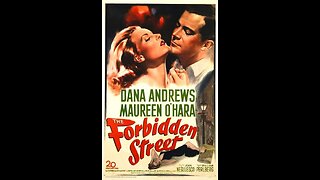 1:30:47
1:30:47
Classic Films & Movies Archive
6 days agoThe Forbidden Street (1949) | Directed by Jean Negulesco
1461 -
 53:56
53:56
ZeeeMedia
20 hours agoSilicon Valley, Transhumanists & the Book of Revelation ft. Jay Dyer | Daily Pulse Ep 144
8.83K13 -
 1:02:02
1:02:02
A Cigar Hustlers Podcast Every Day
1 day agoEpisode 4 Hustler Every Day Target 10/4, No More Pennies and Gronk Is The Man
8.37K1 -
 3:07
3:07
GreenMan Studio
1 day agoHOW TO NOT SELL OUT IN 2025 W/Greeman Reports
9.41K6 -
 0:43
0:43
WildCreatures
2 days ago $3.98 earnedDiver is swallowed up by a passing bait ball at Darwin Island
10.1K4 -
 1:54
1:54
Damon Imani
3 days agoDamon Left The View SPEECHLESS on Marriage And Government Overreach
13K10 -
 4:09
4:09
Memology 101
15 hours ago $2.31 earned"Journalist" REPEATEDLY tries and FAILS to bait John Fetterman into calling Trump an "AUTOCRAT"
11.4K25 -
 58:02
58:02
Dialogue works
2 days ago $7.78 earnedMatthew Hoh: Ukraine’s Army Is COLLAPSING Everywhere!
36K19 -
 17:24
17:24
Nate The Lawyer
2 days ago $3.46 earnedBREAKING: NEW Scientific Evidence Shows Men Are Better in Sports Than Women
18.4K15 -
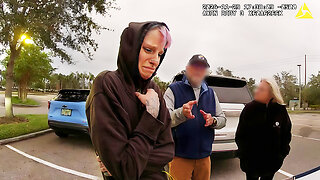 29:43
29:43
Code Blue Cam
2 days agoHow Missing Dipping Sauce Turned into a Felony Arrest
19K15
